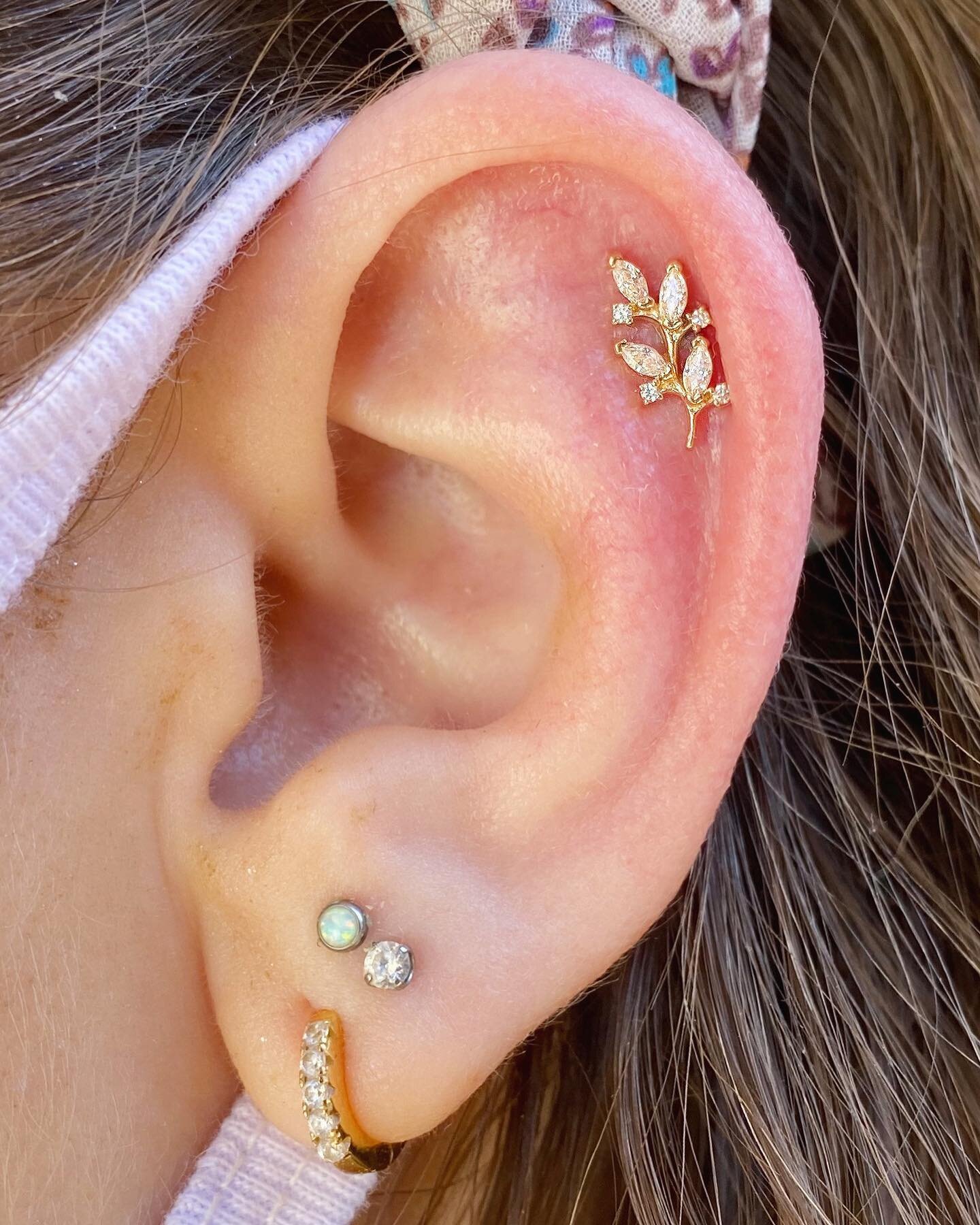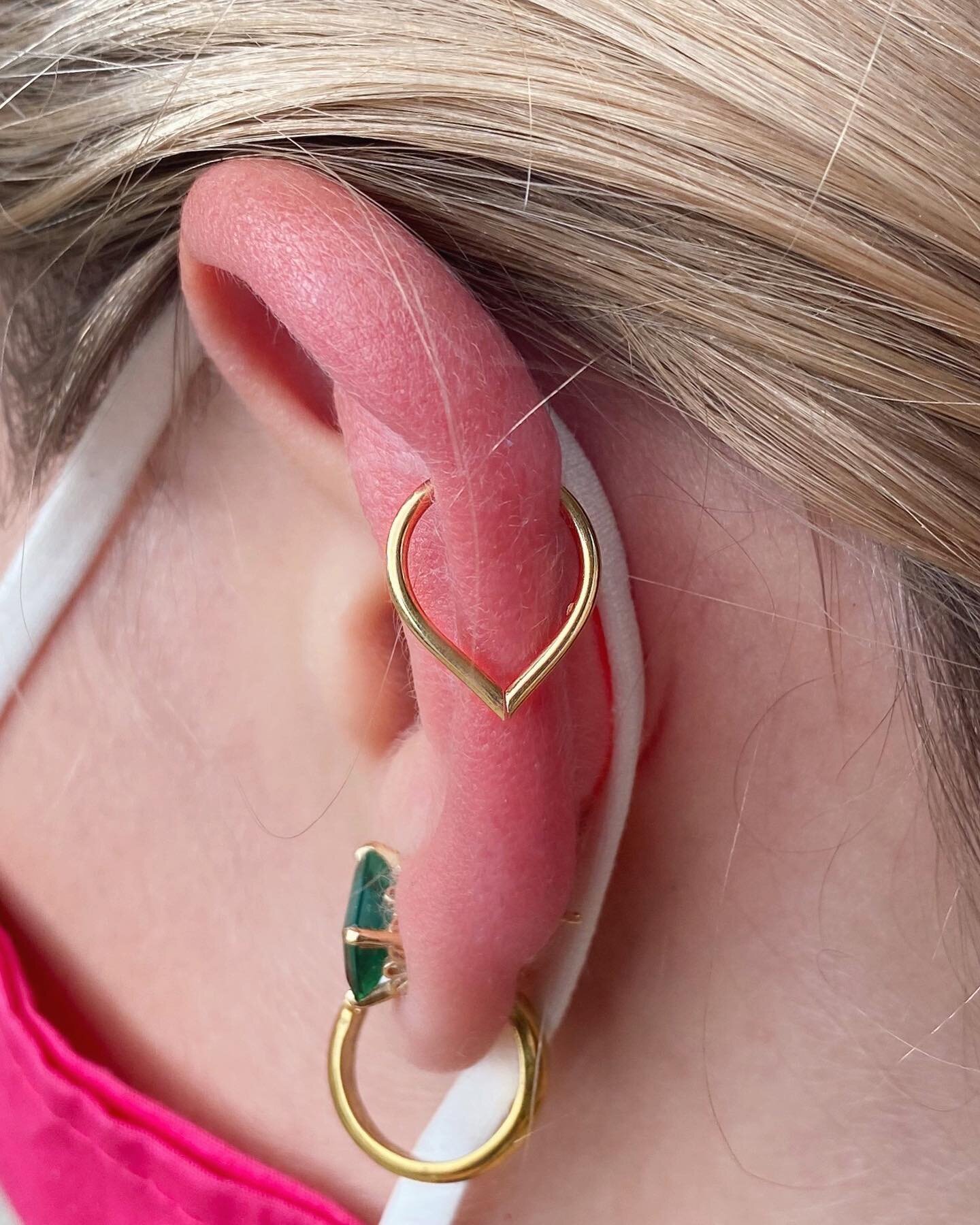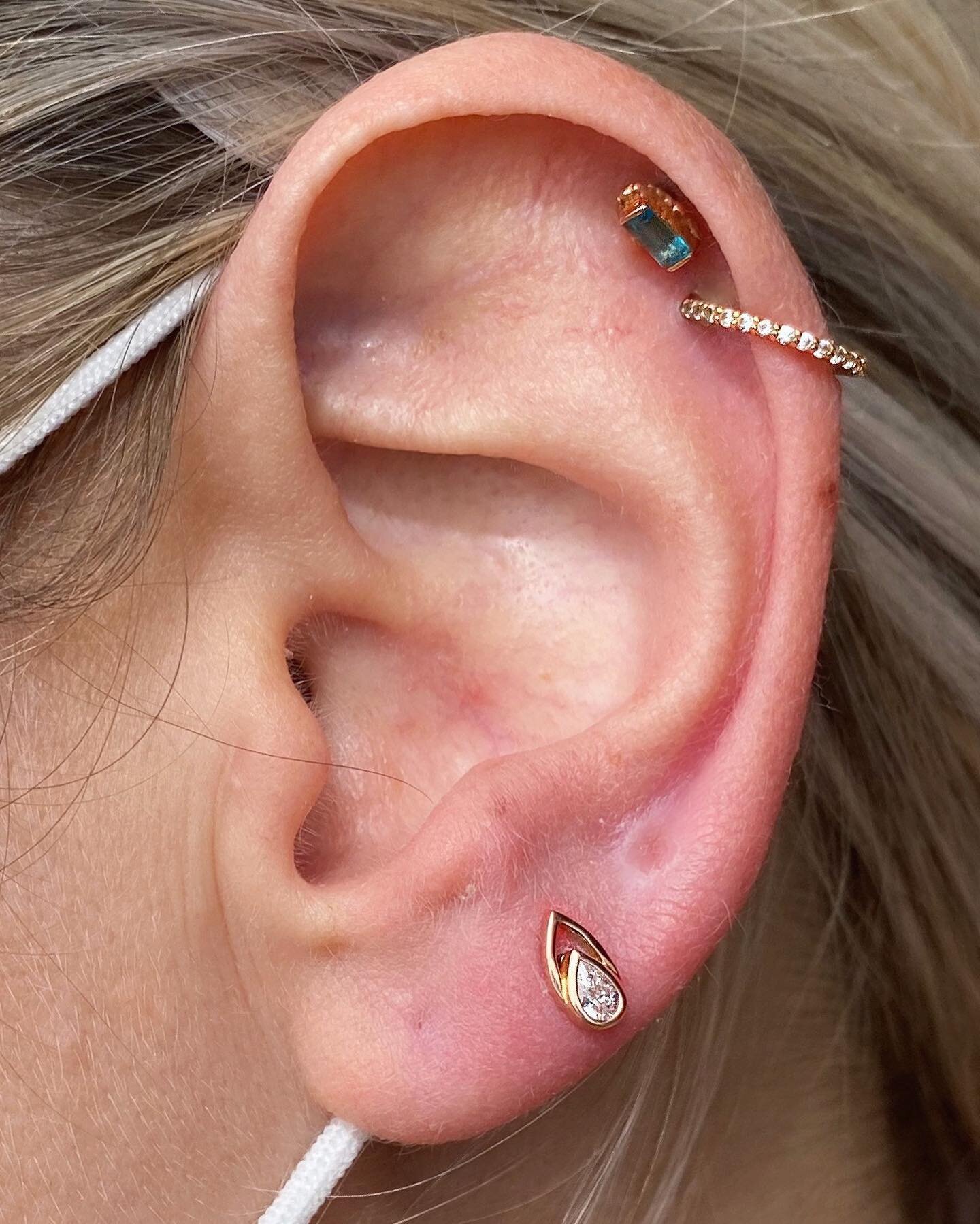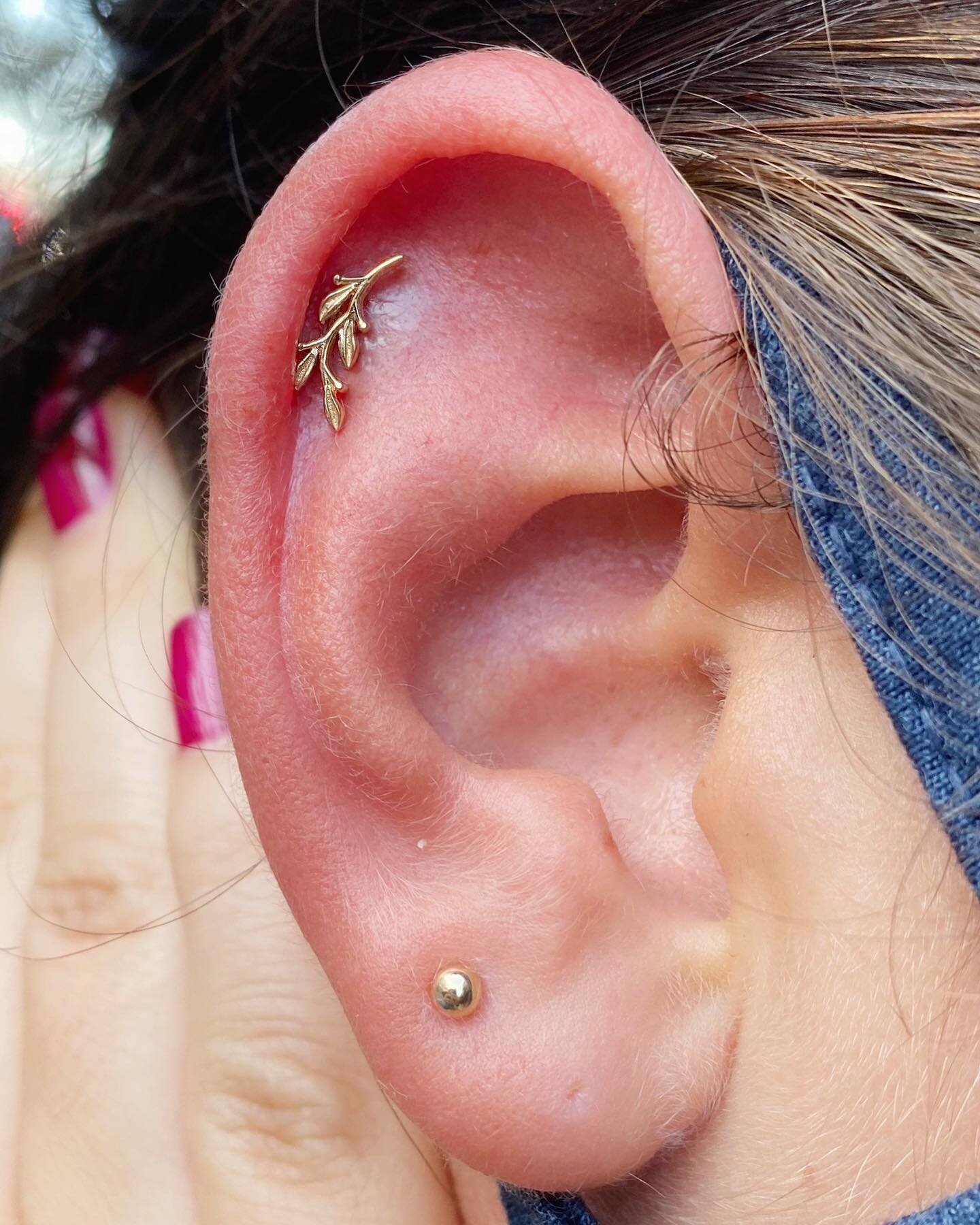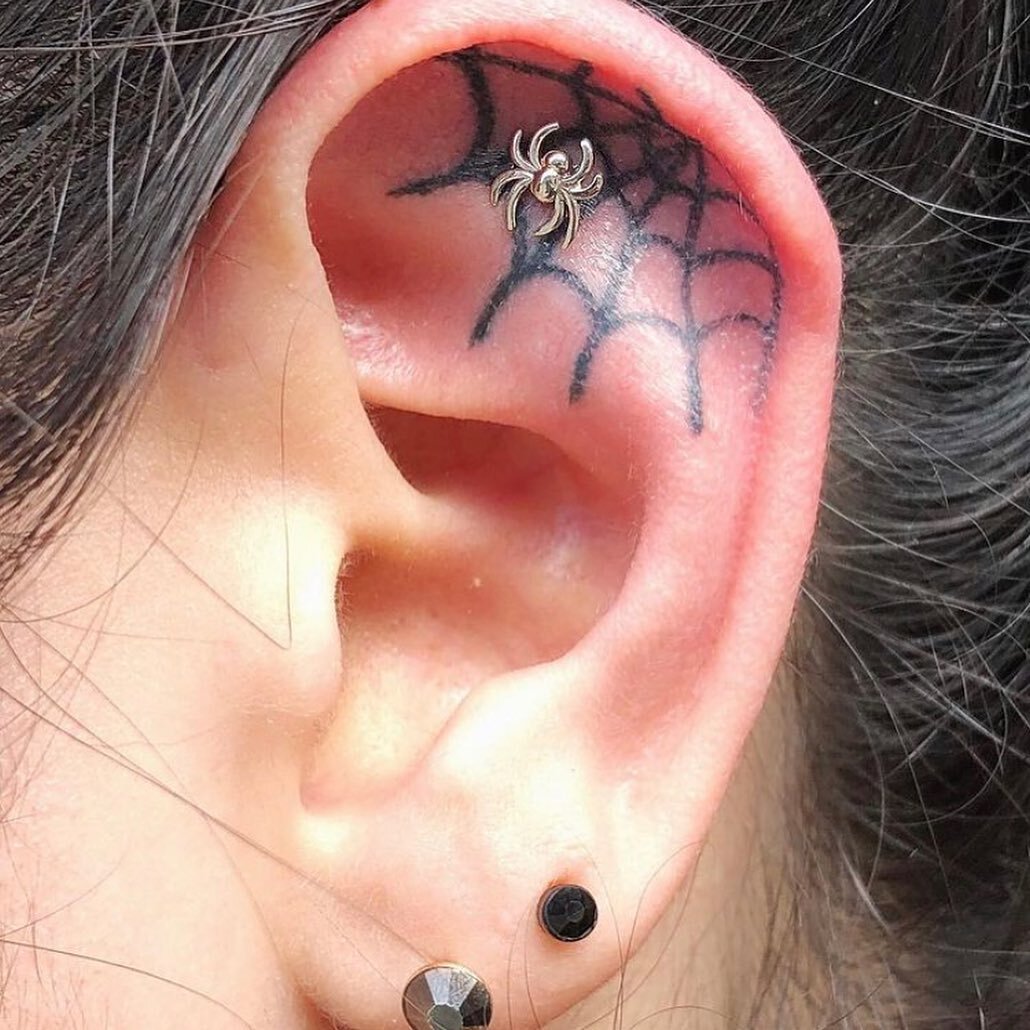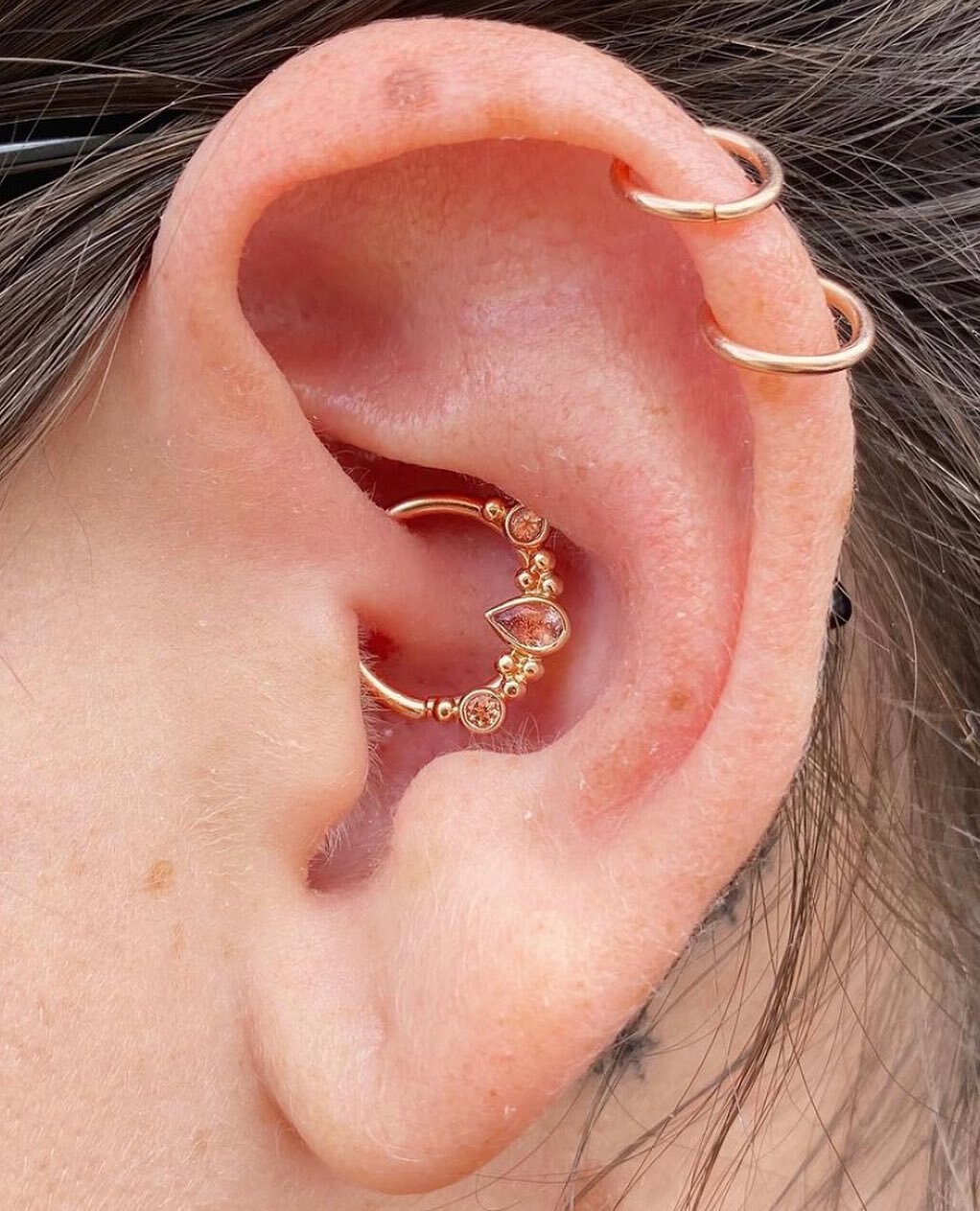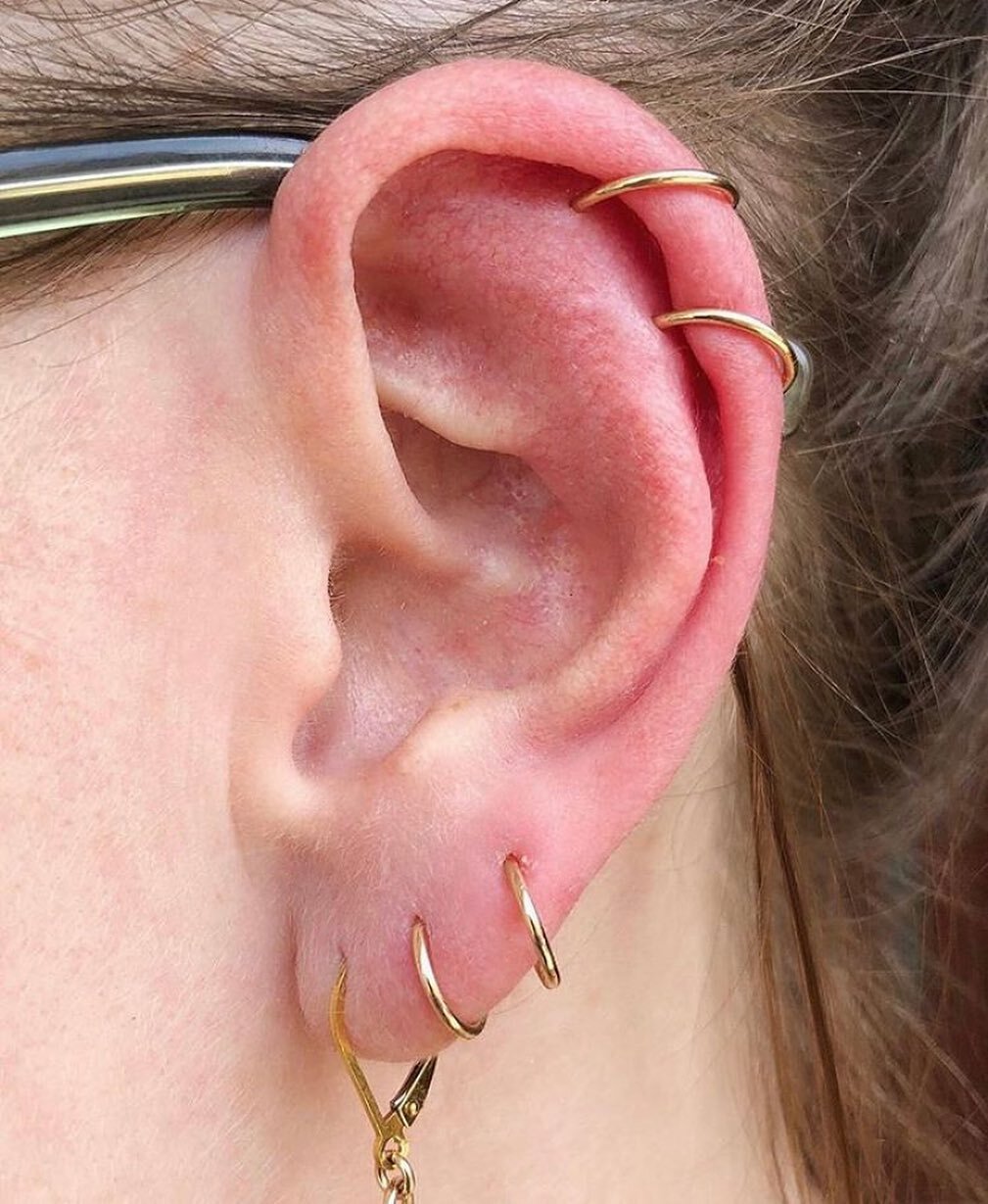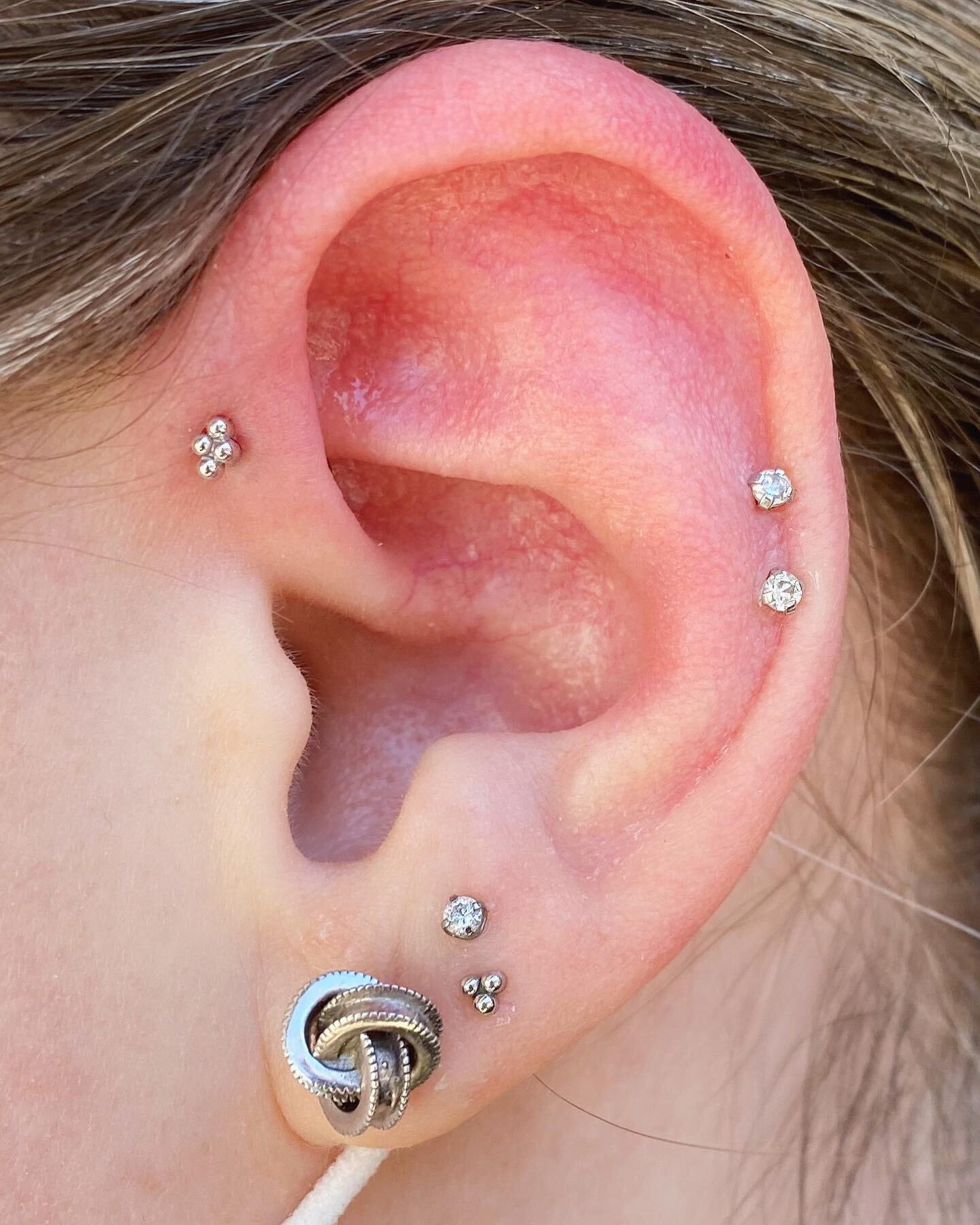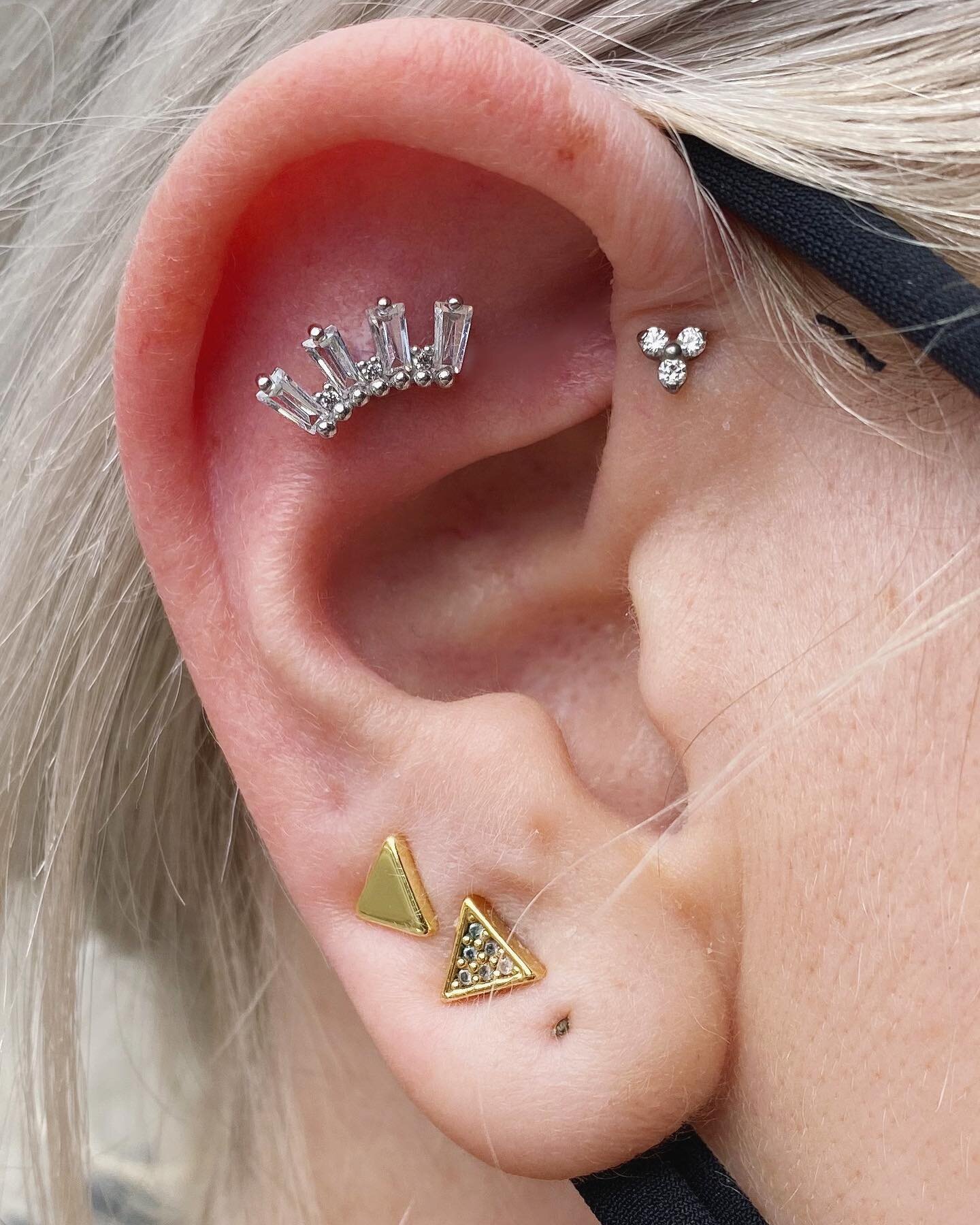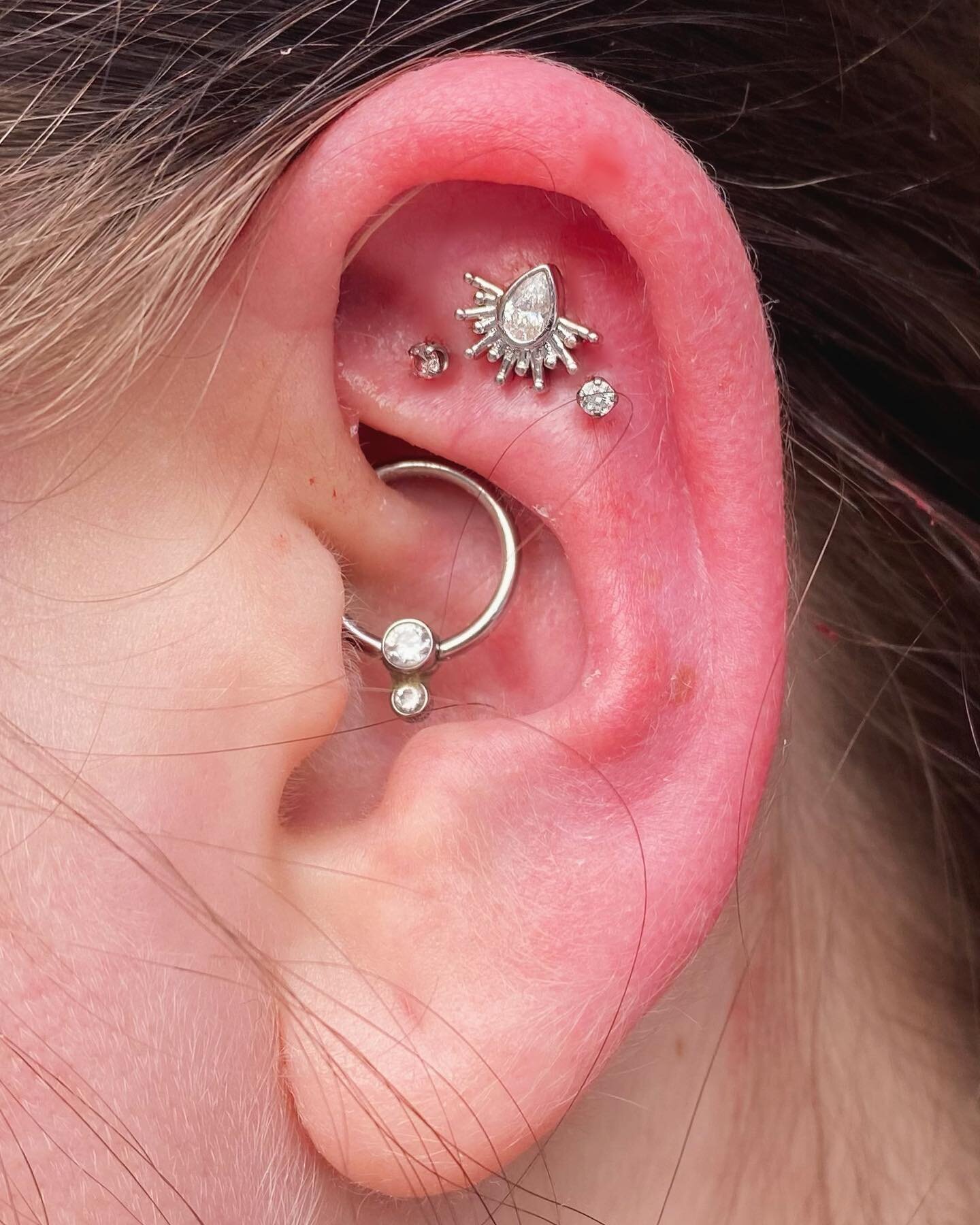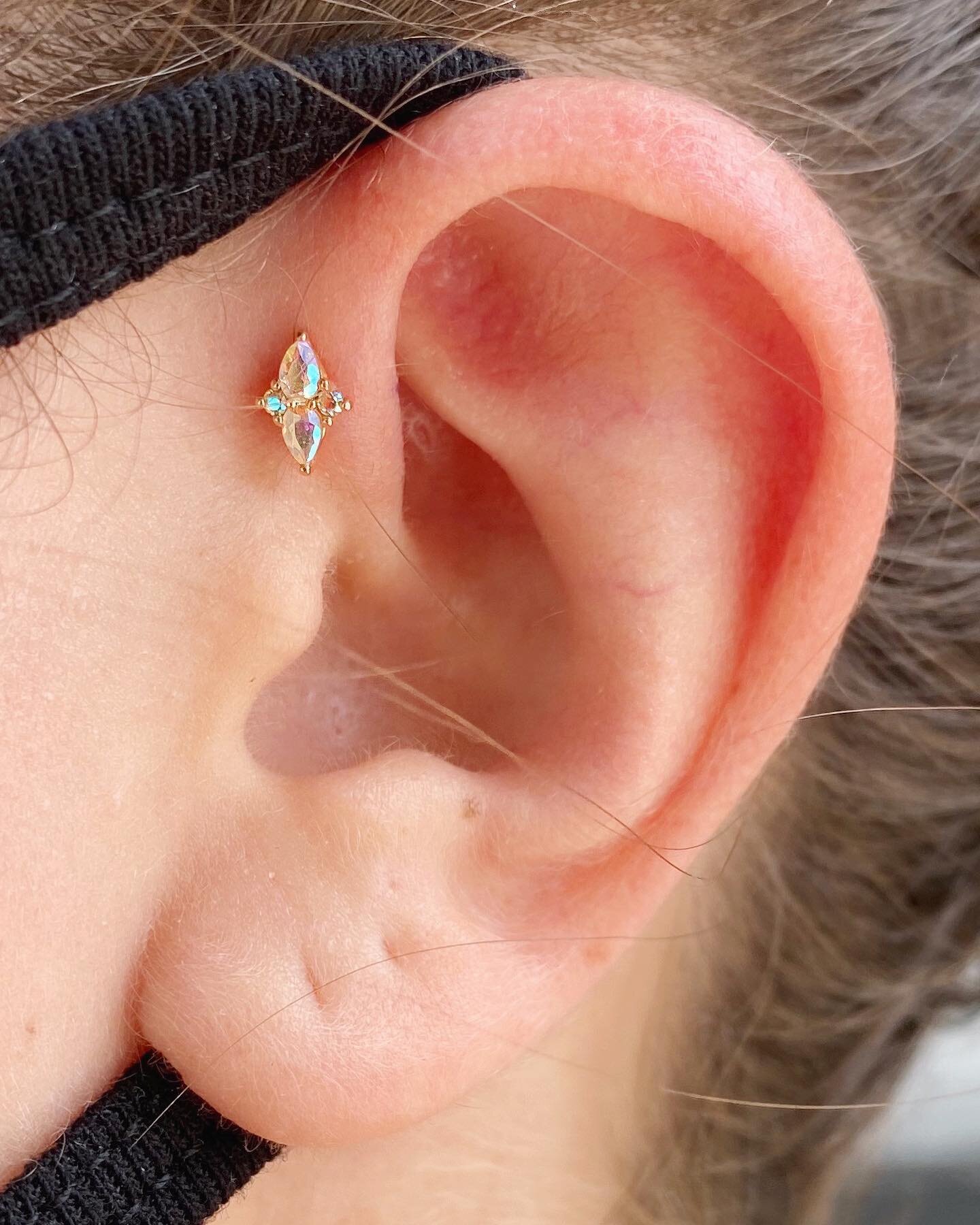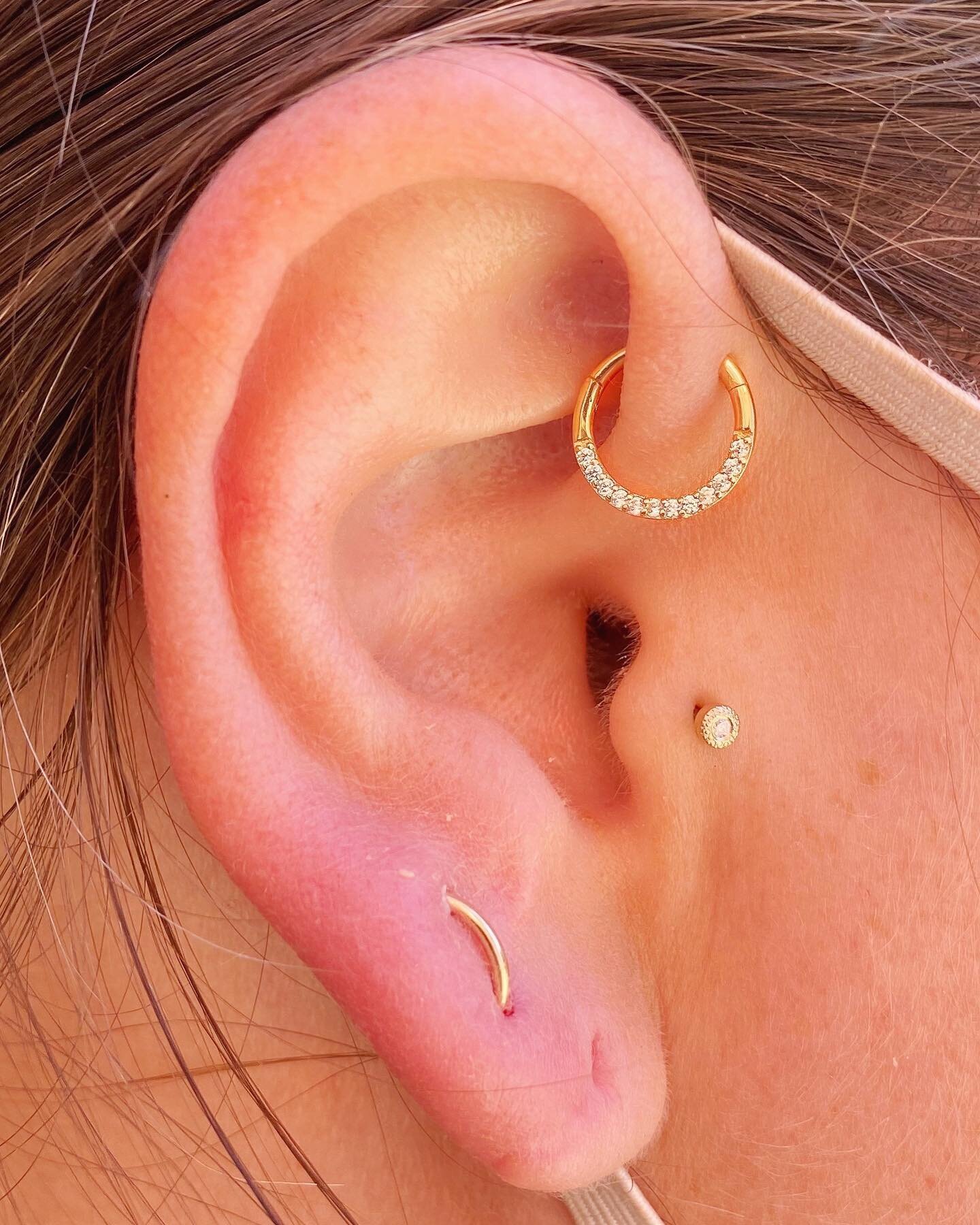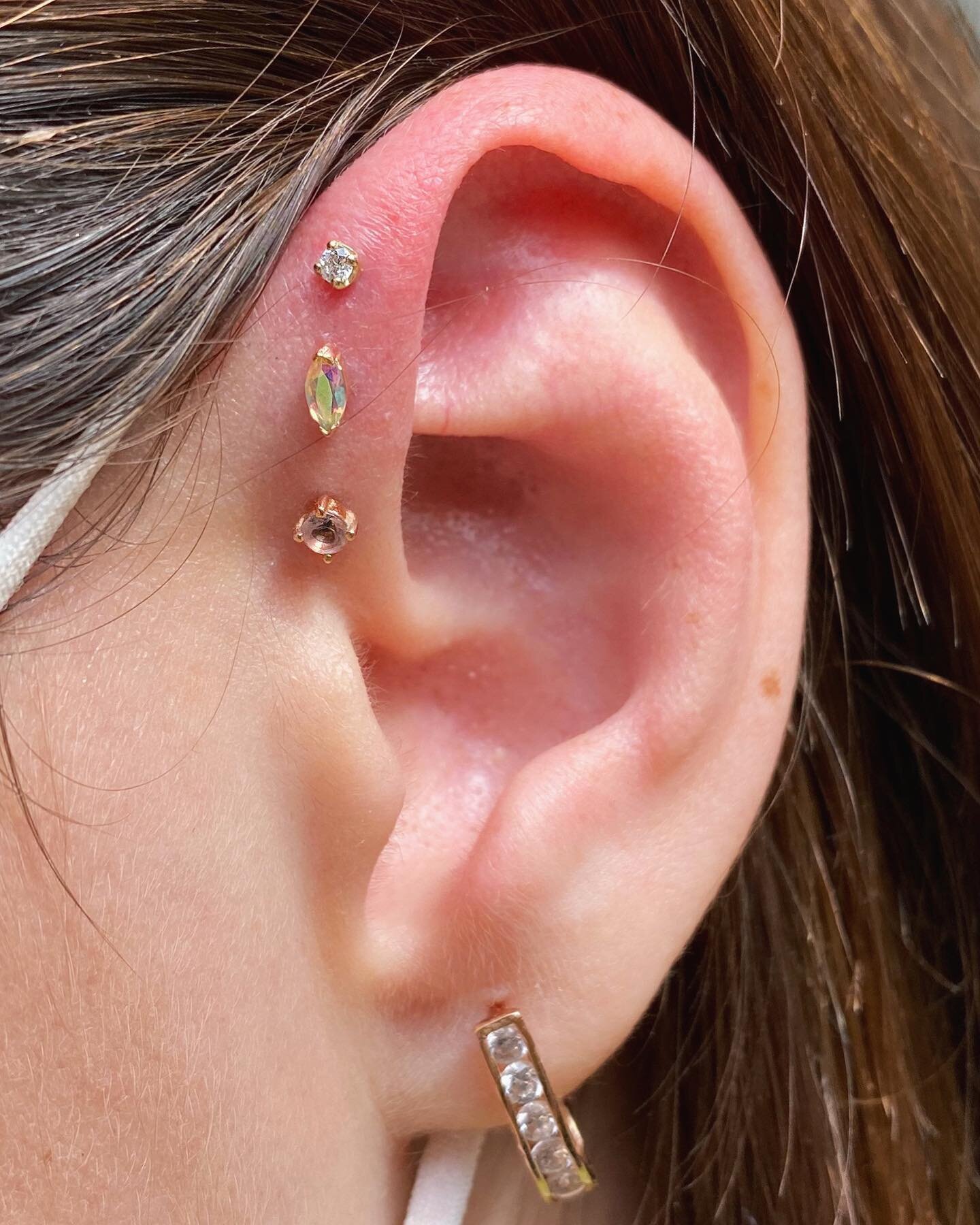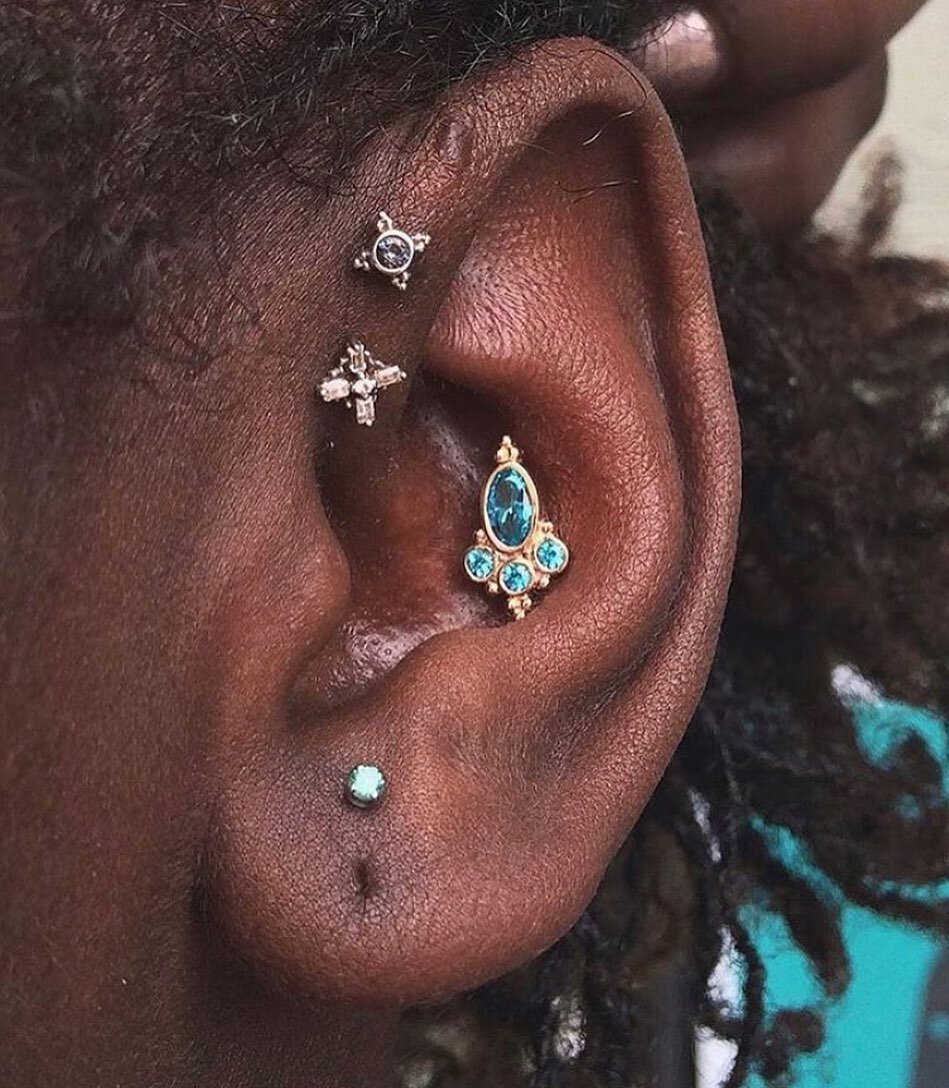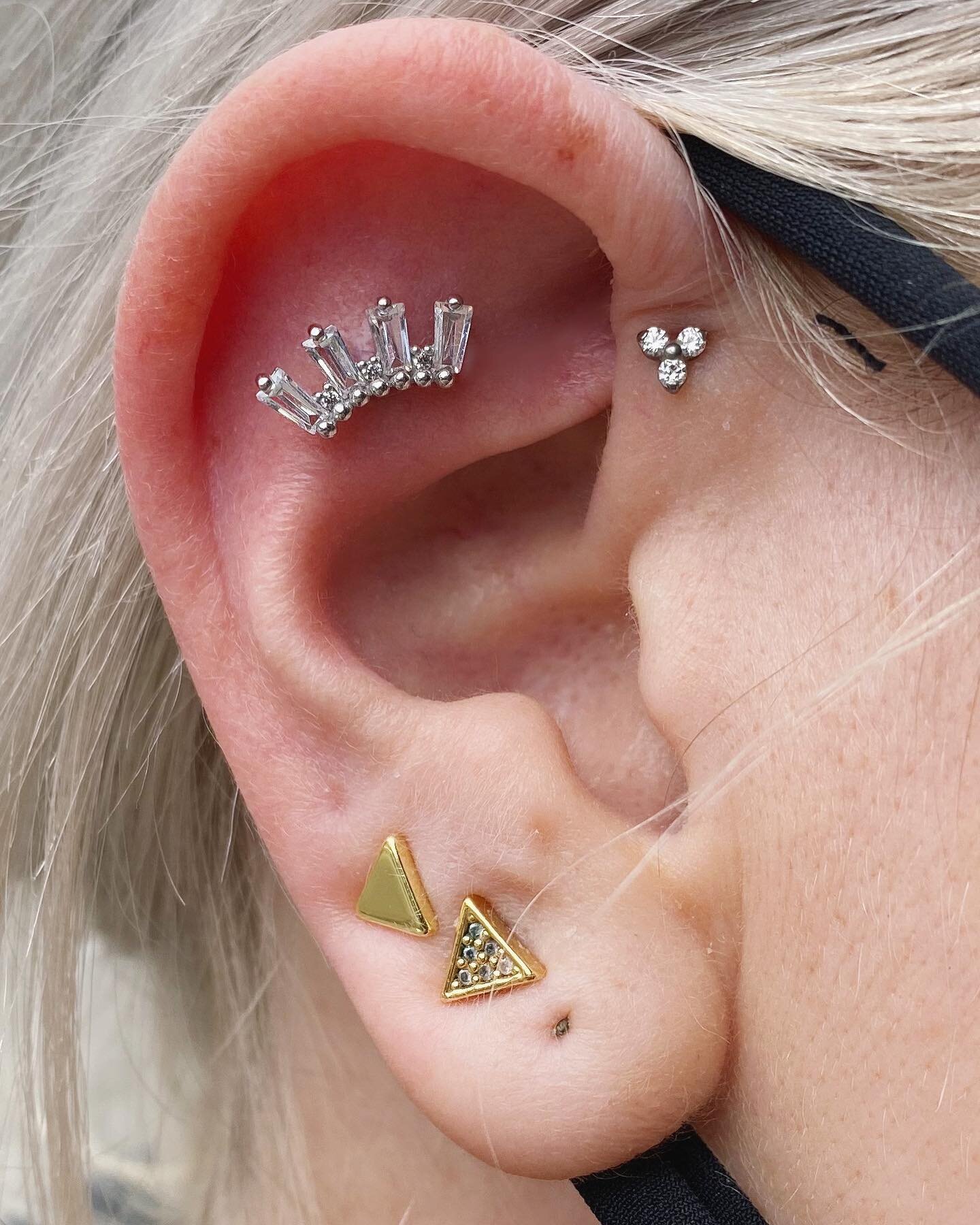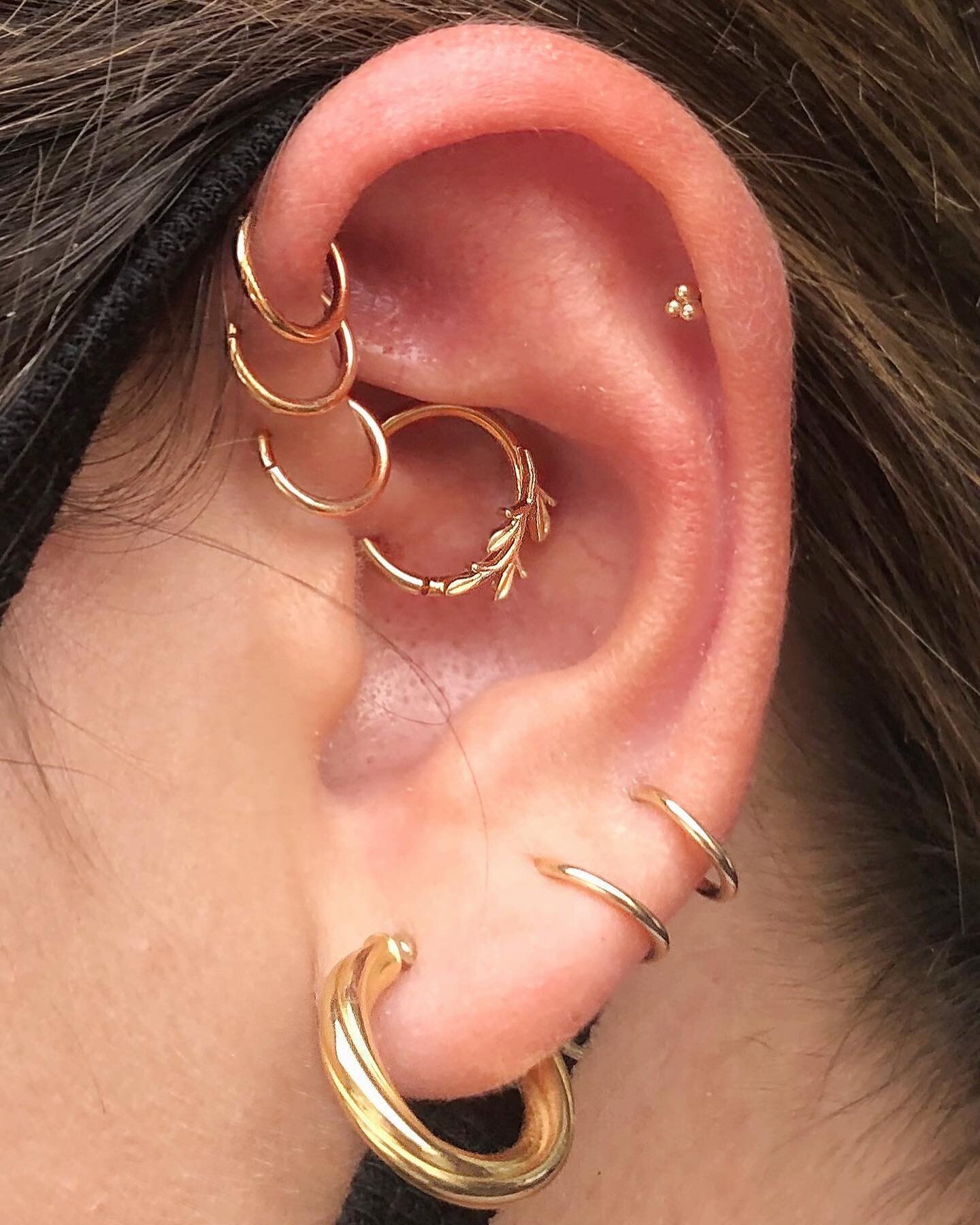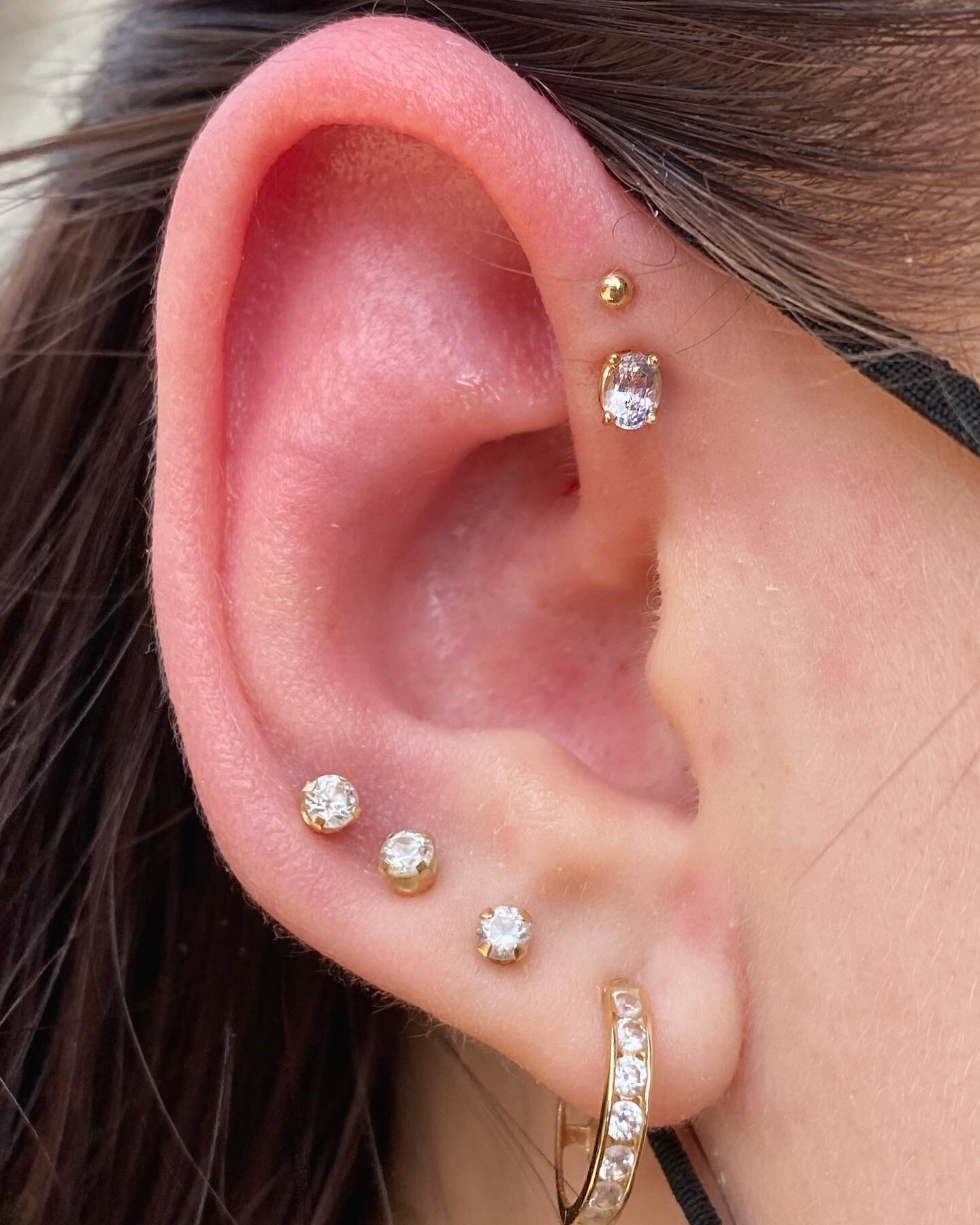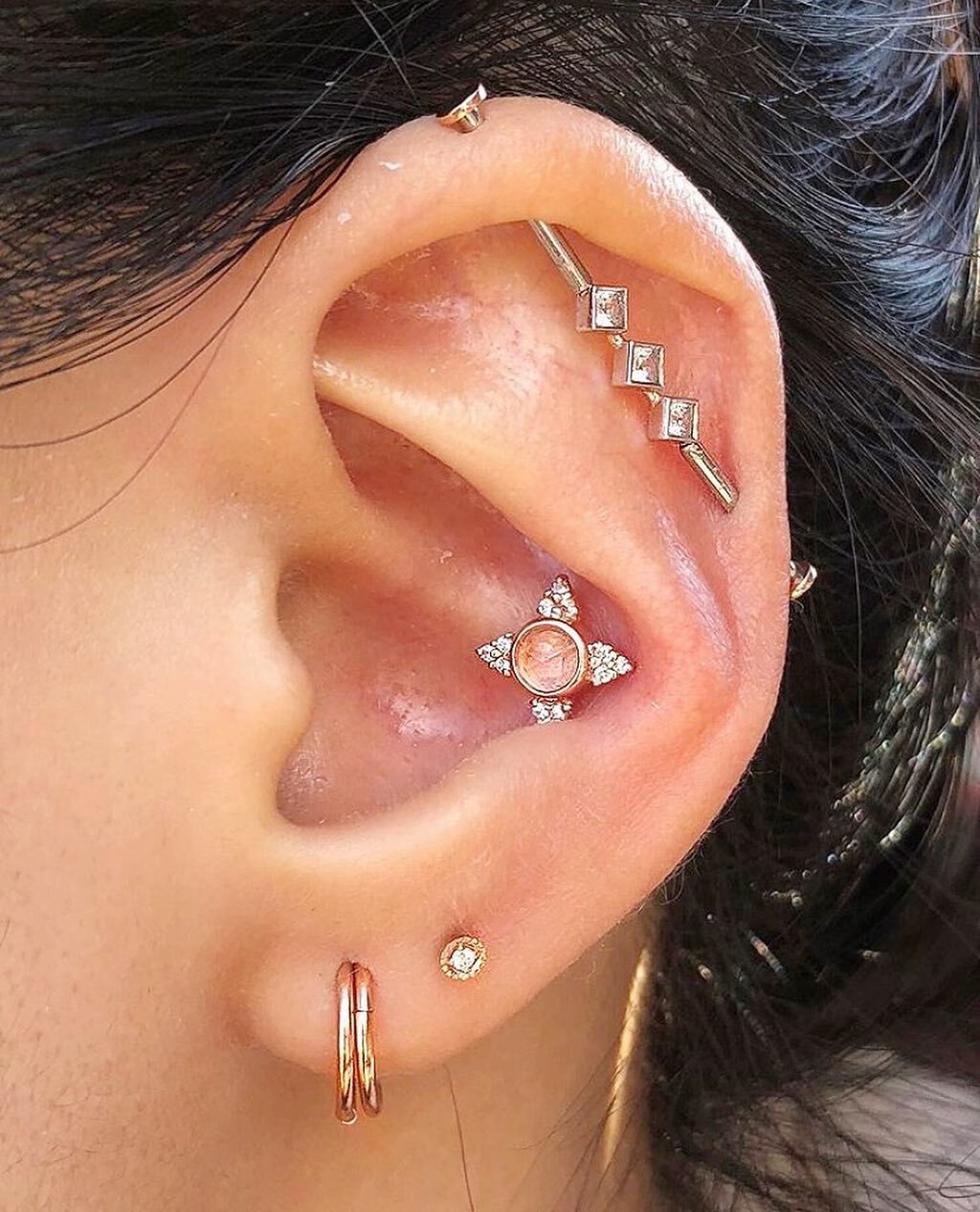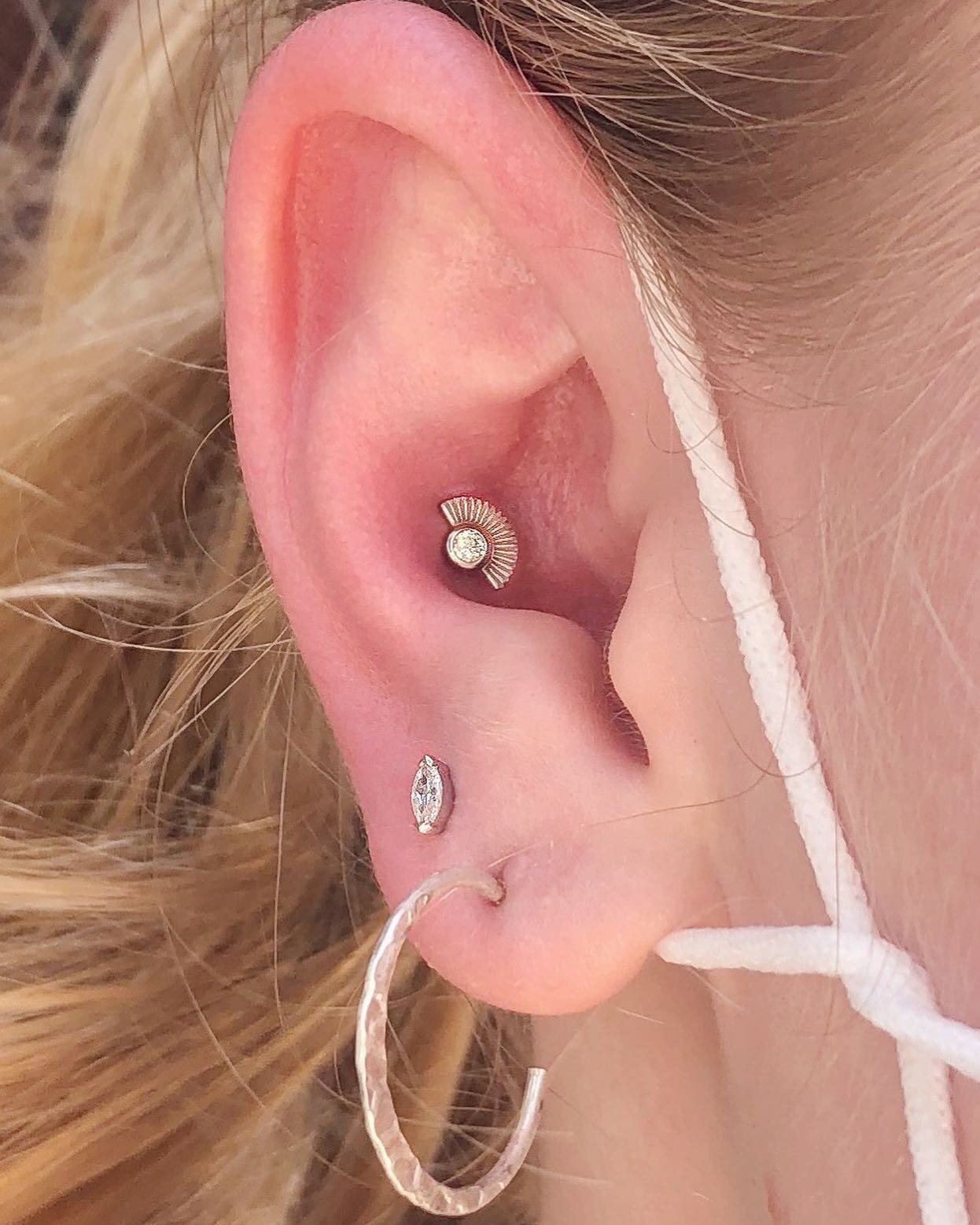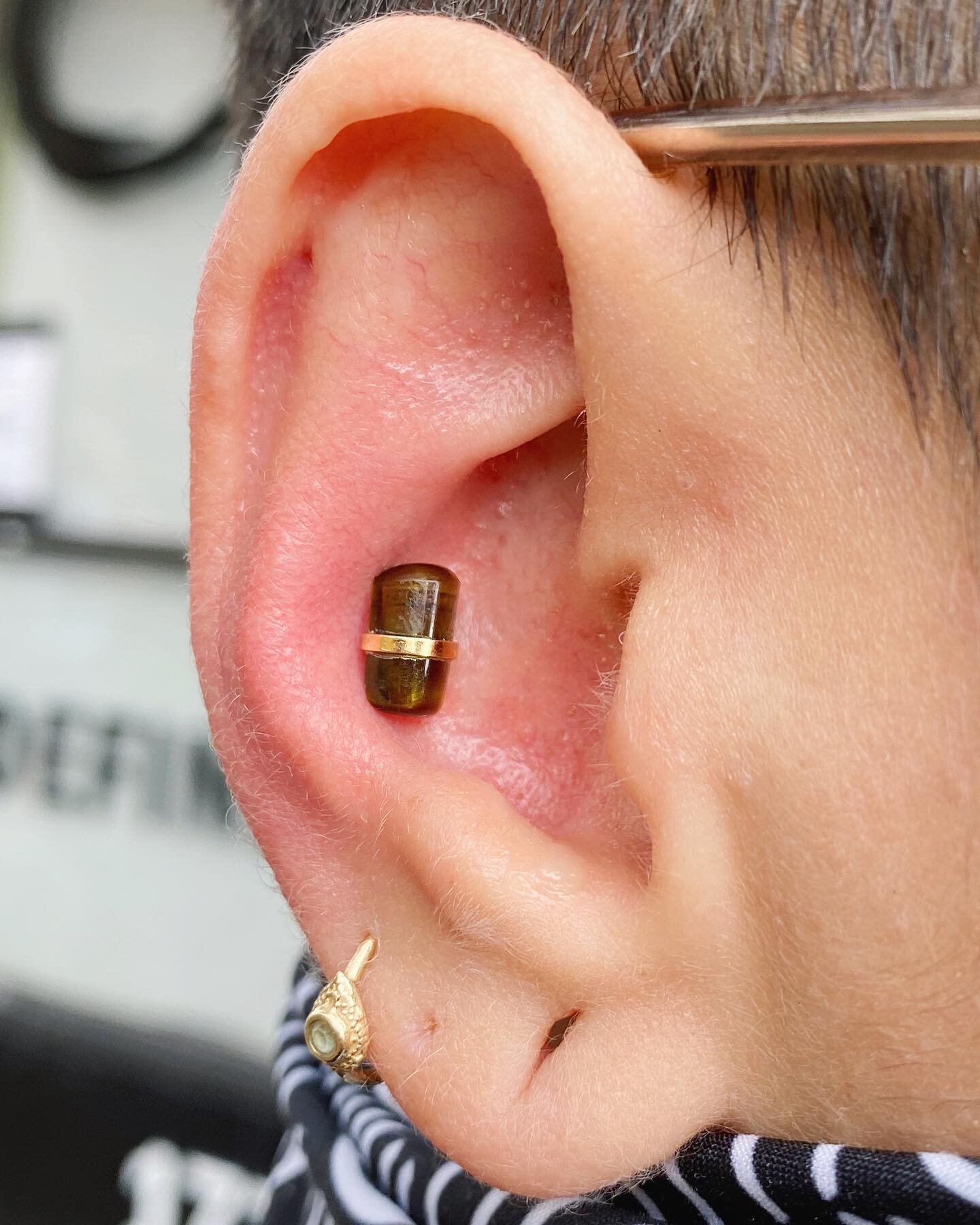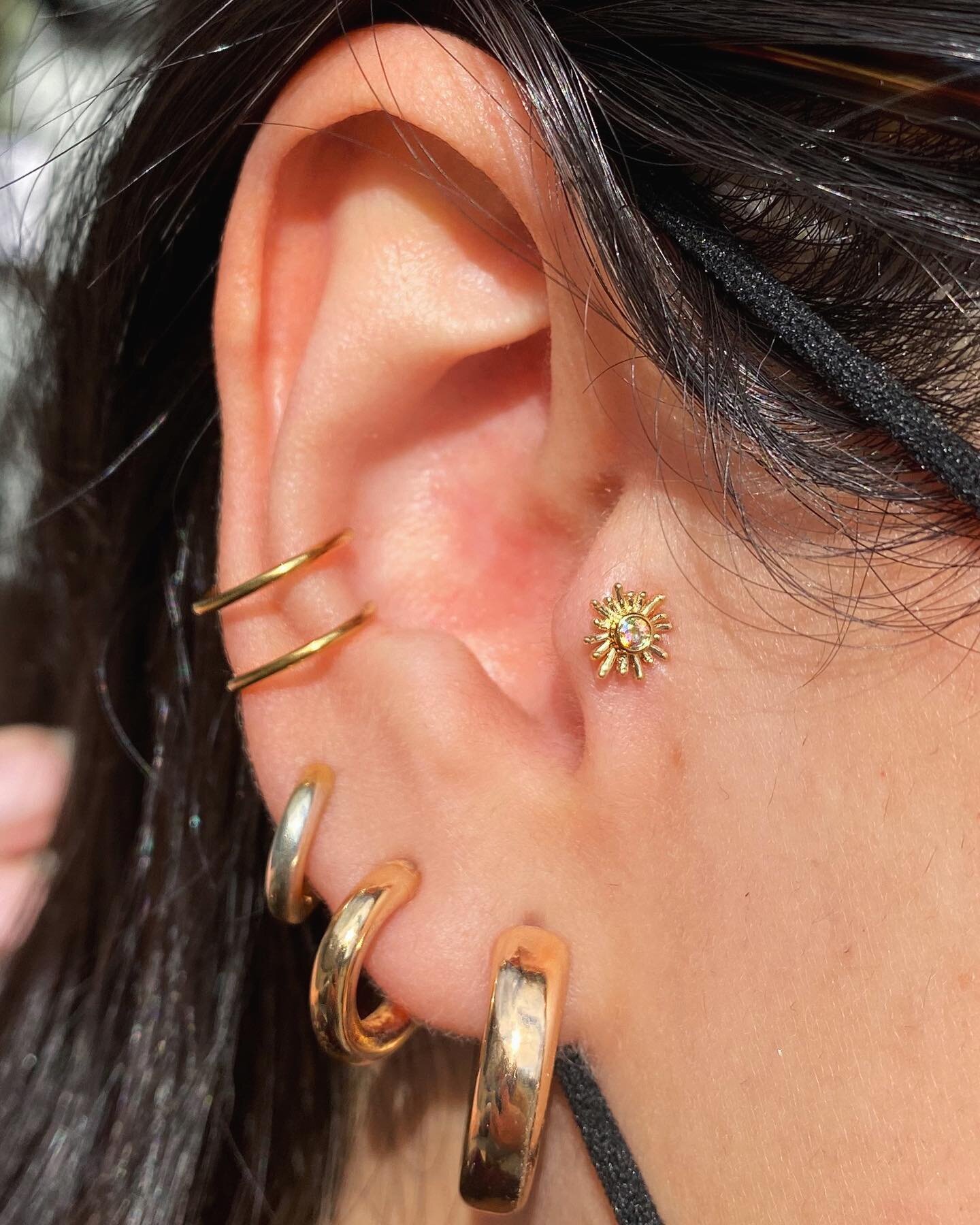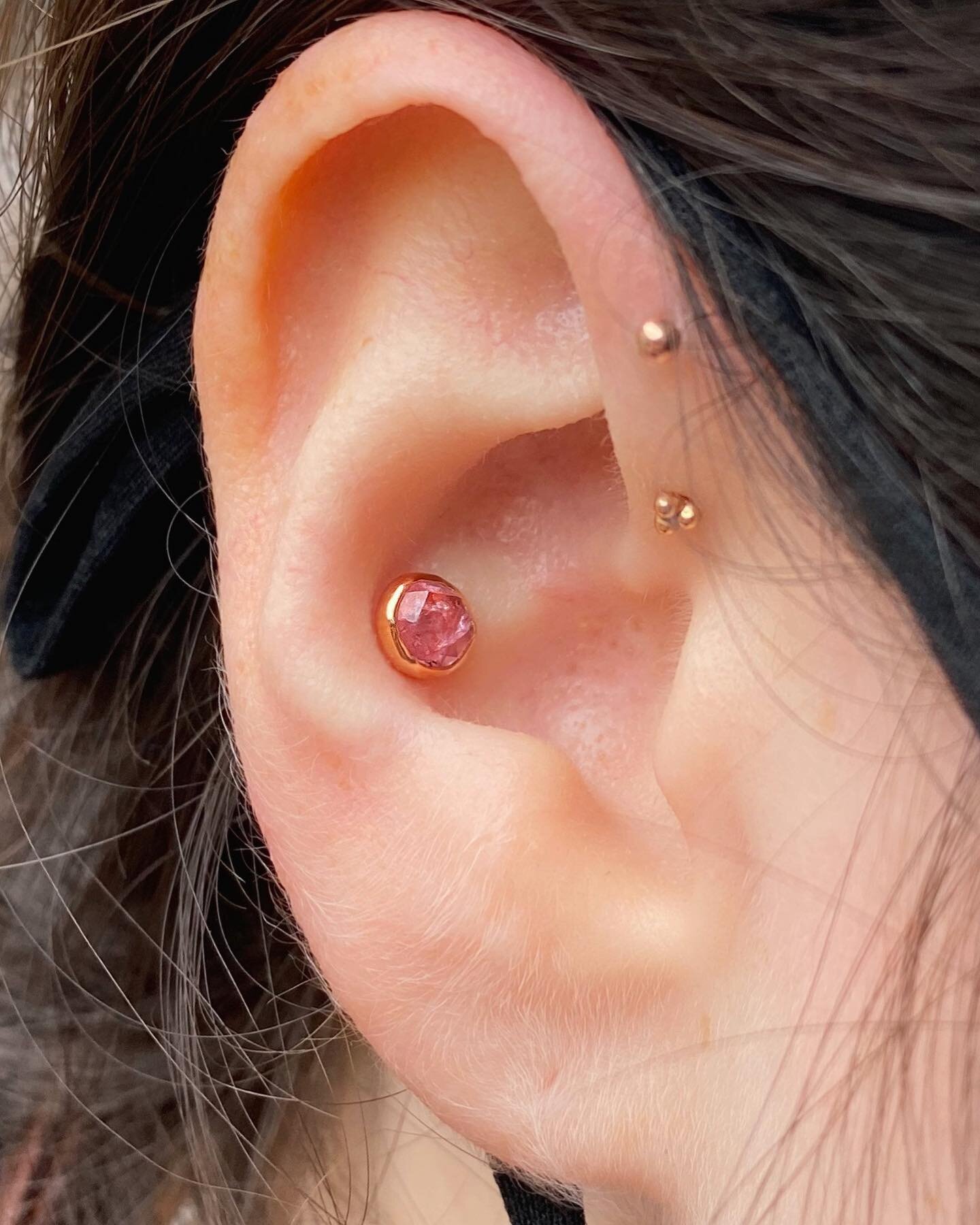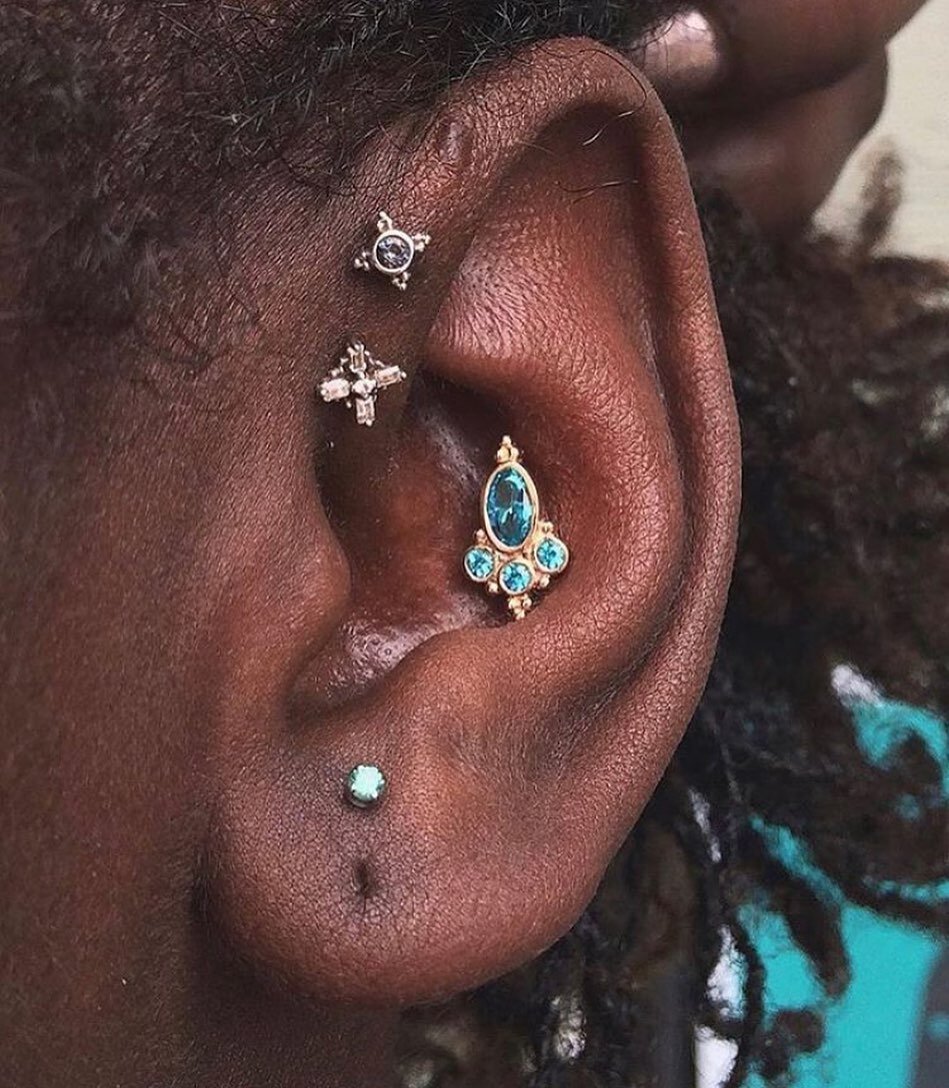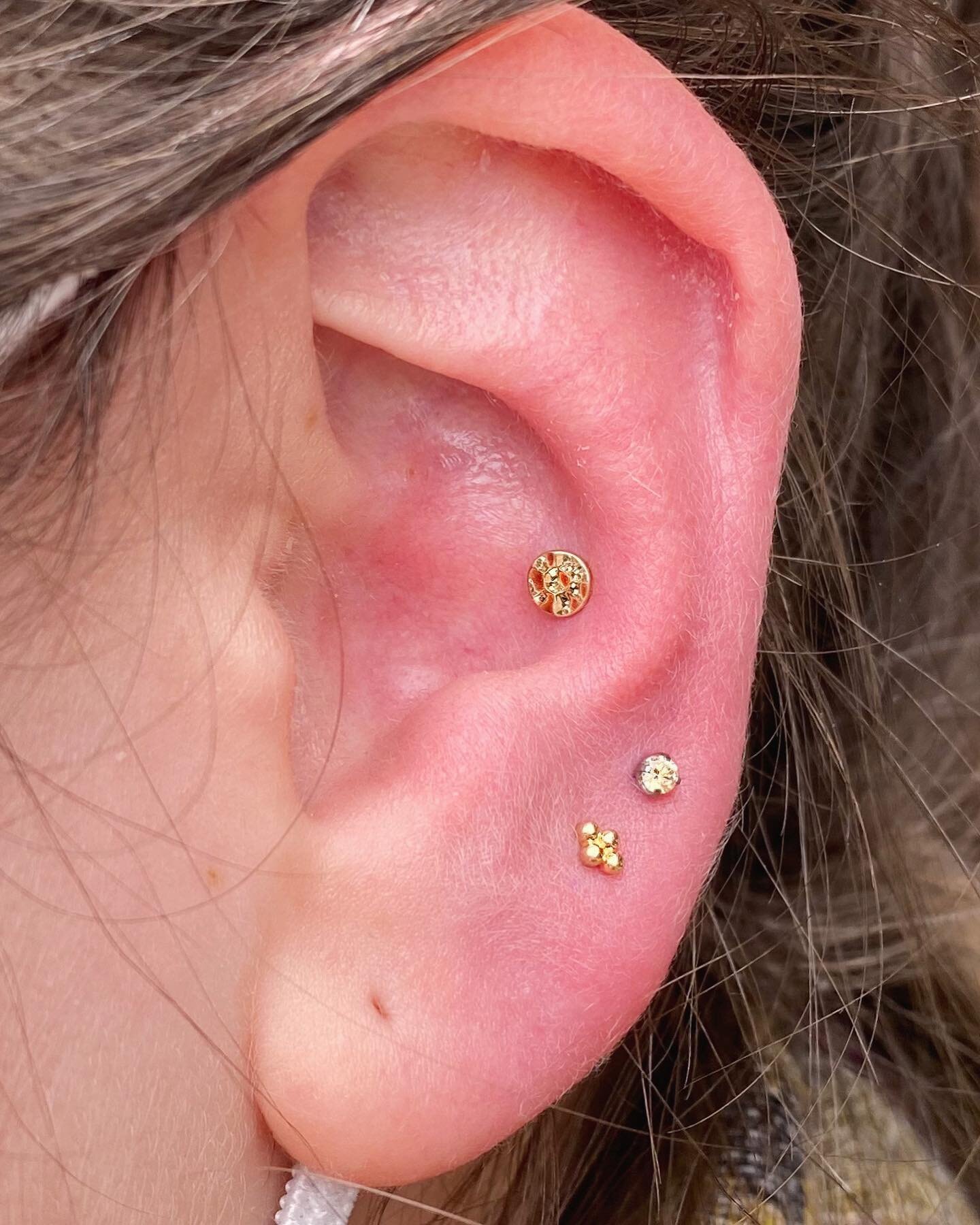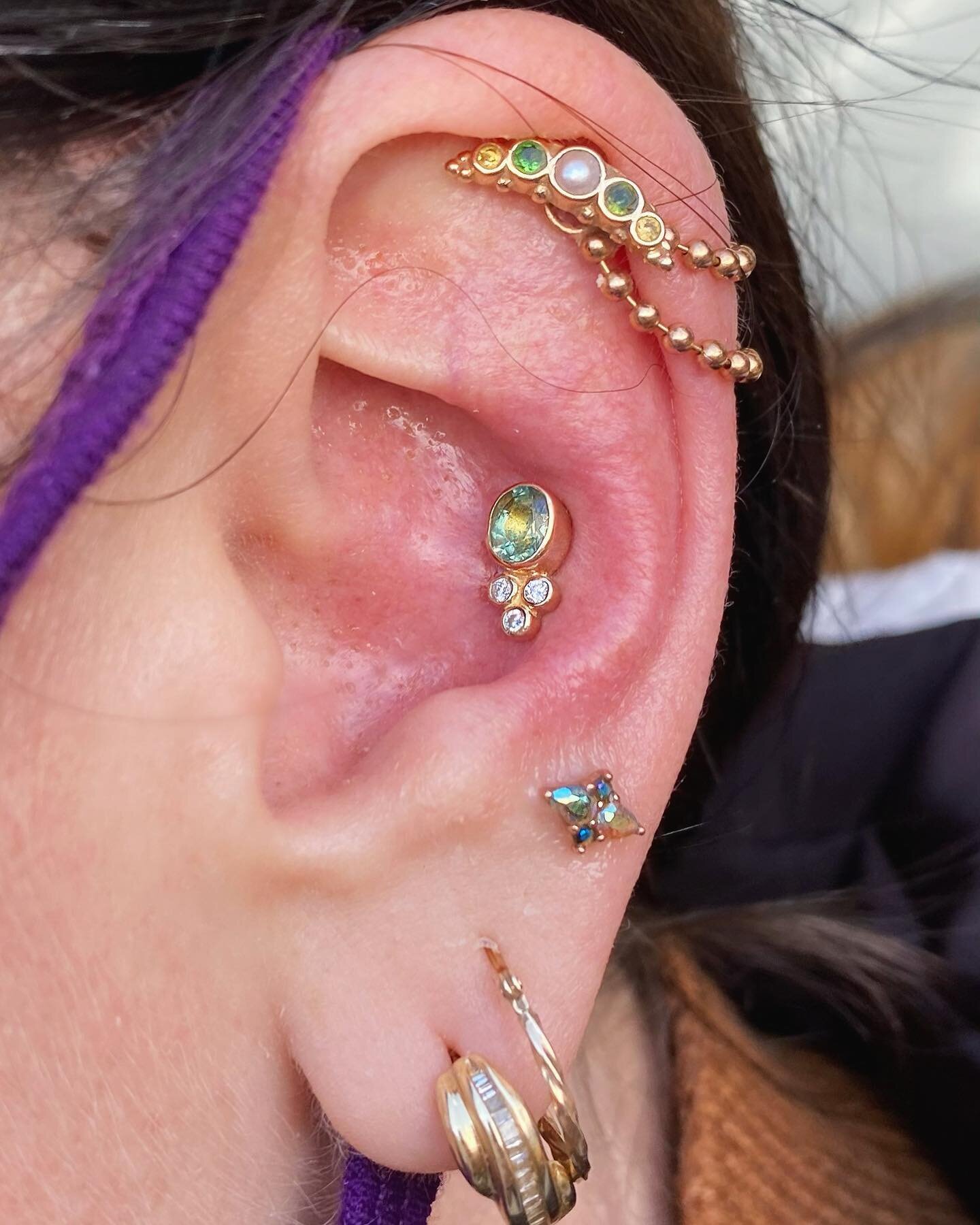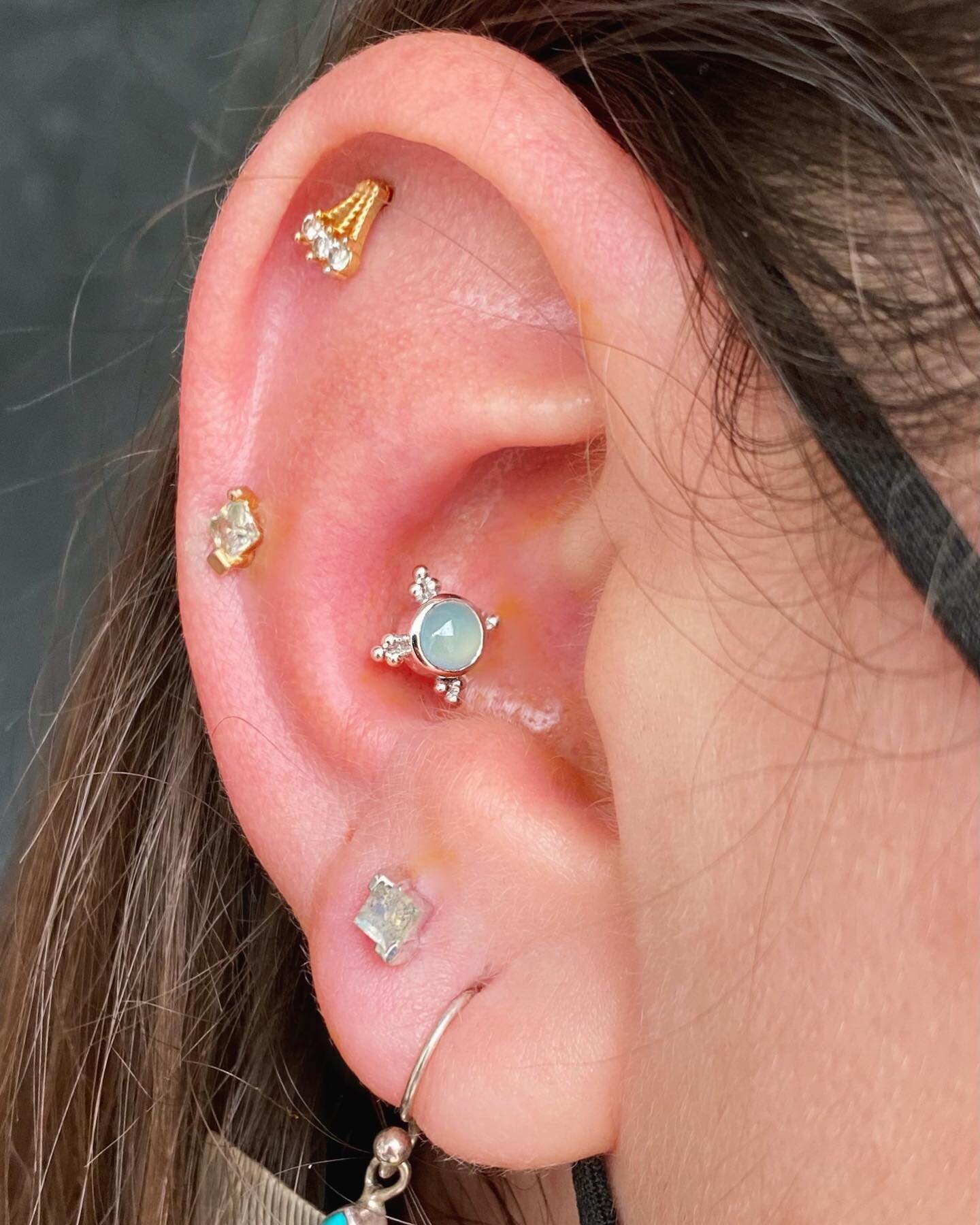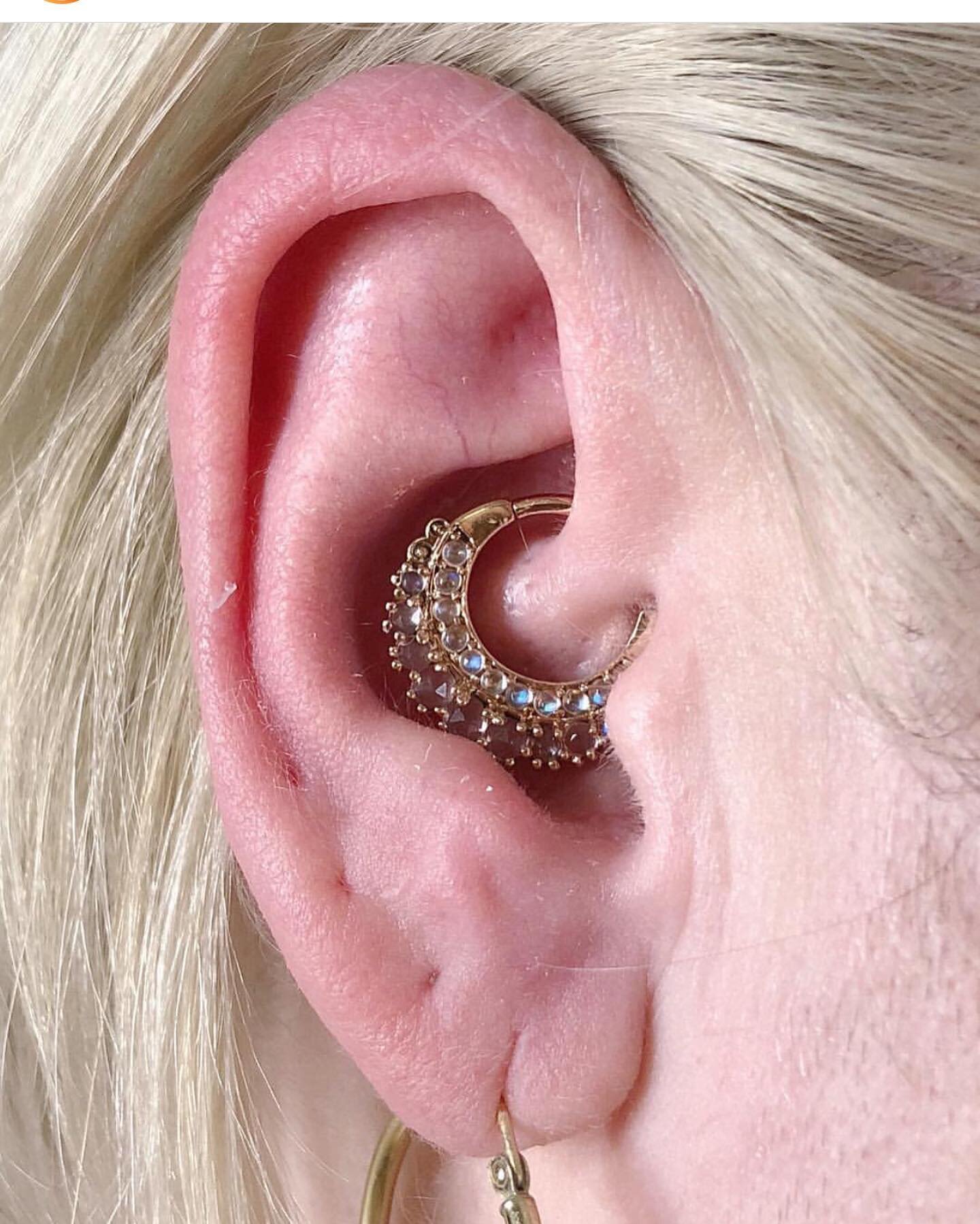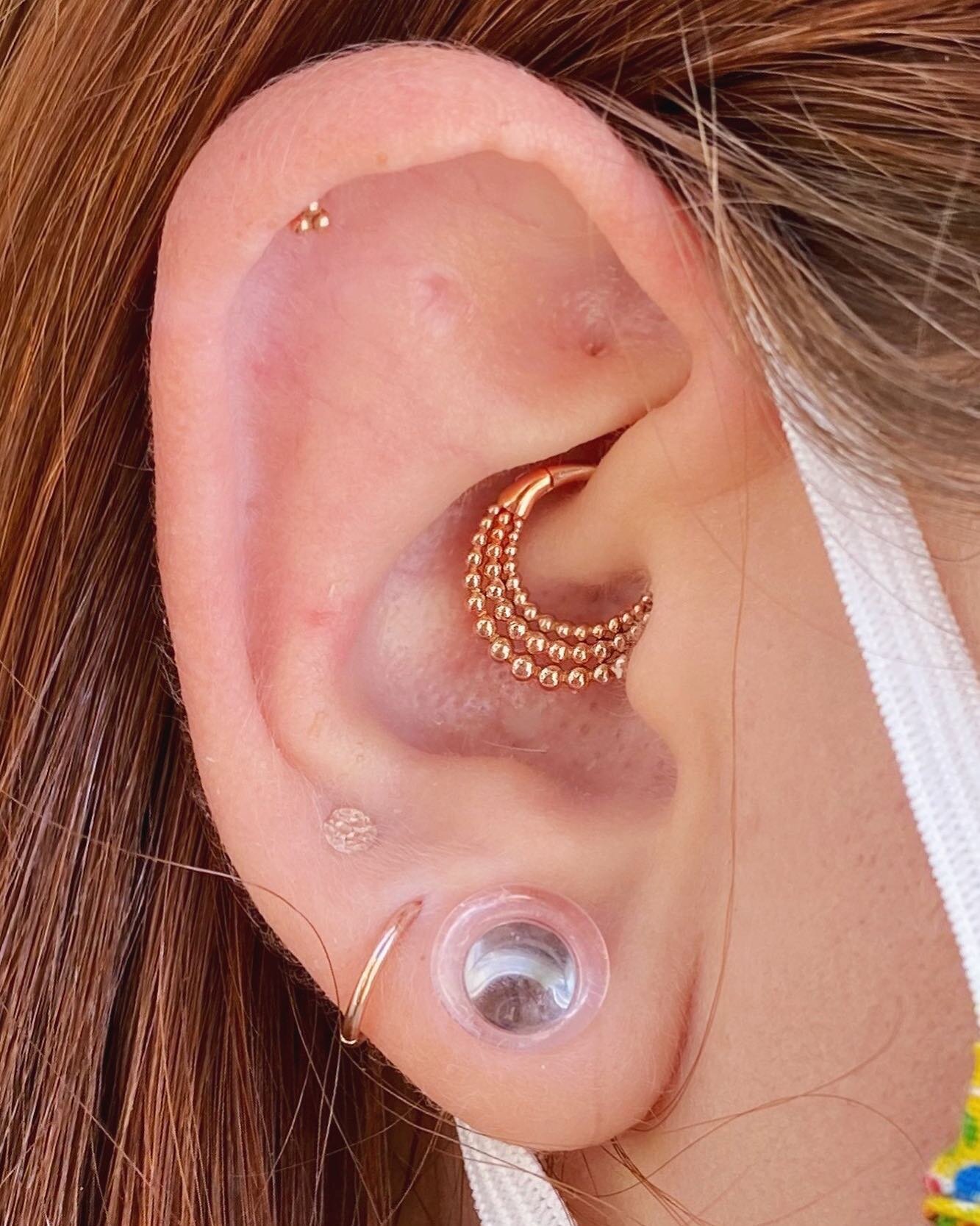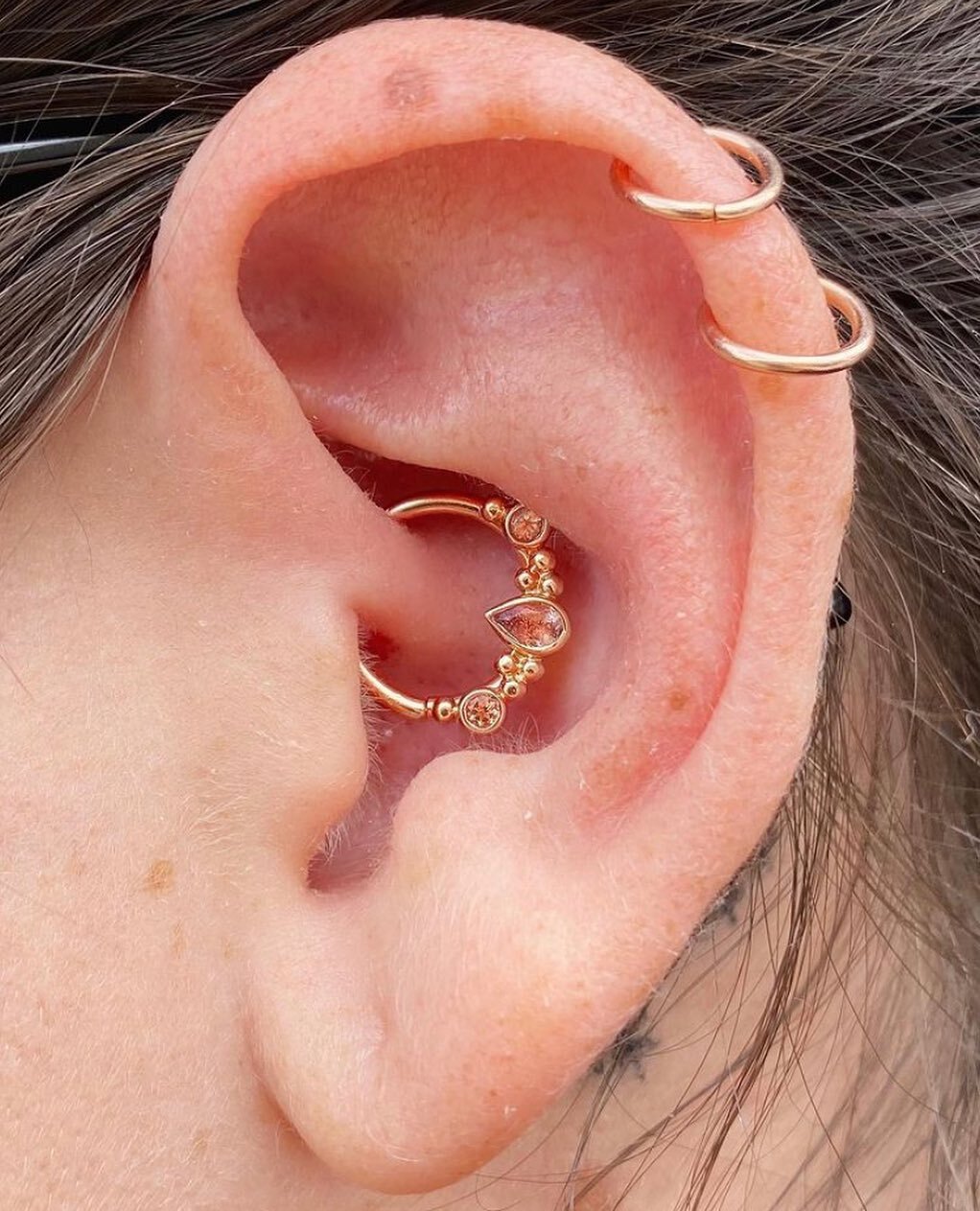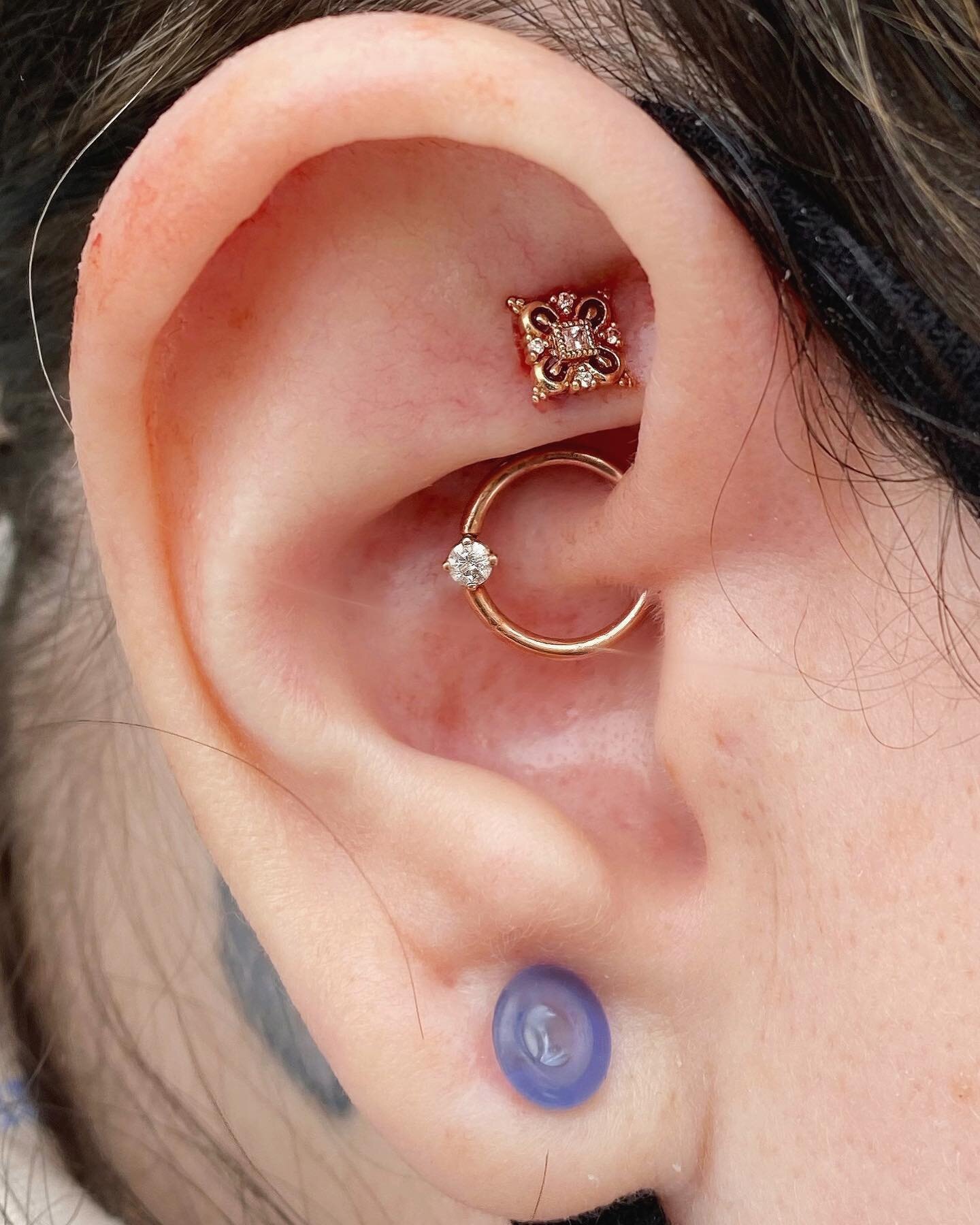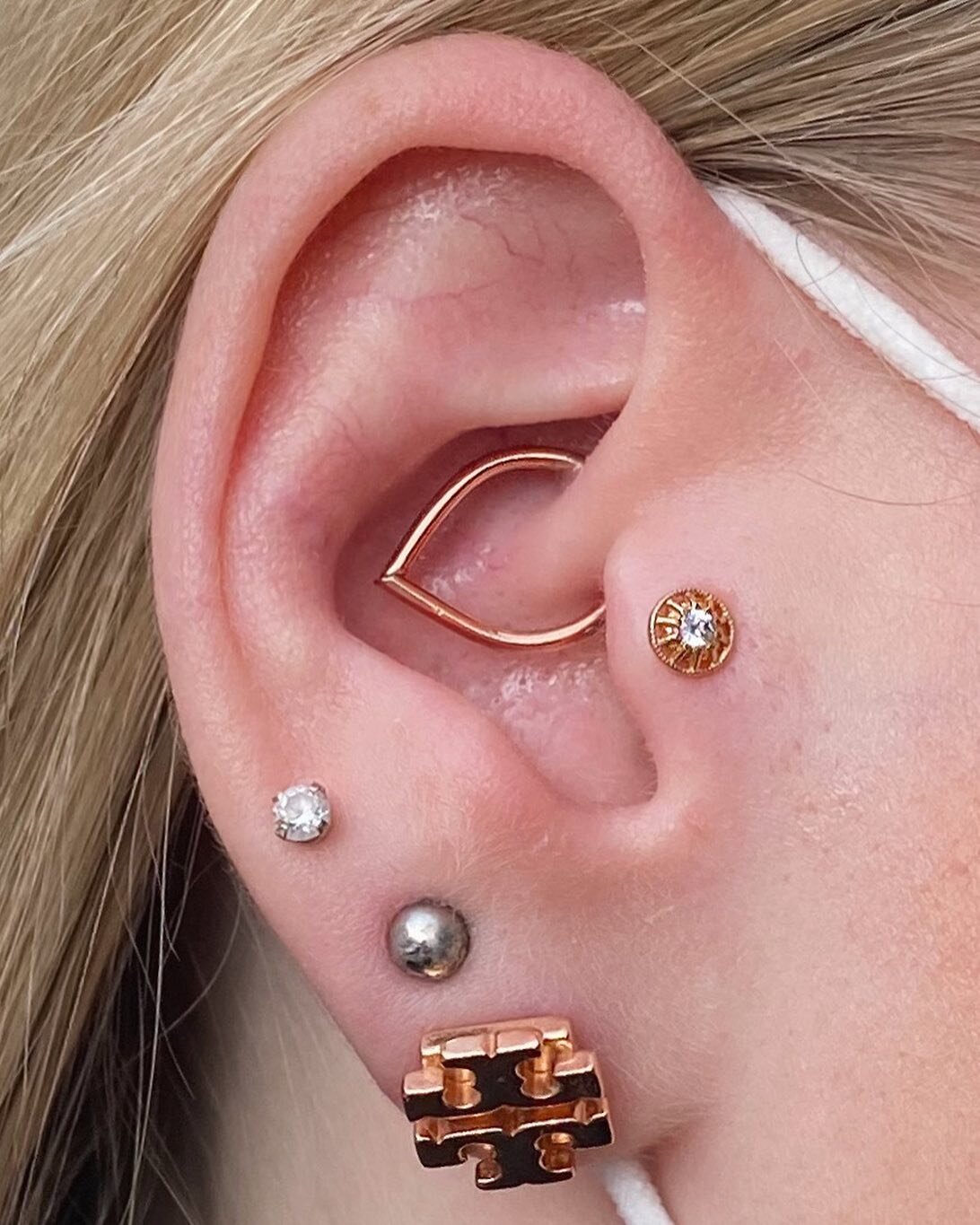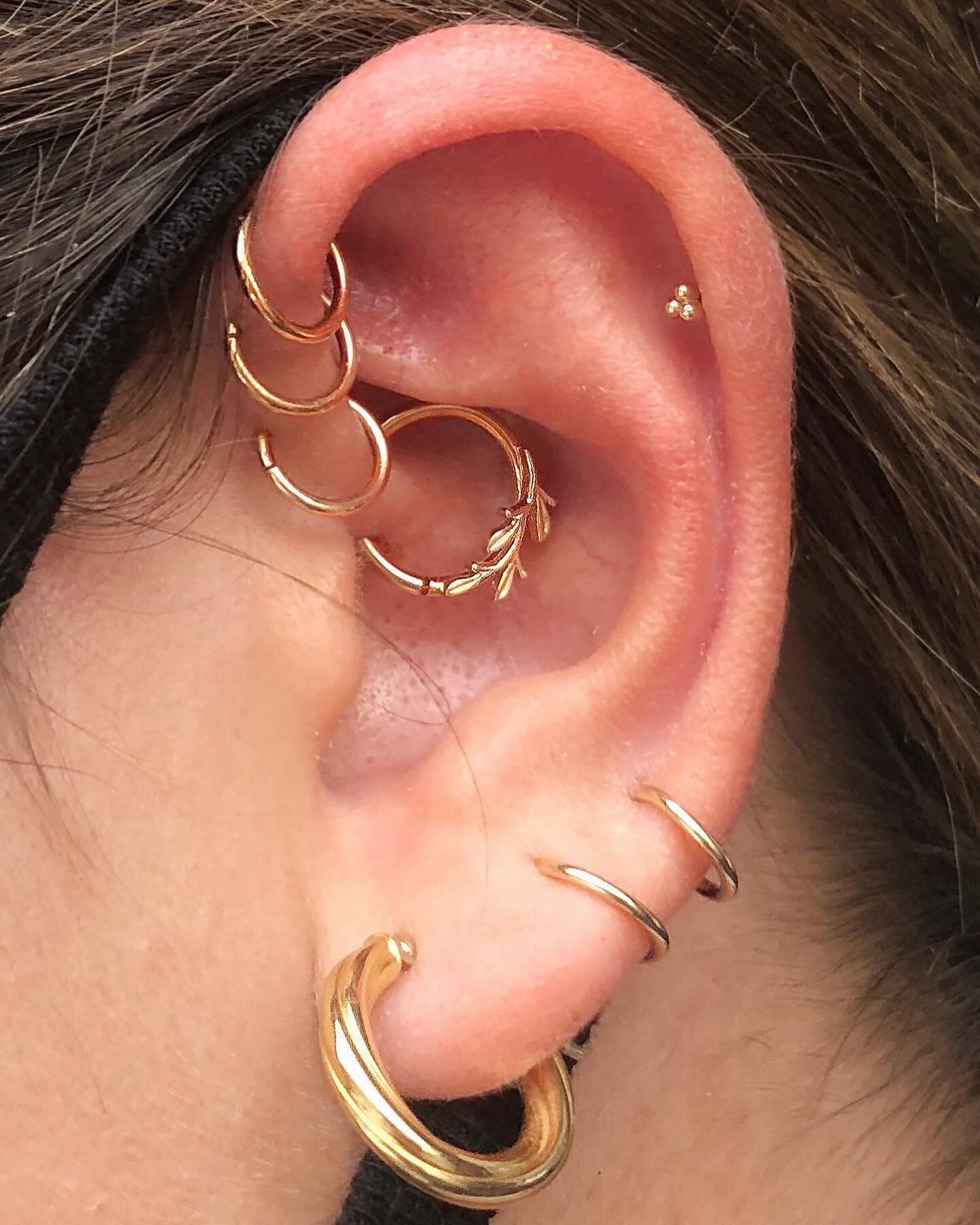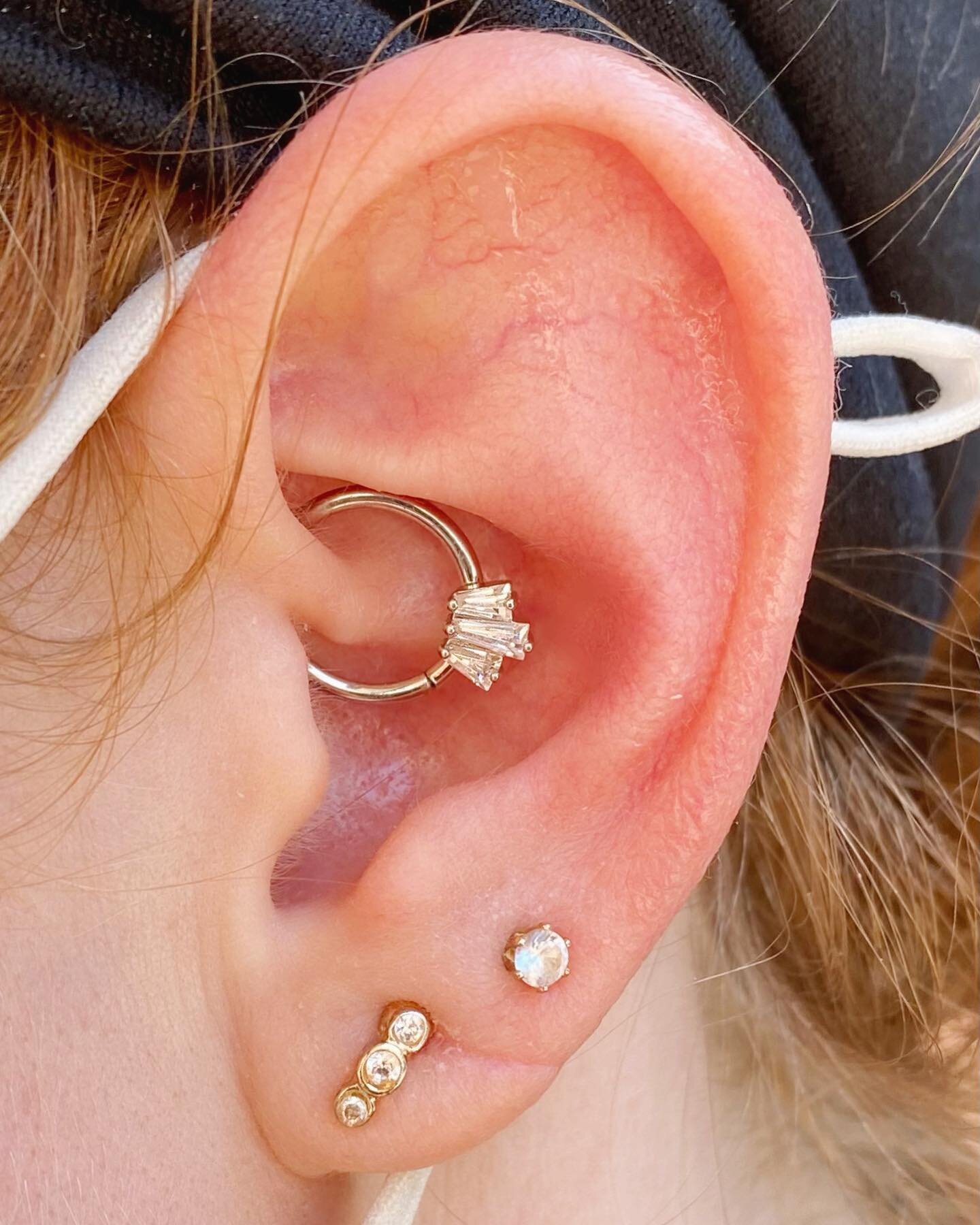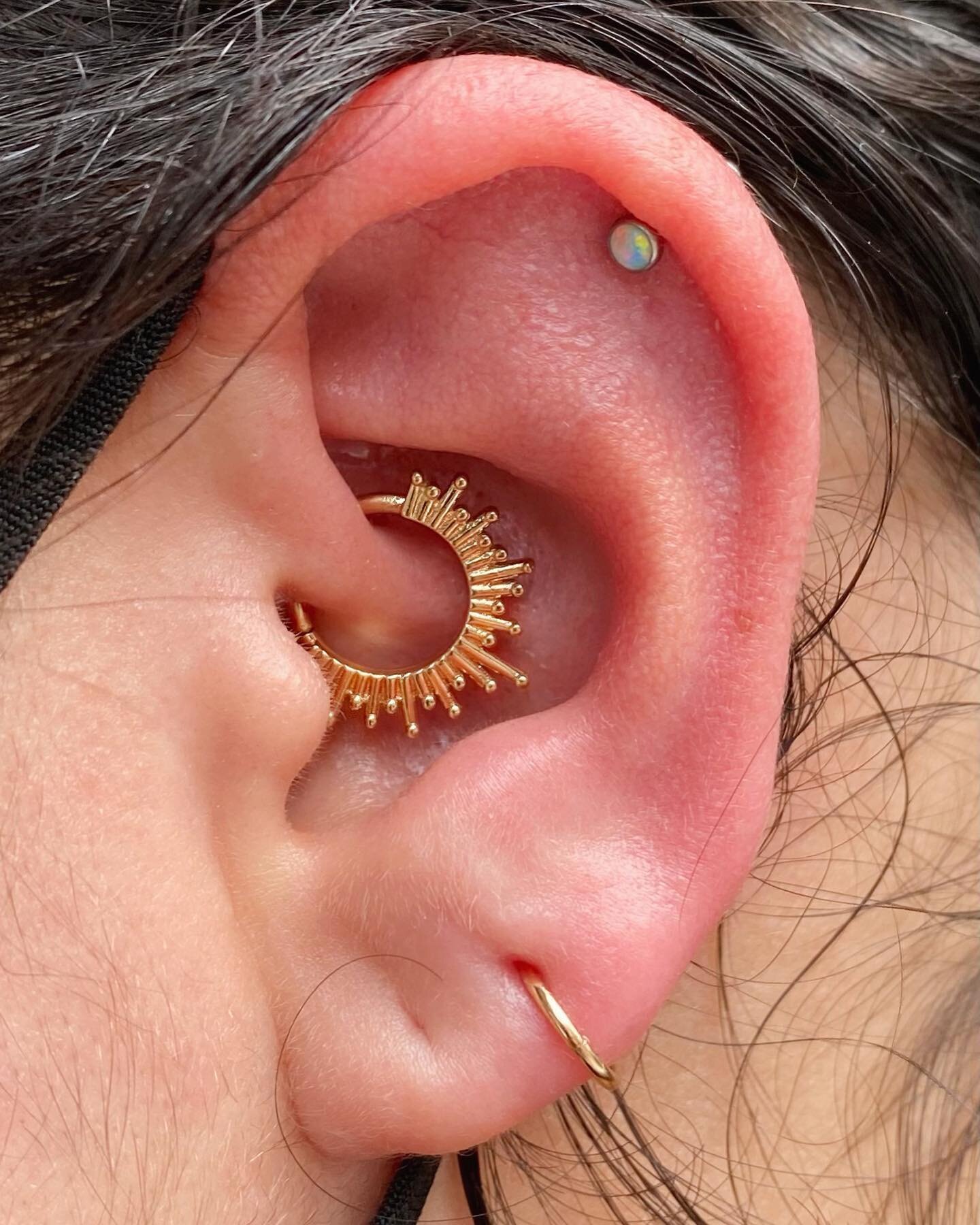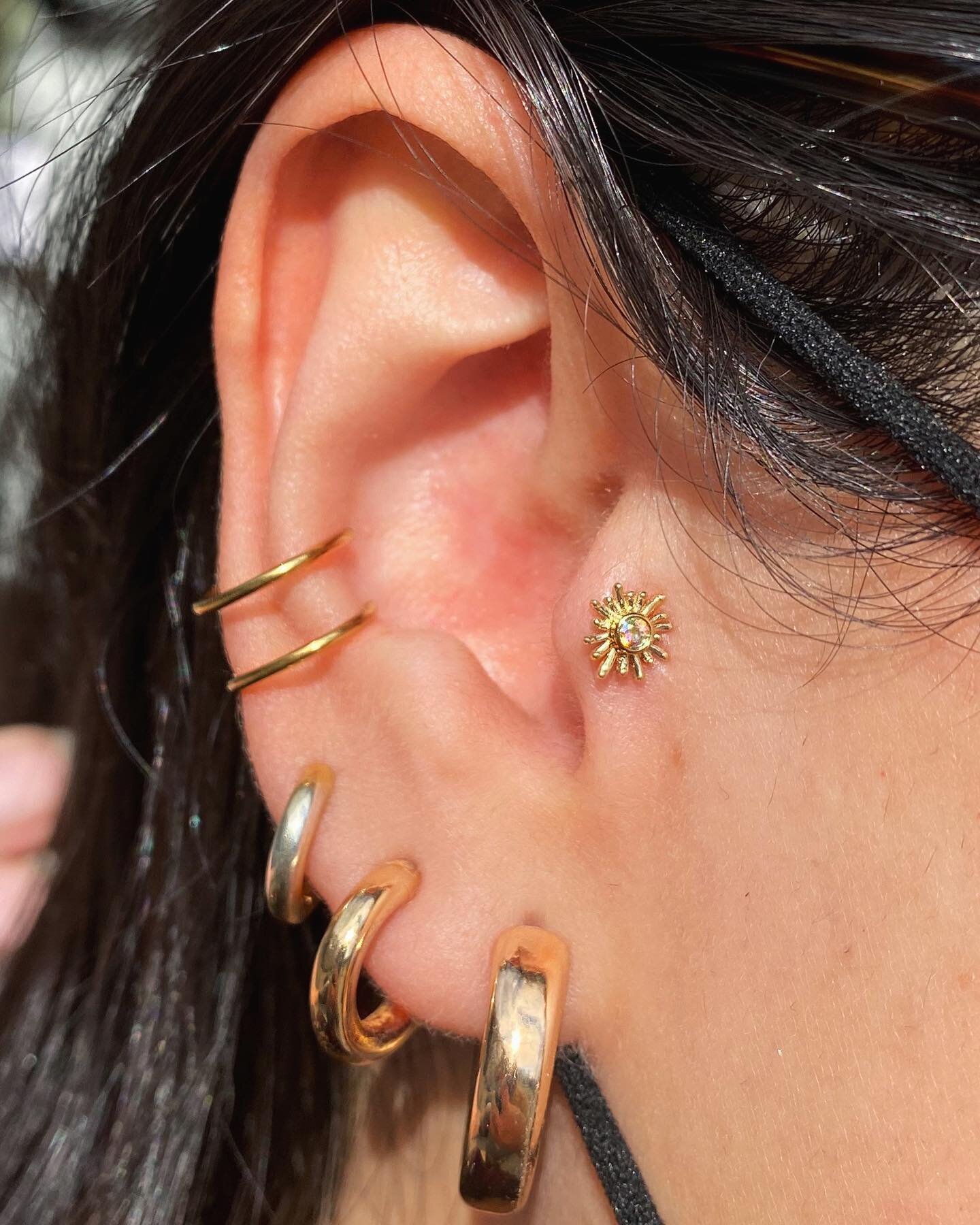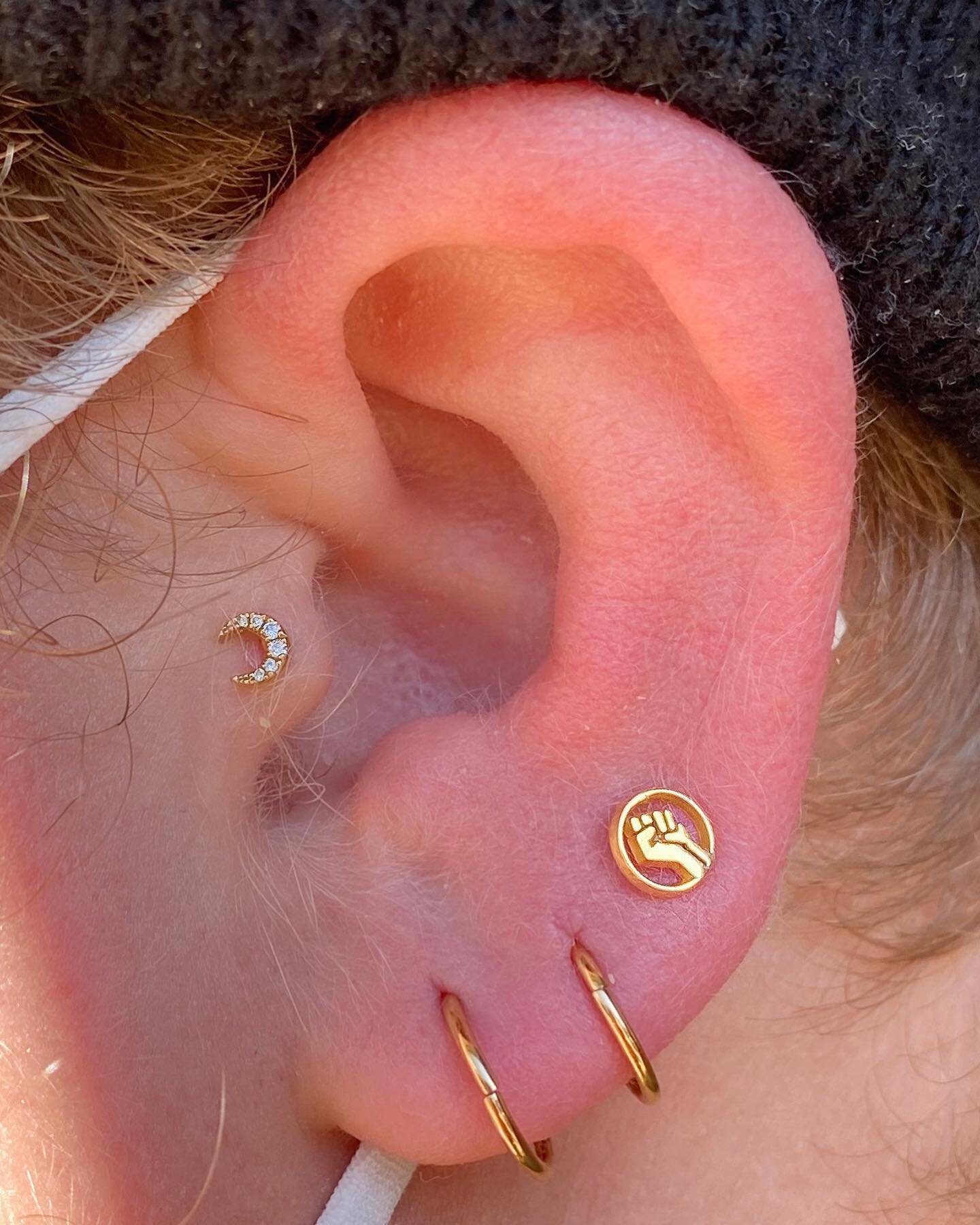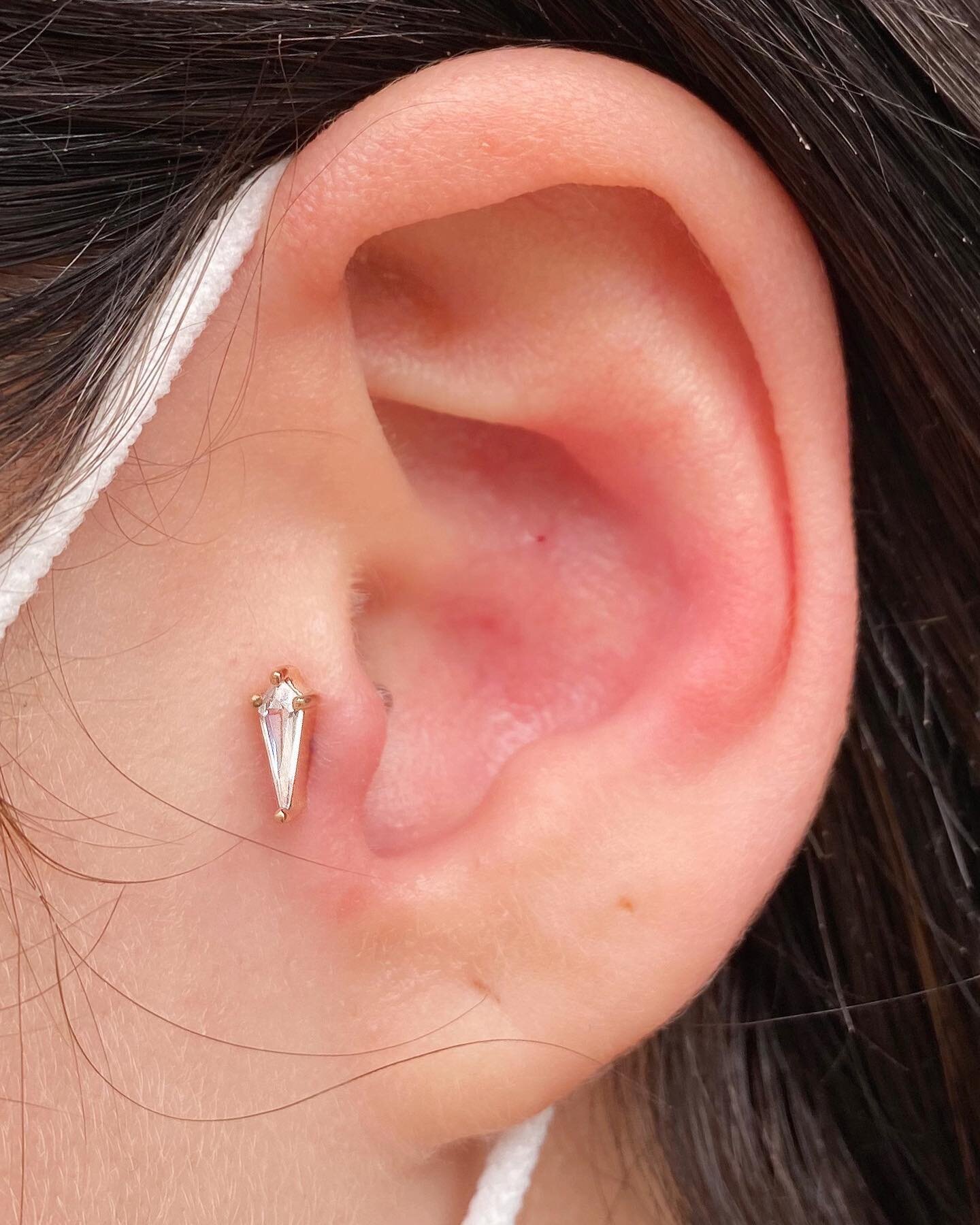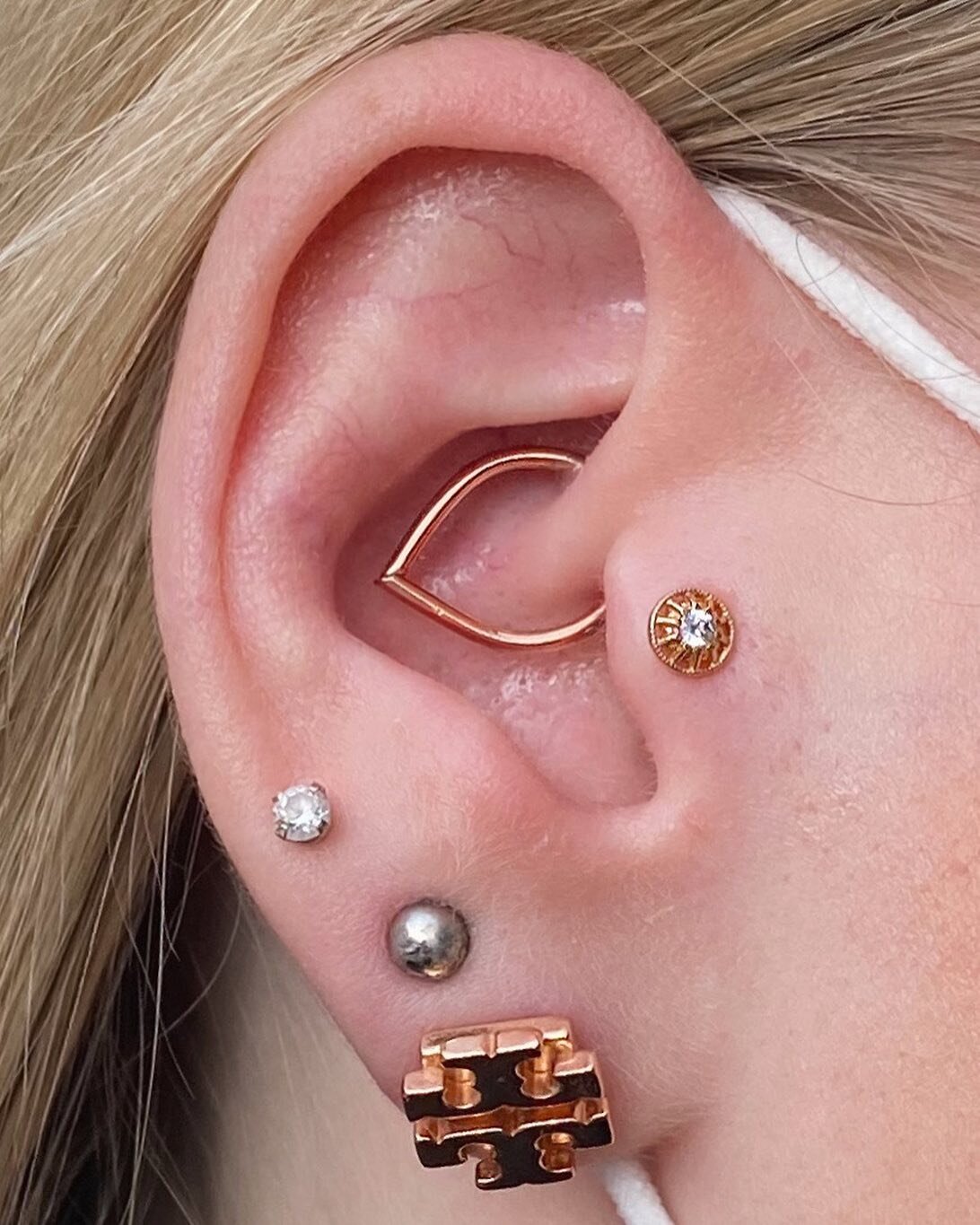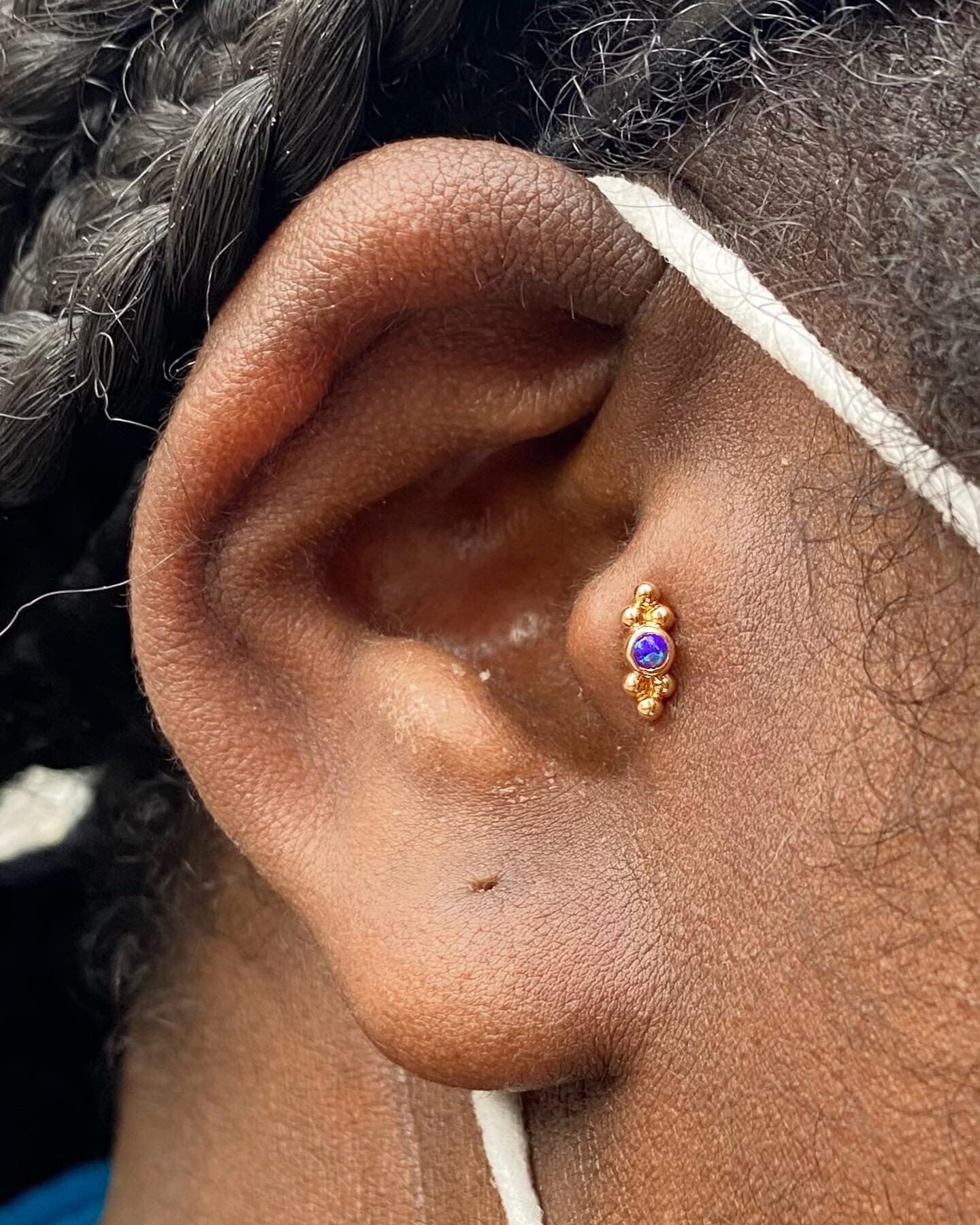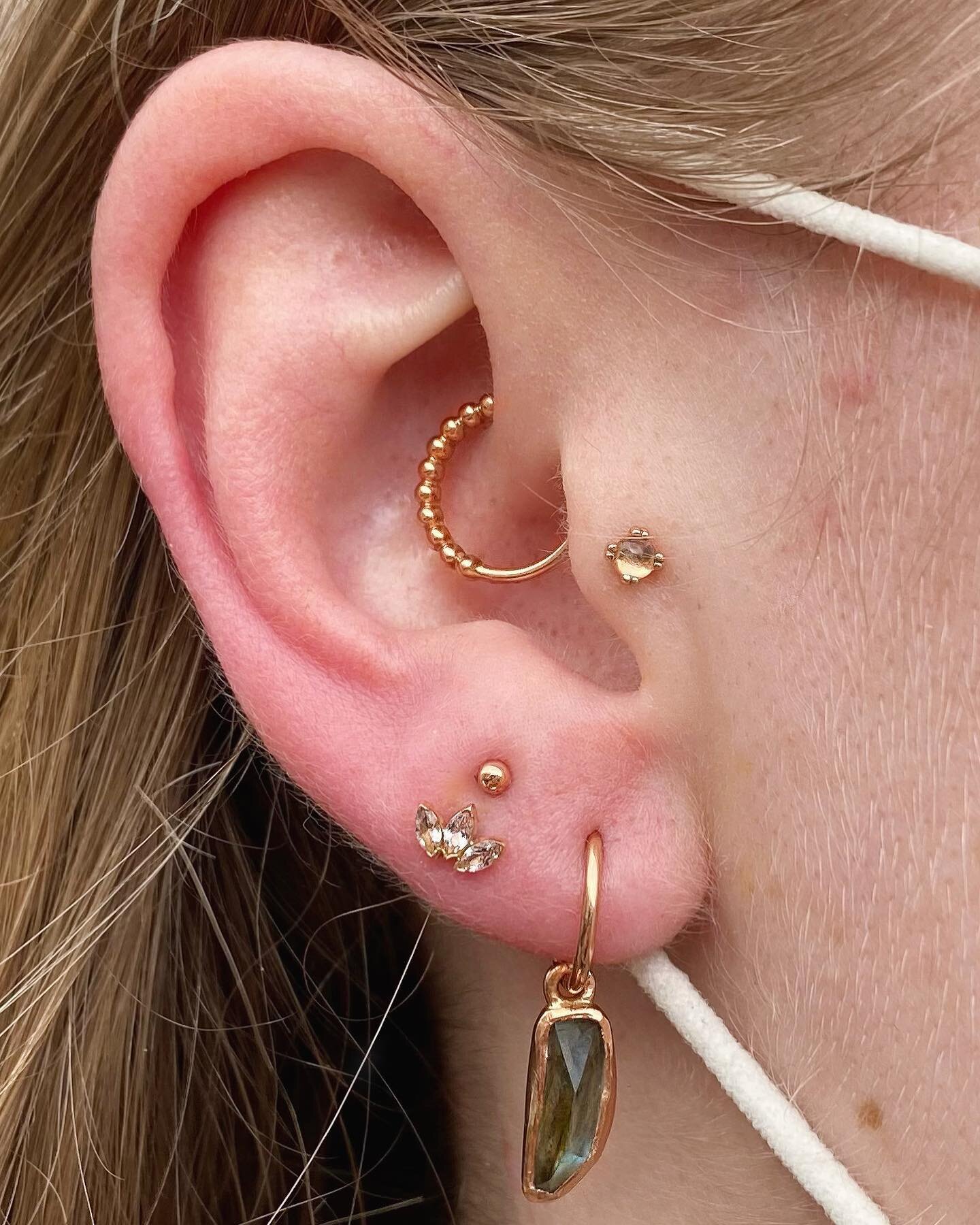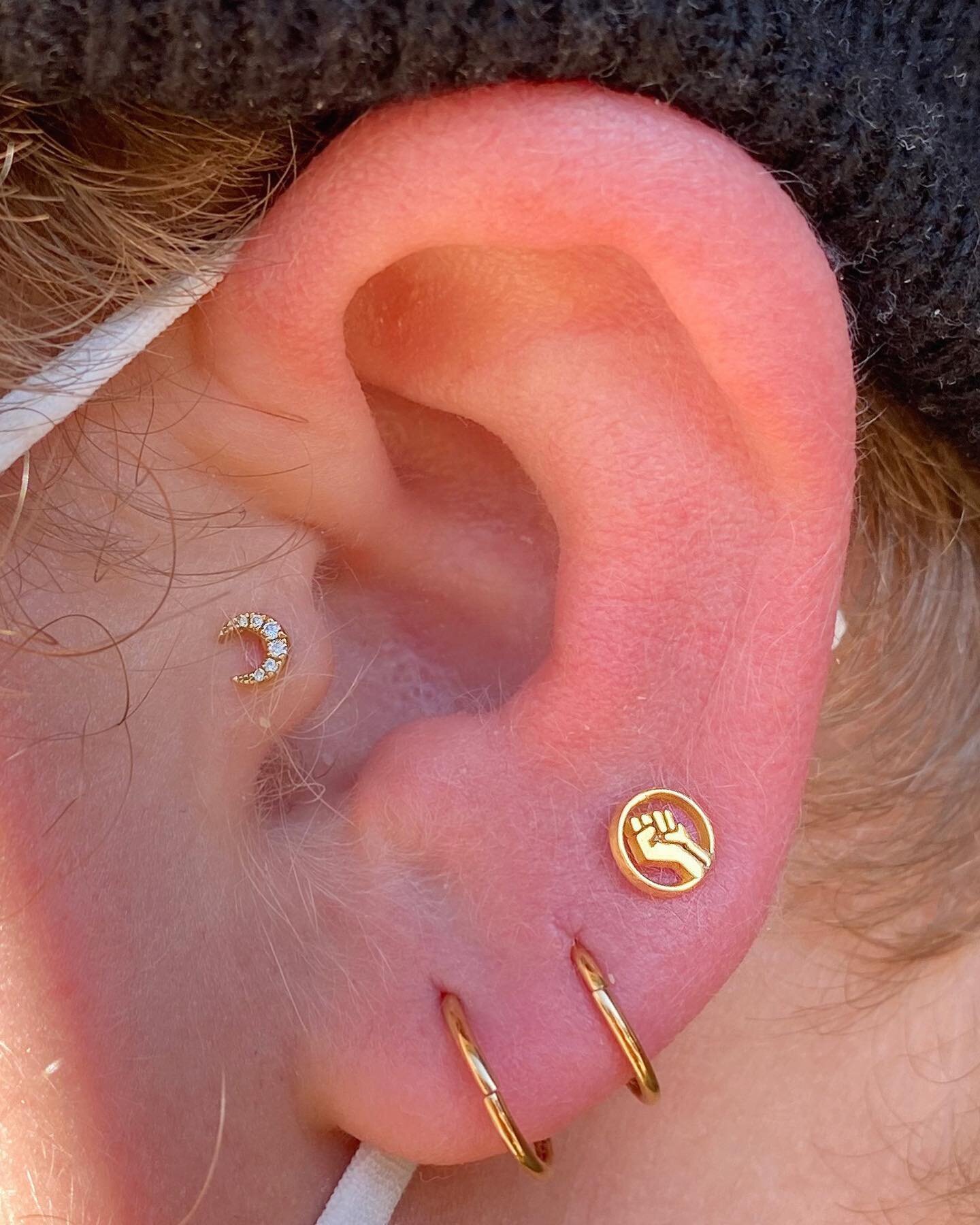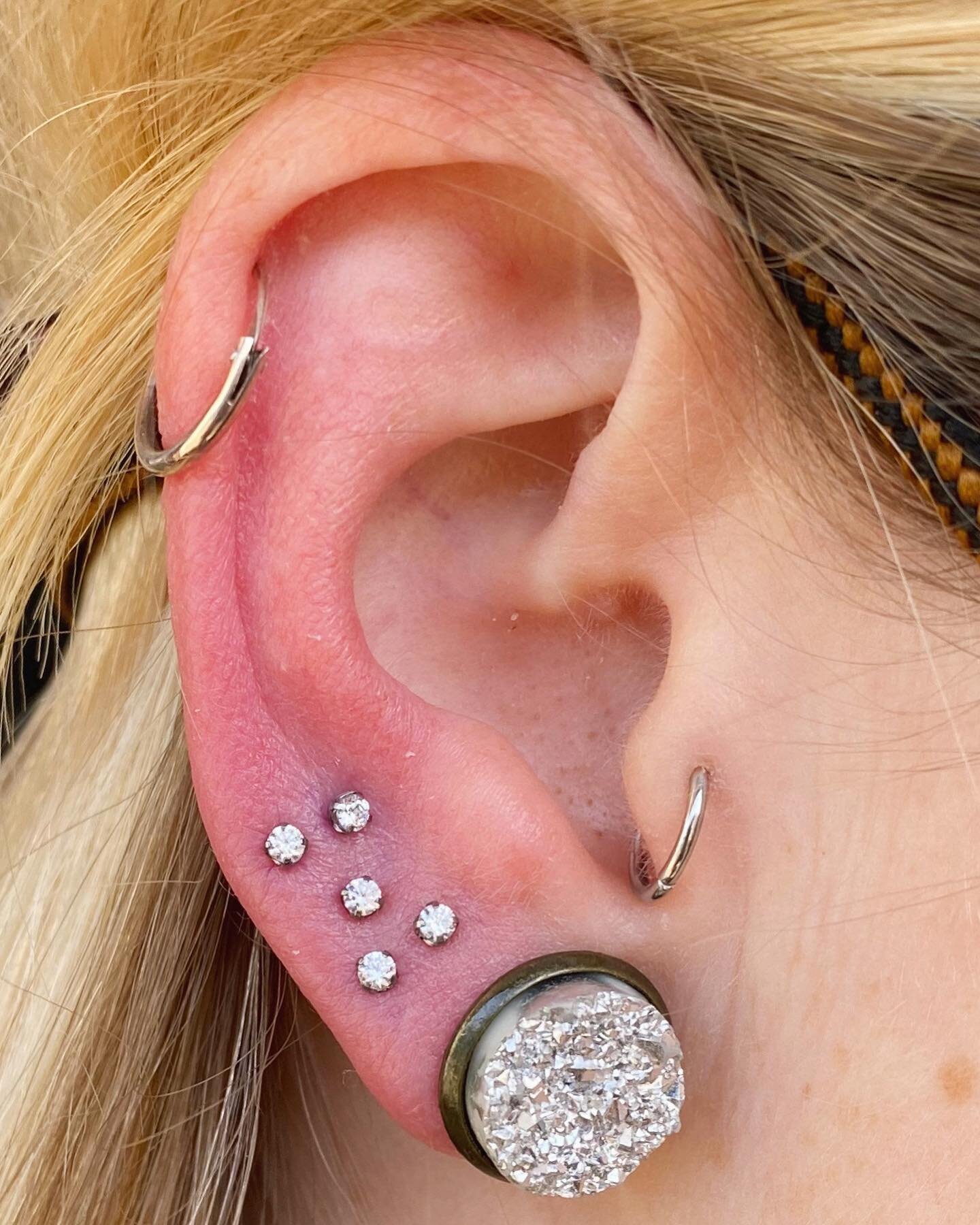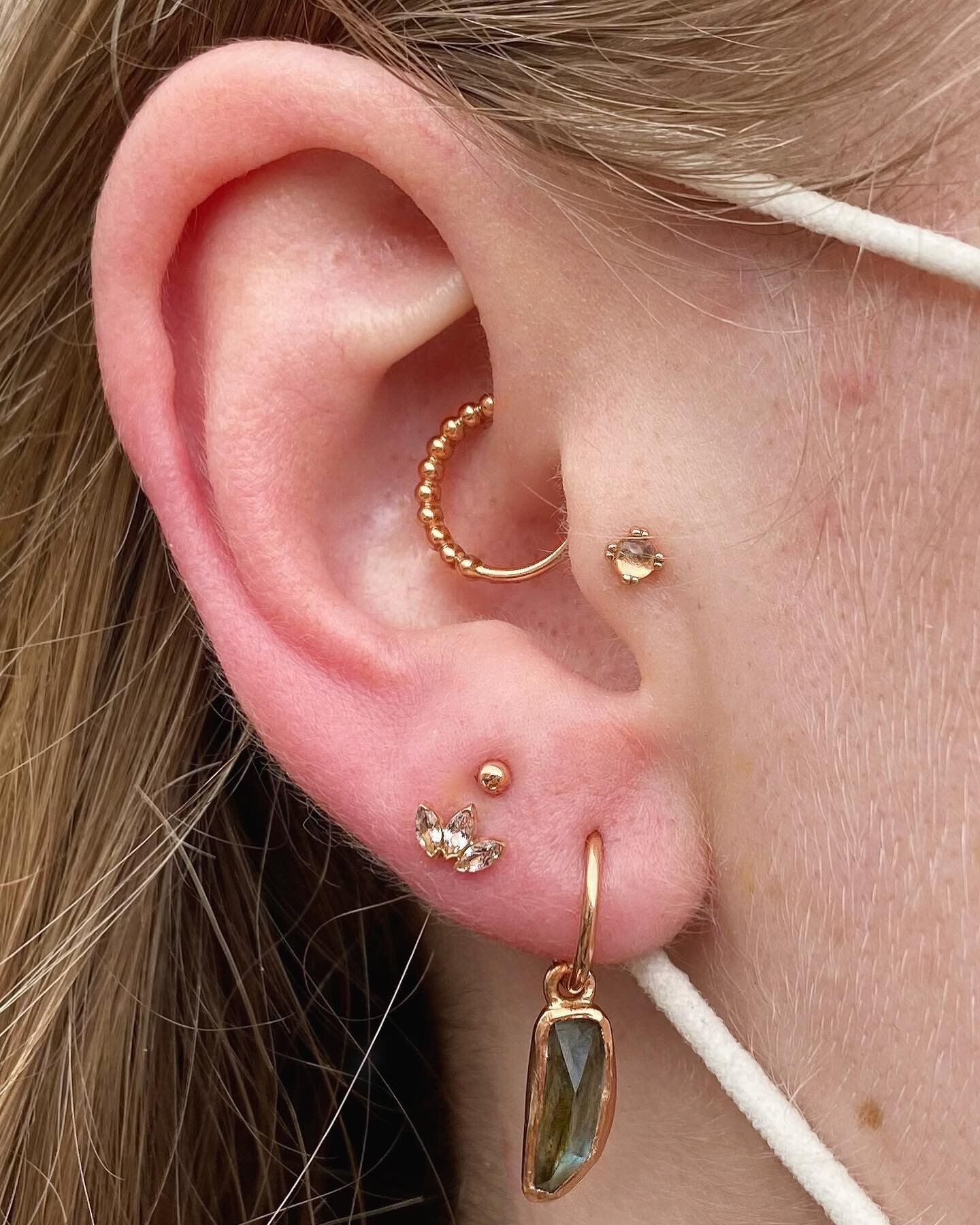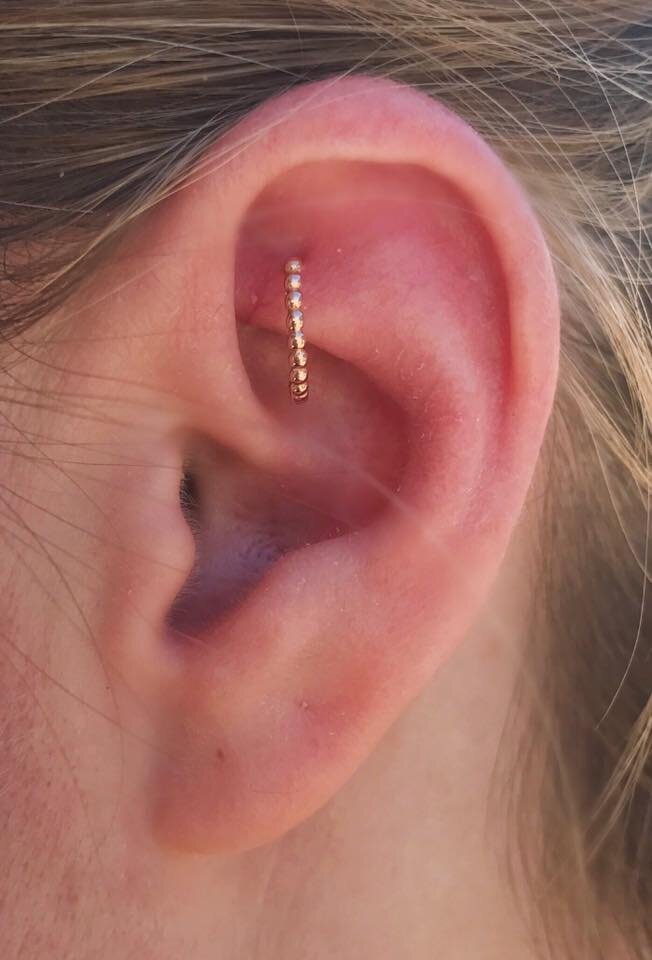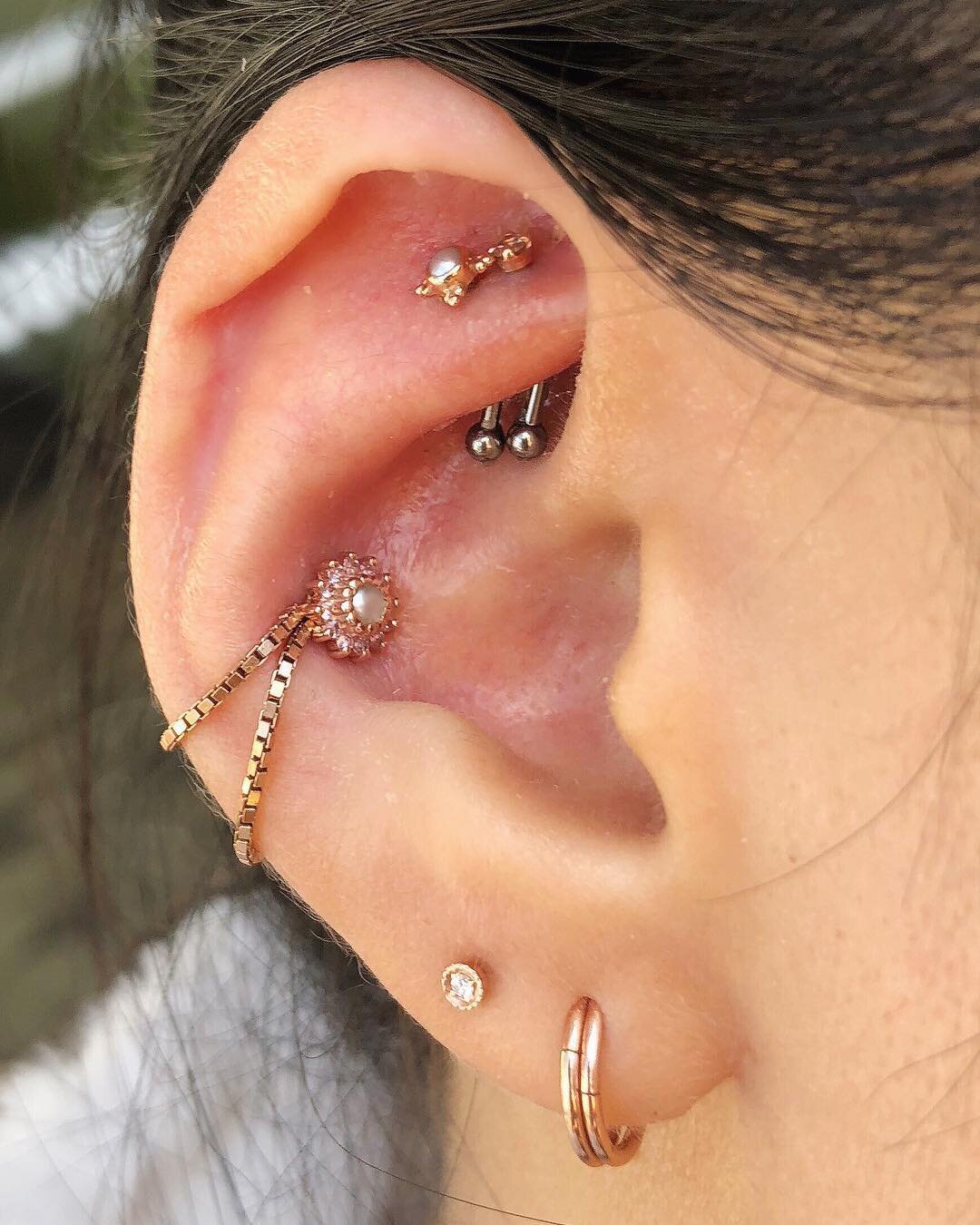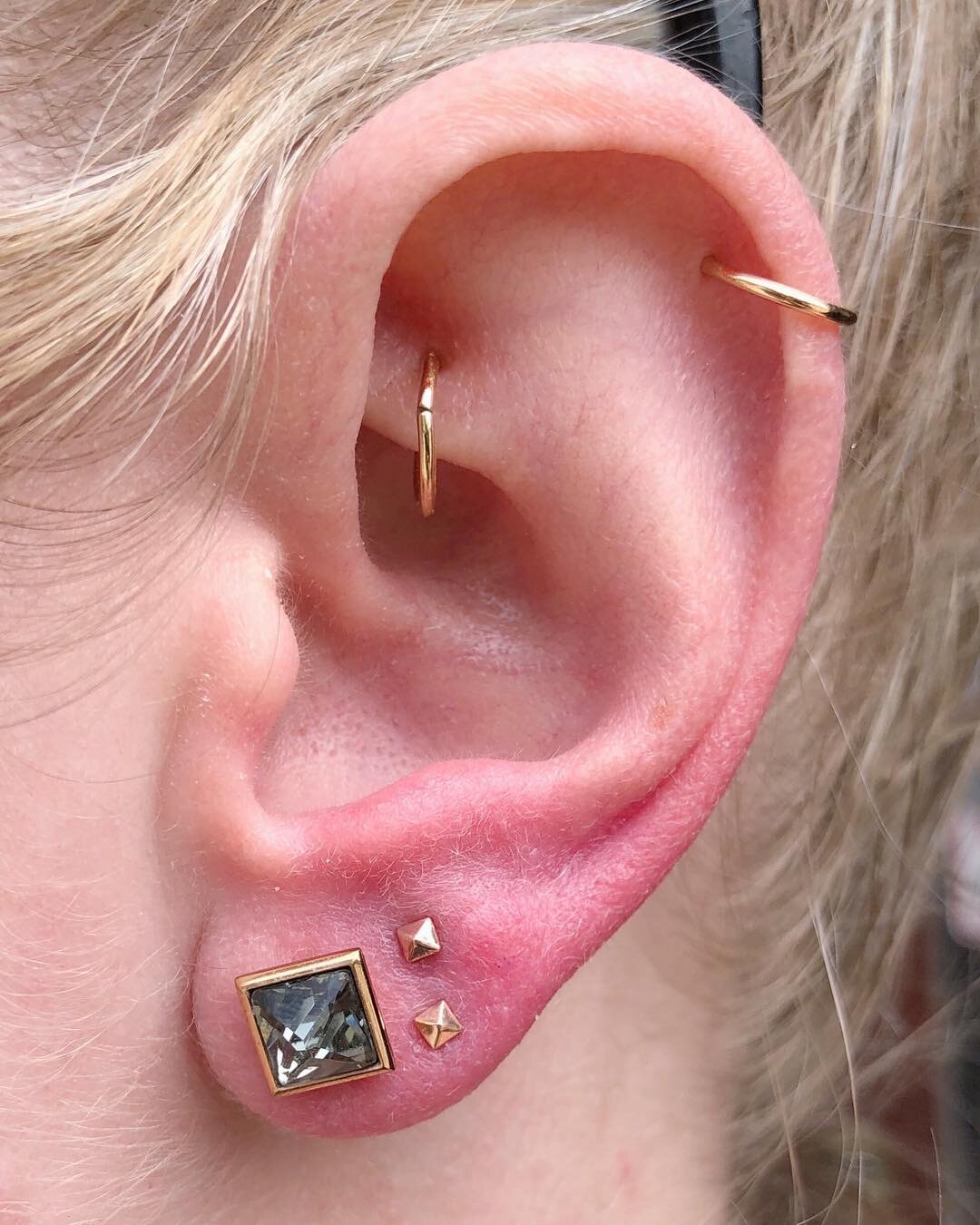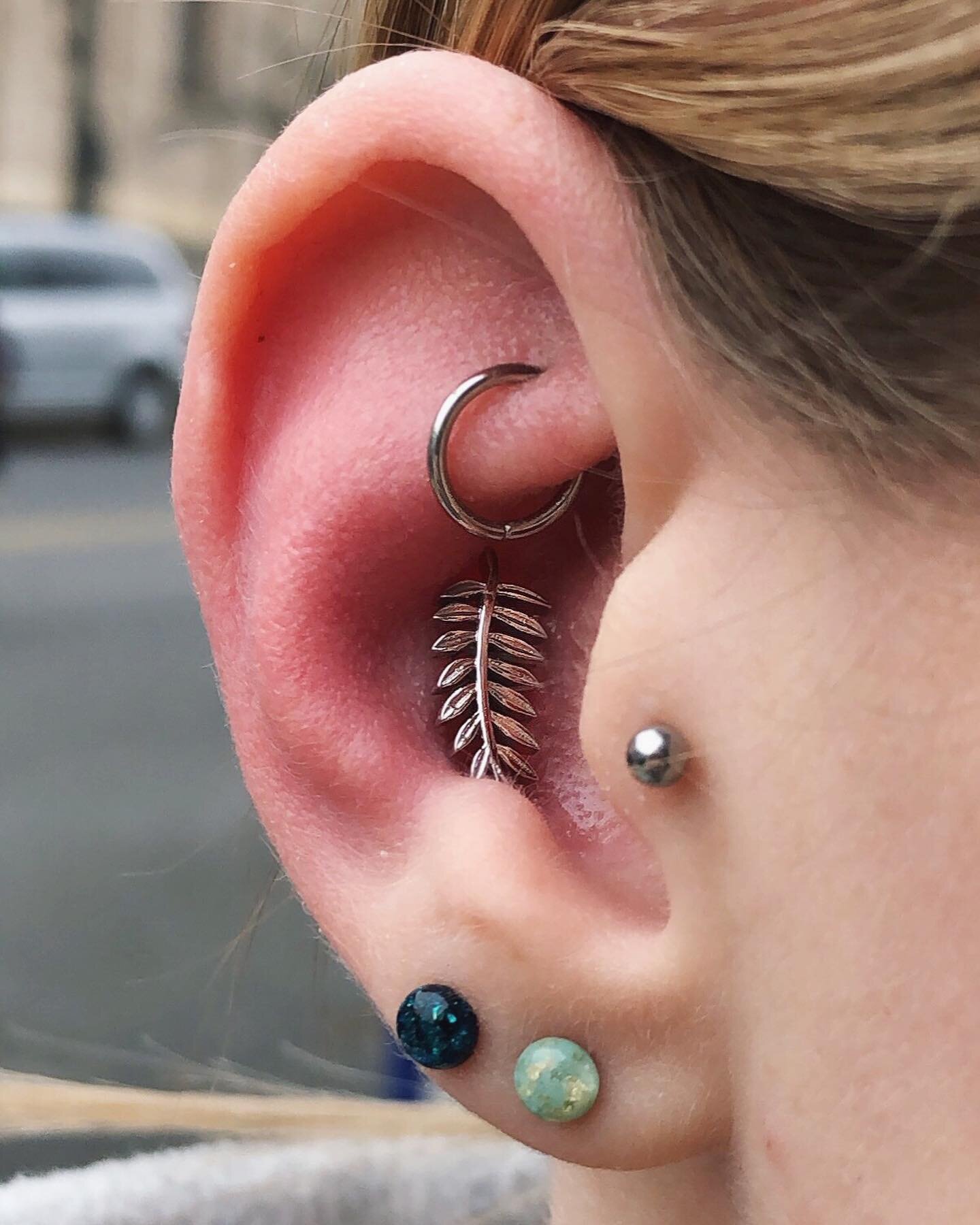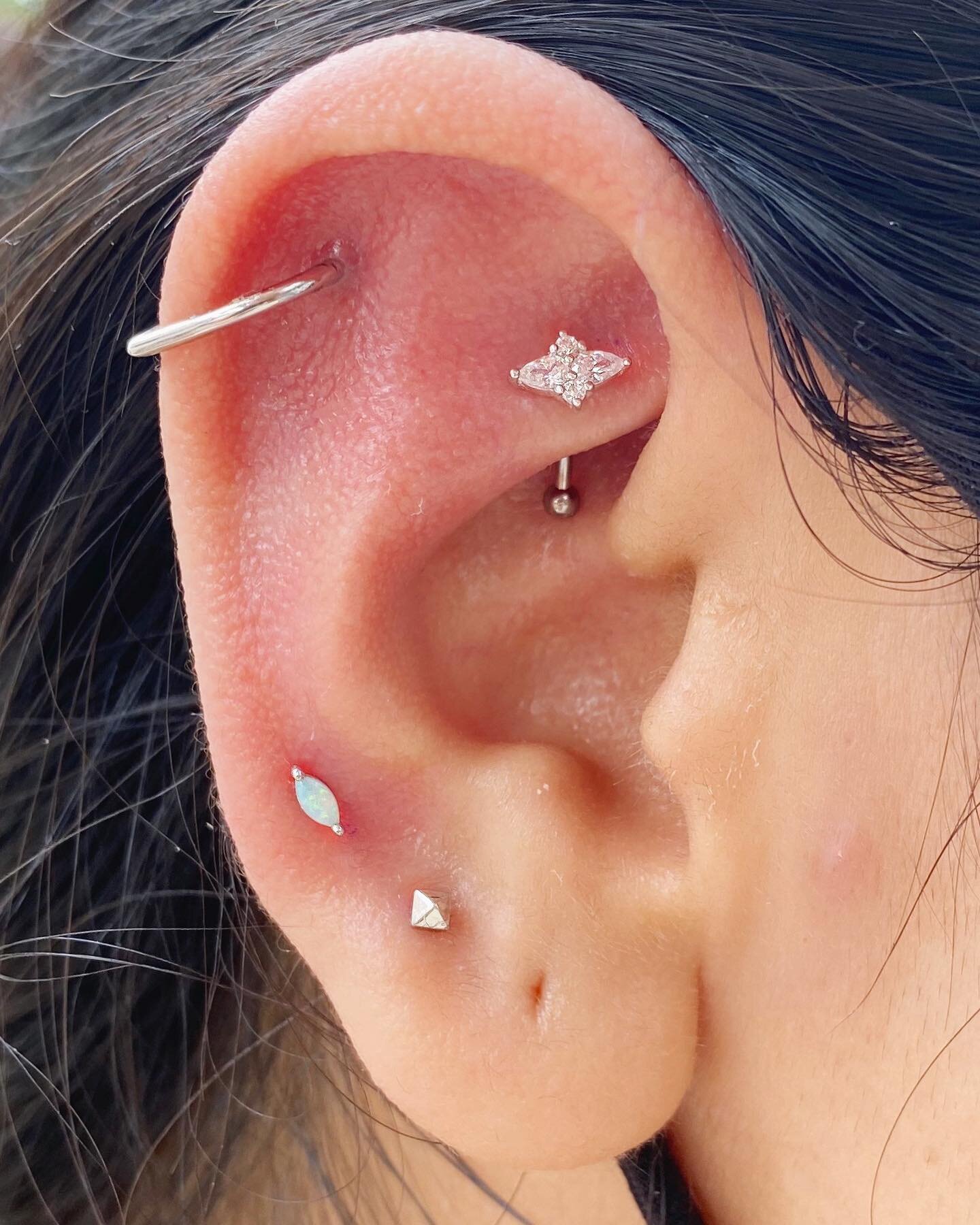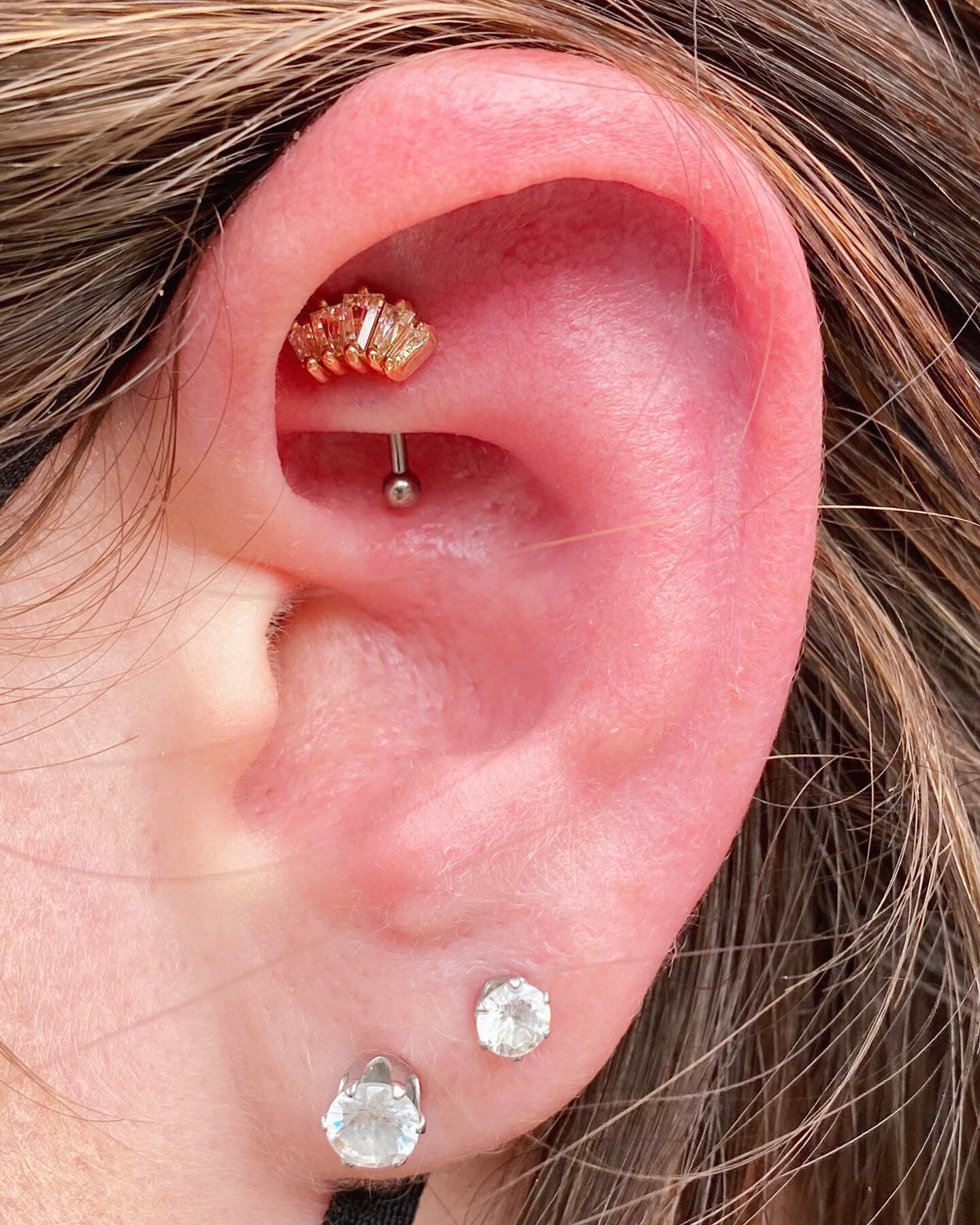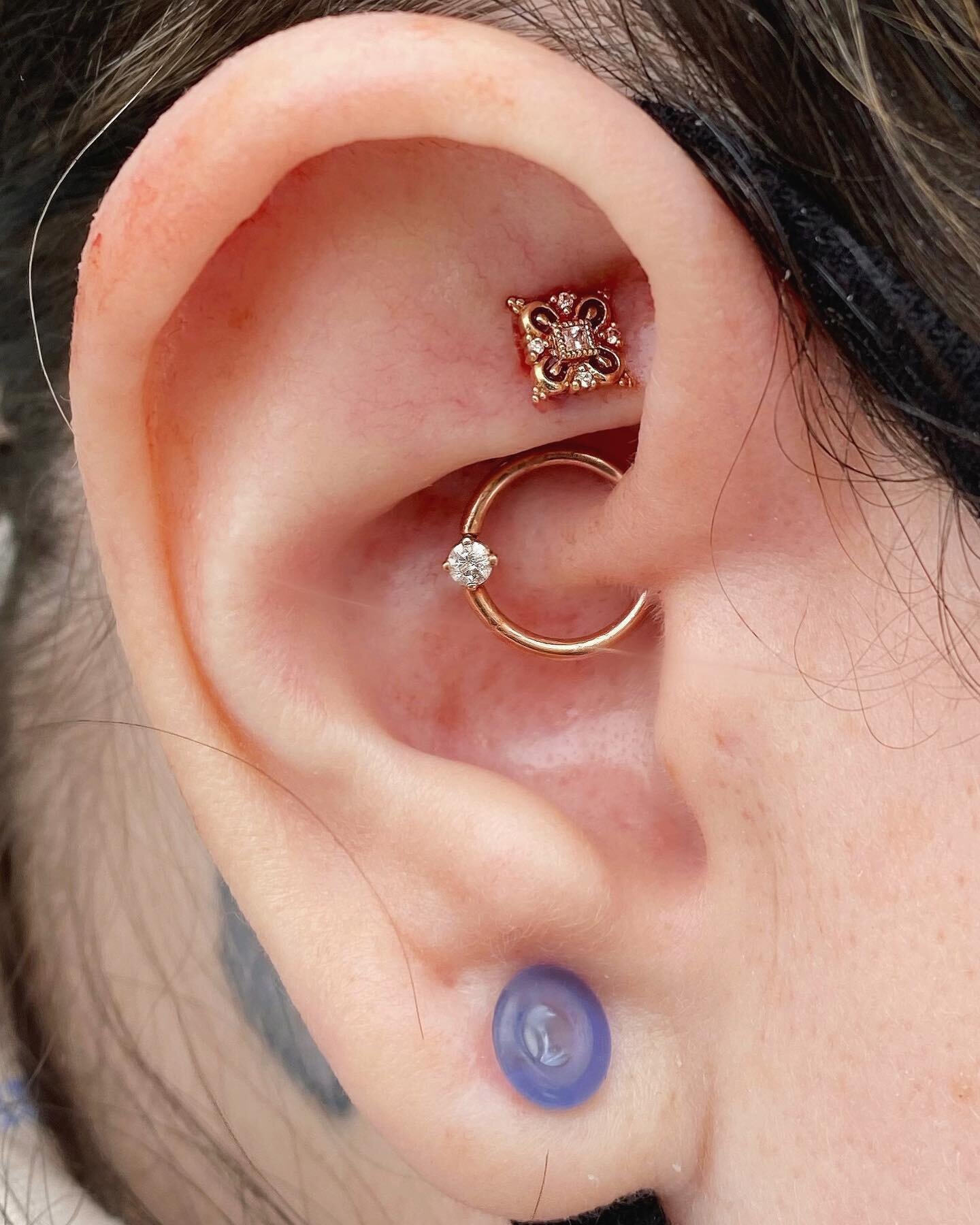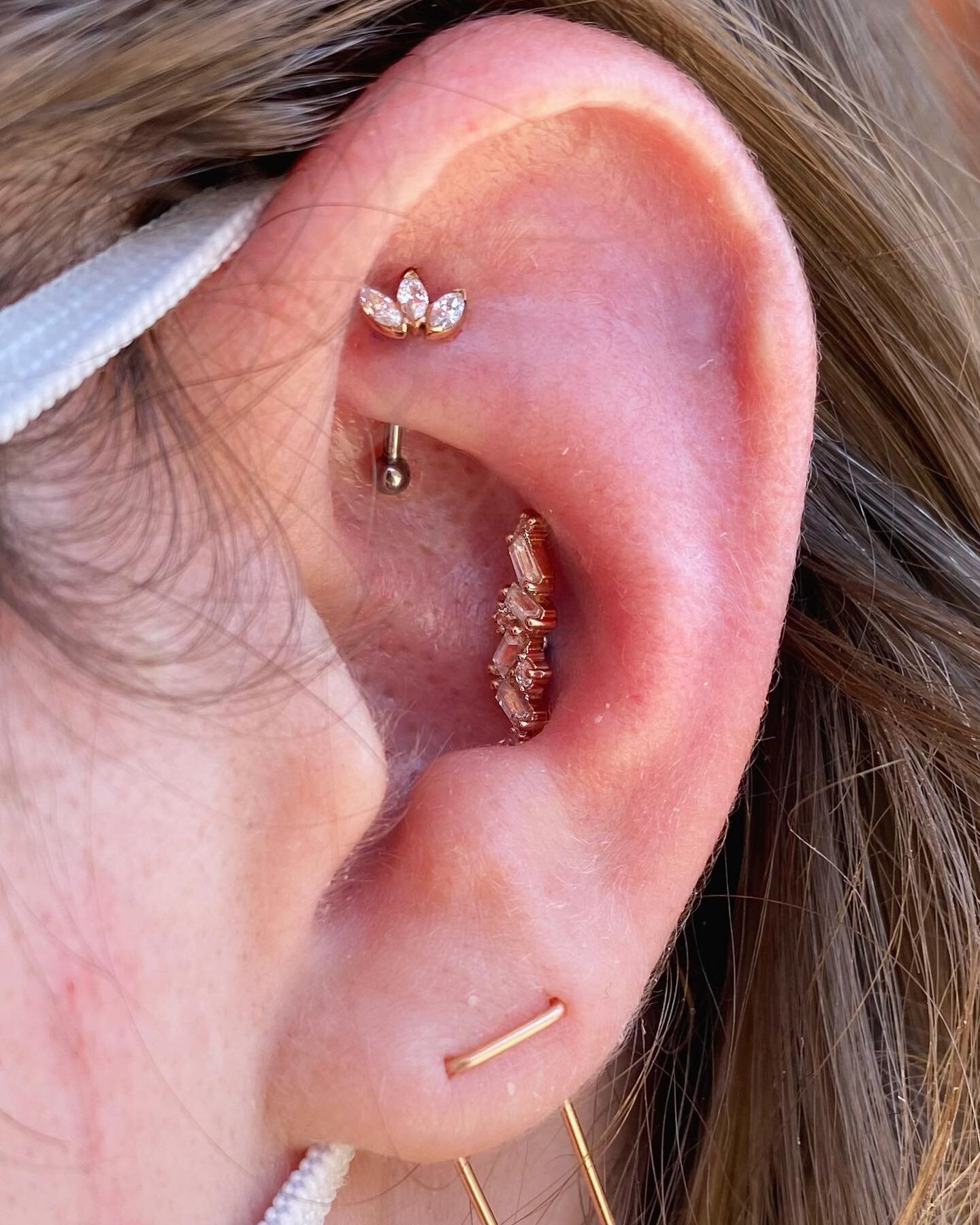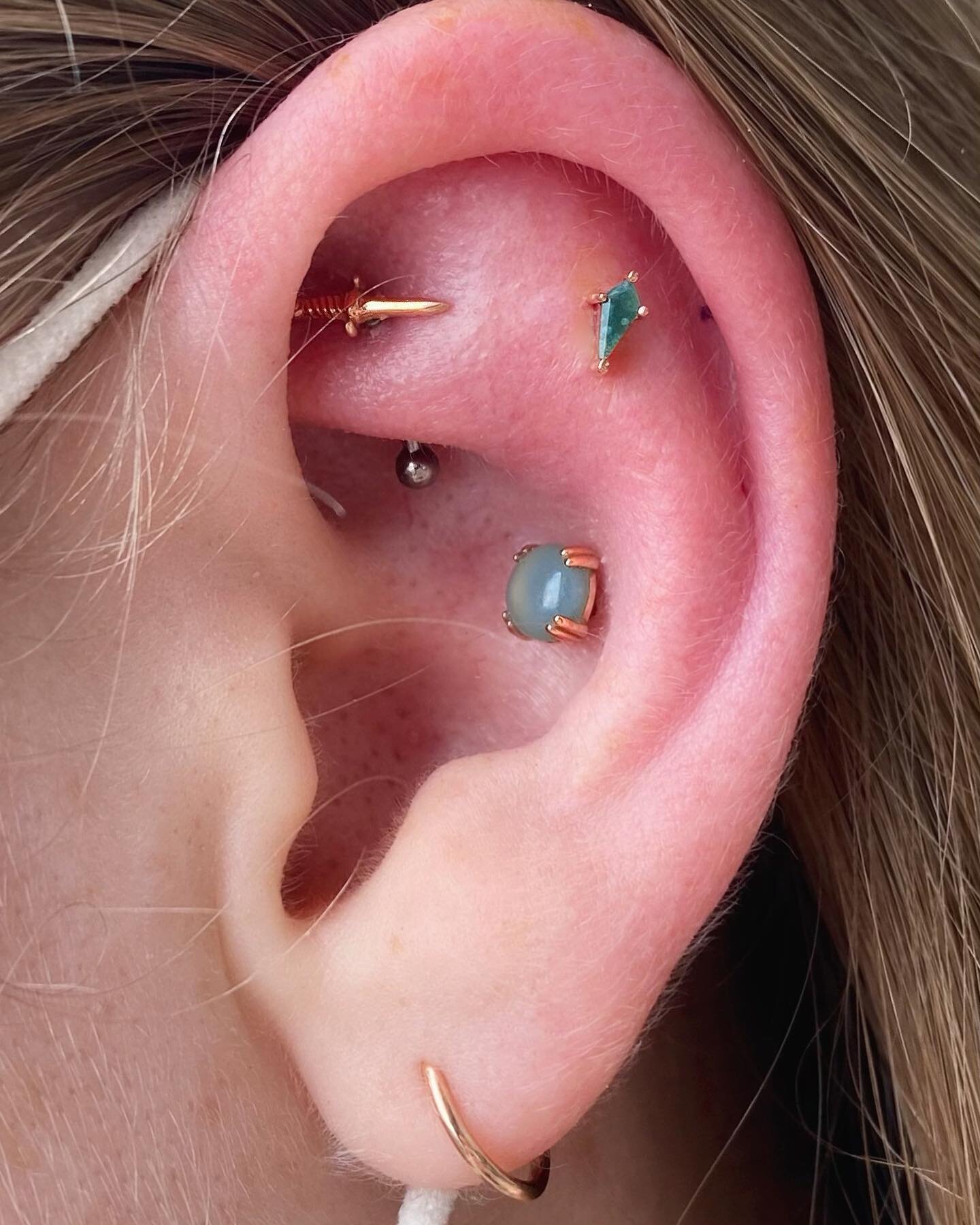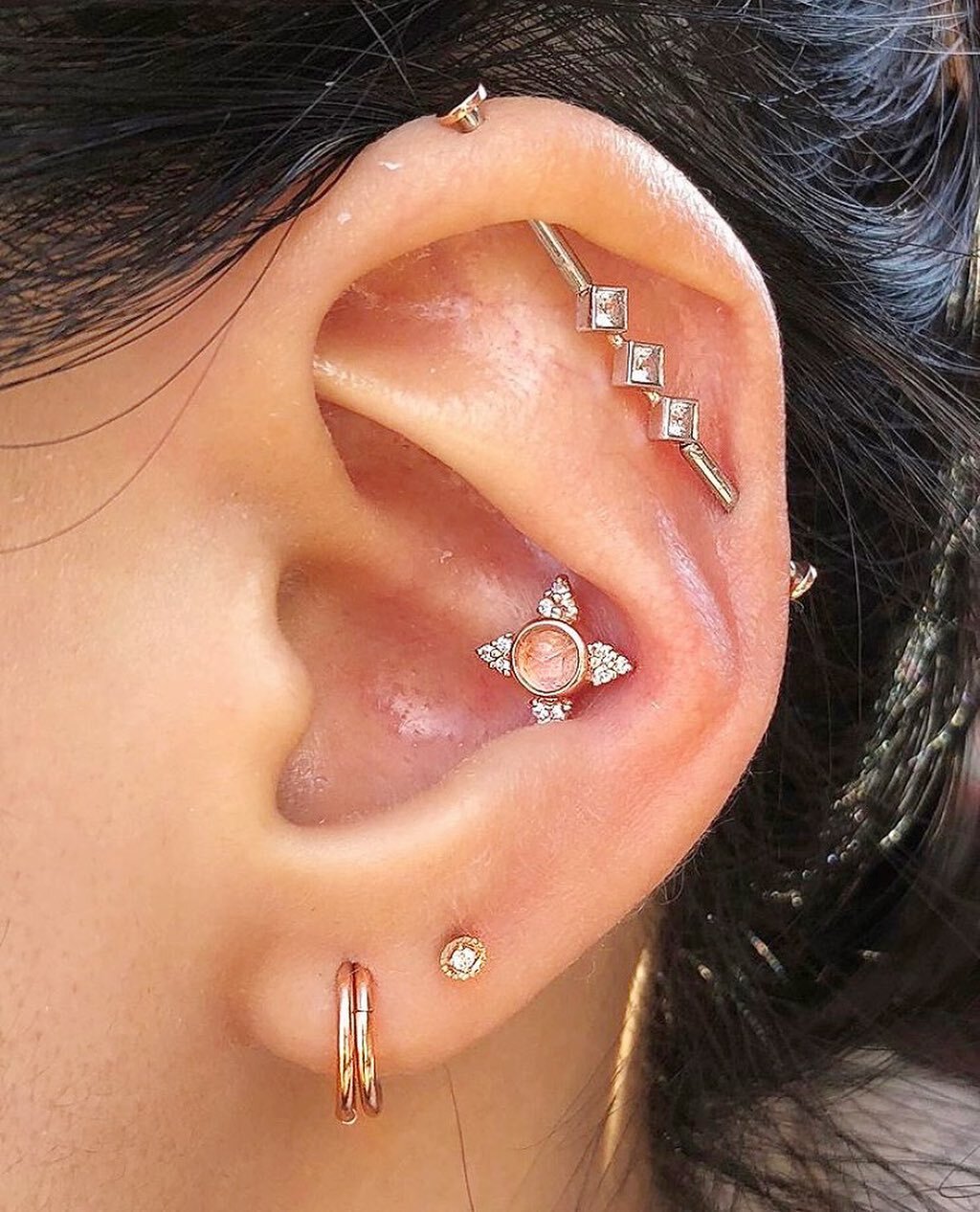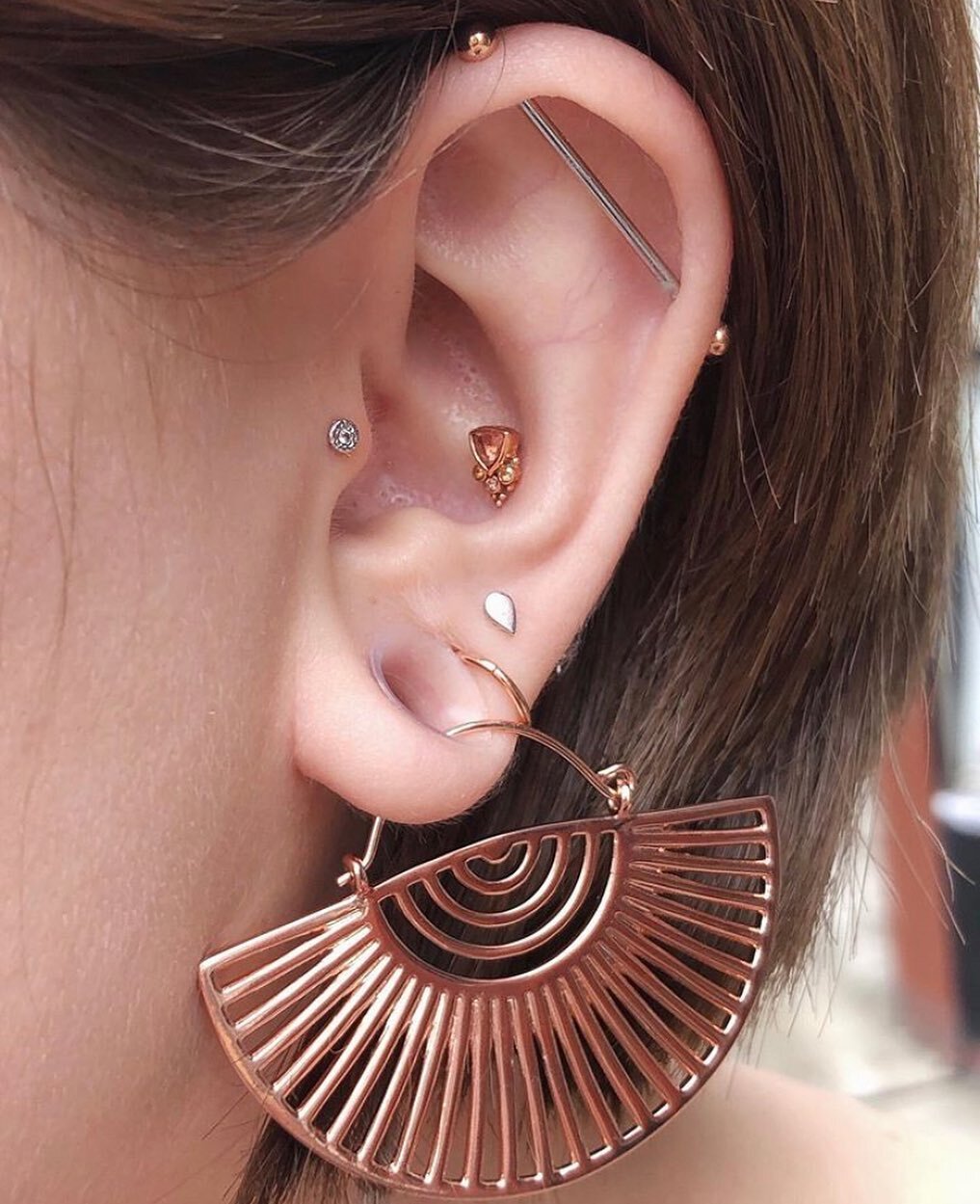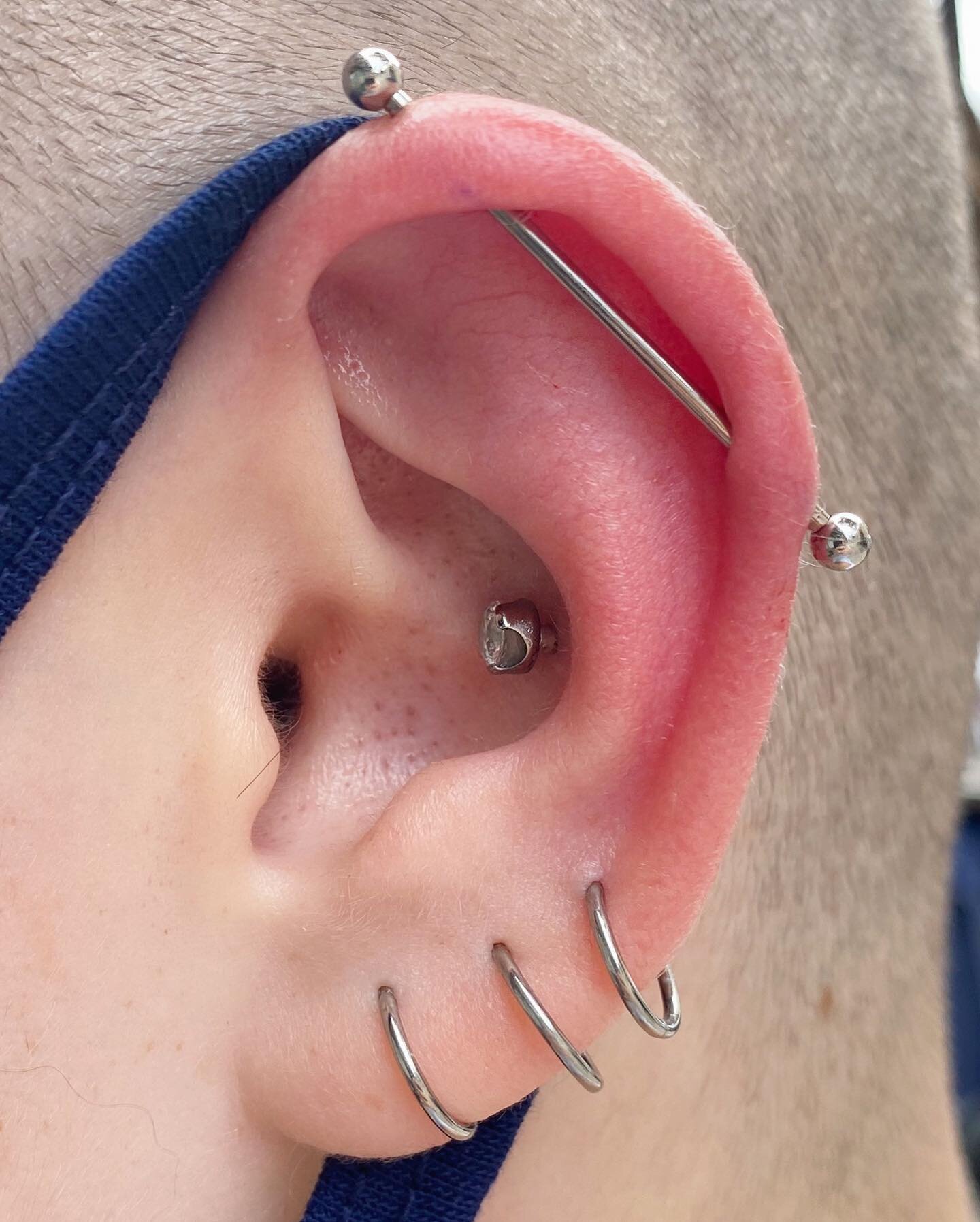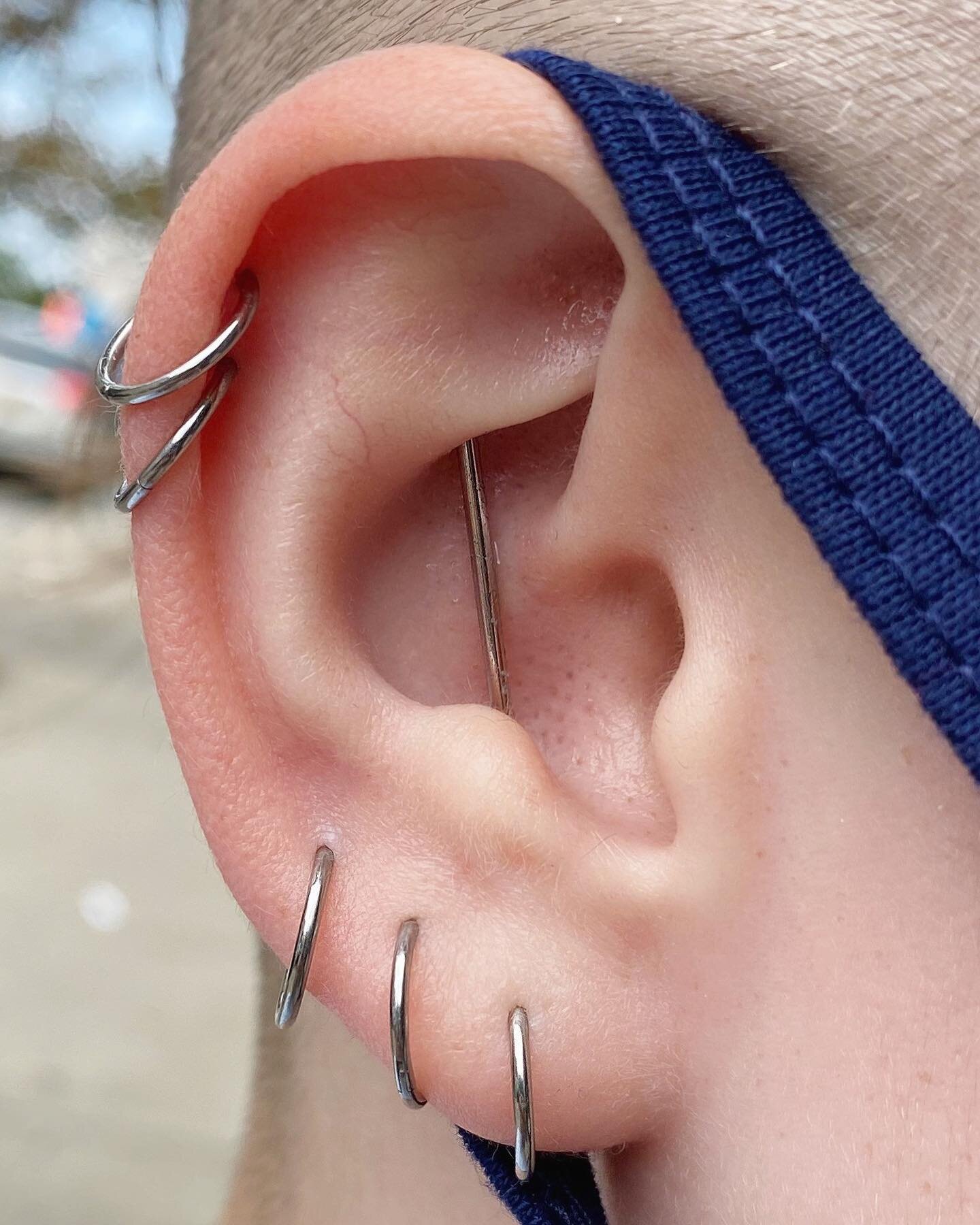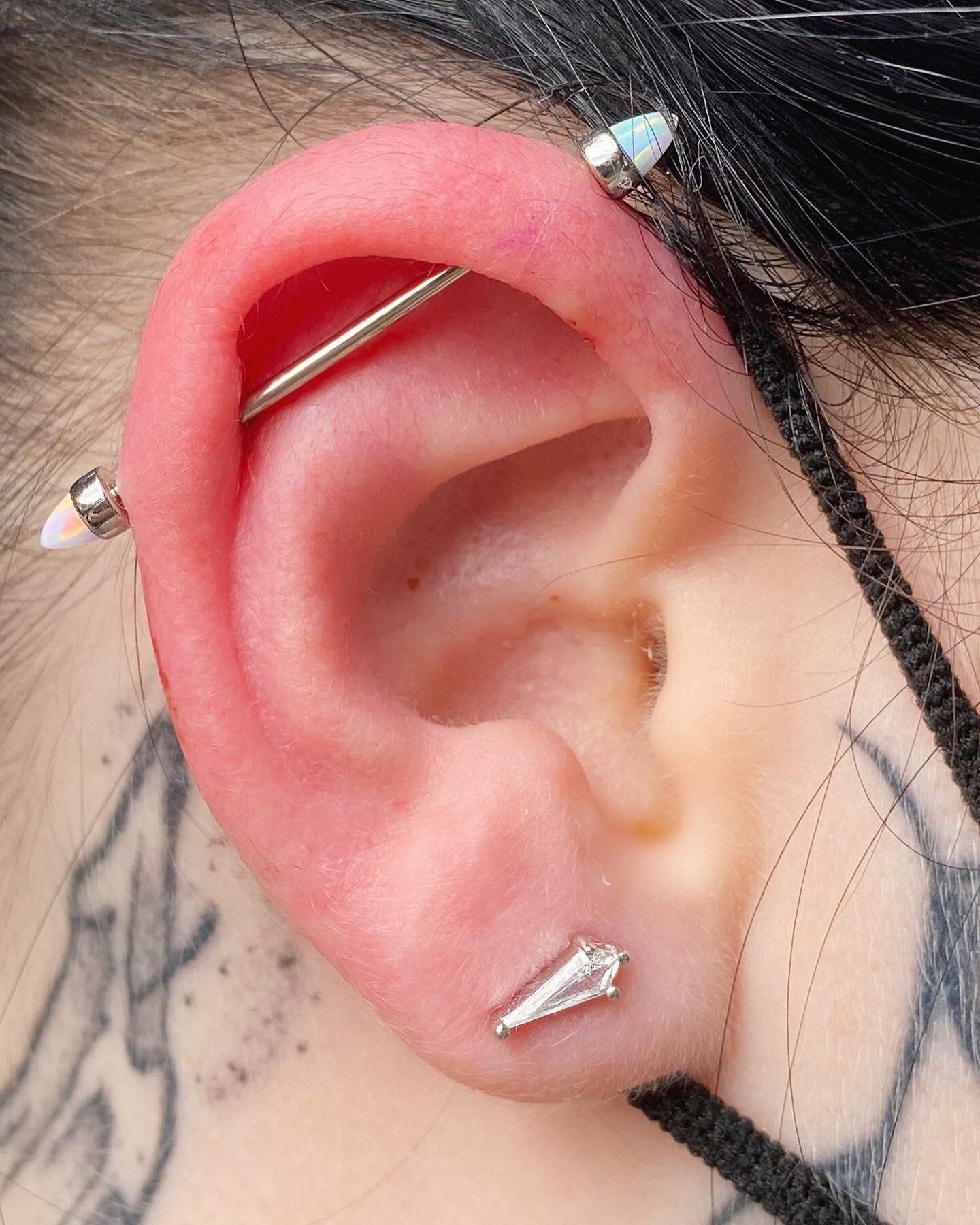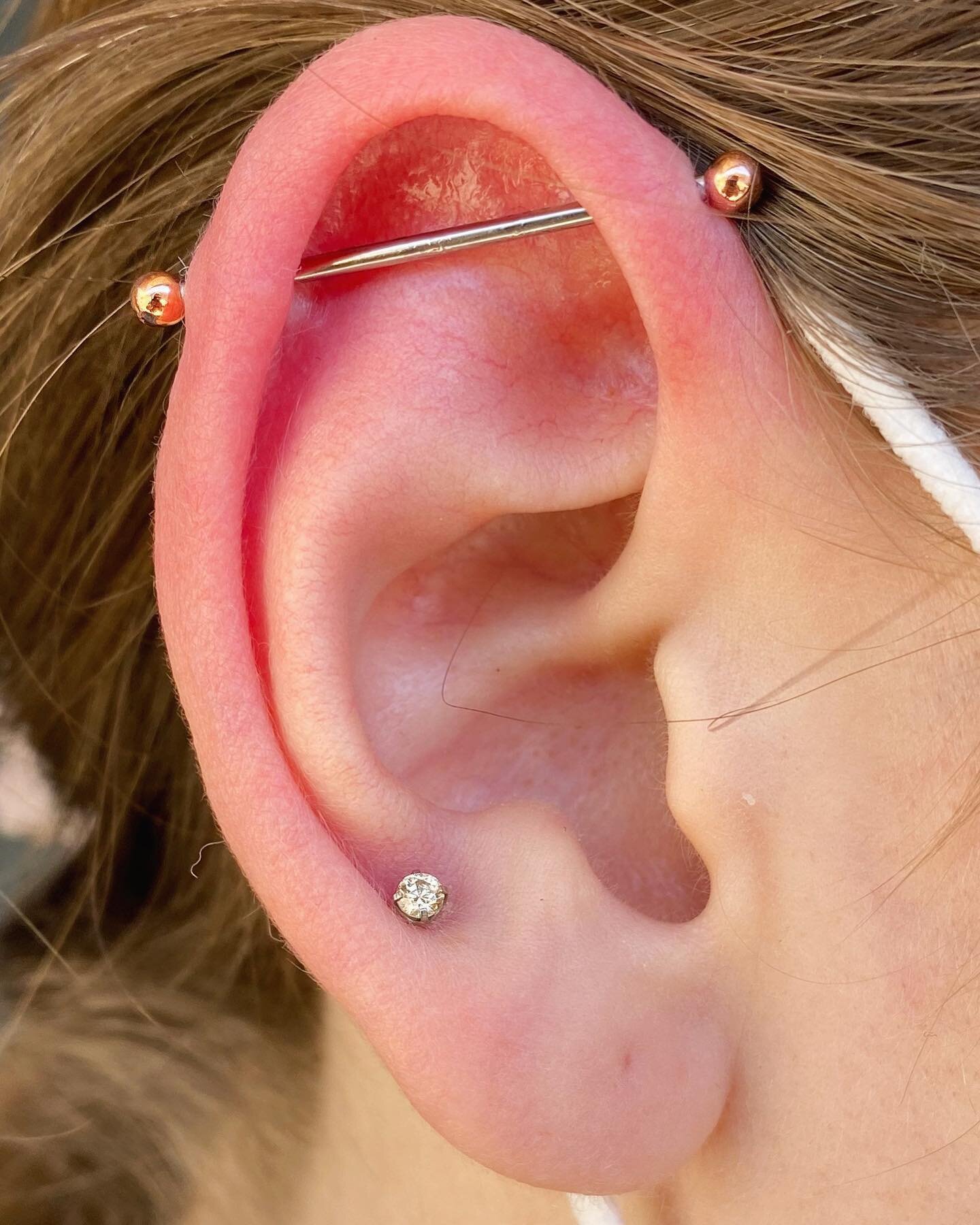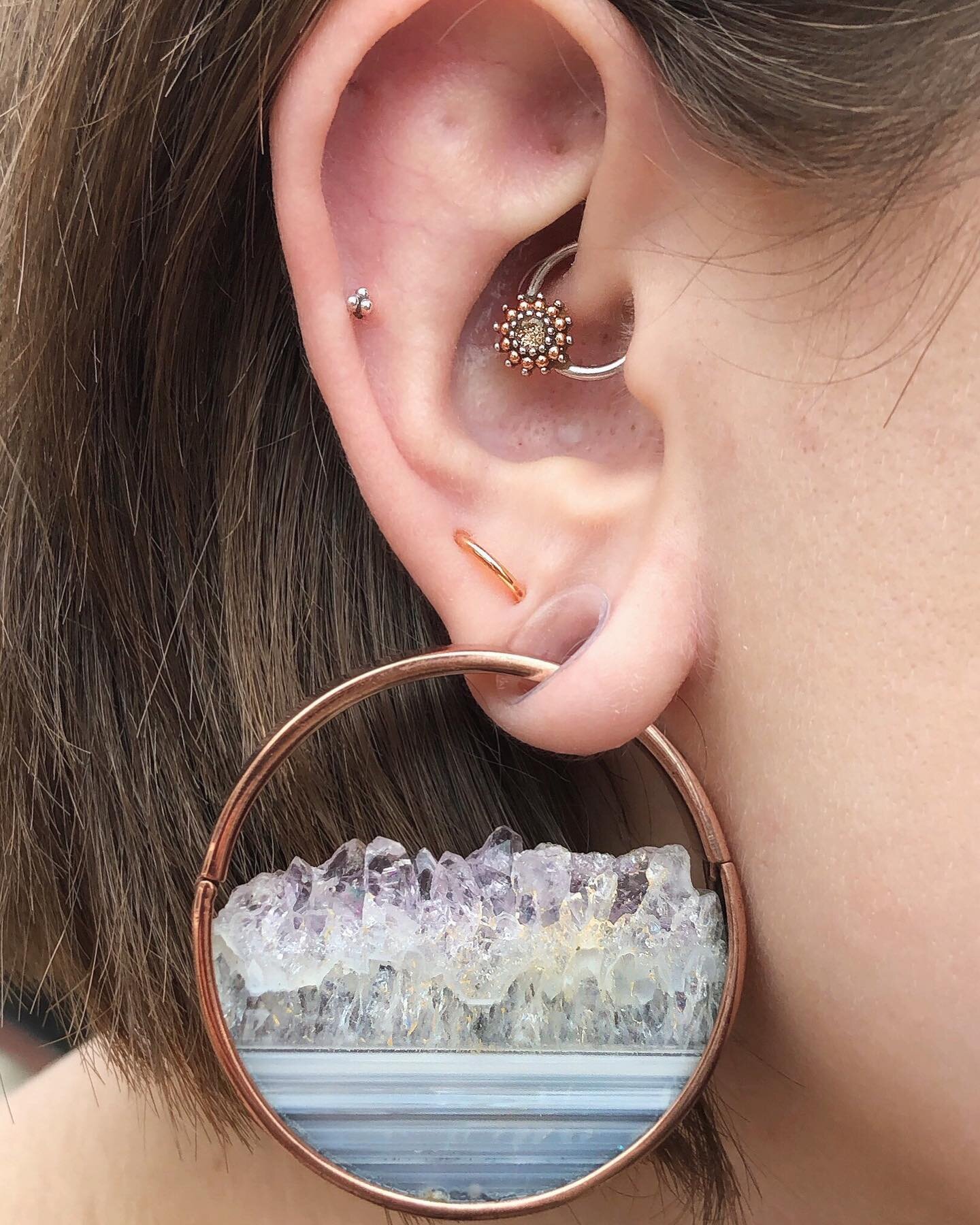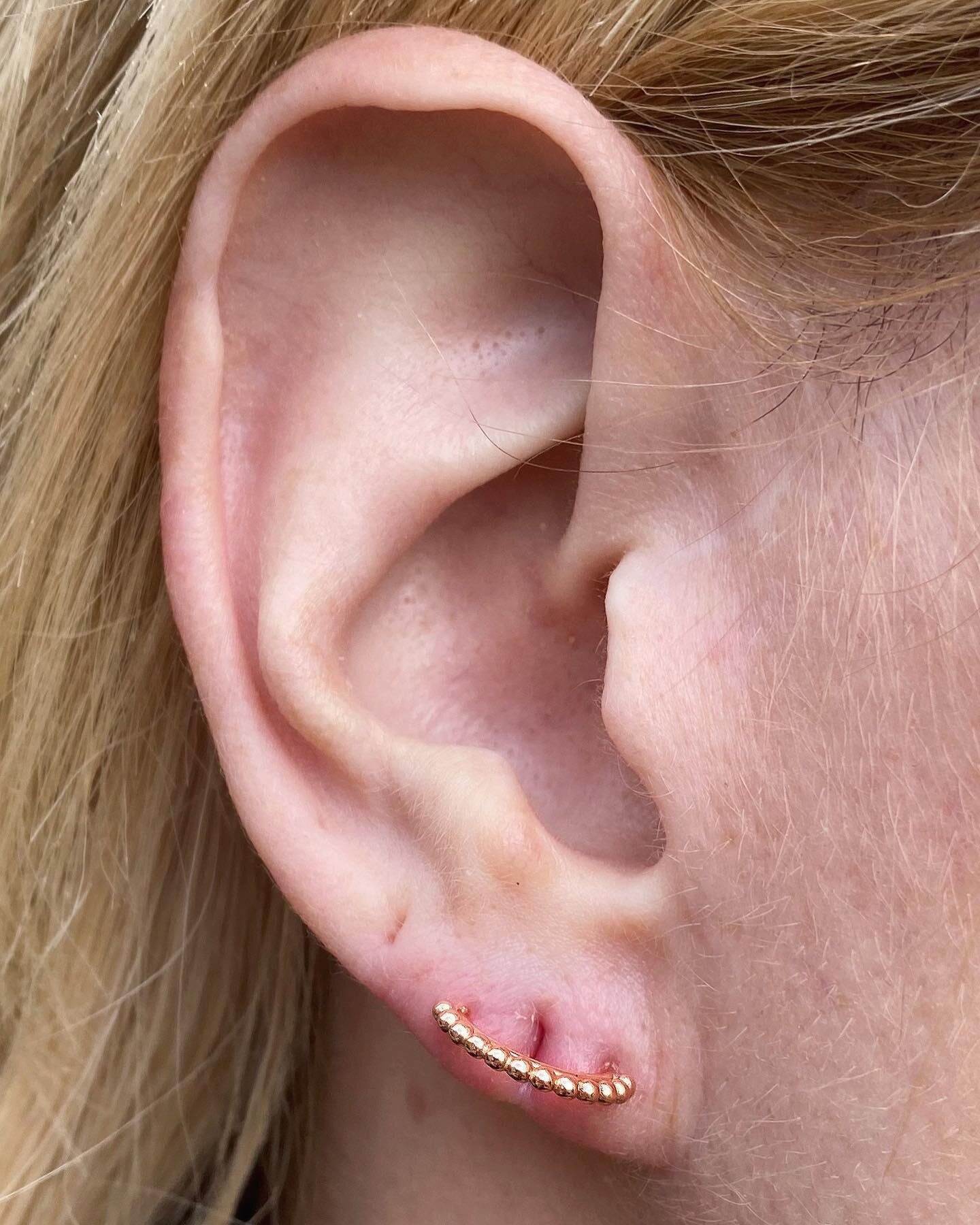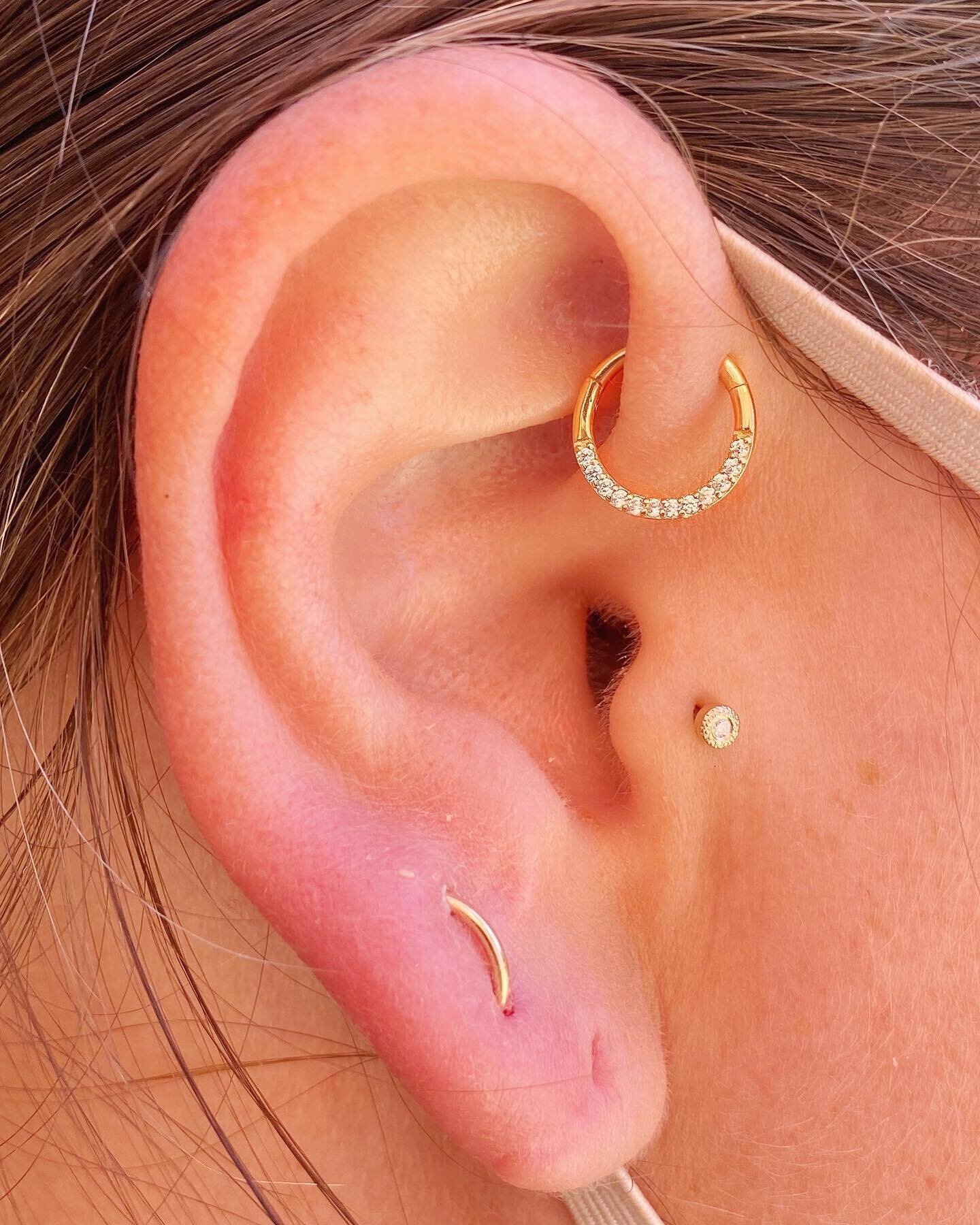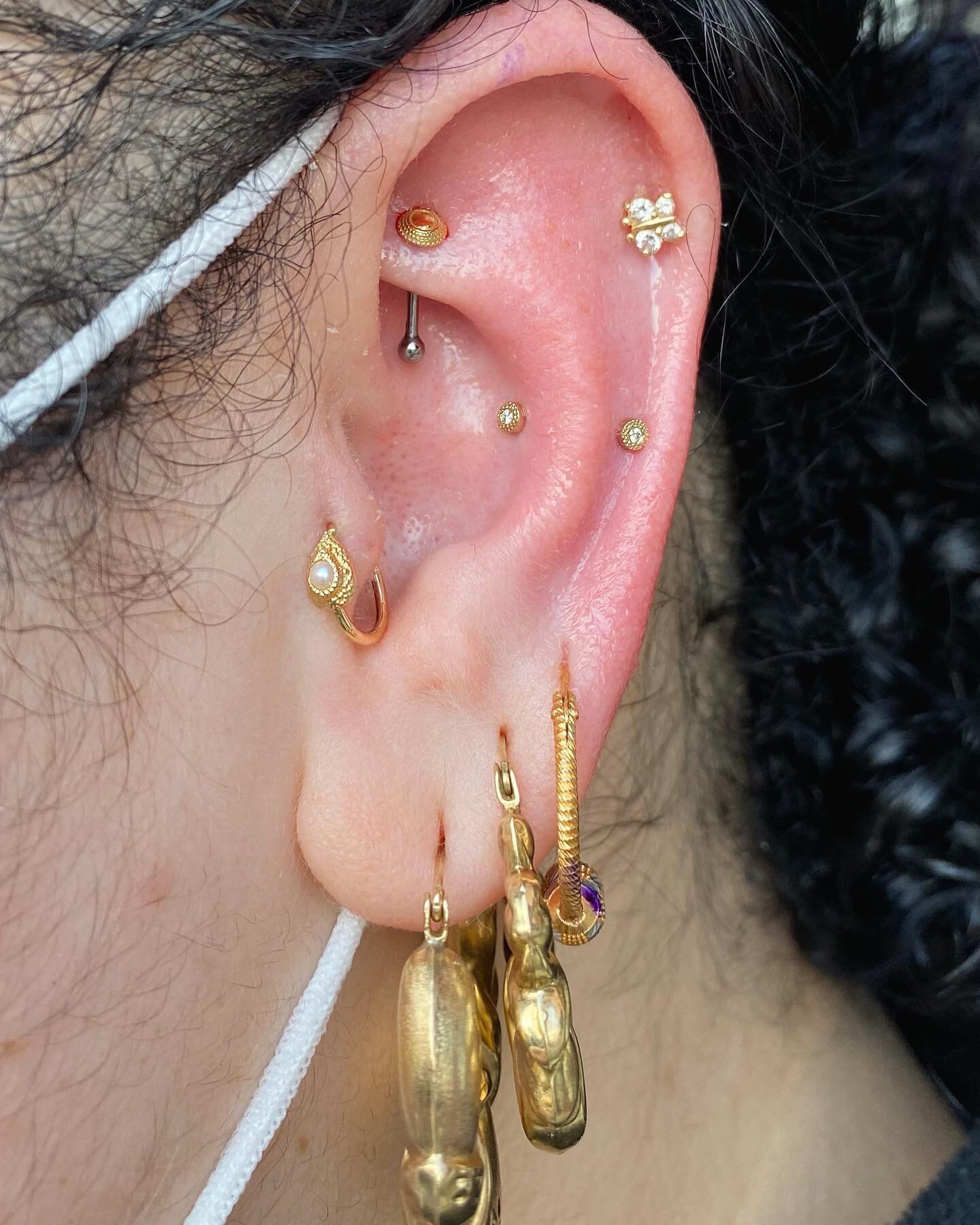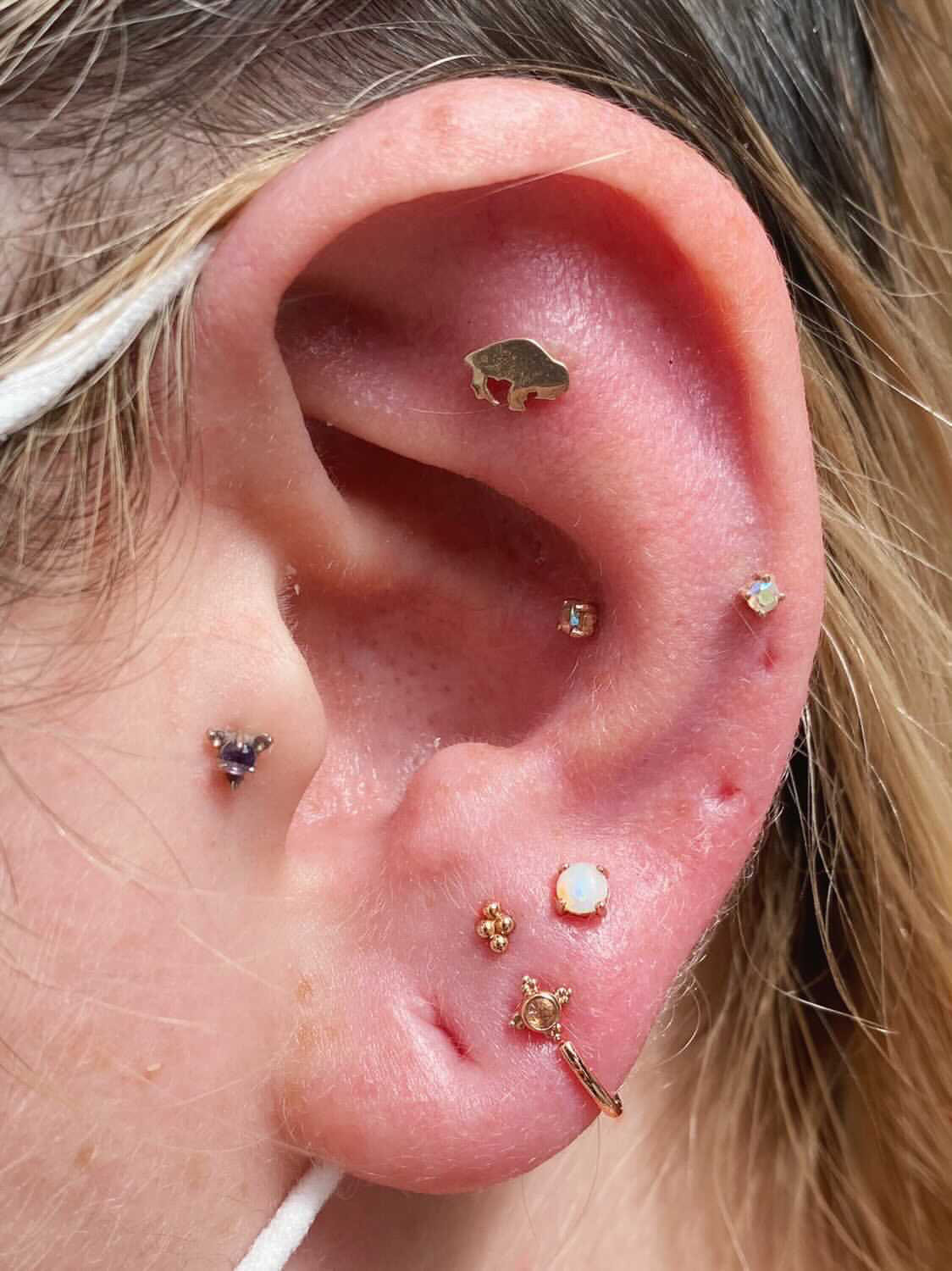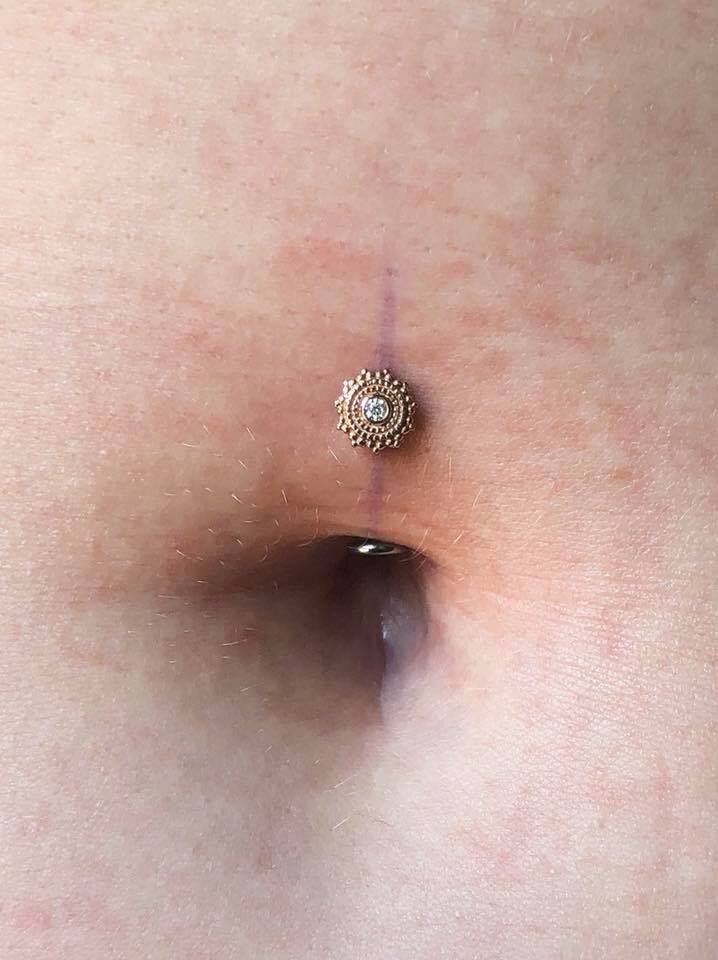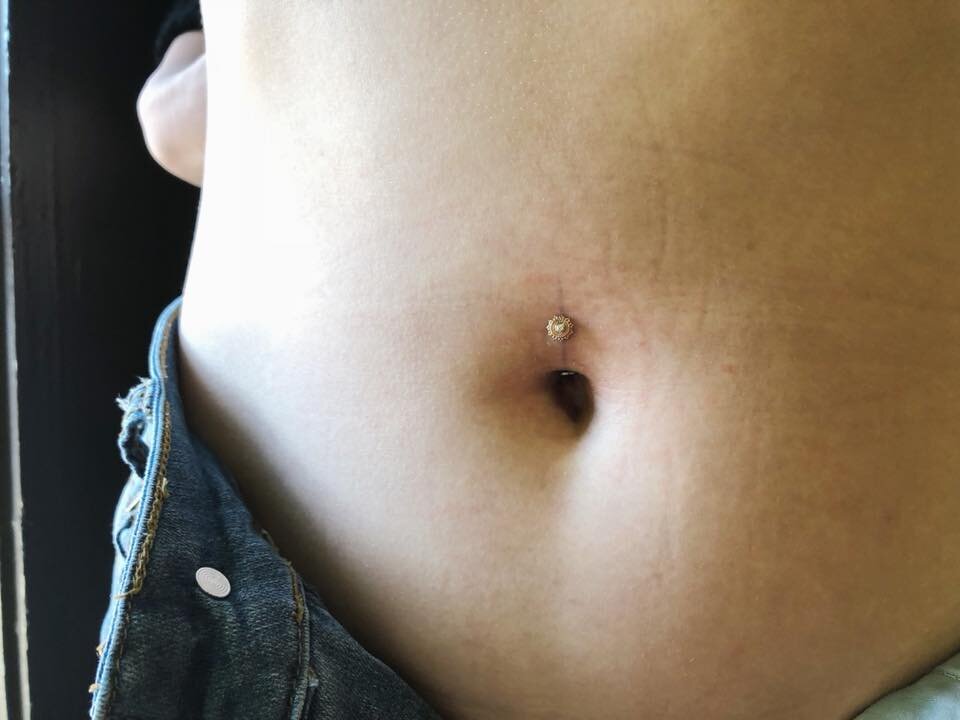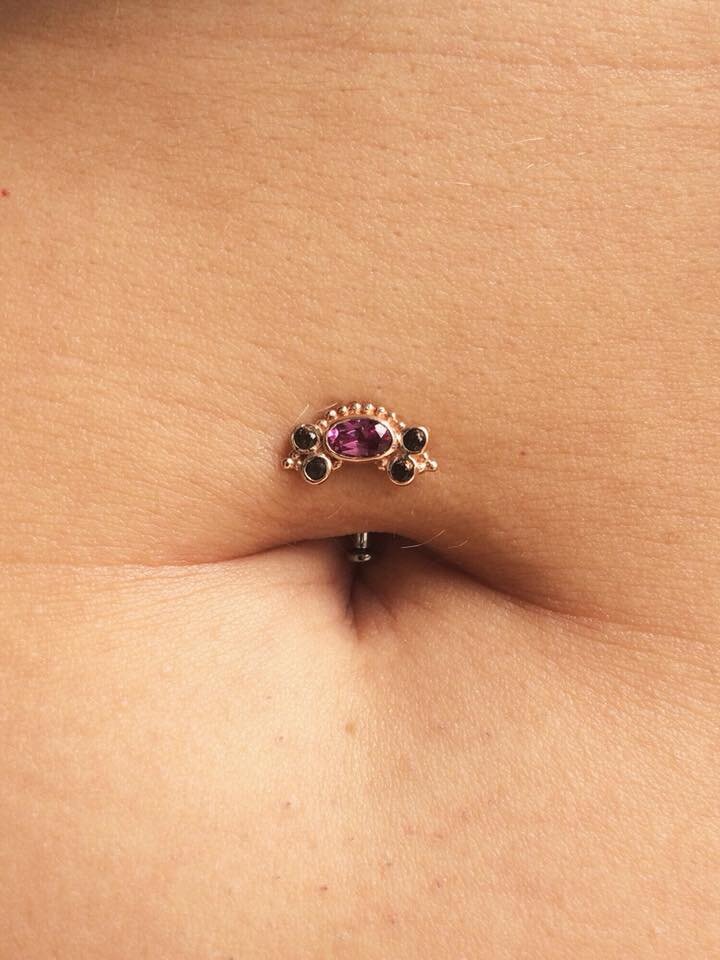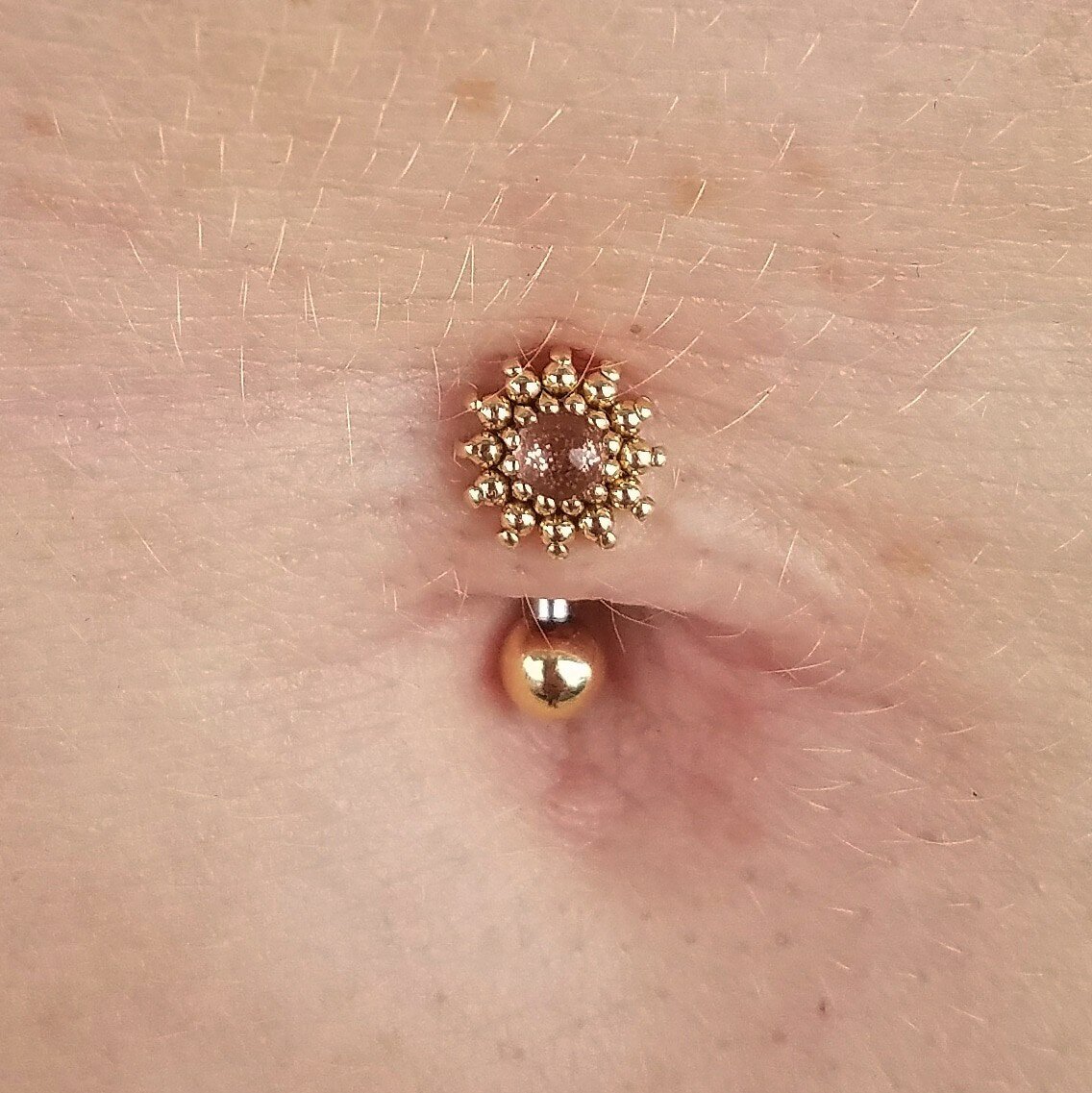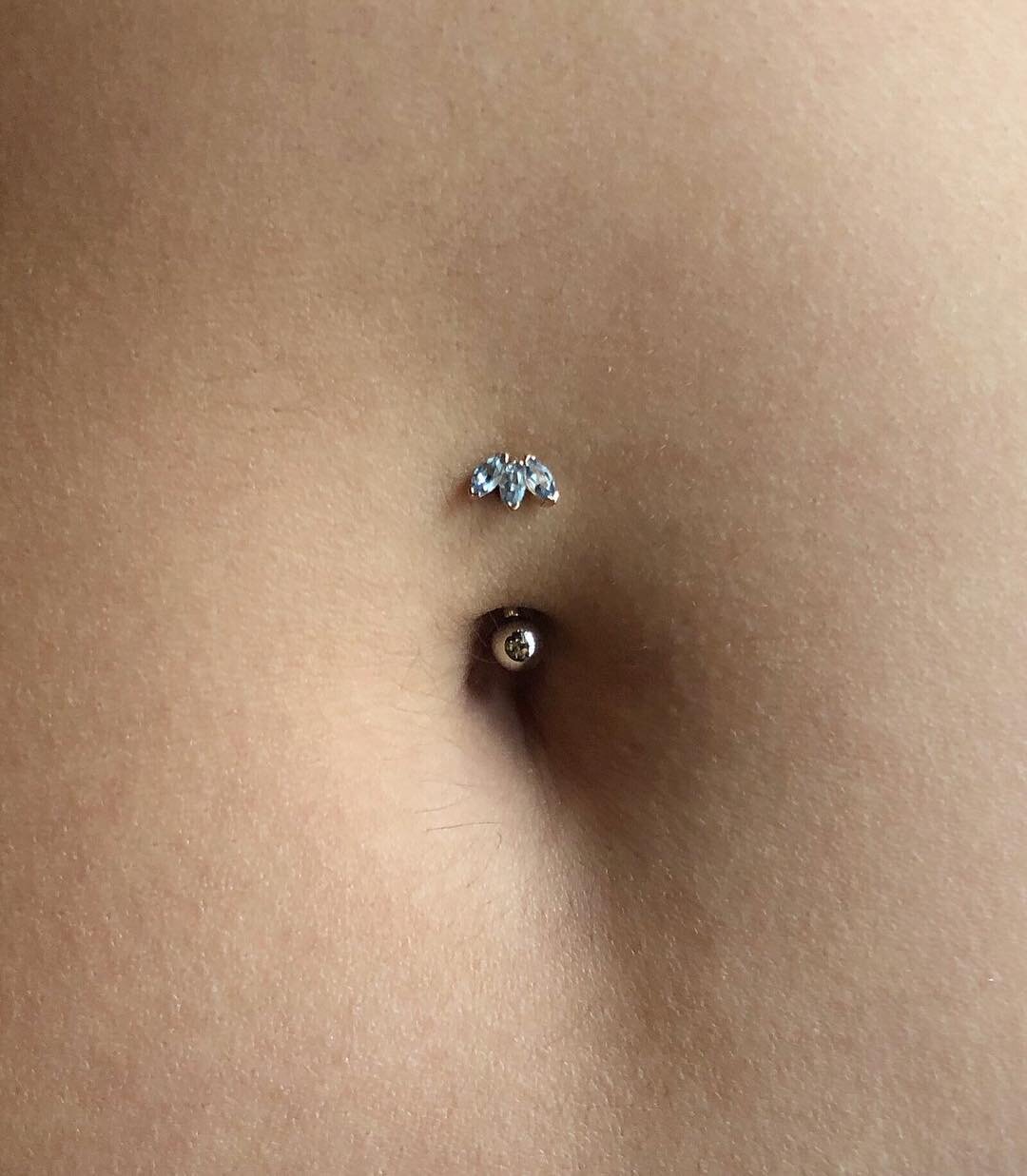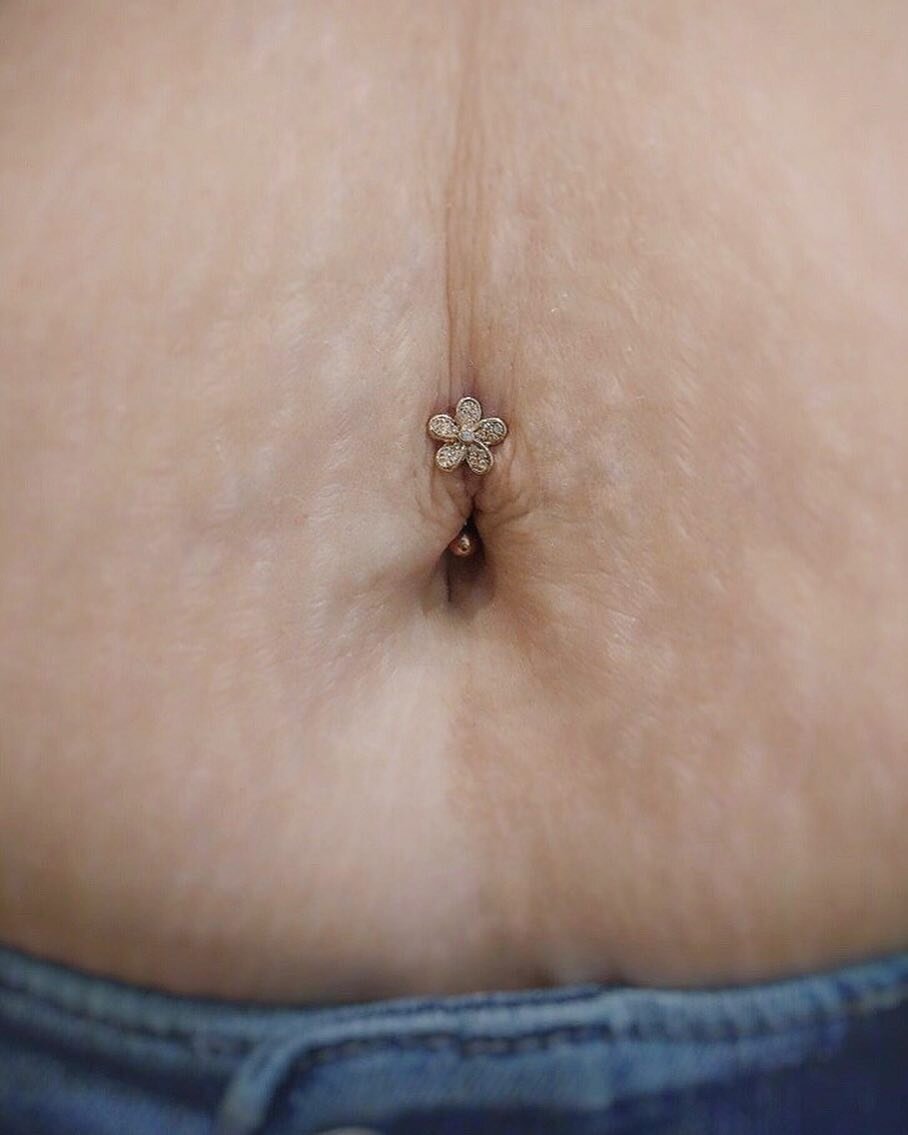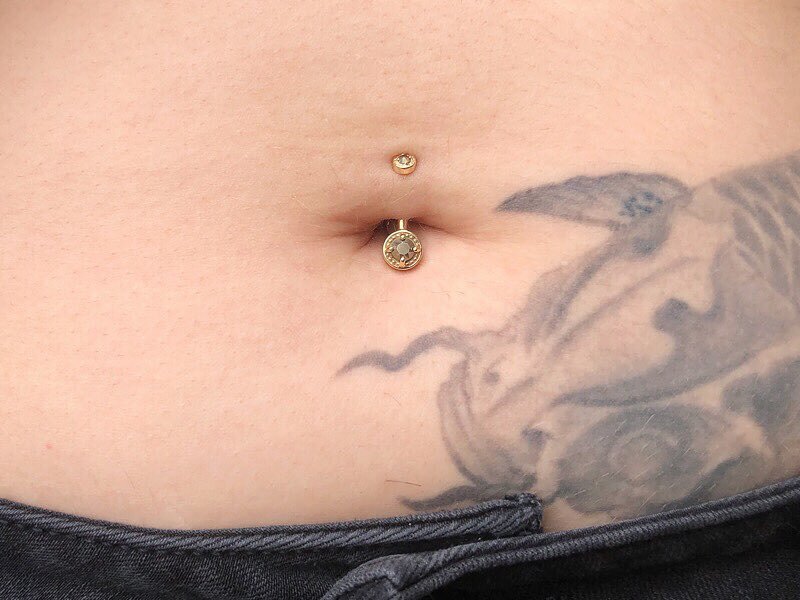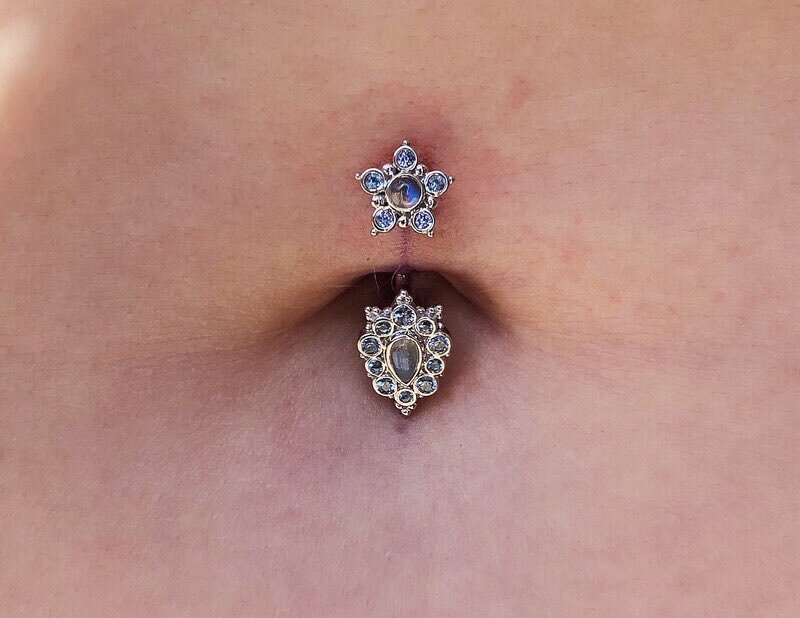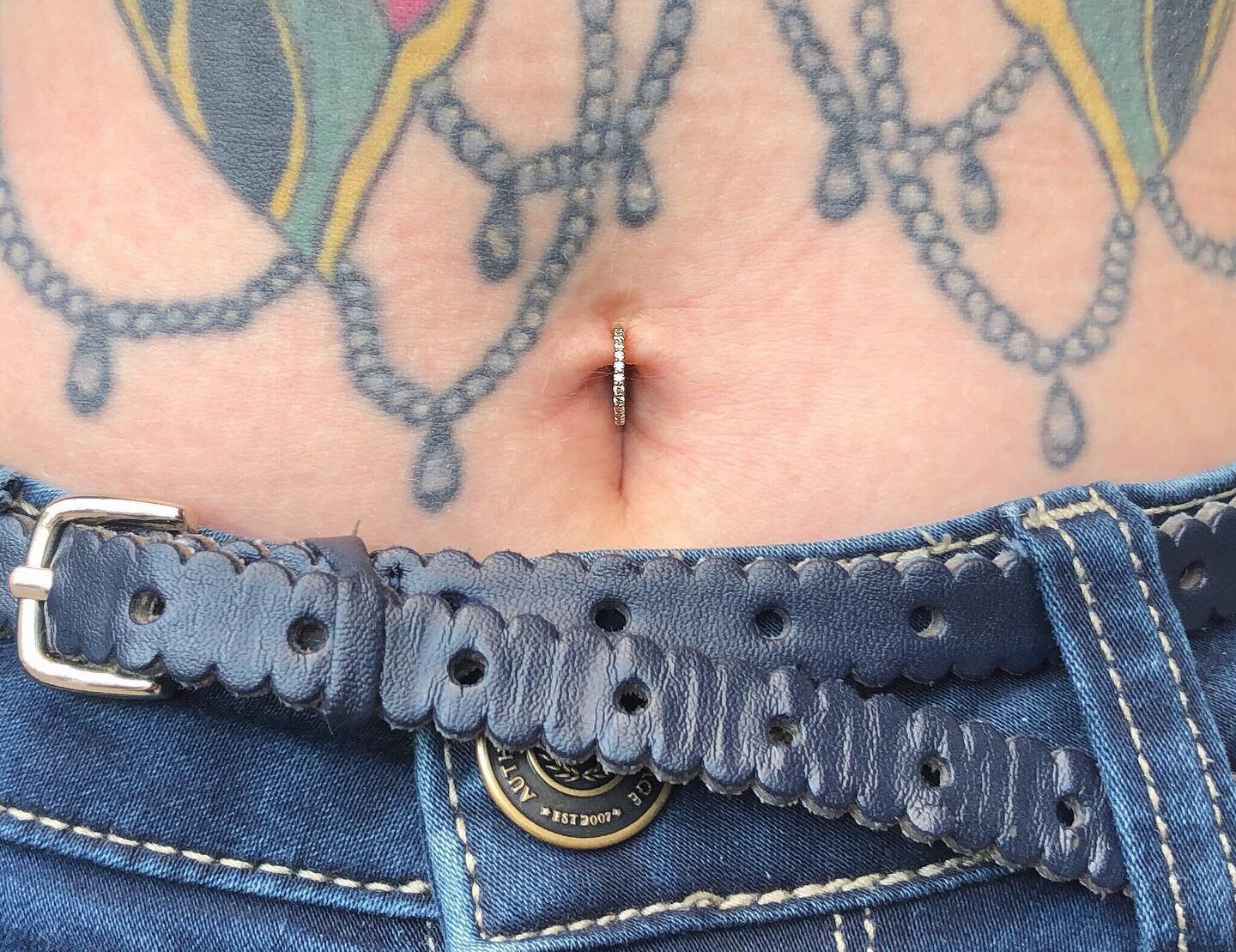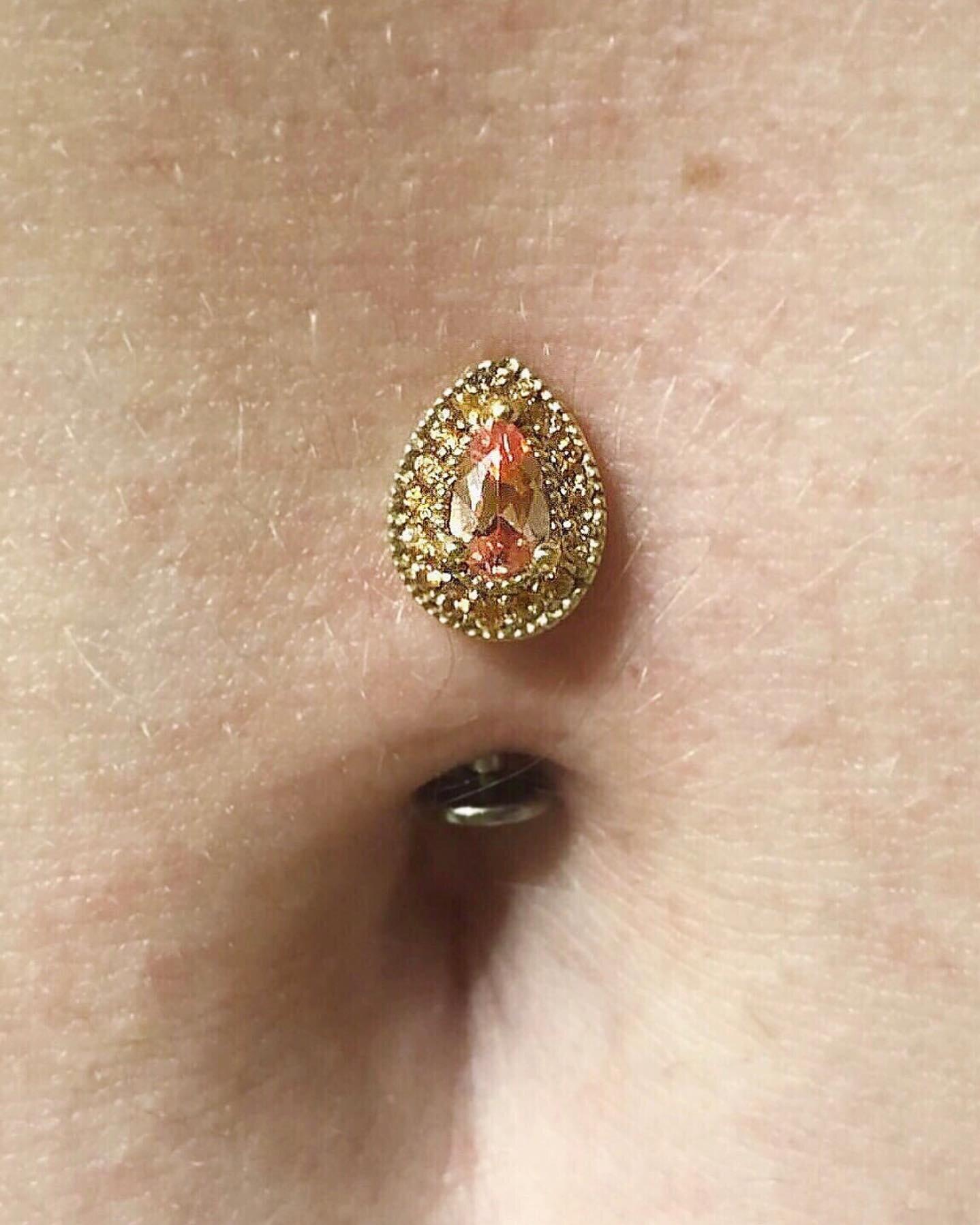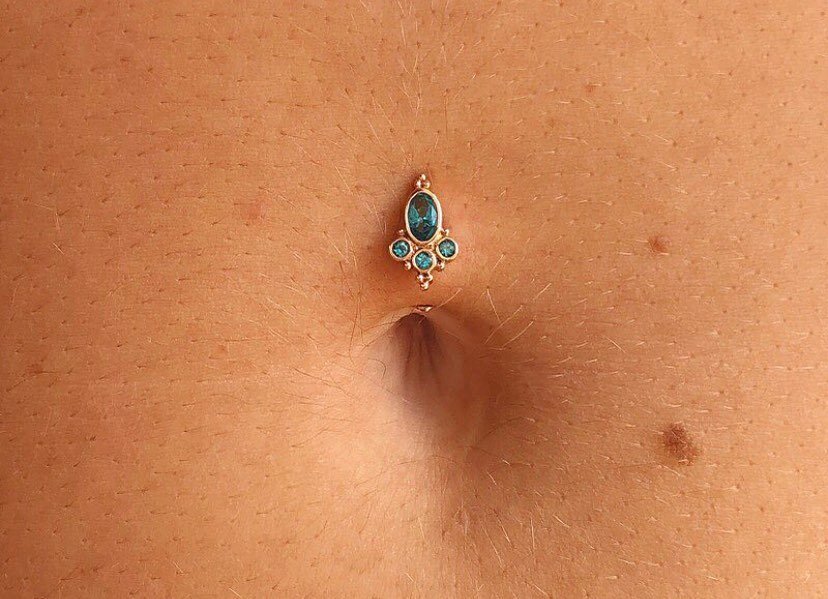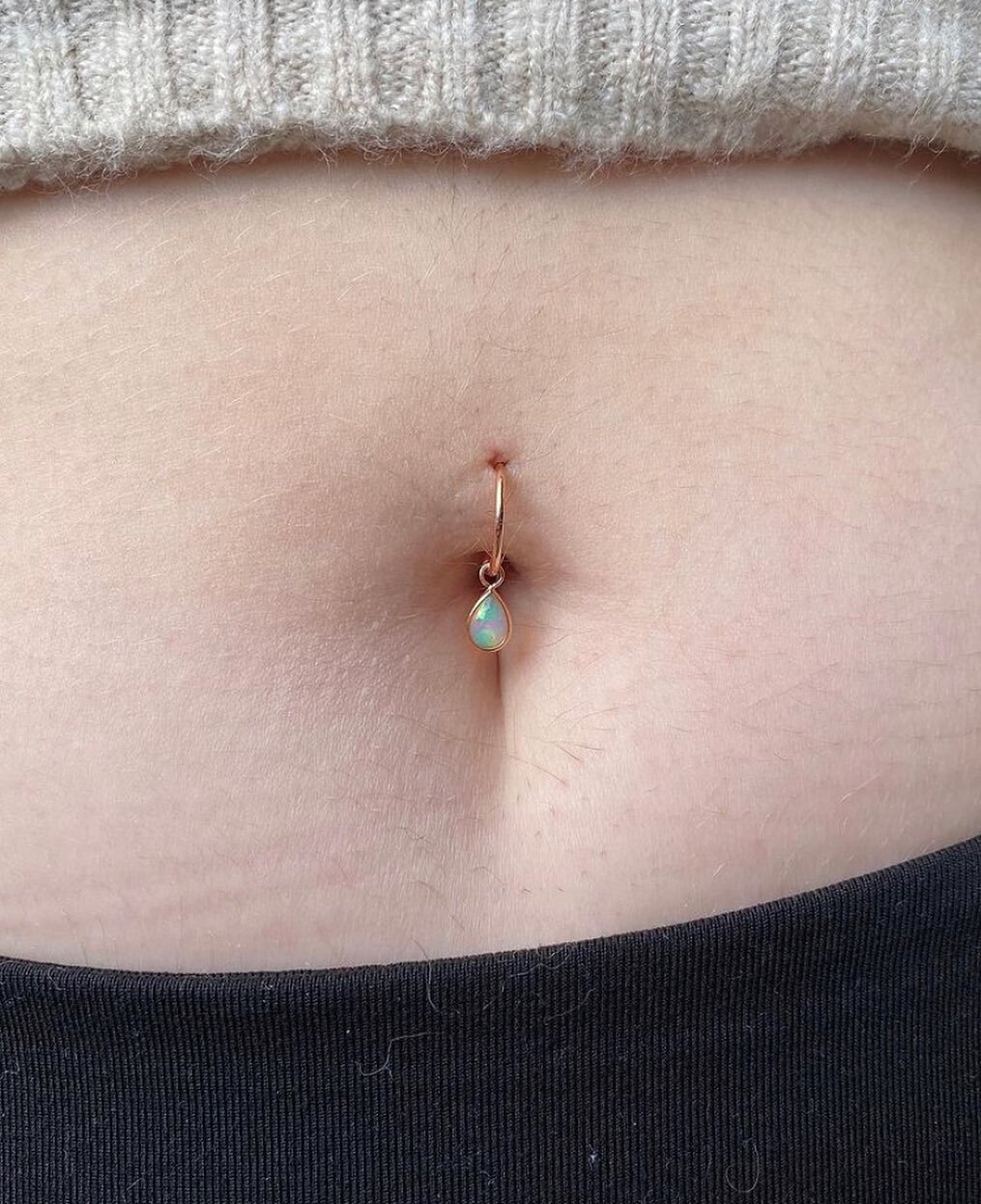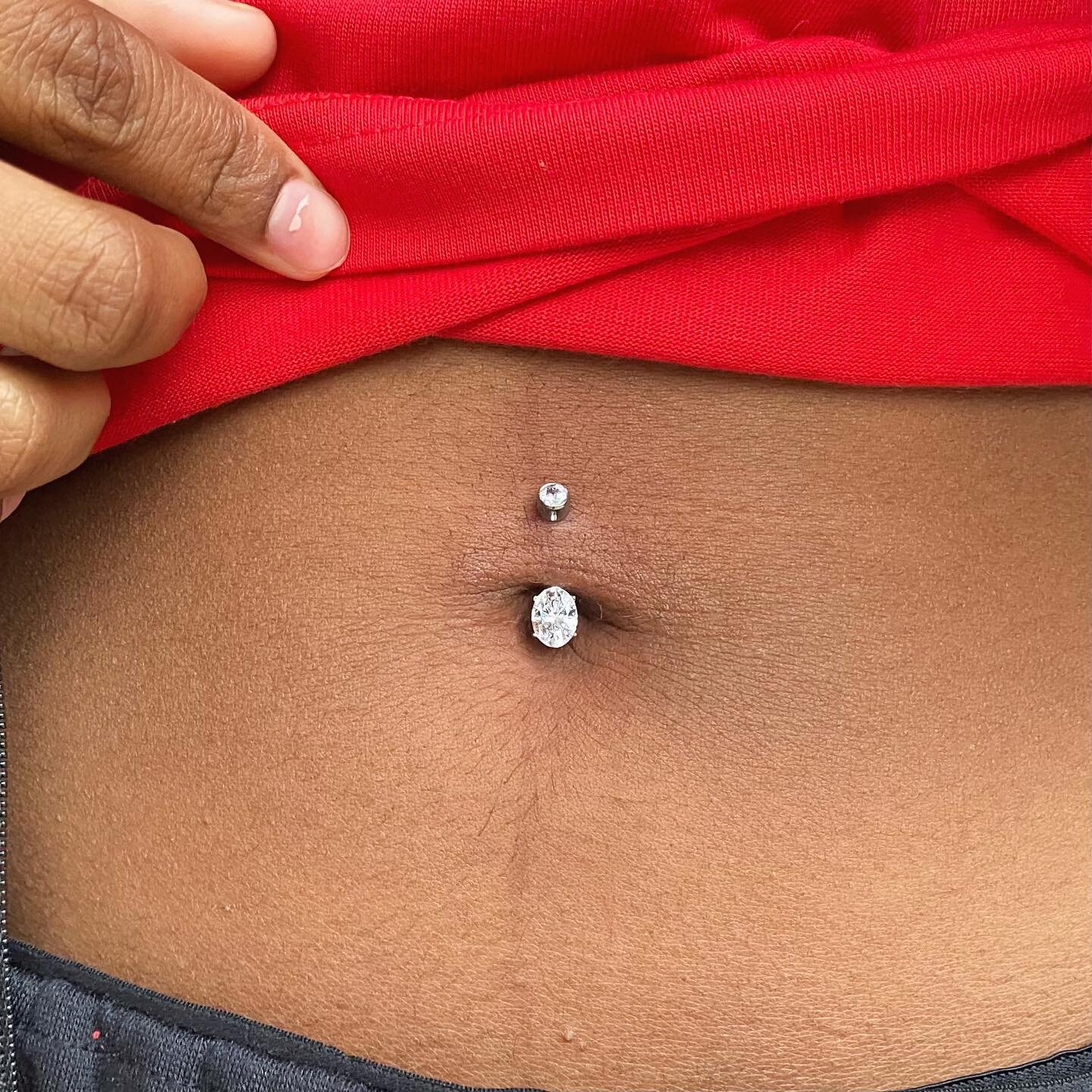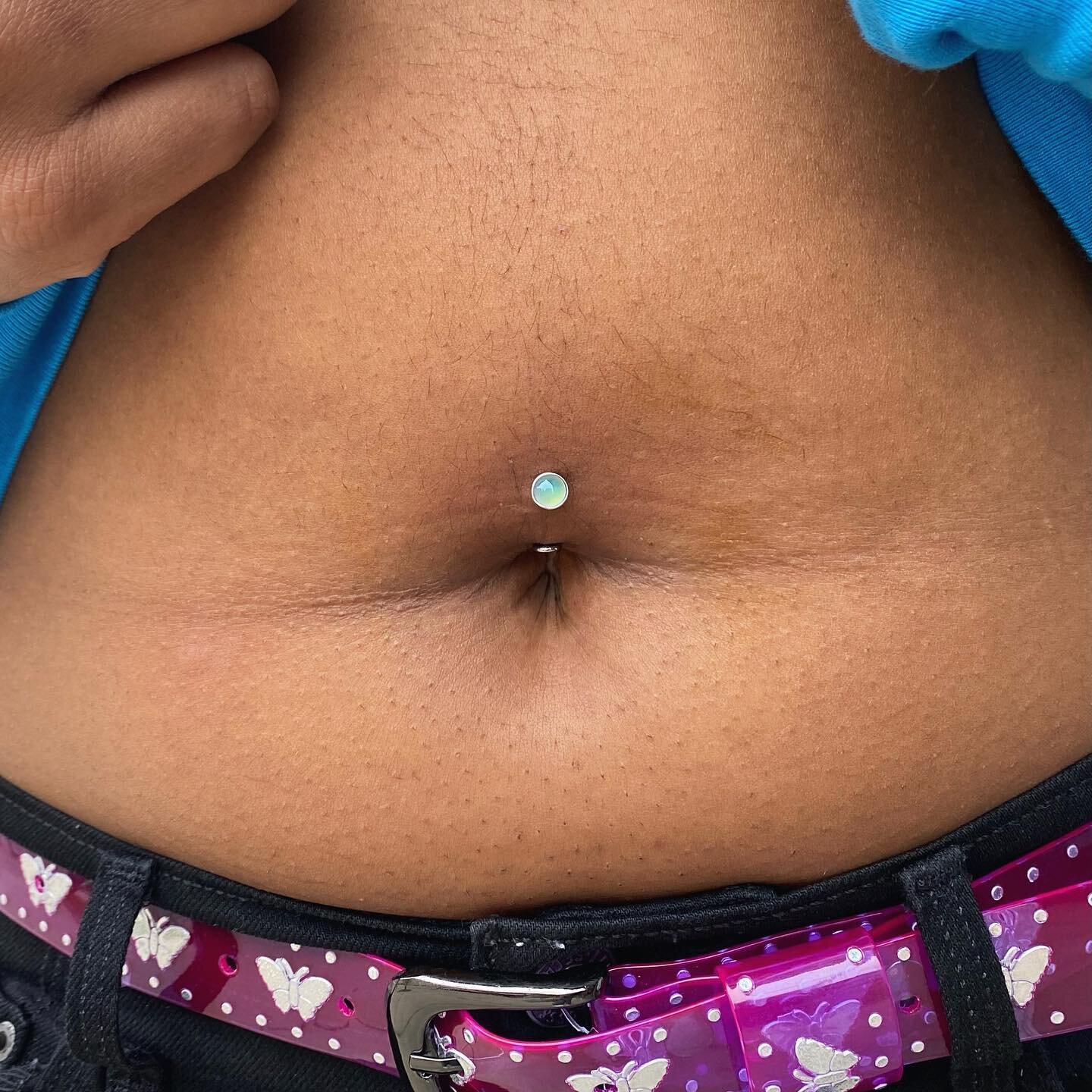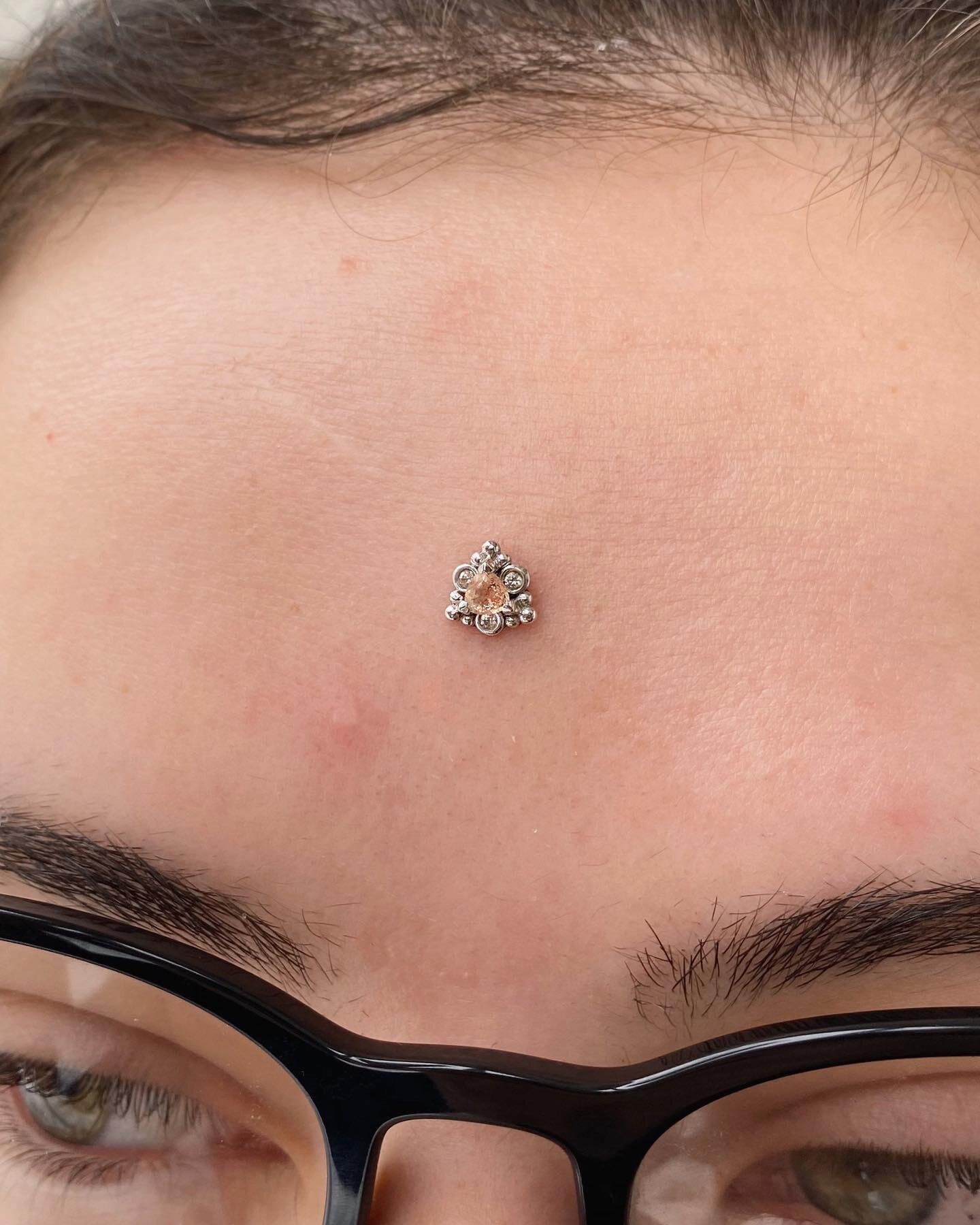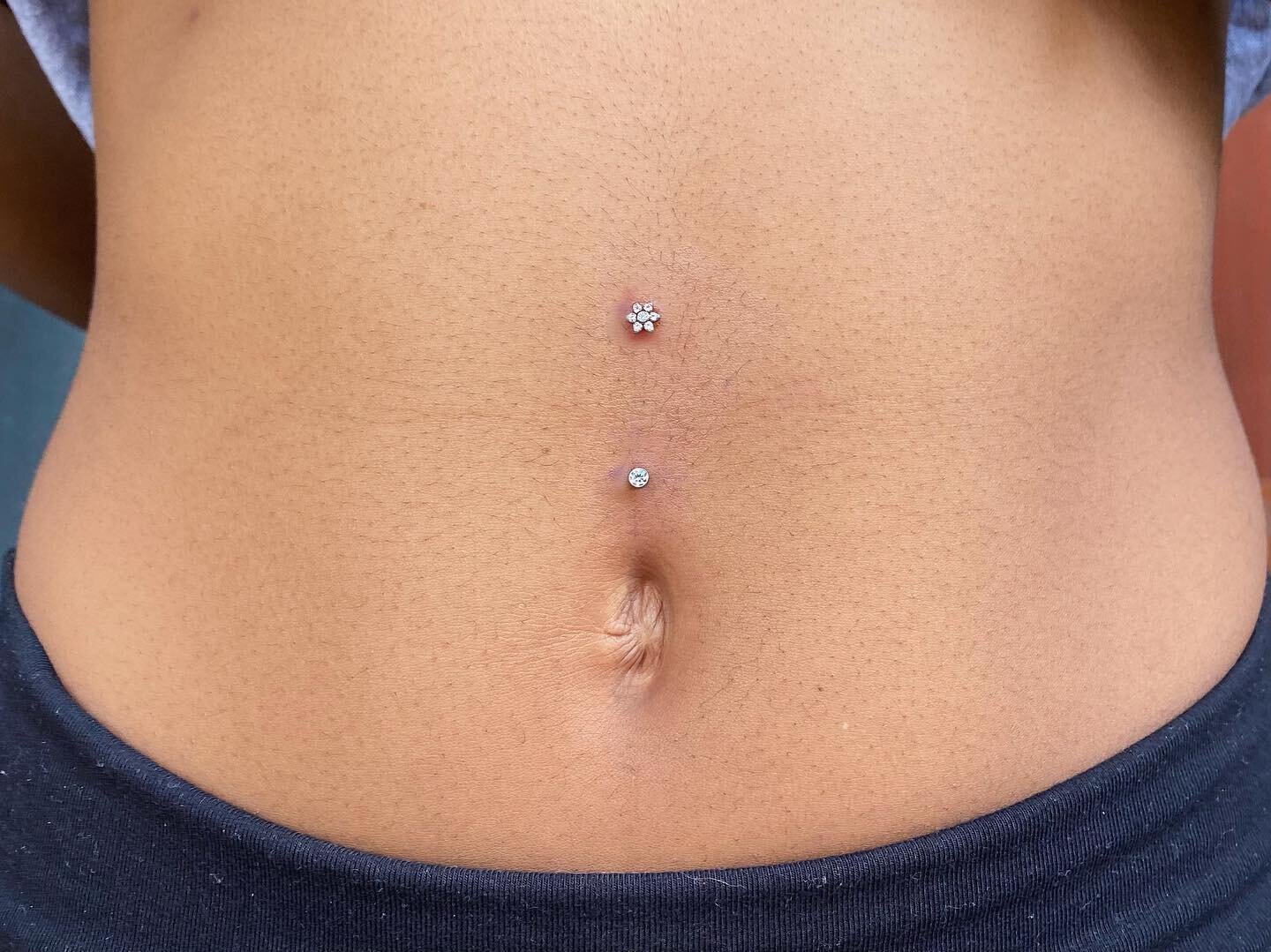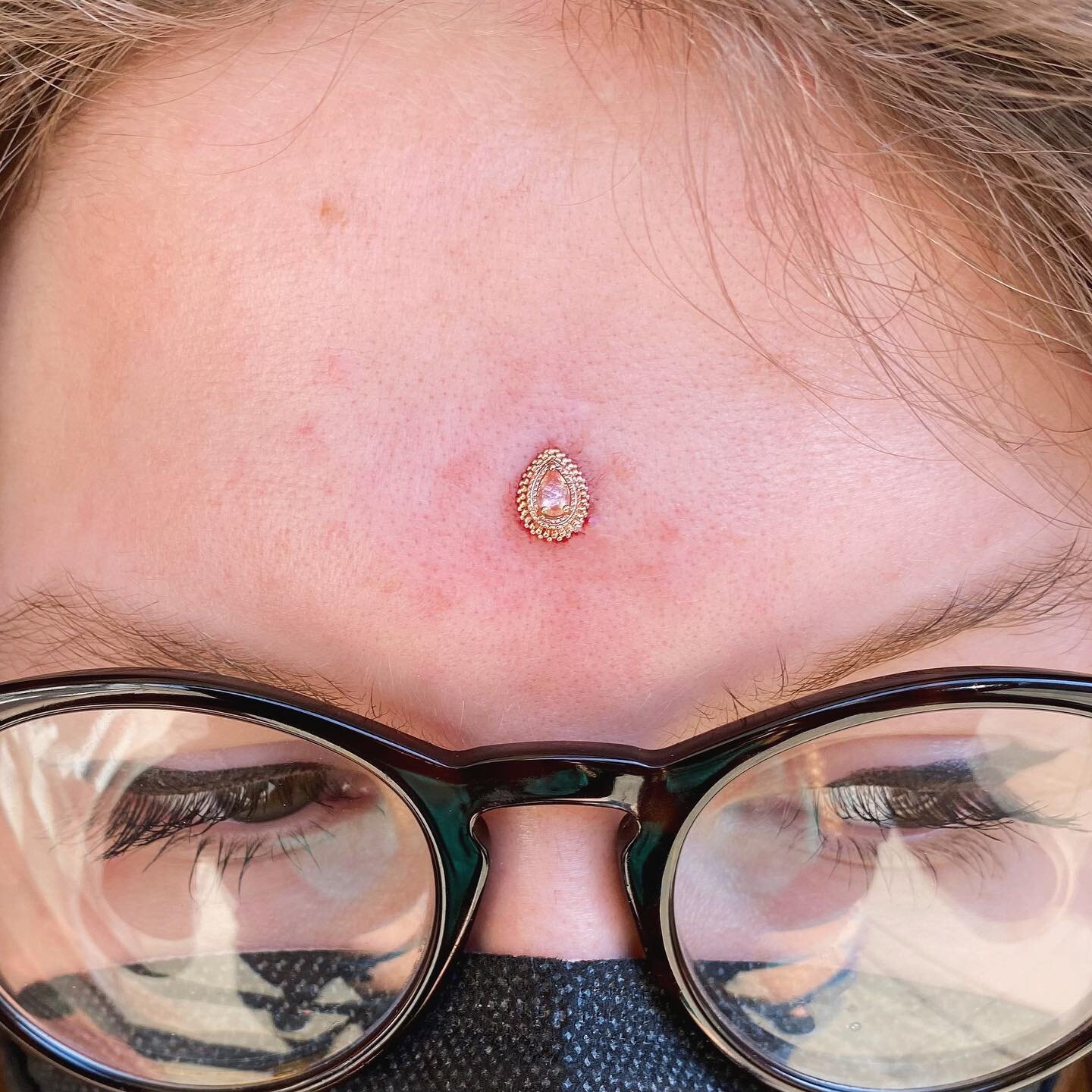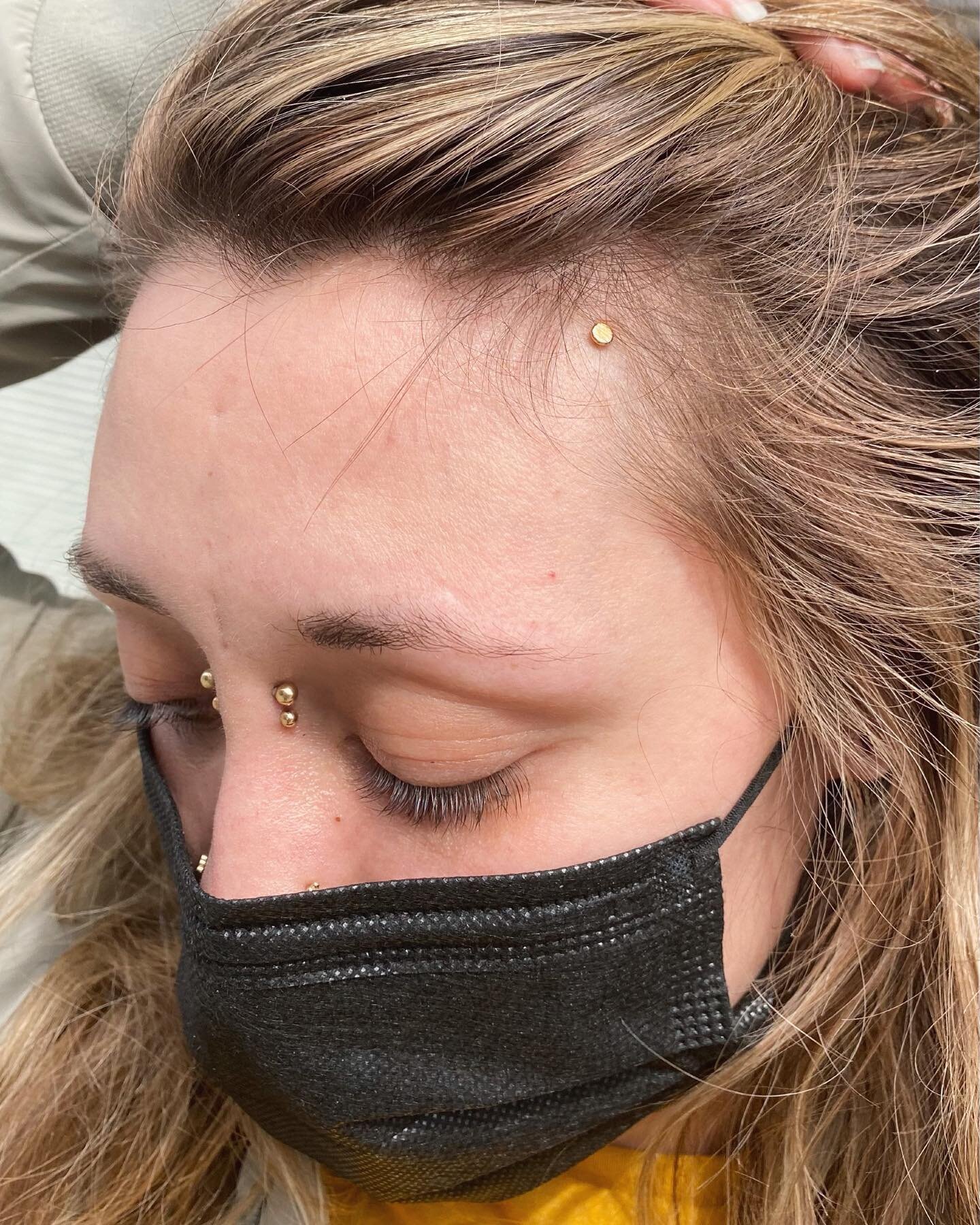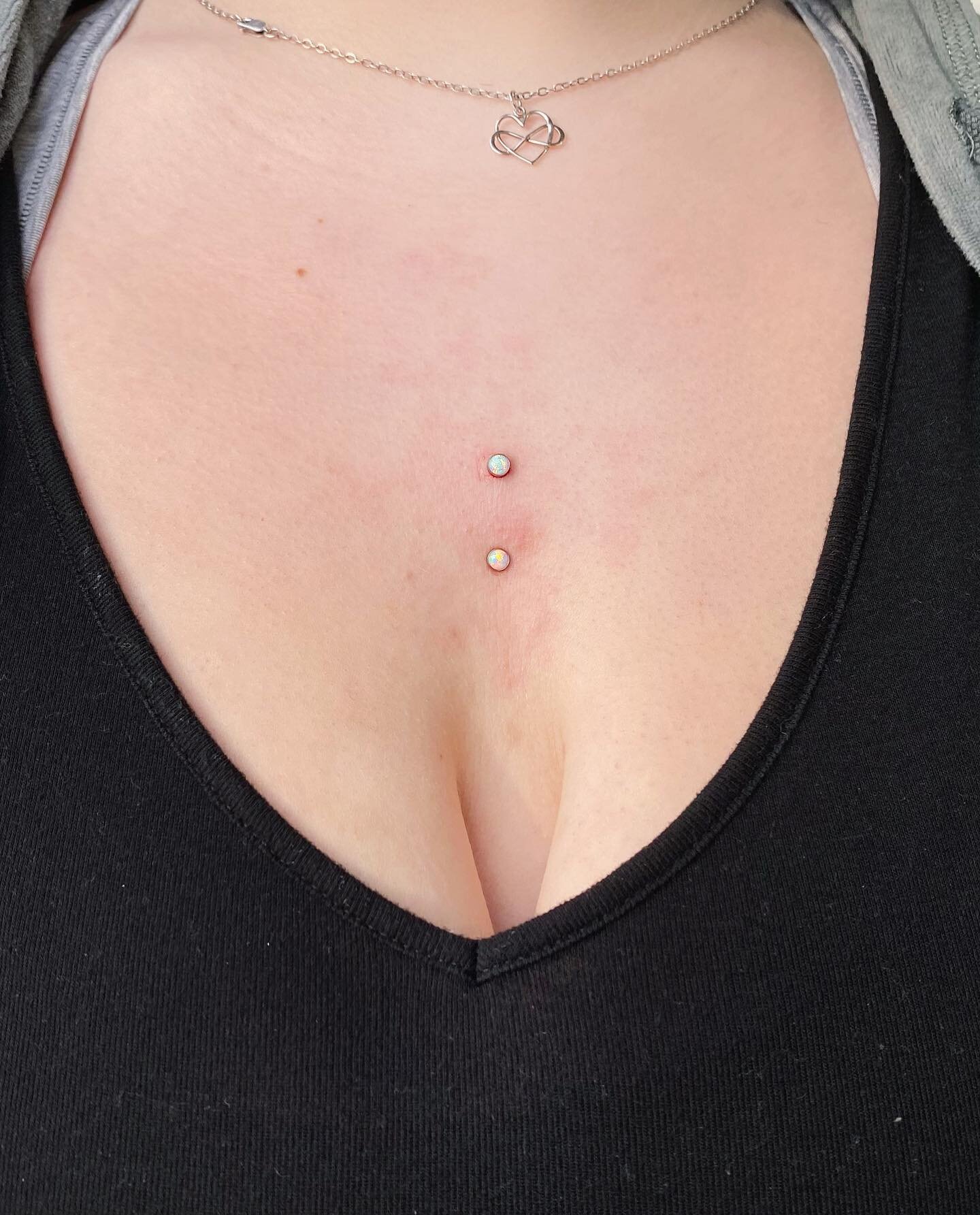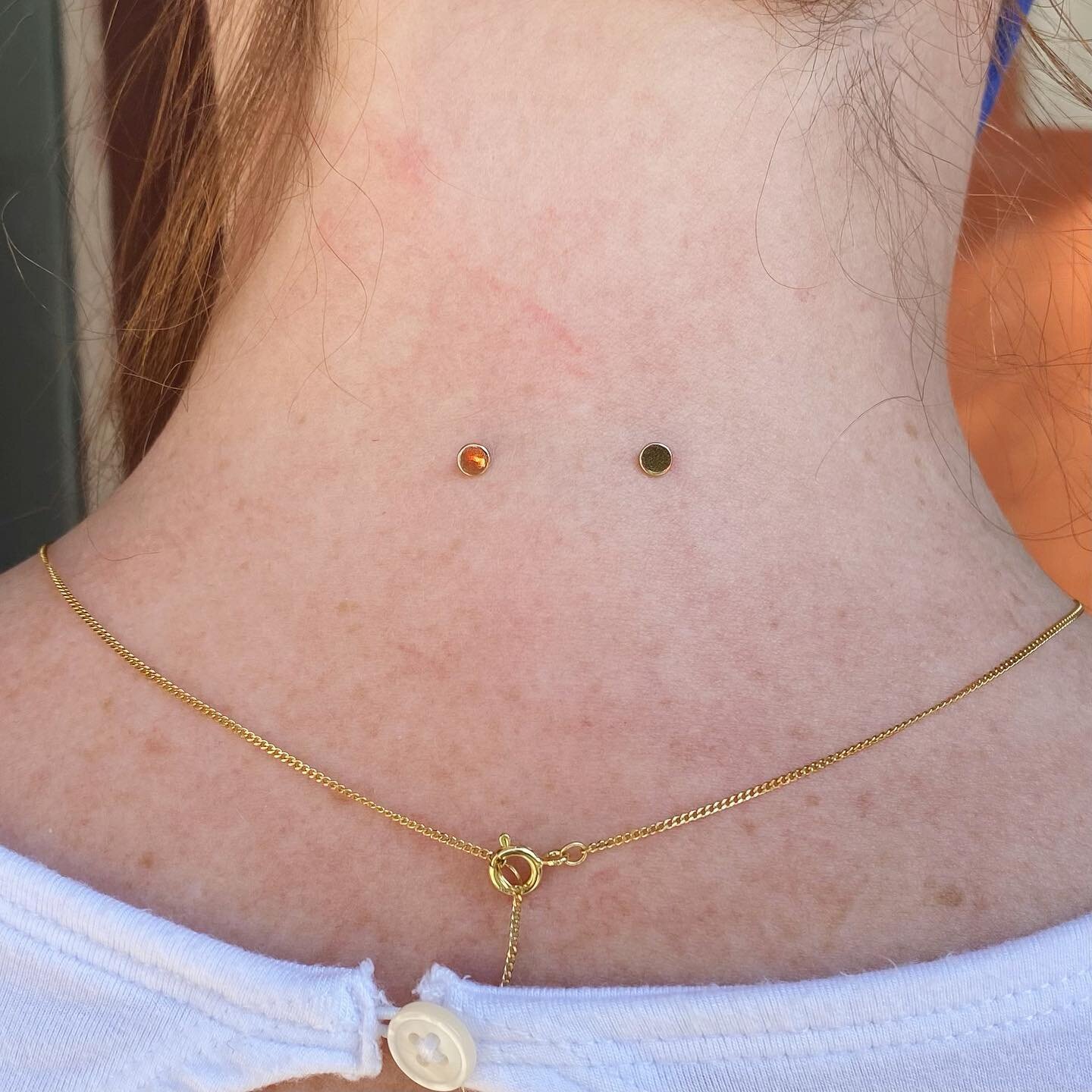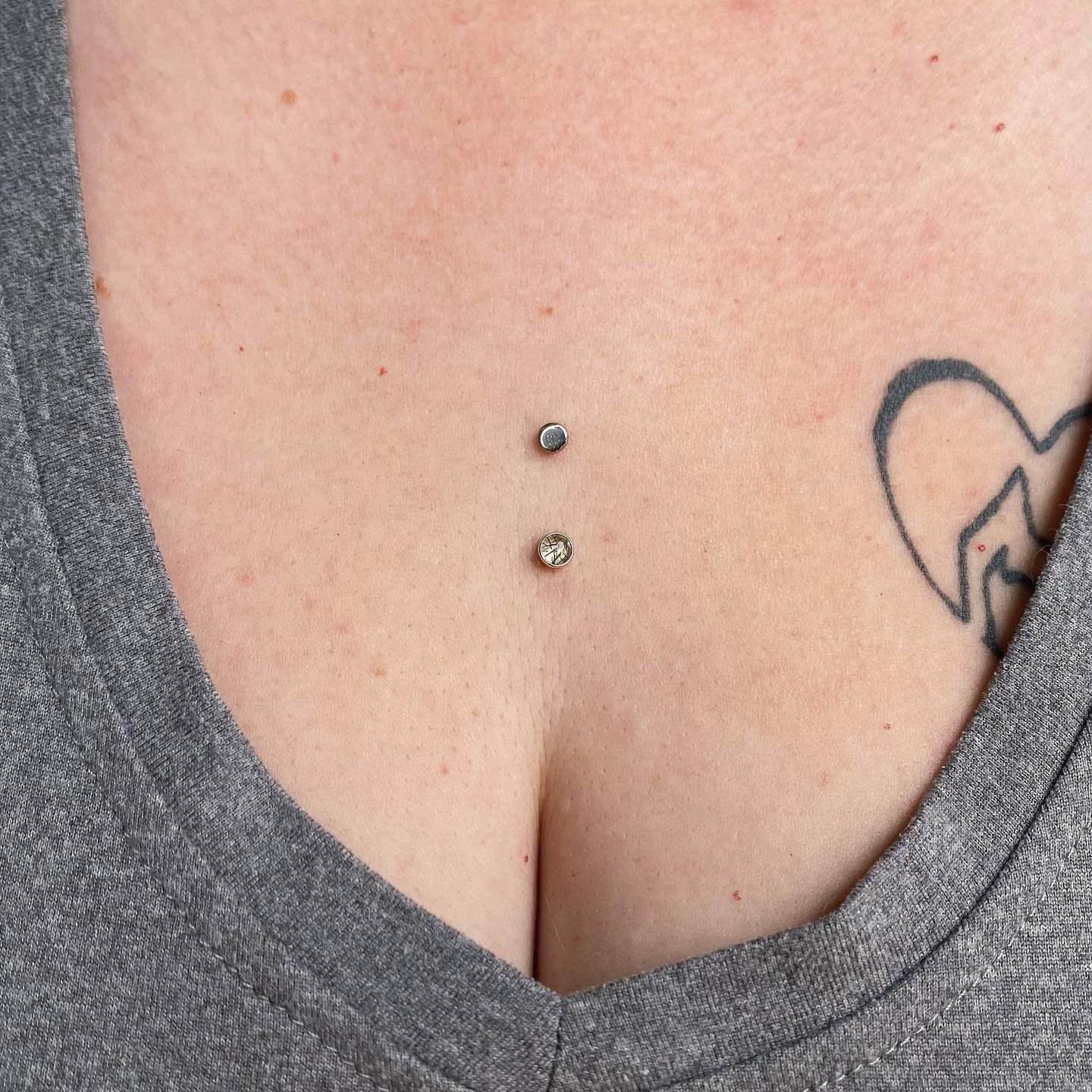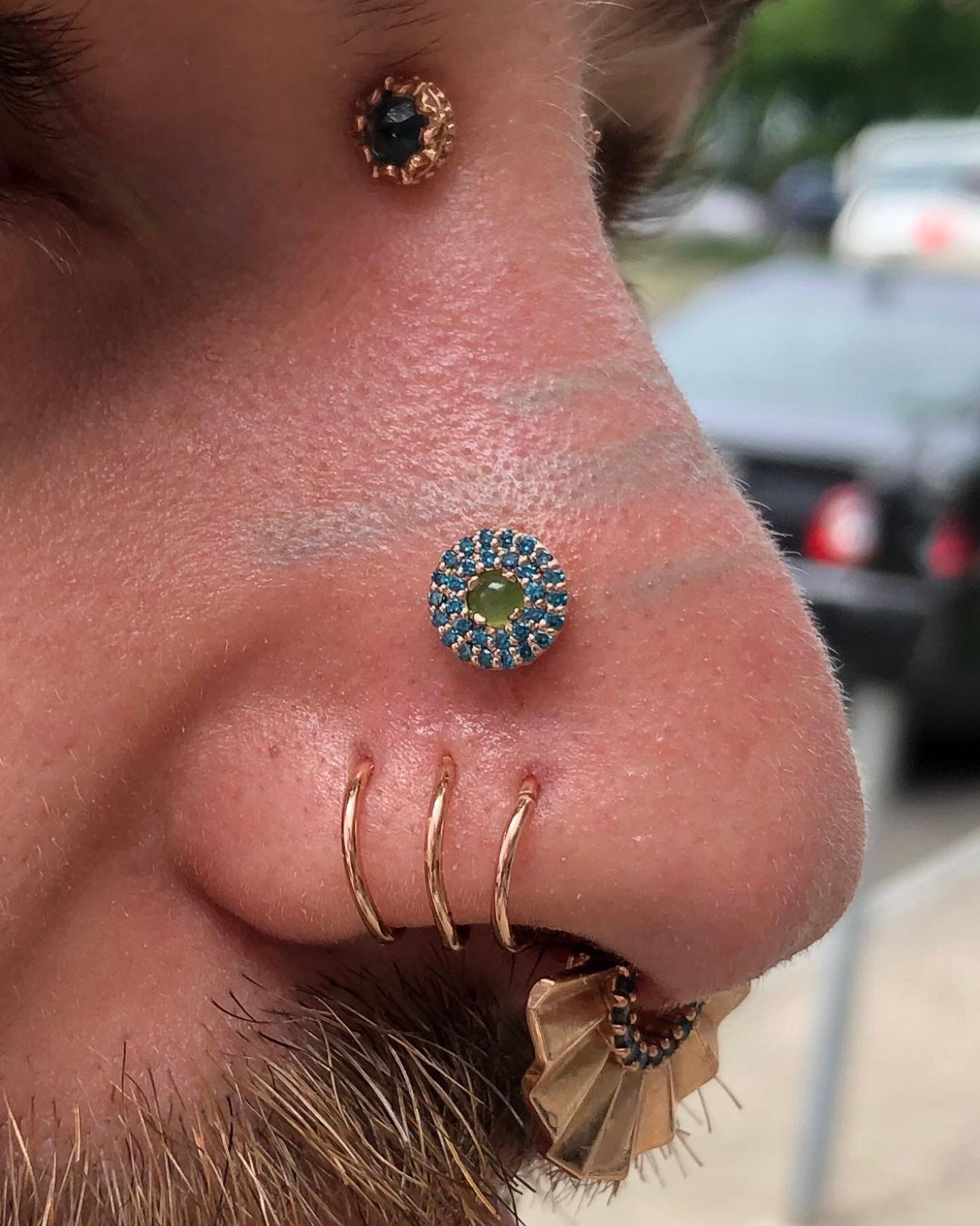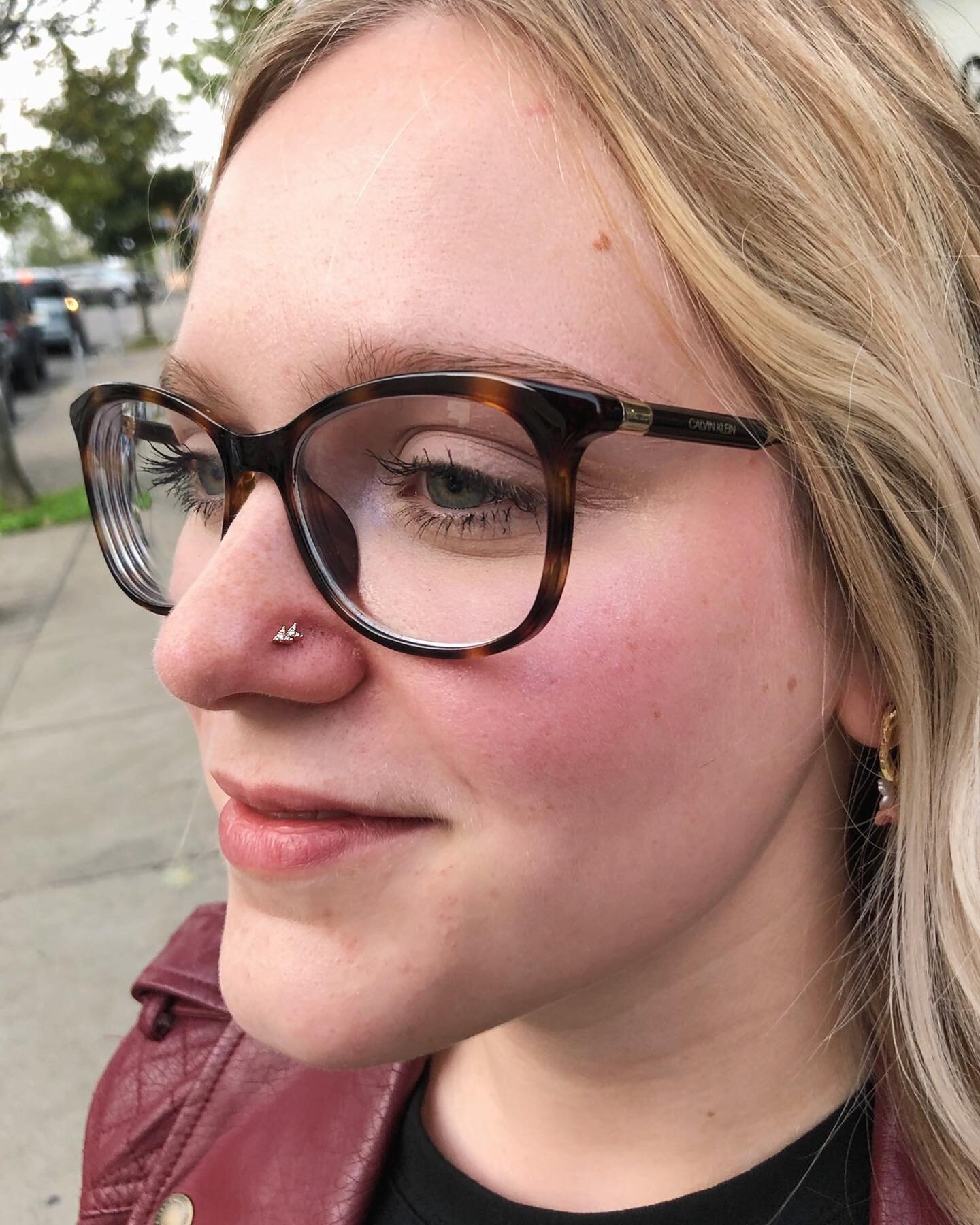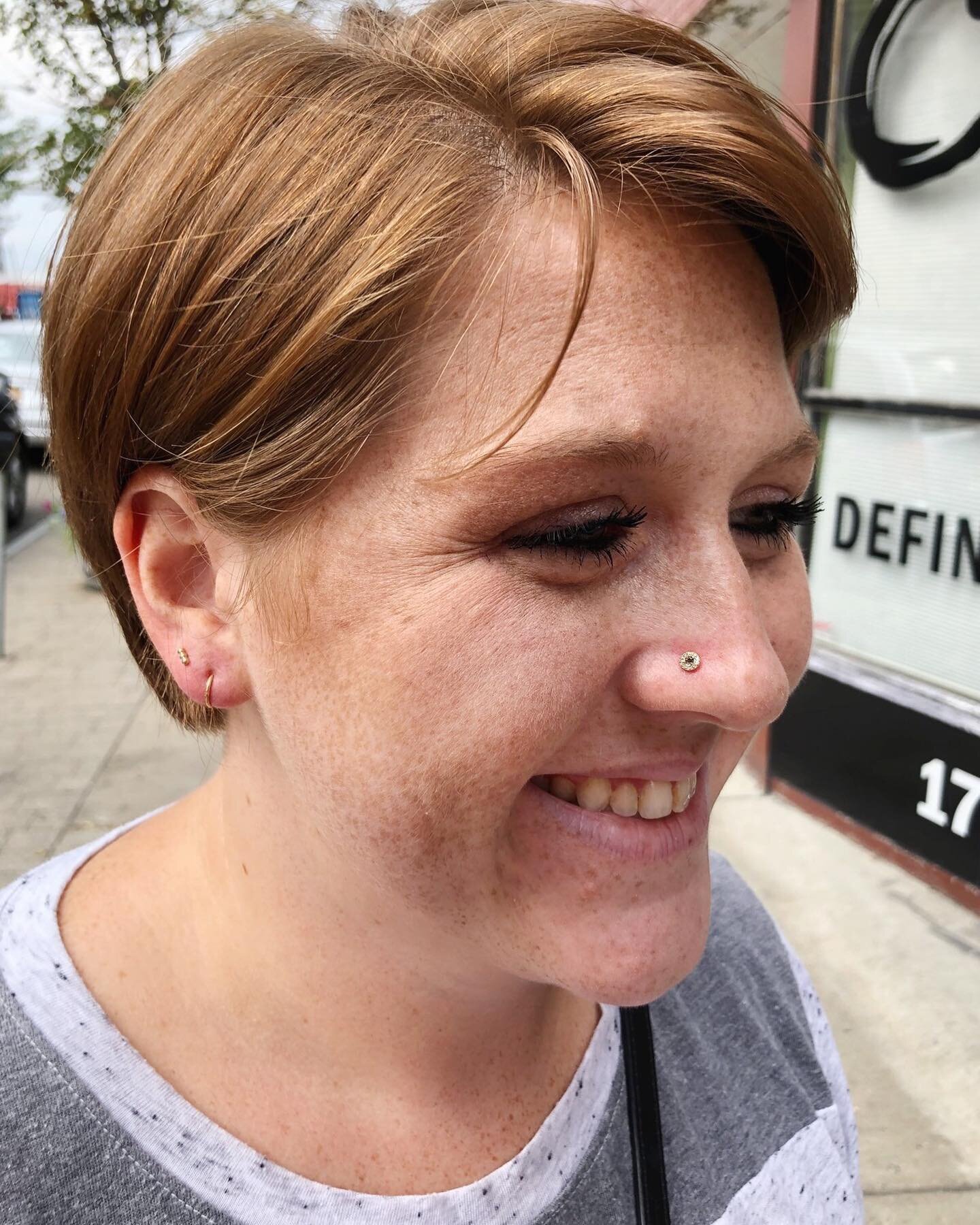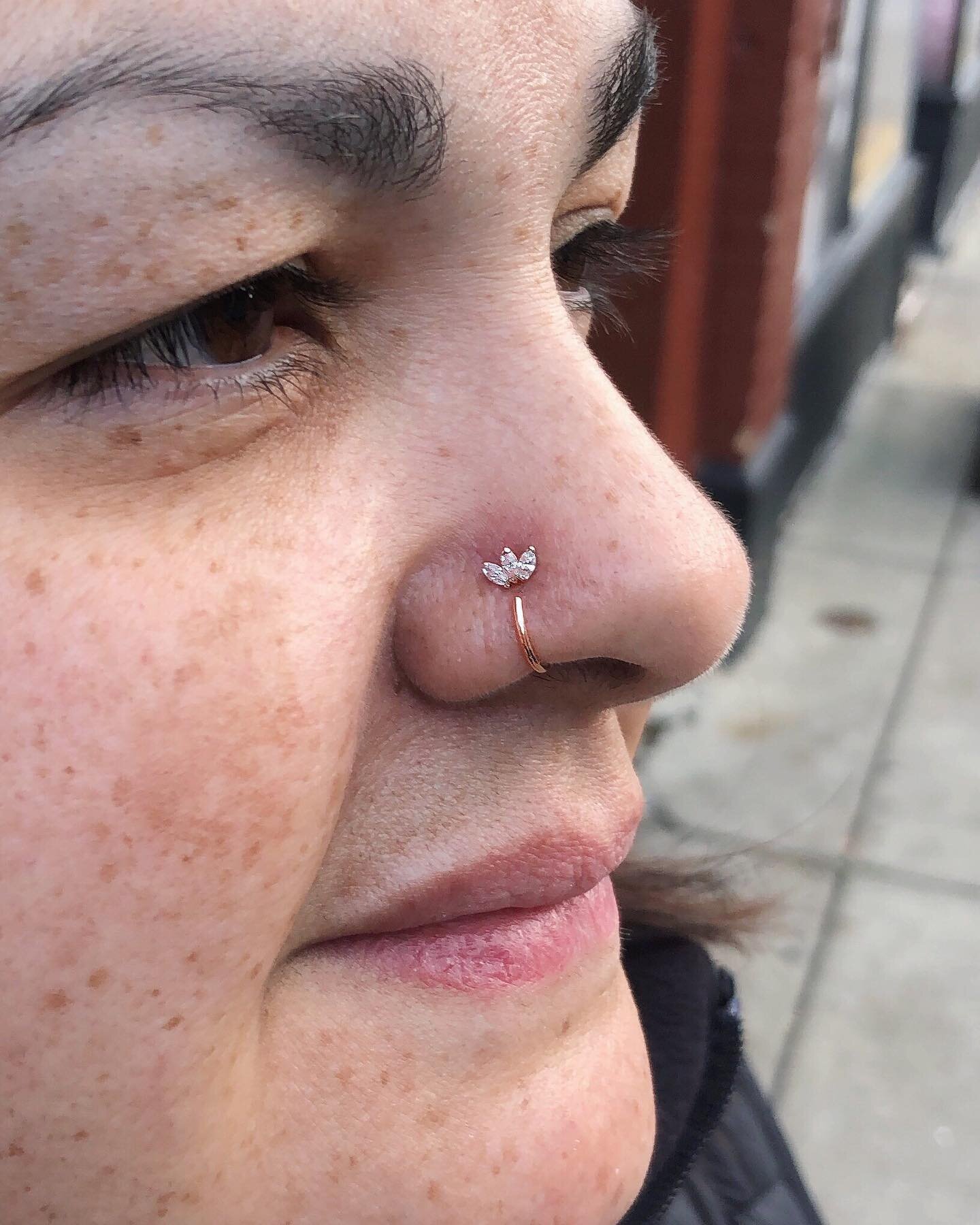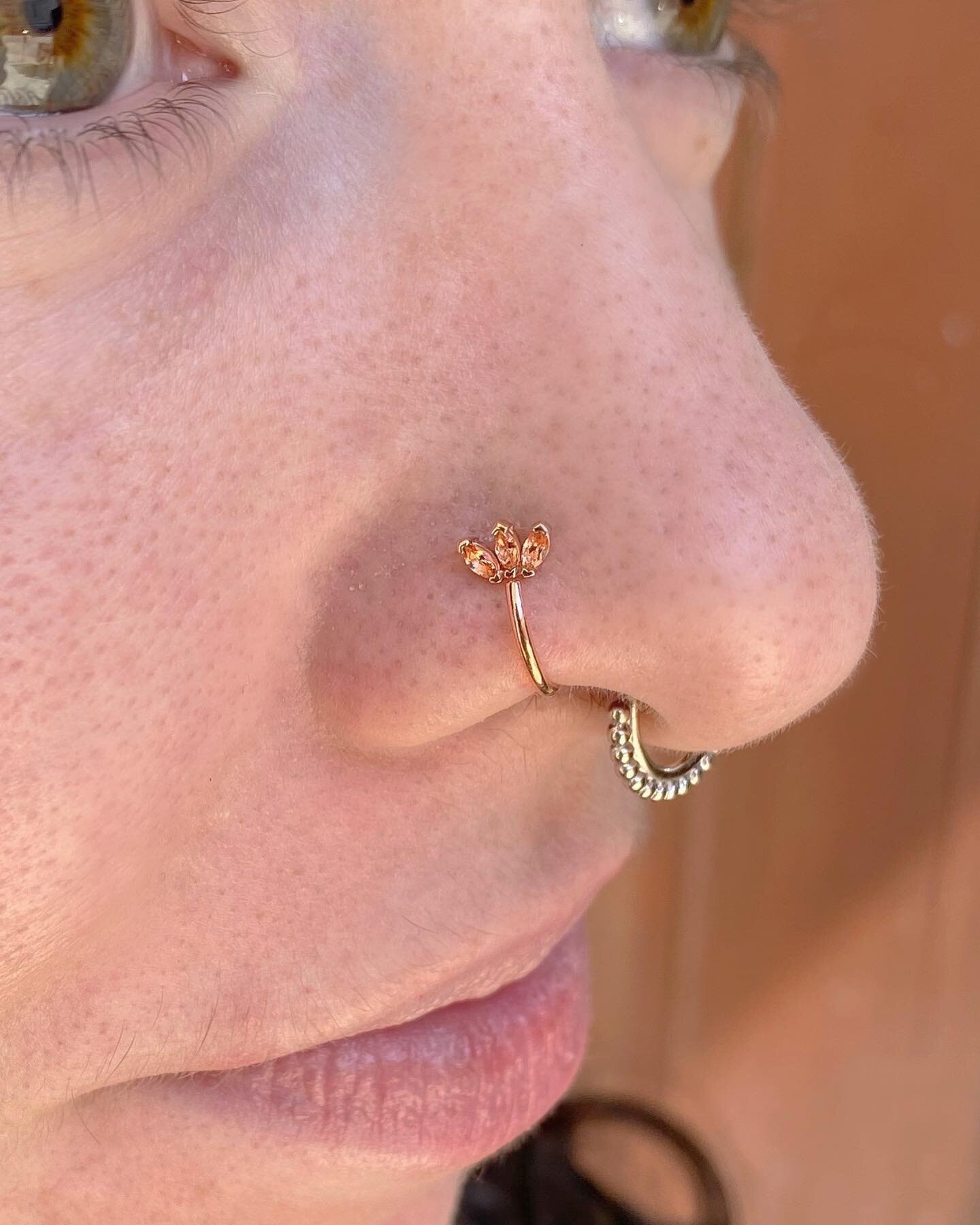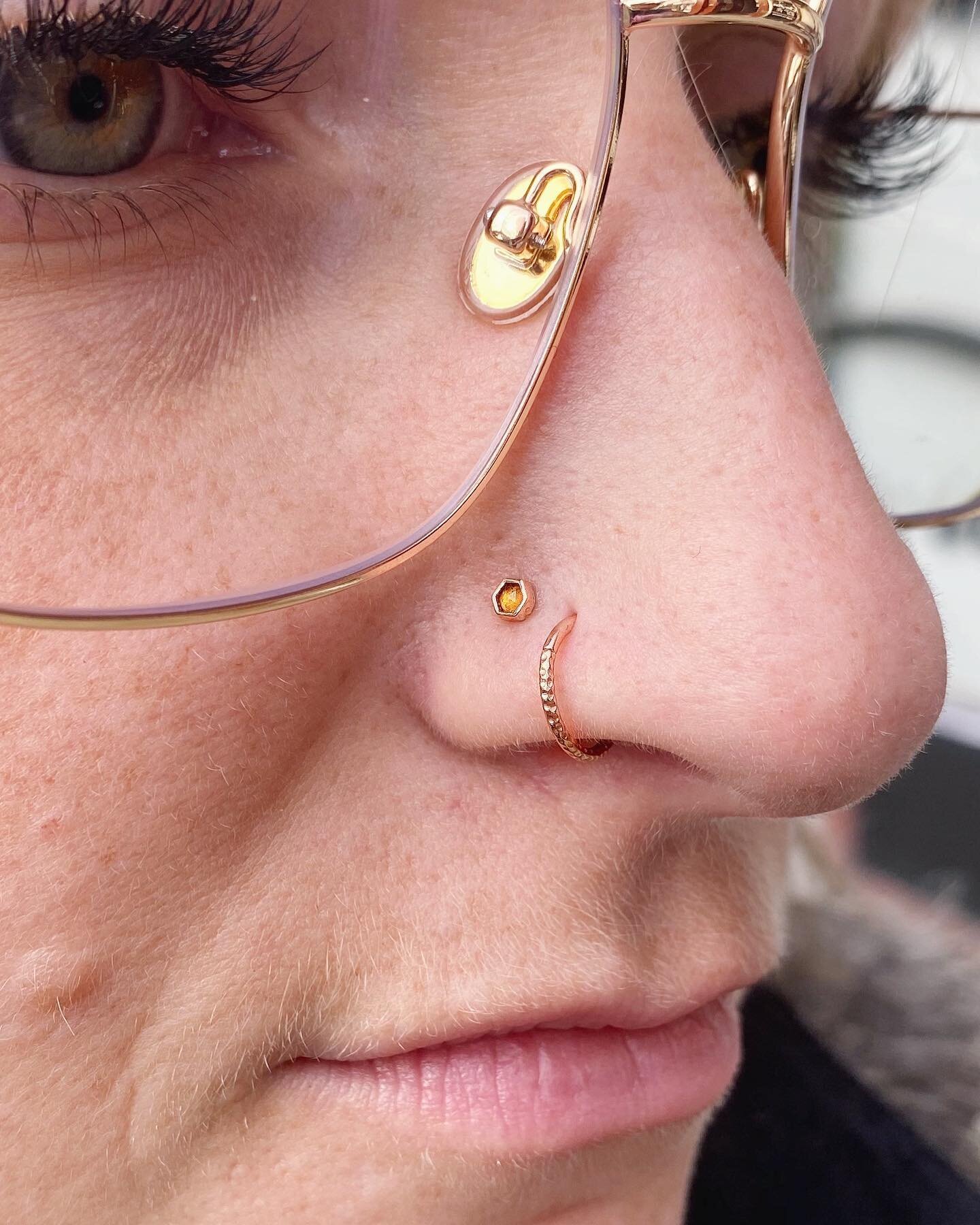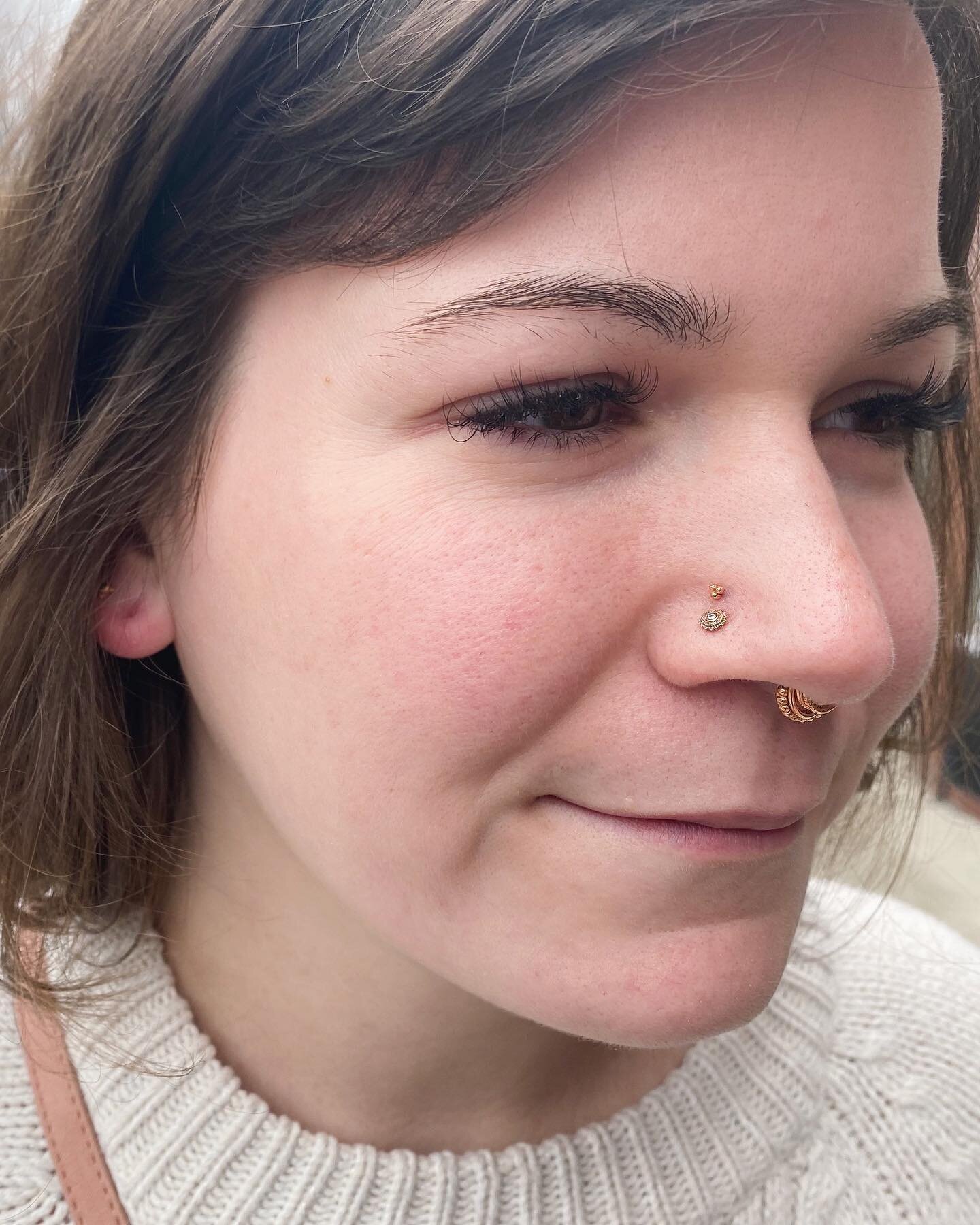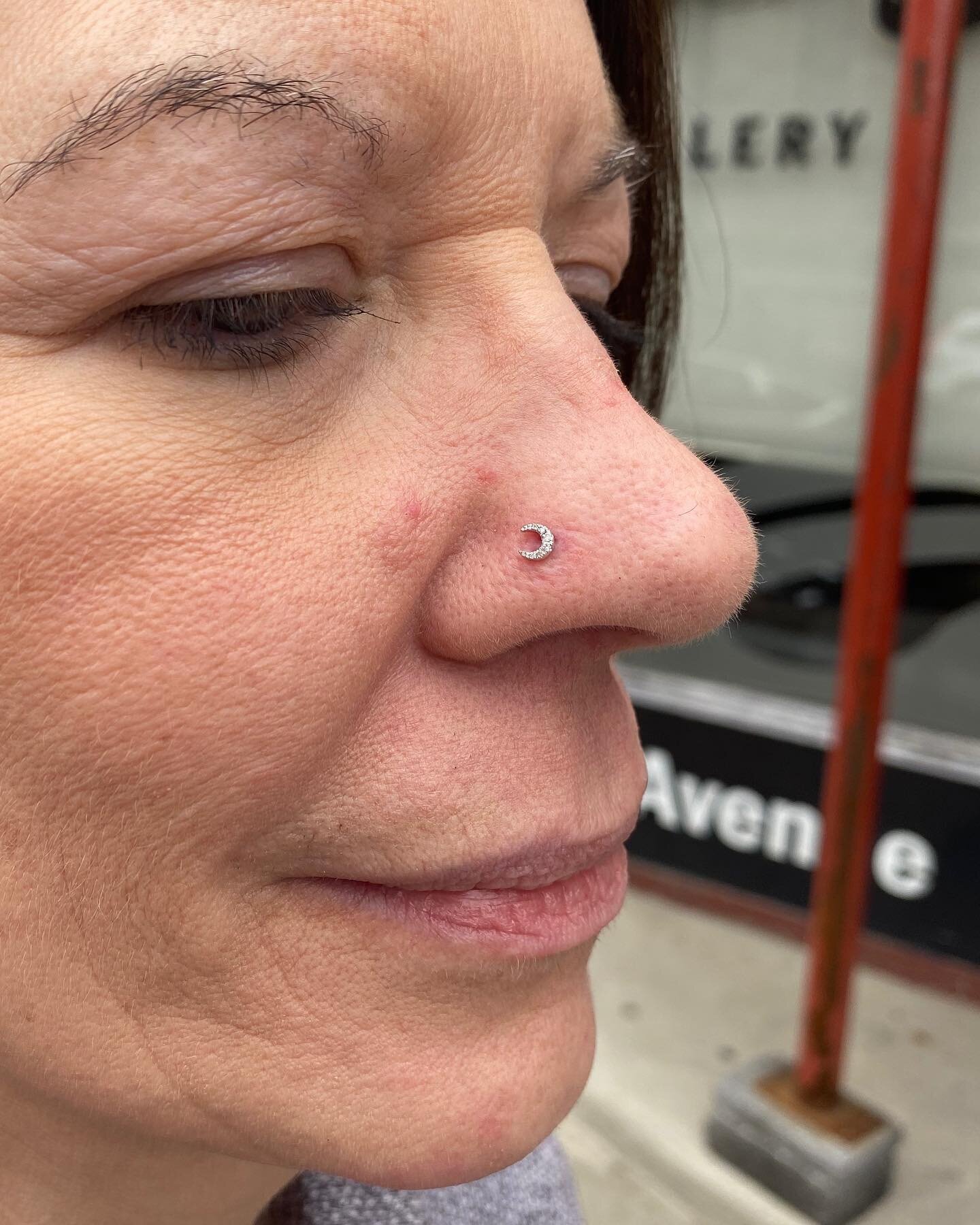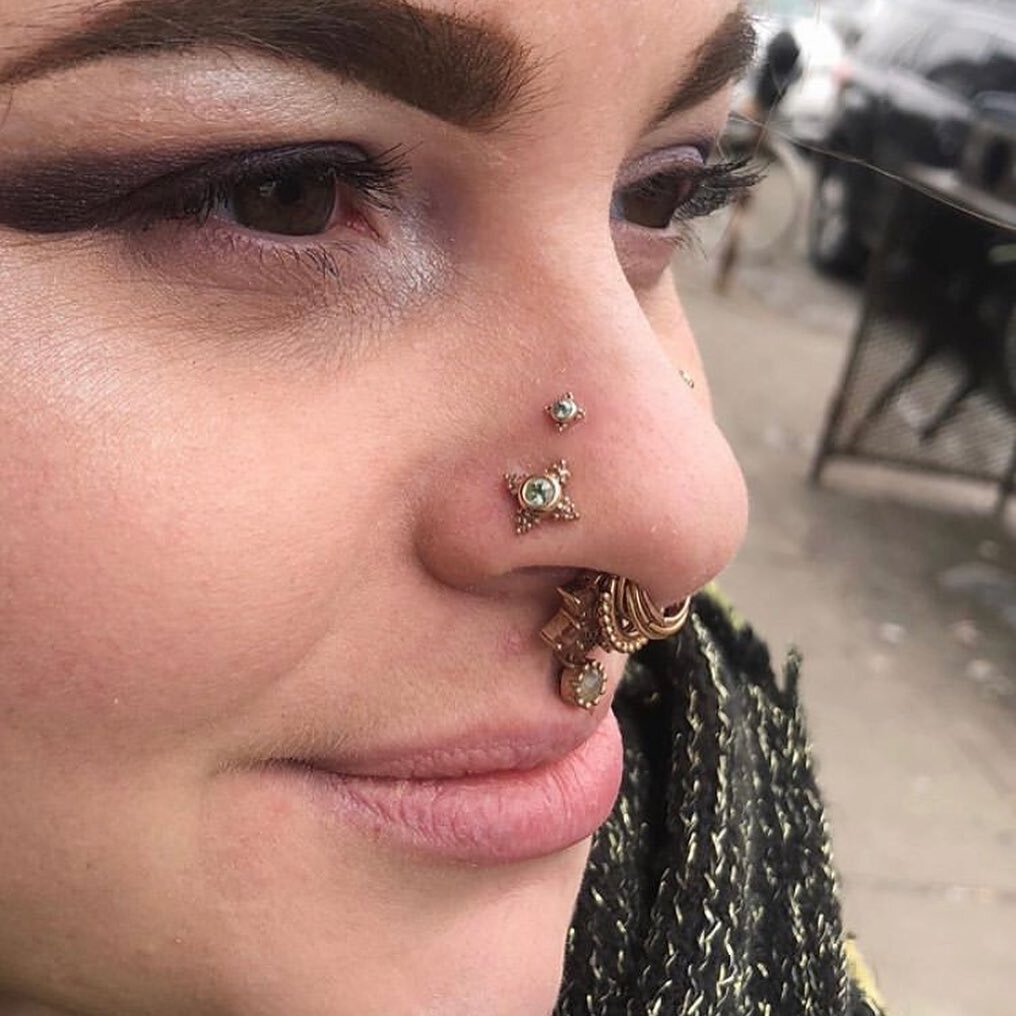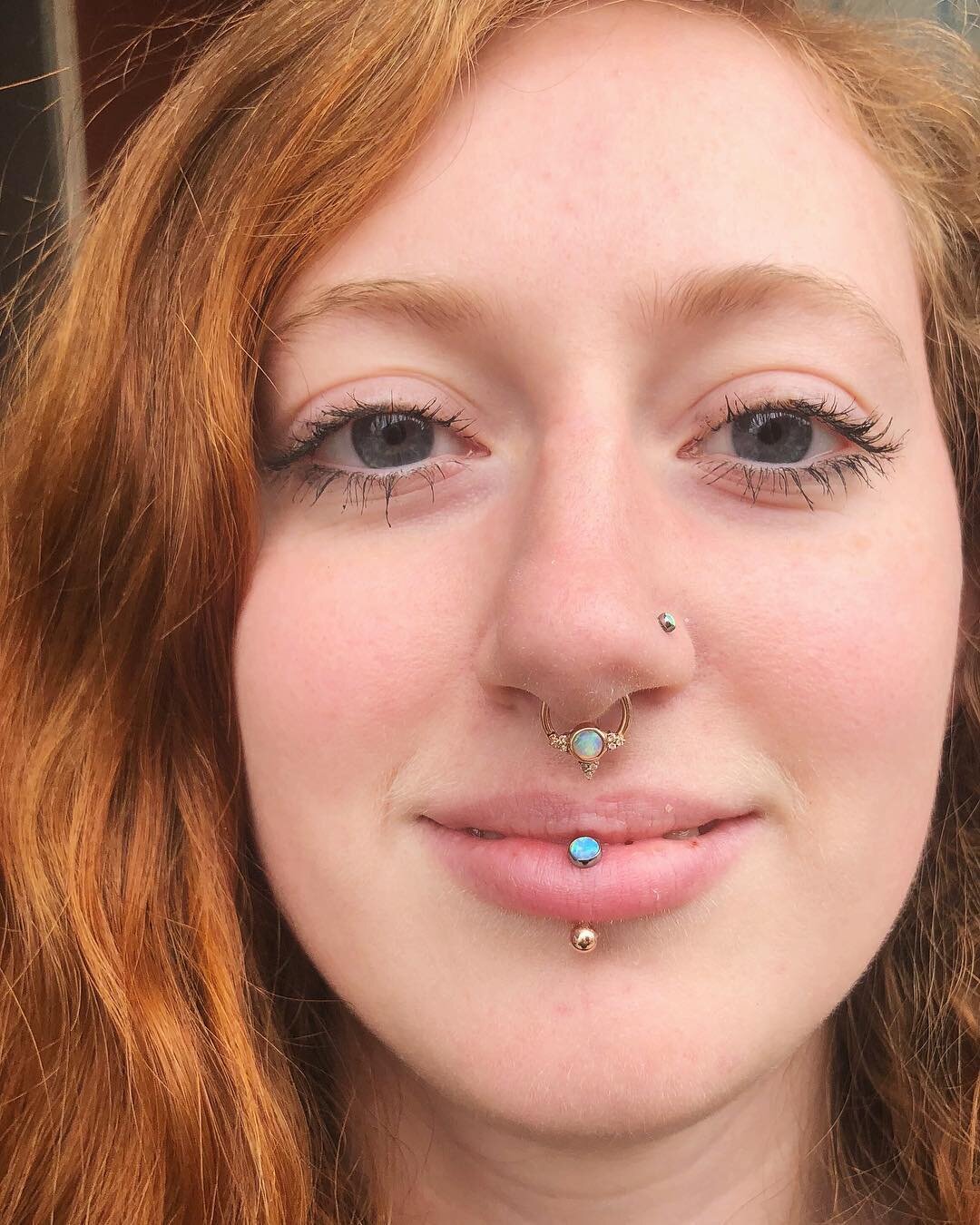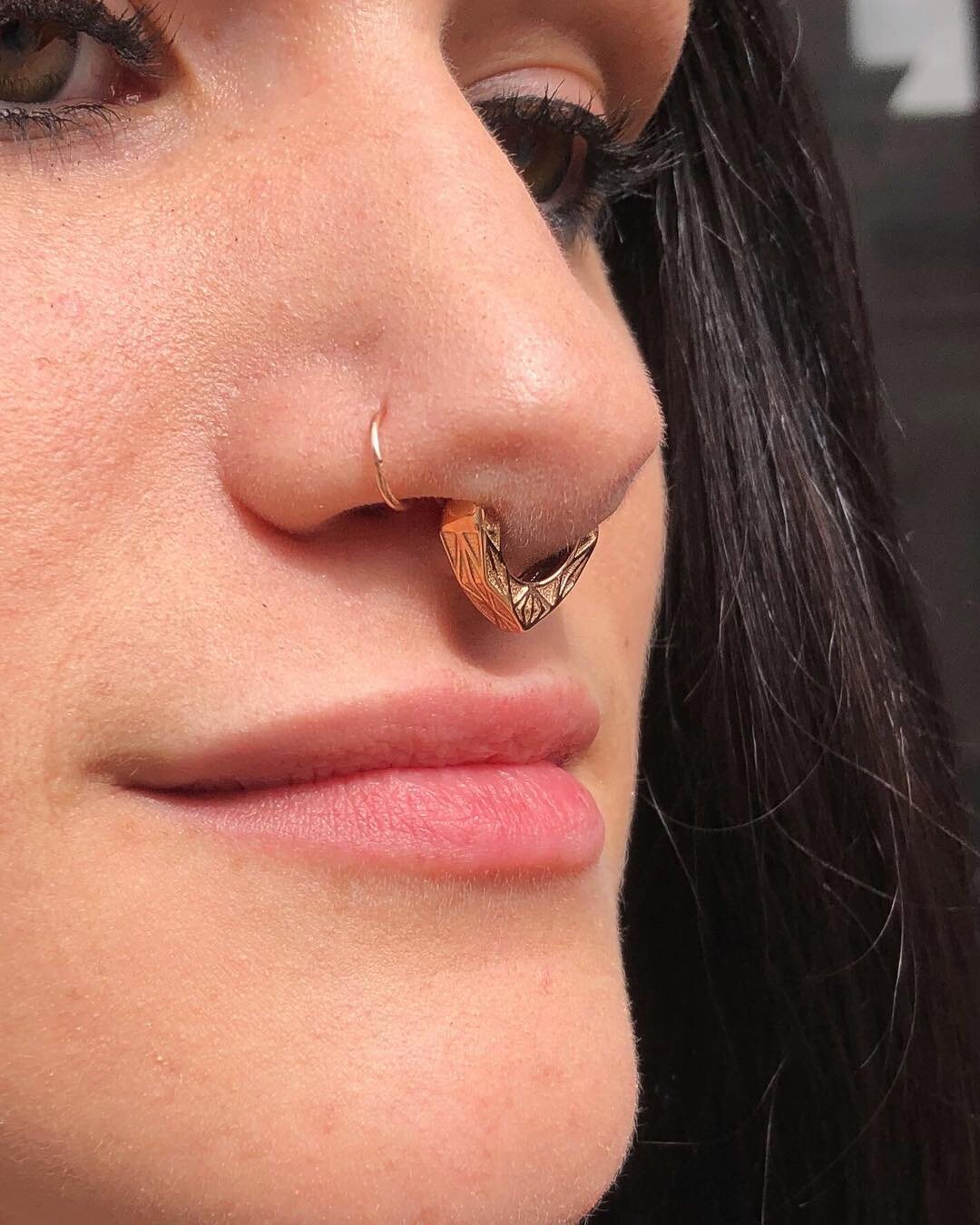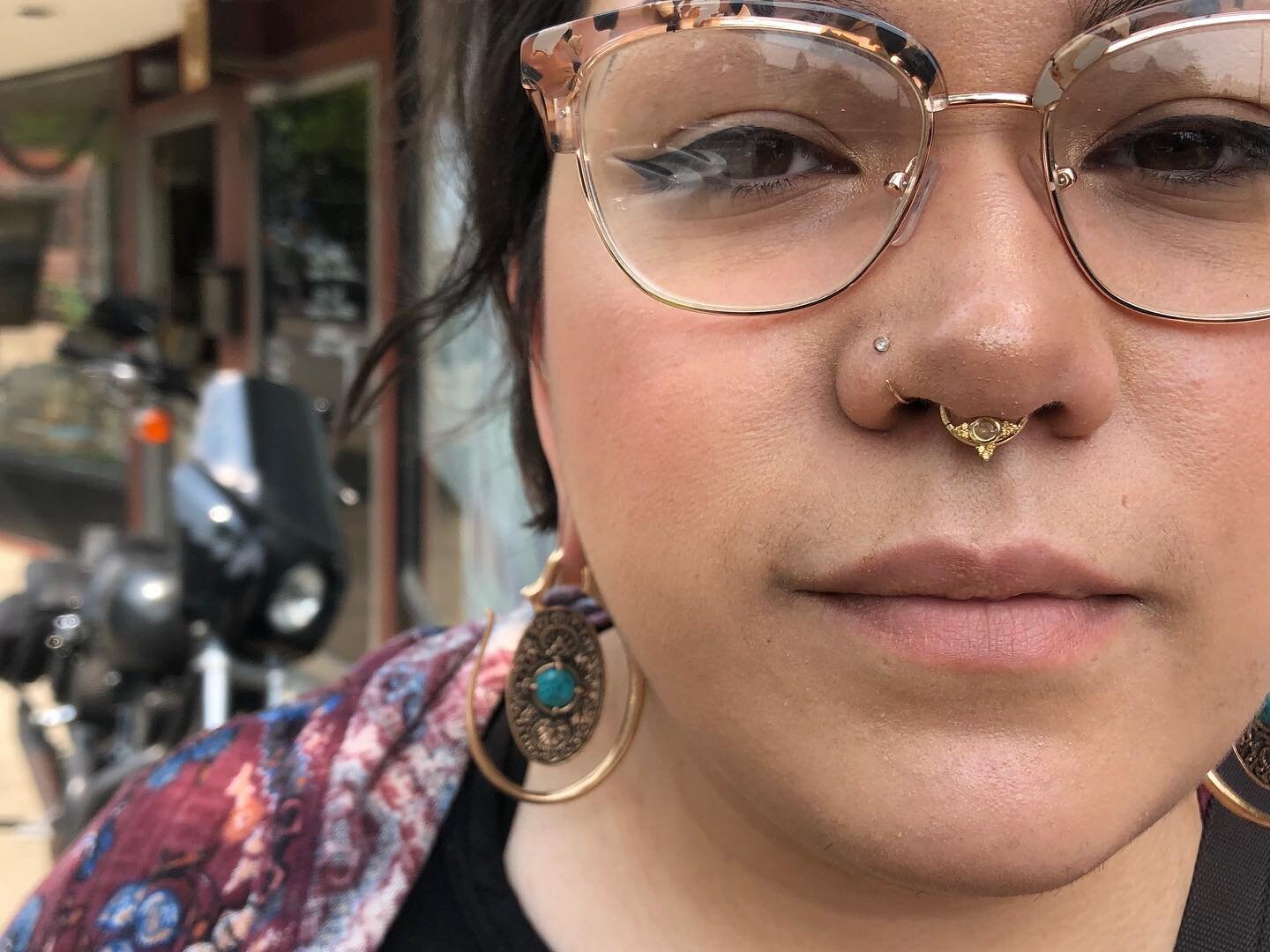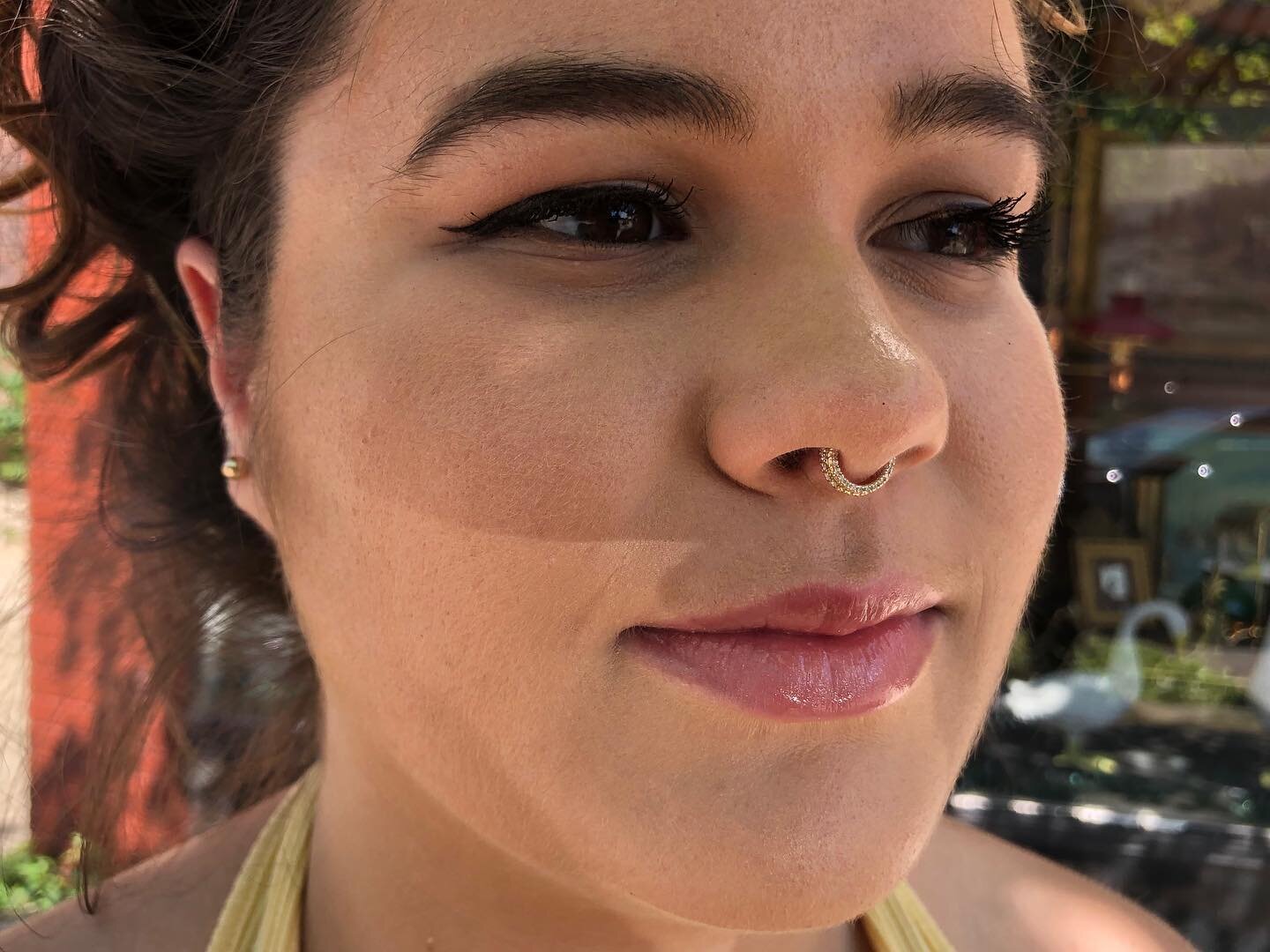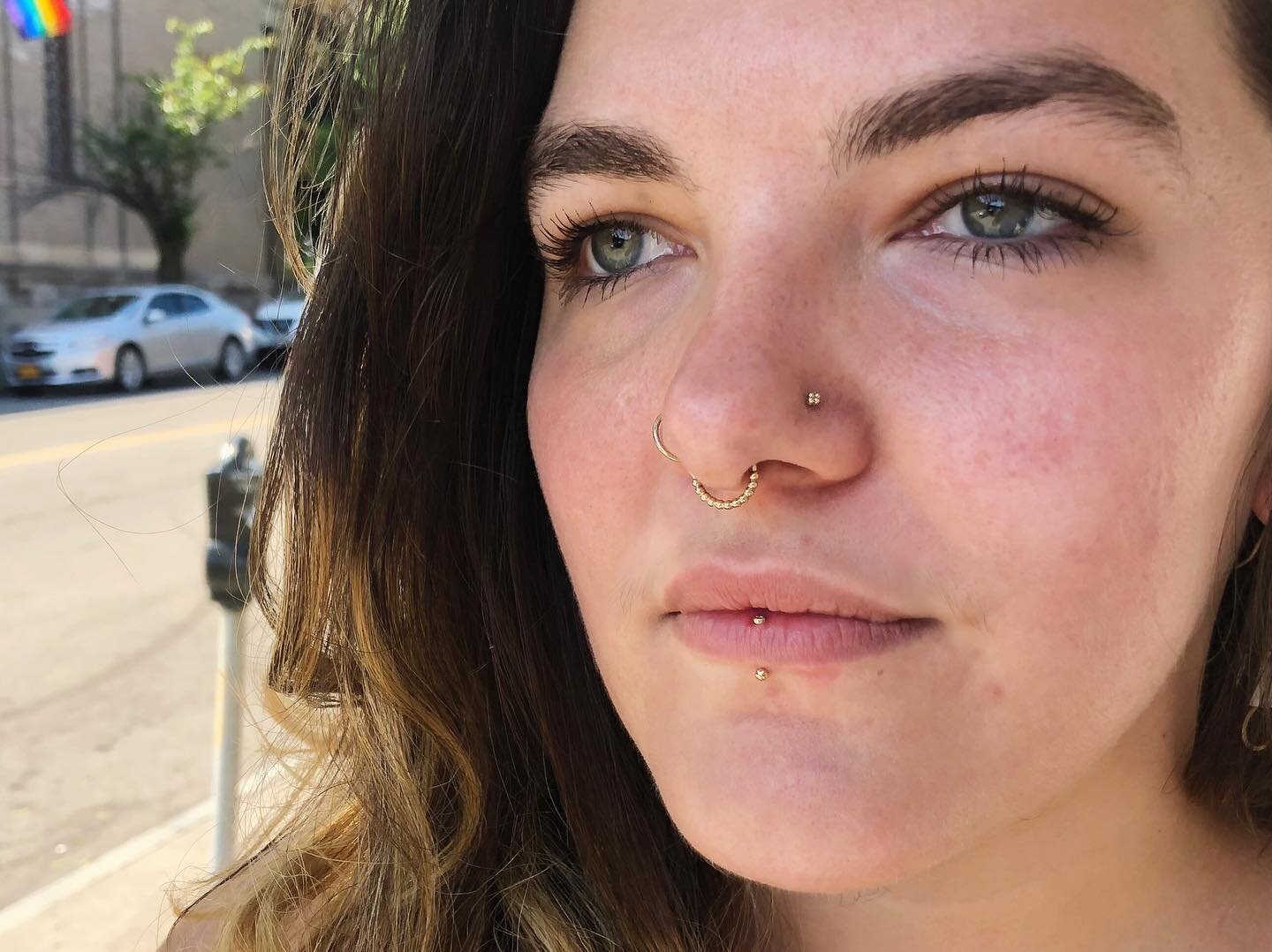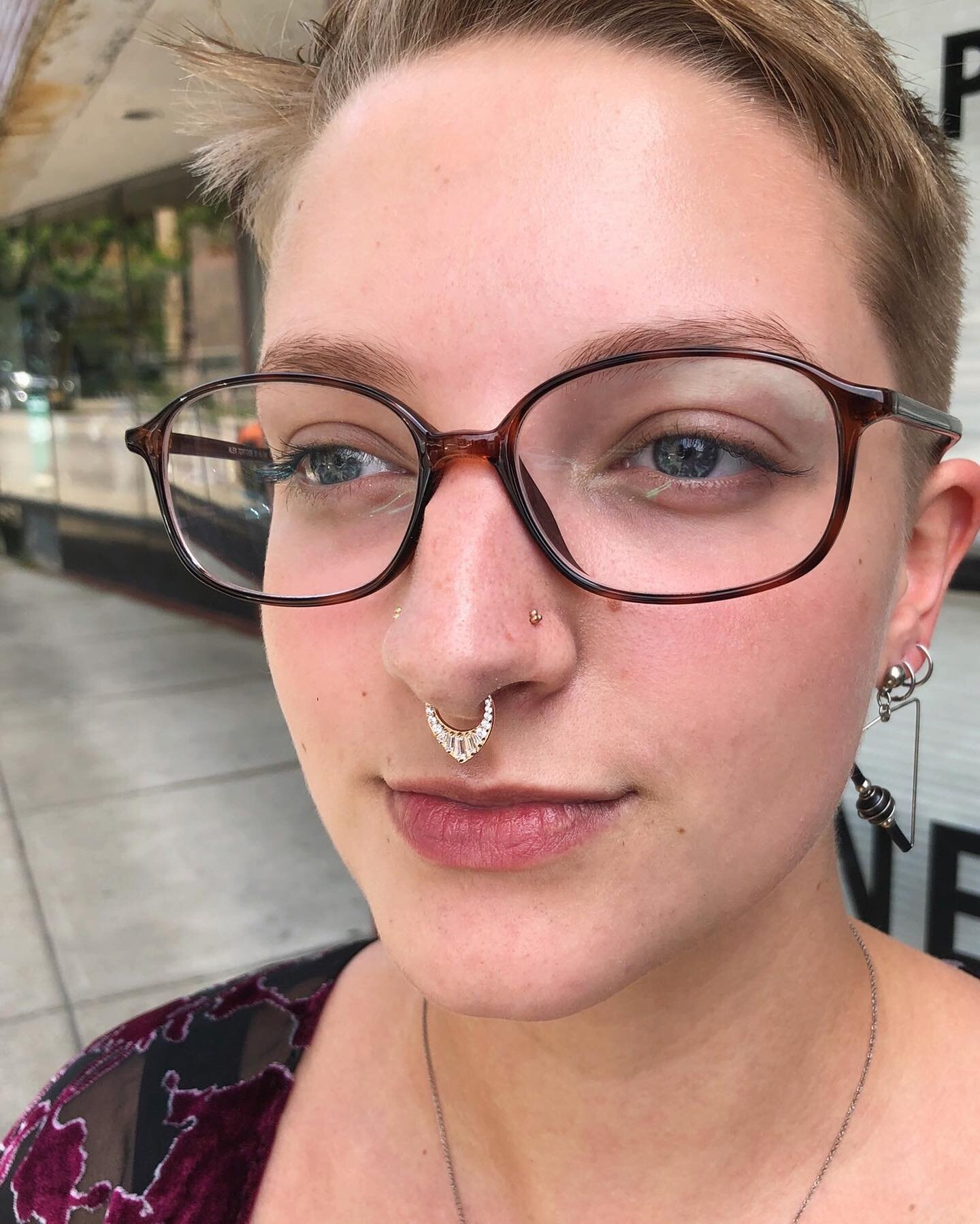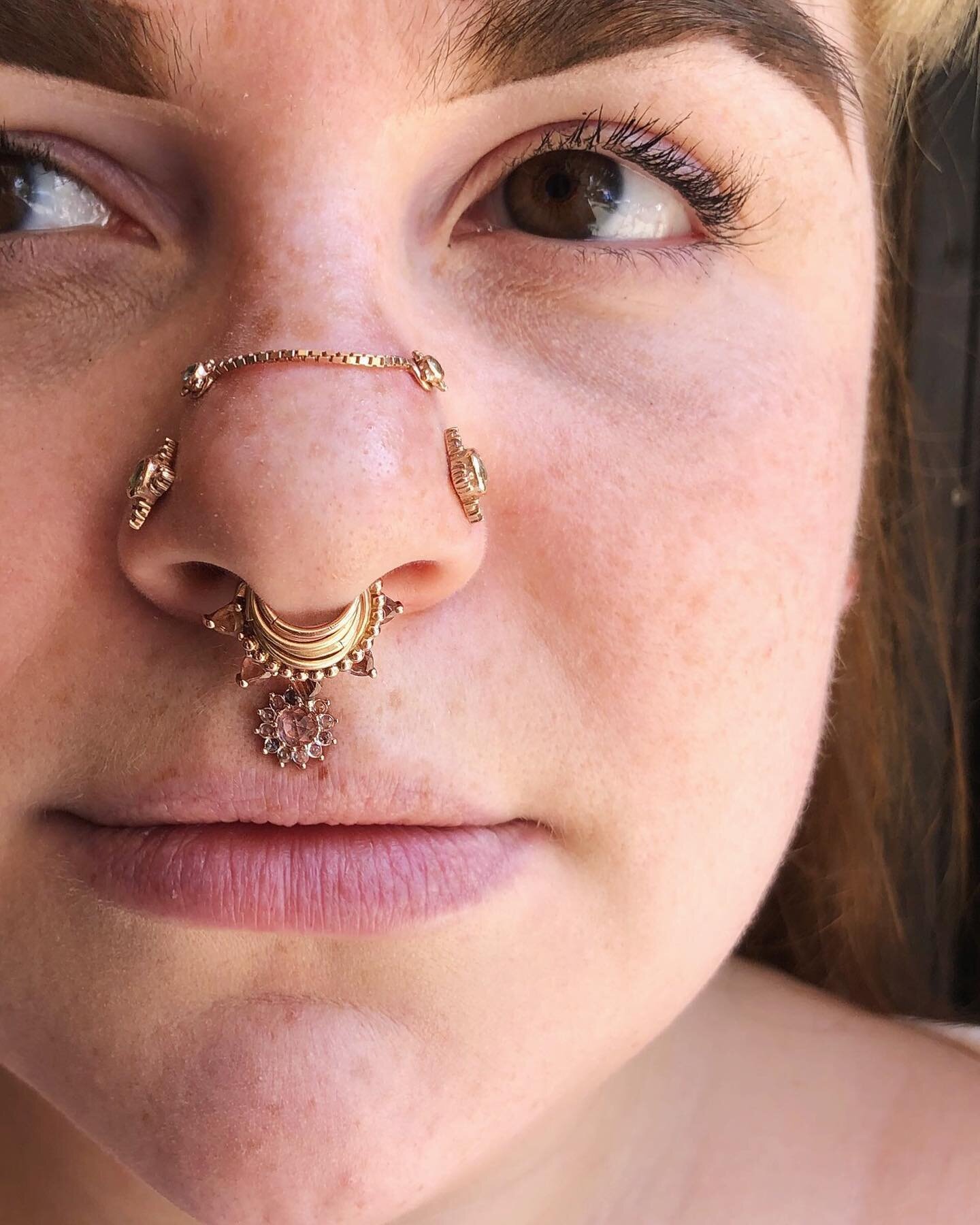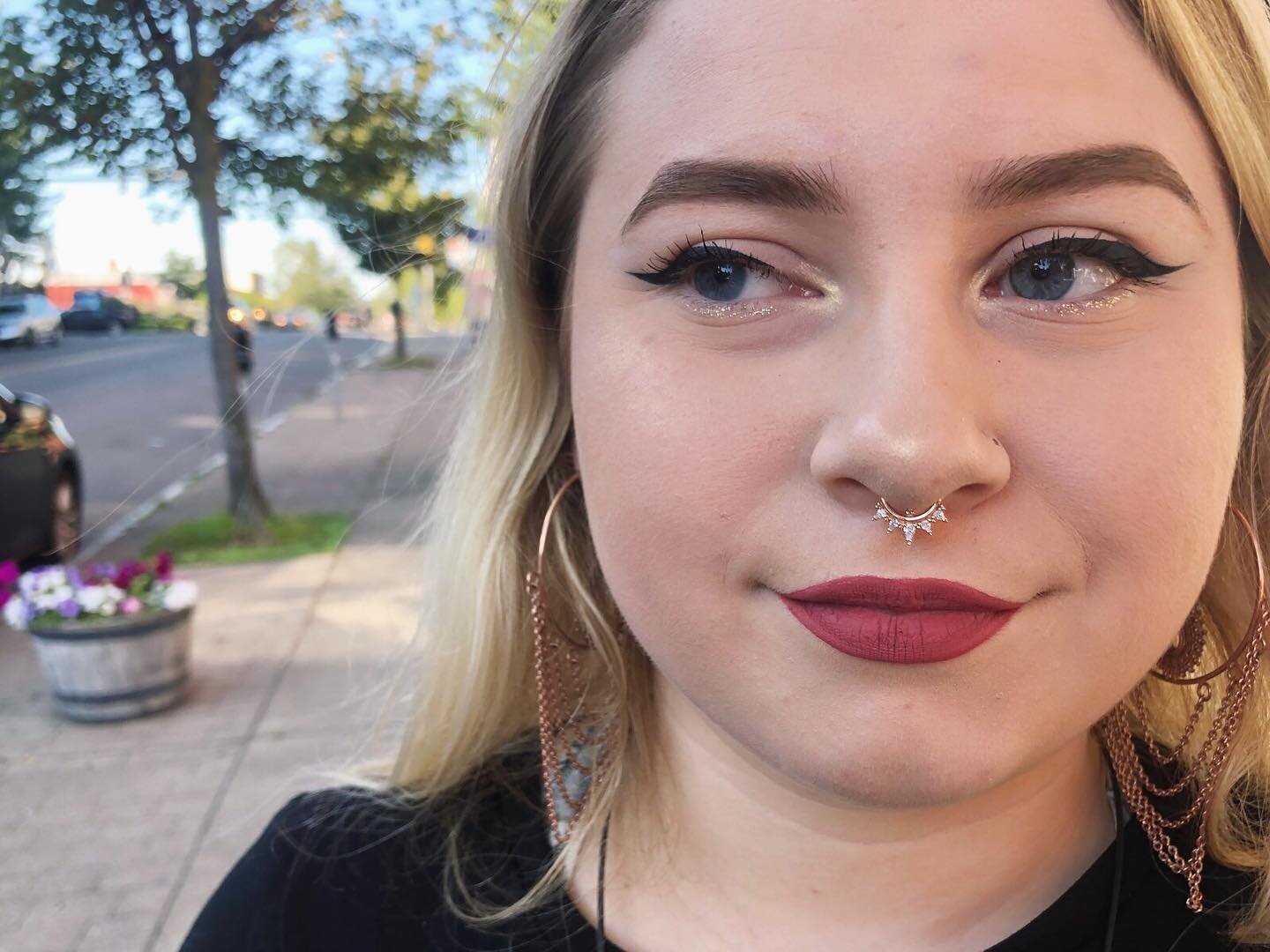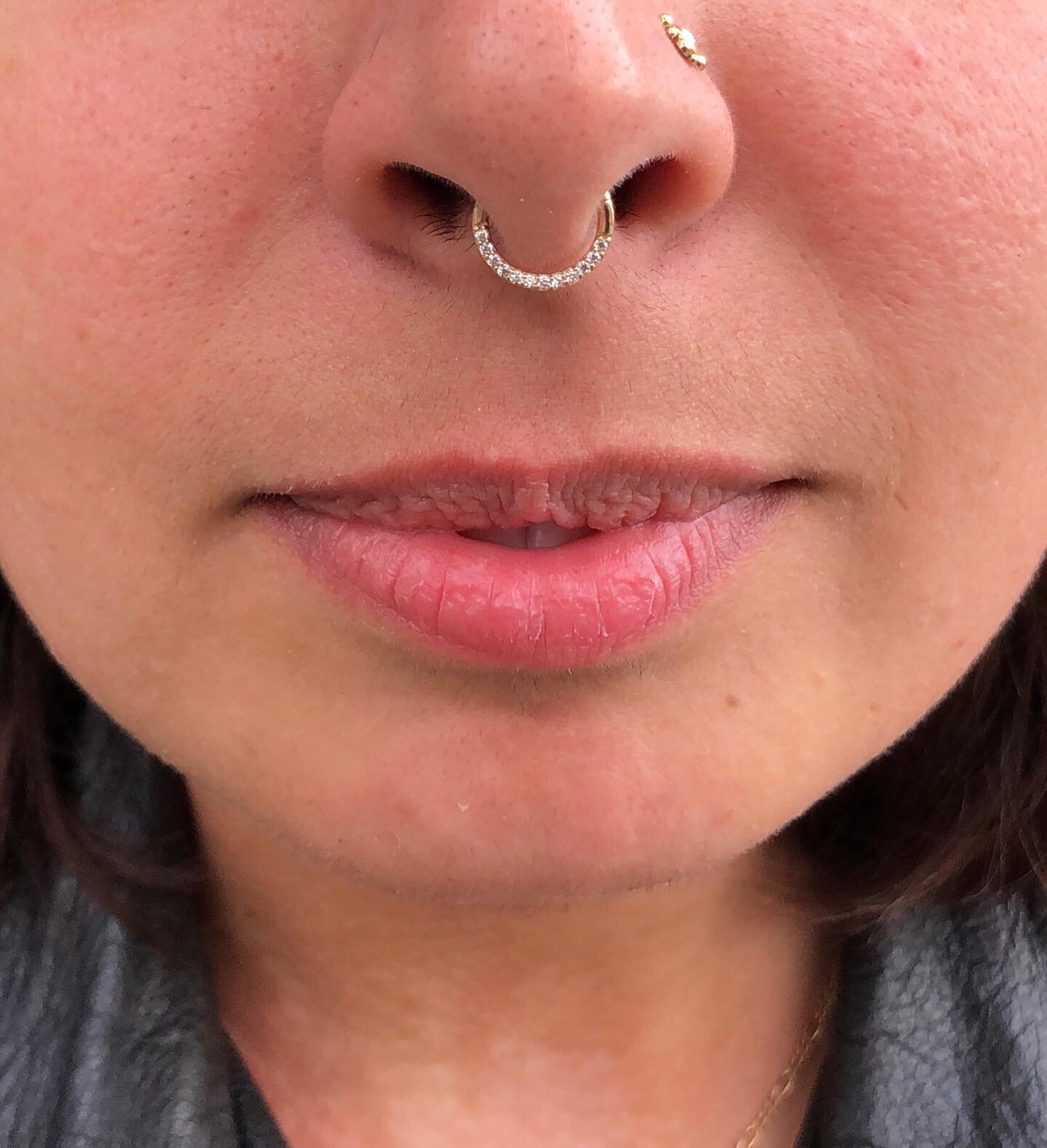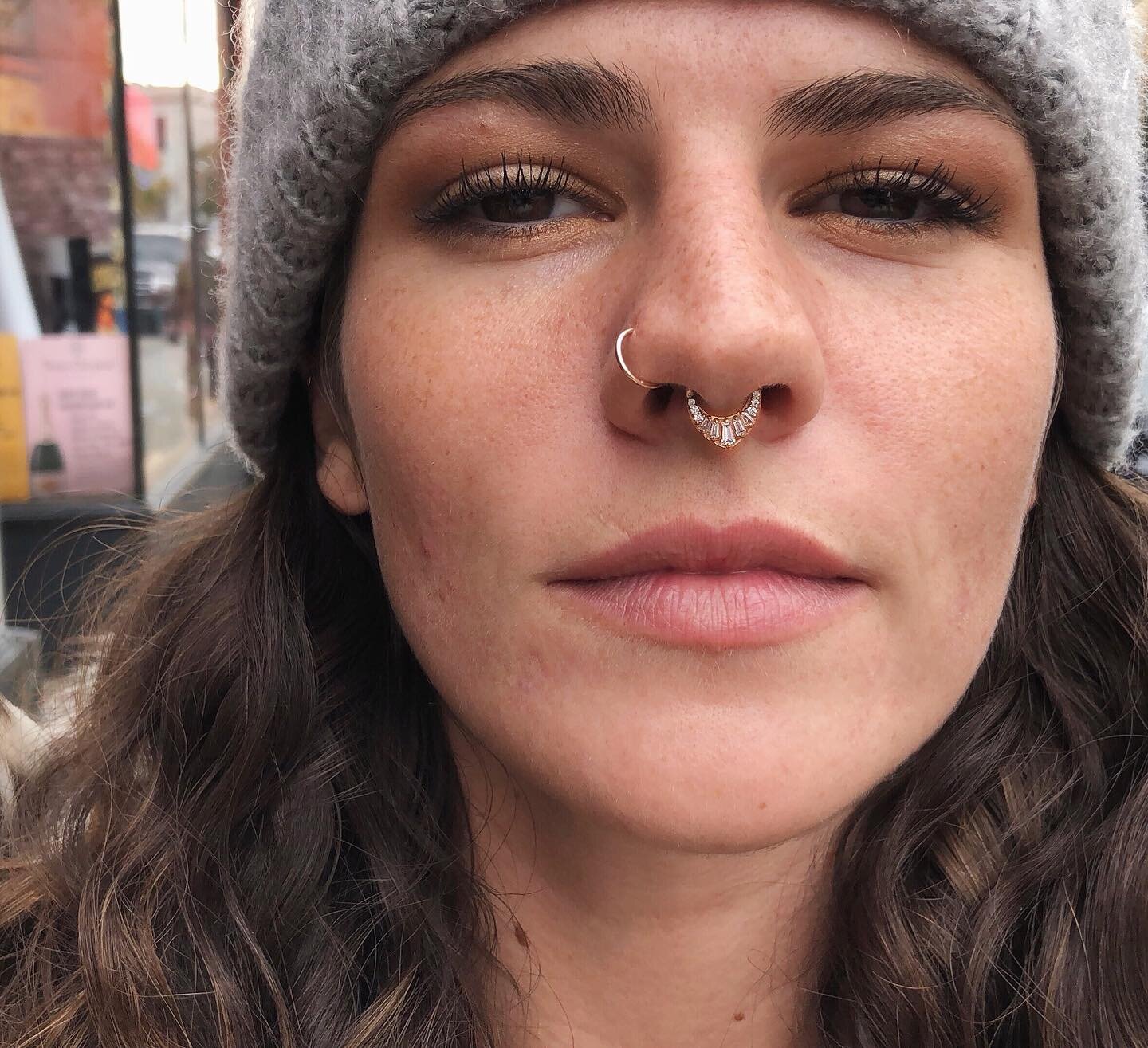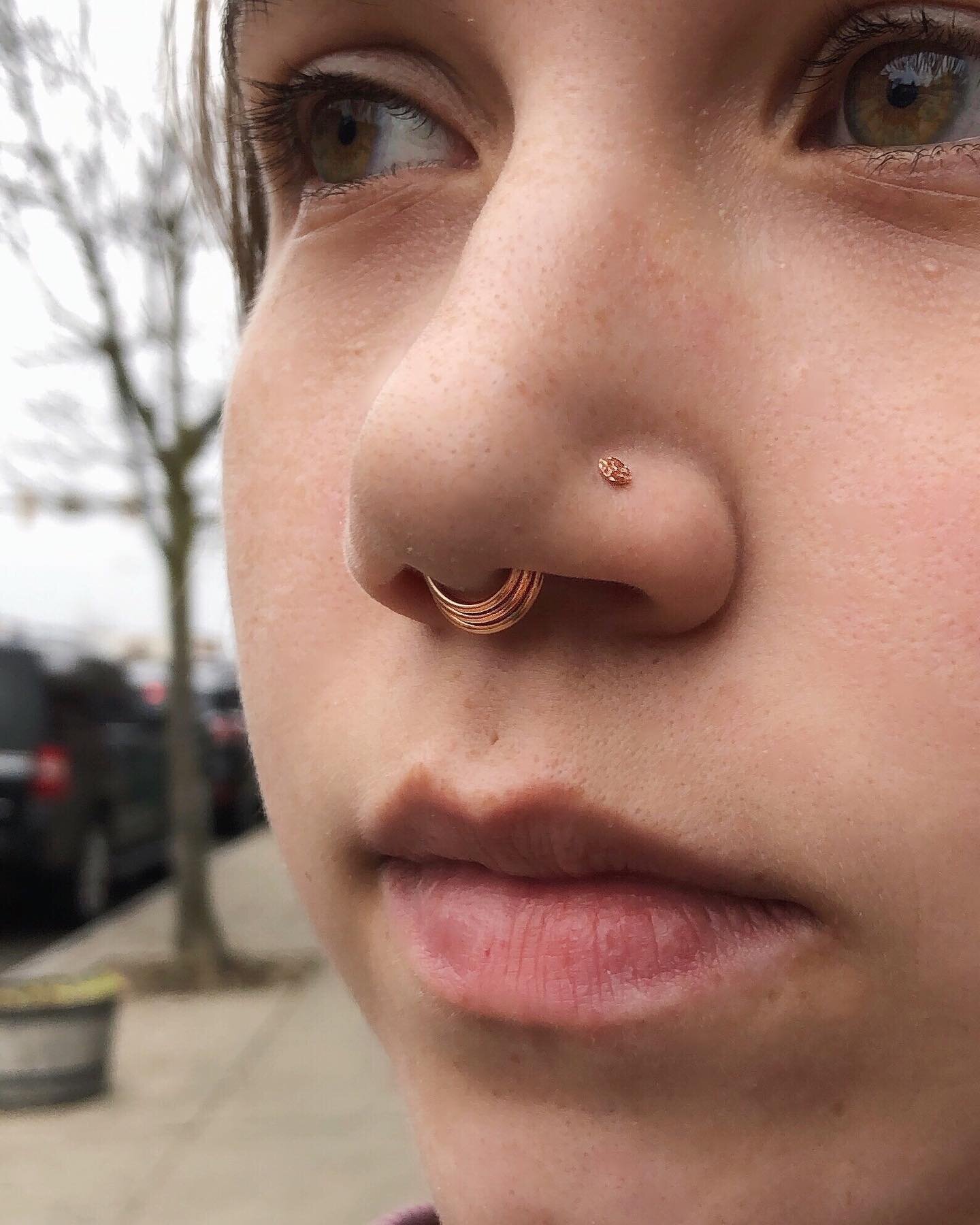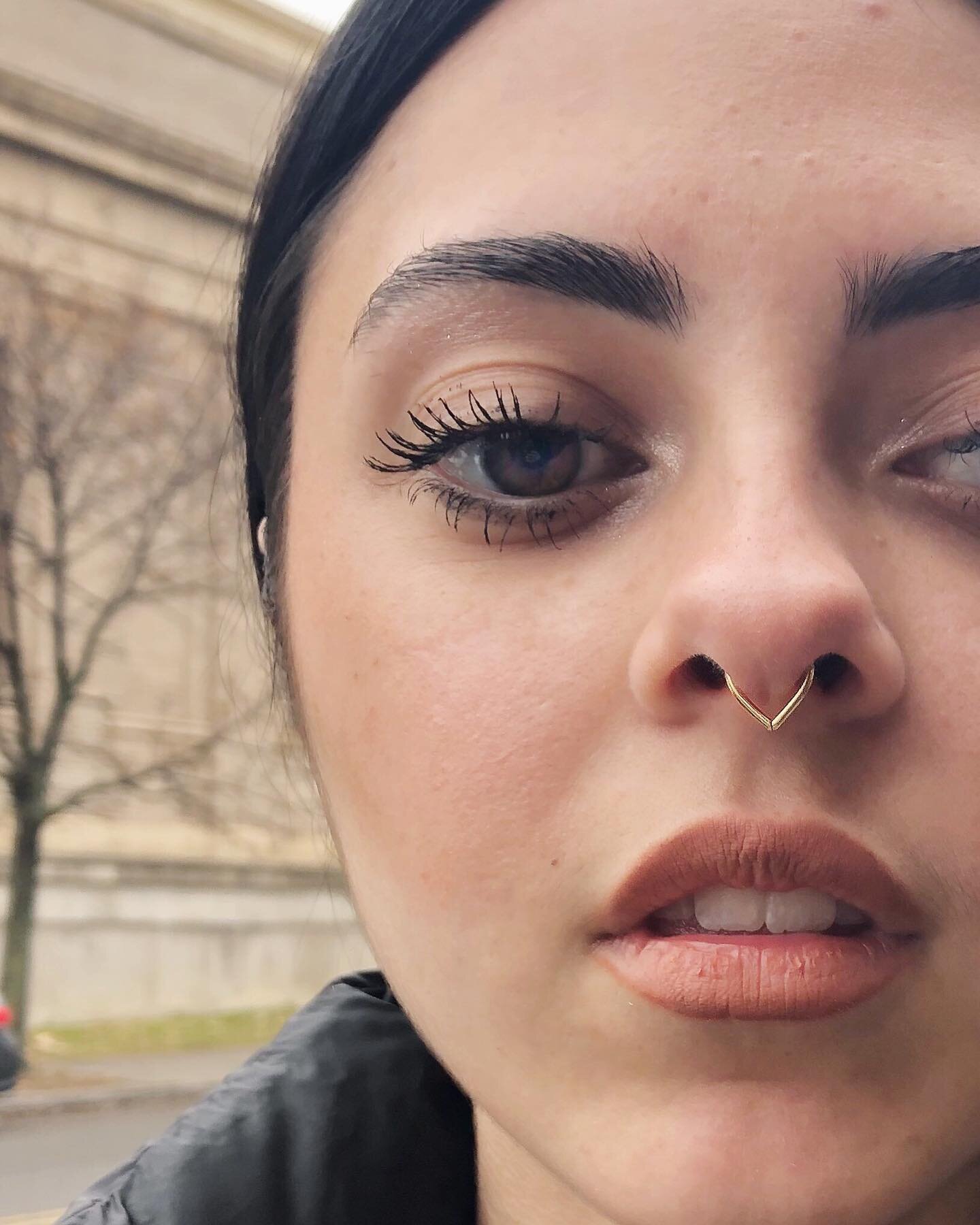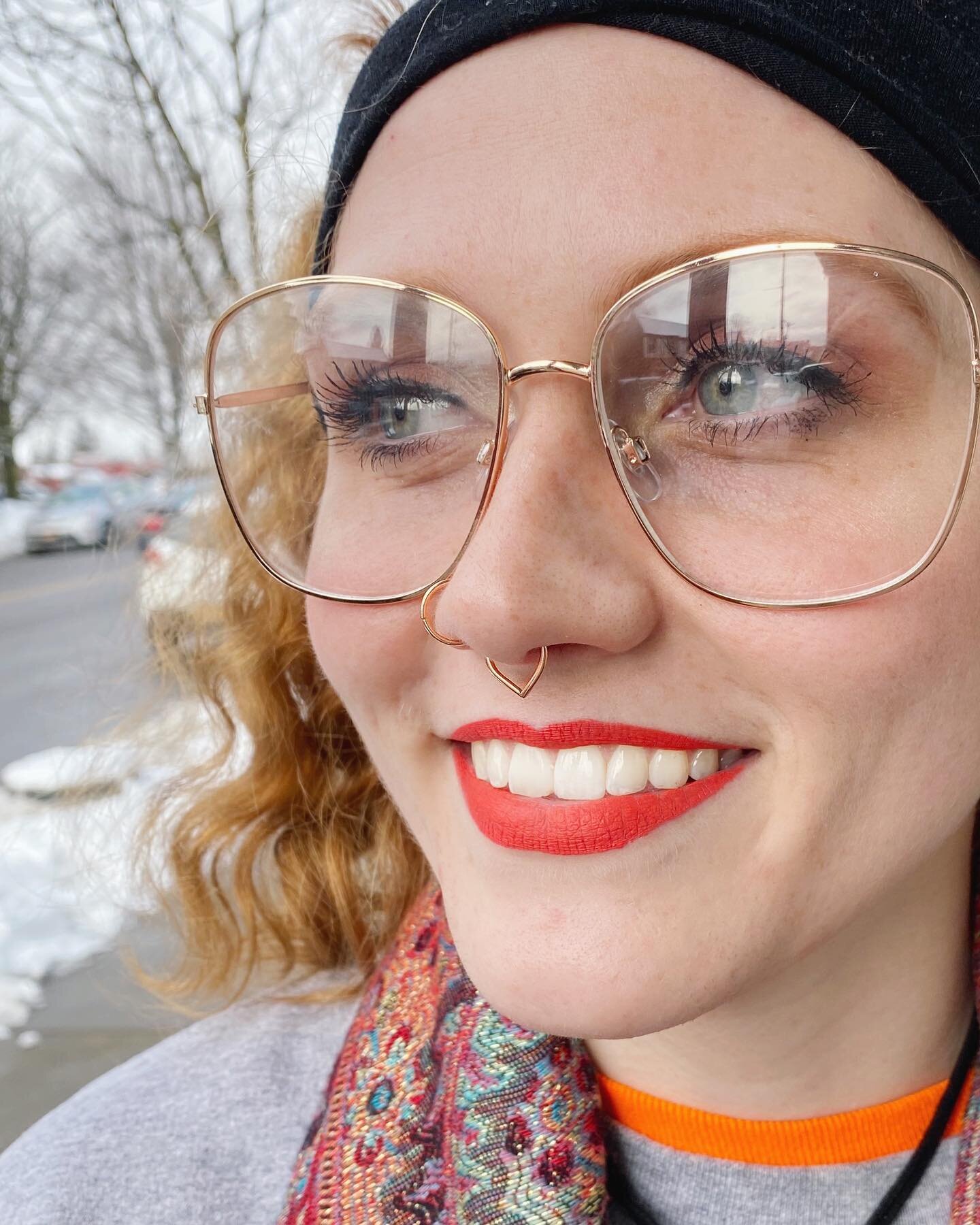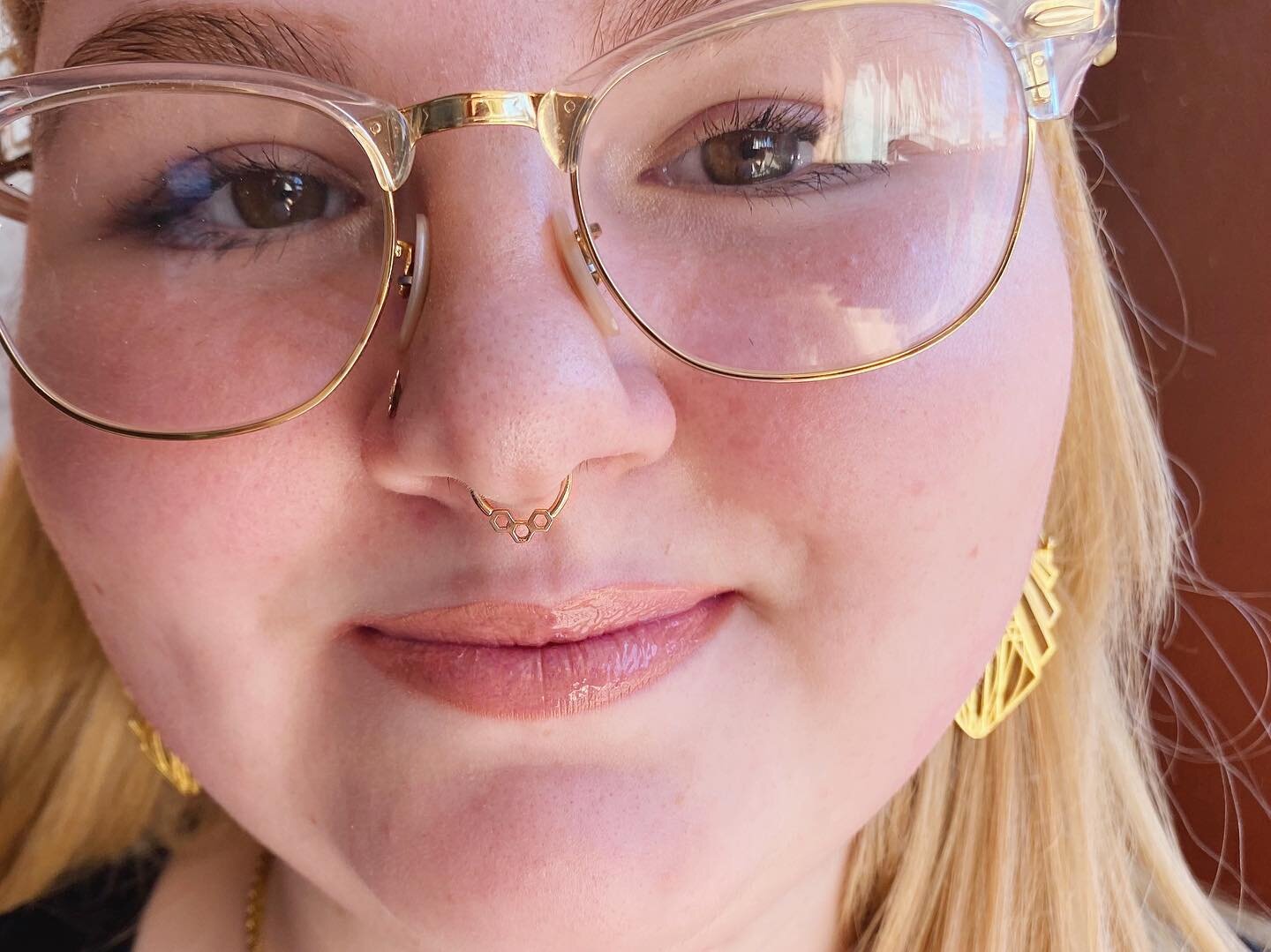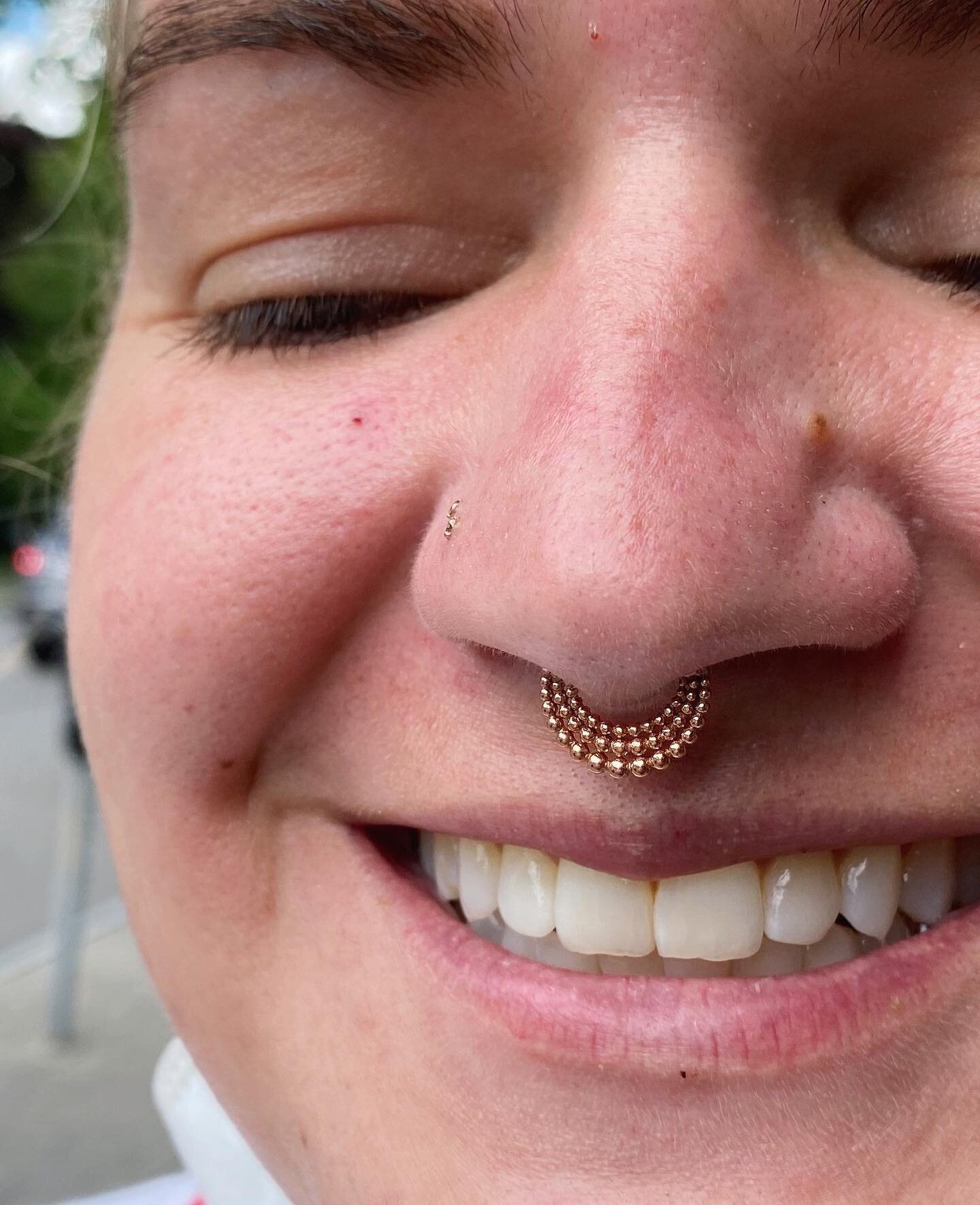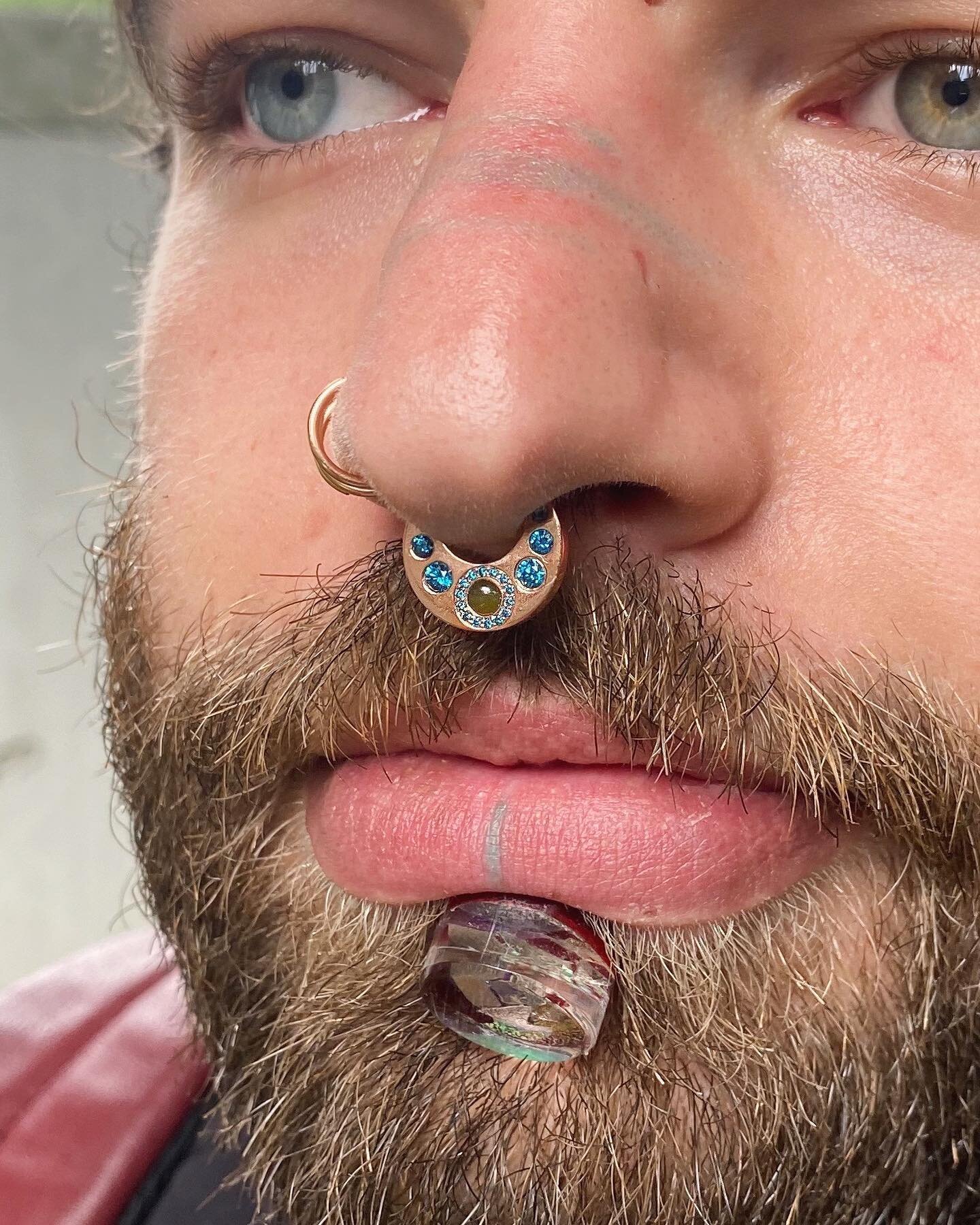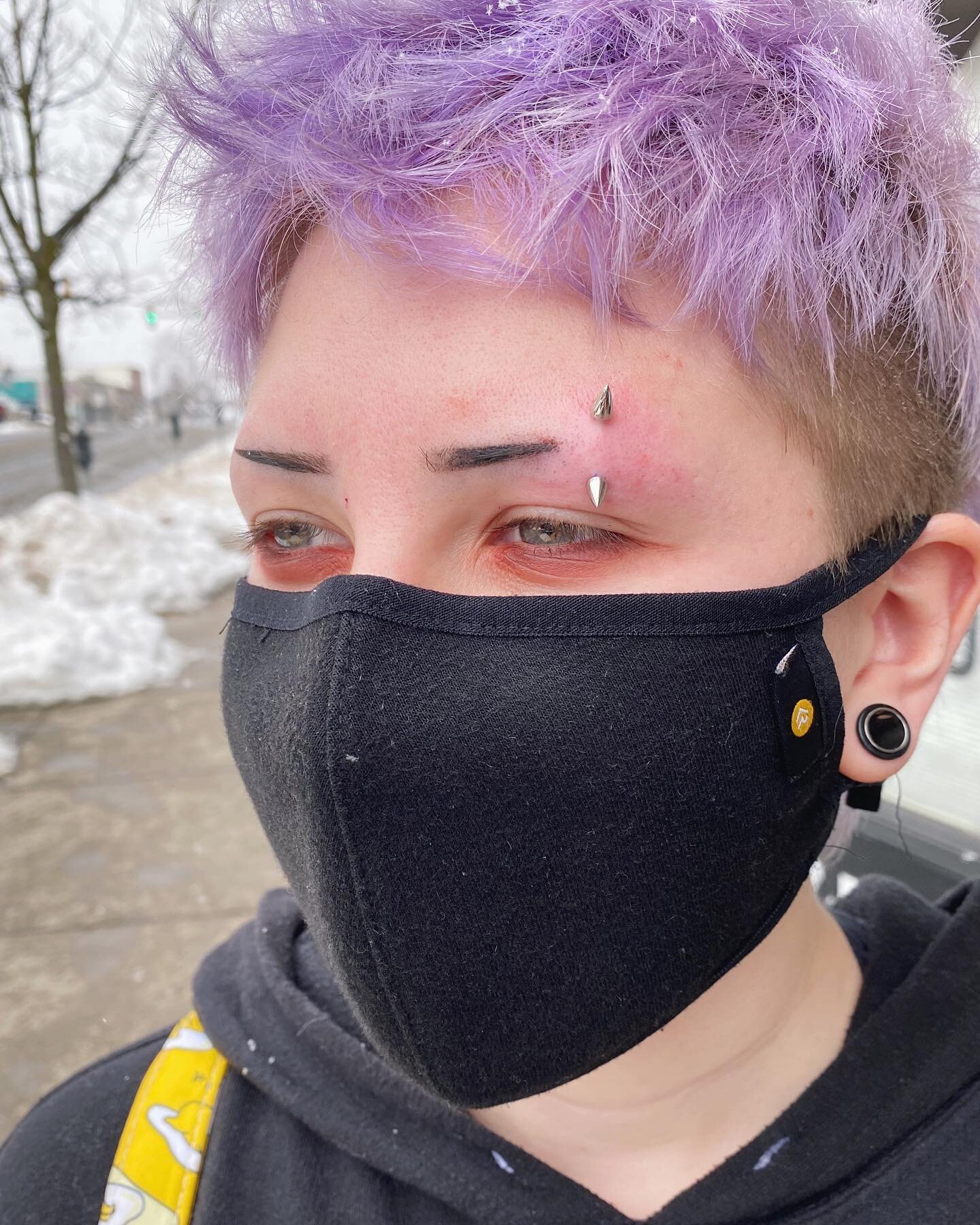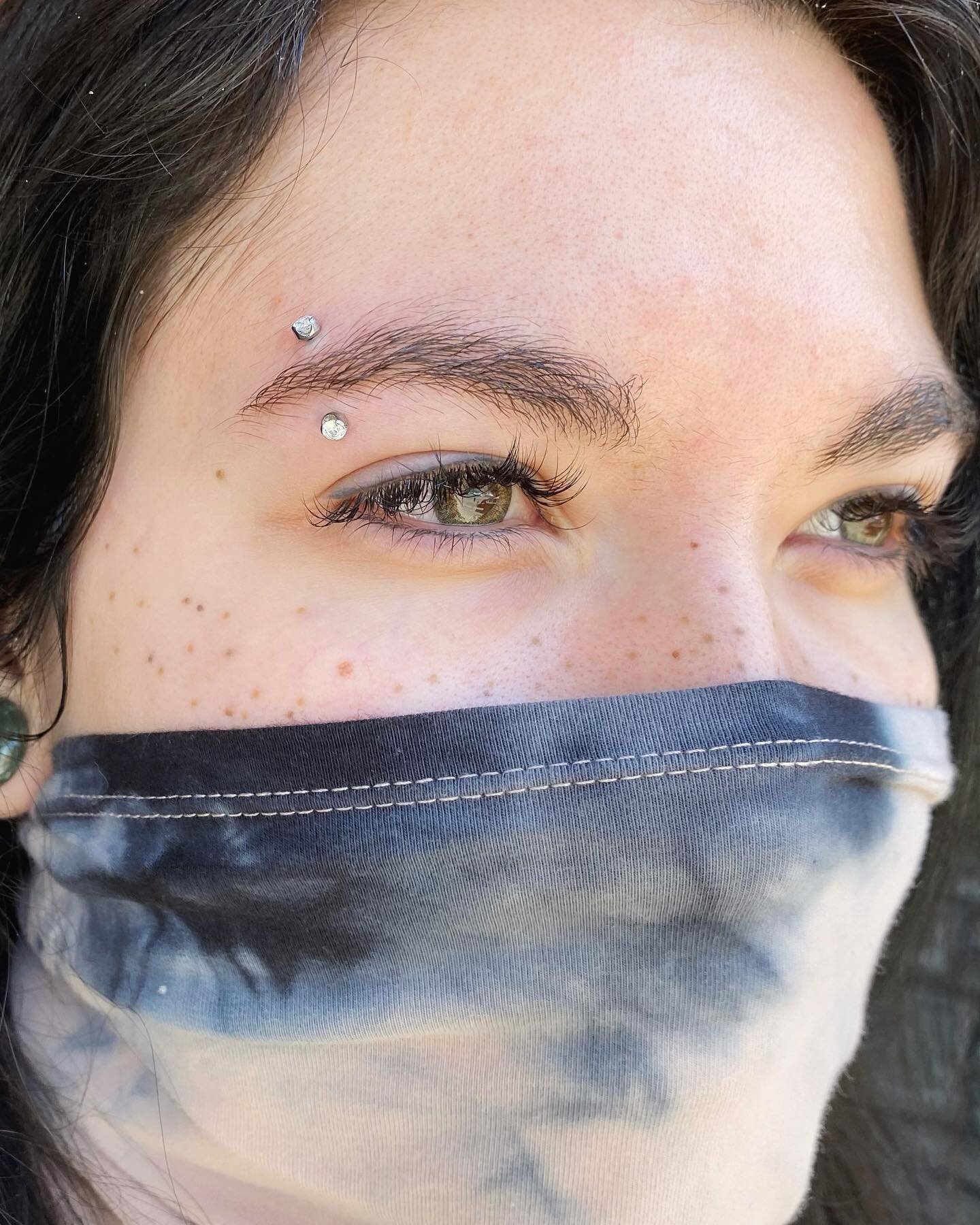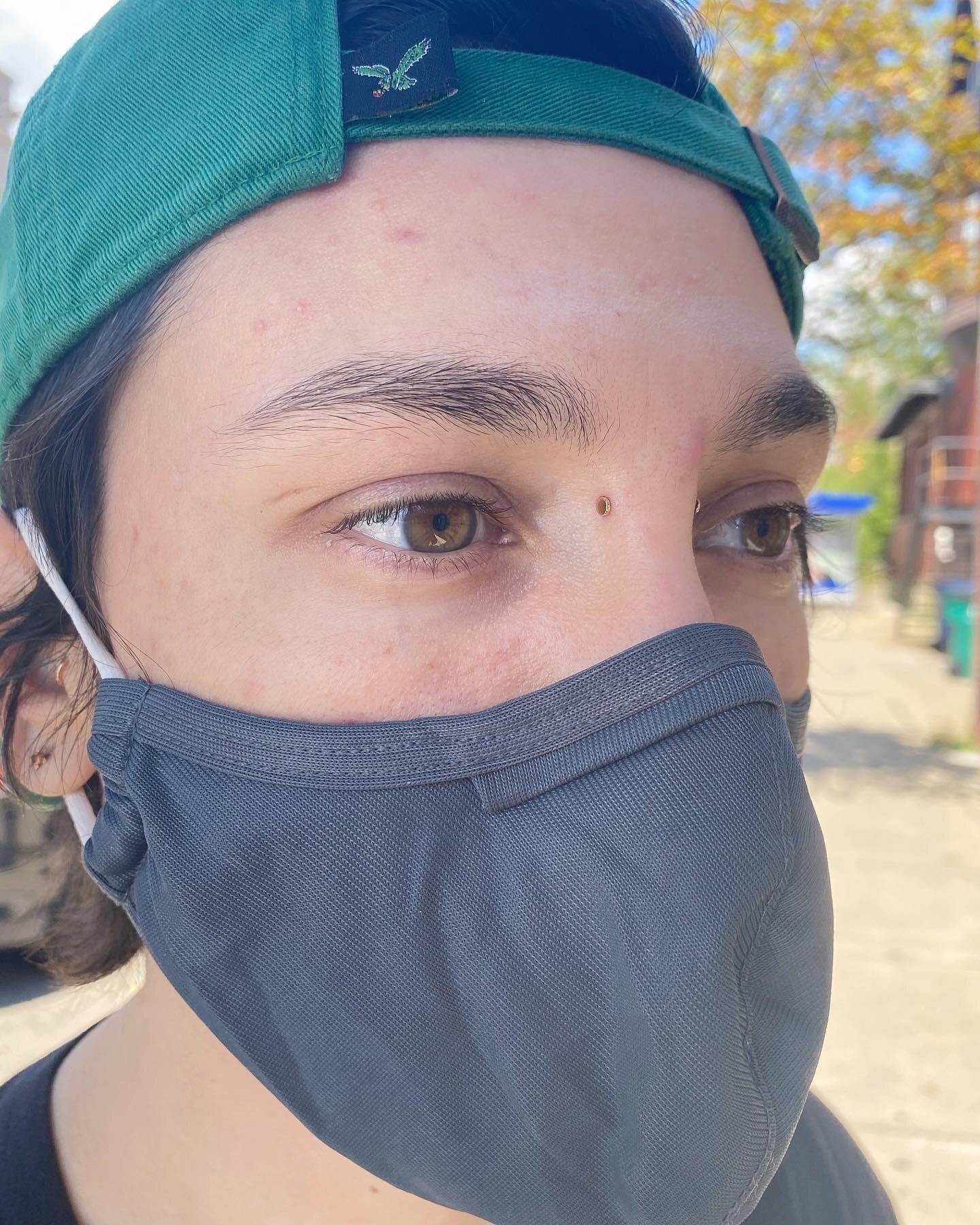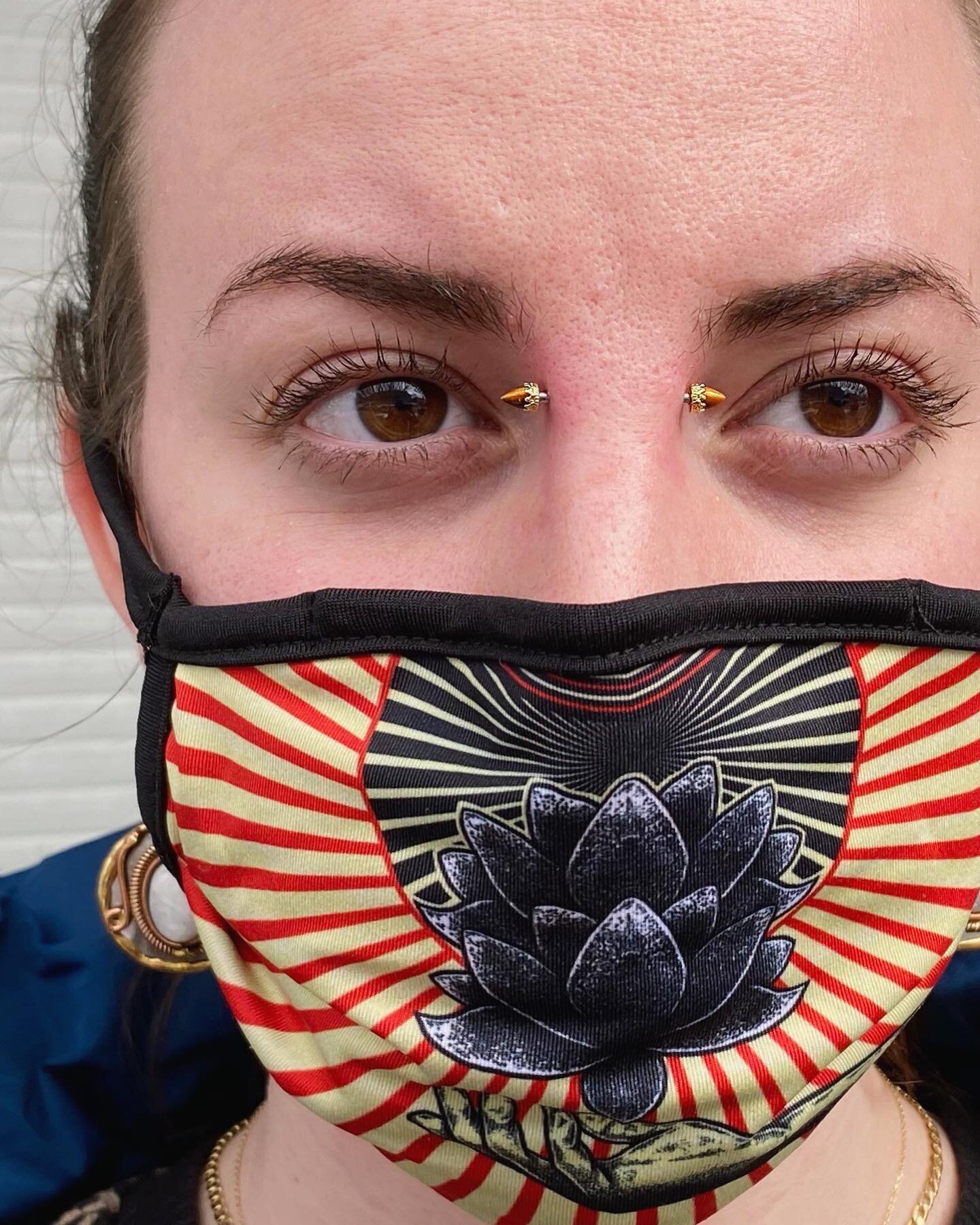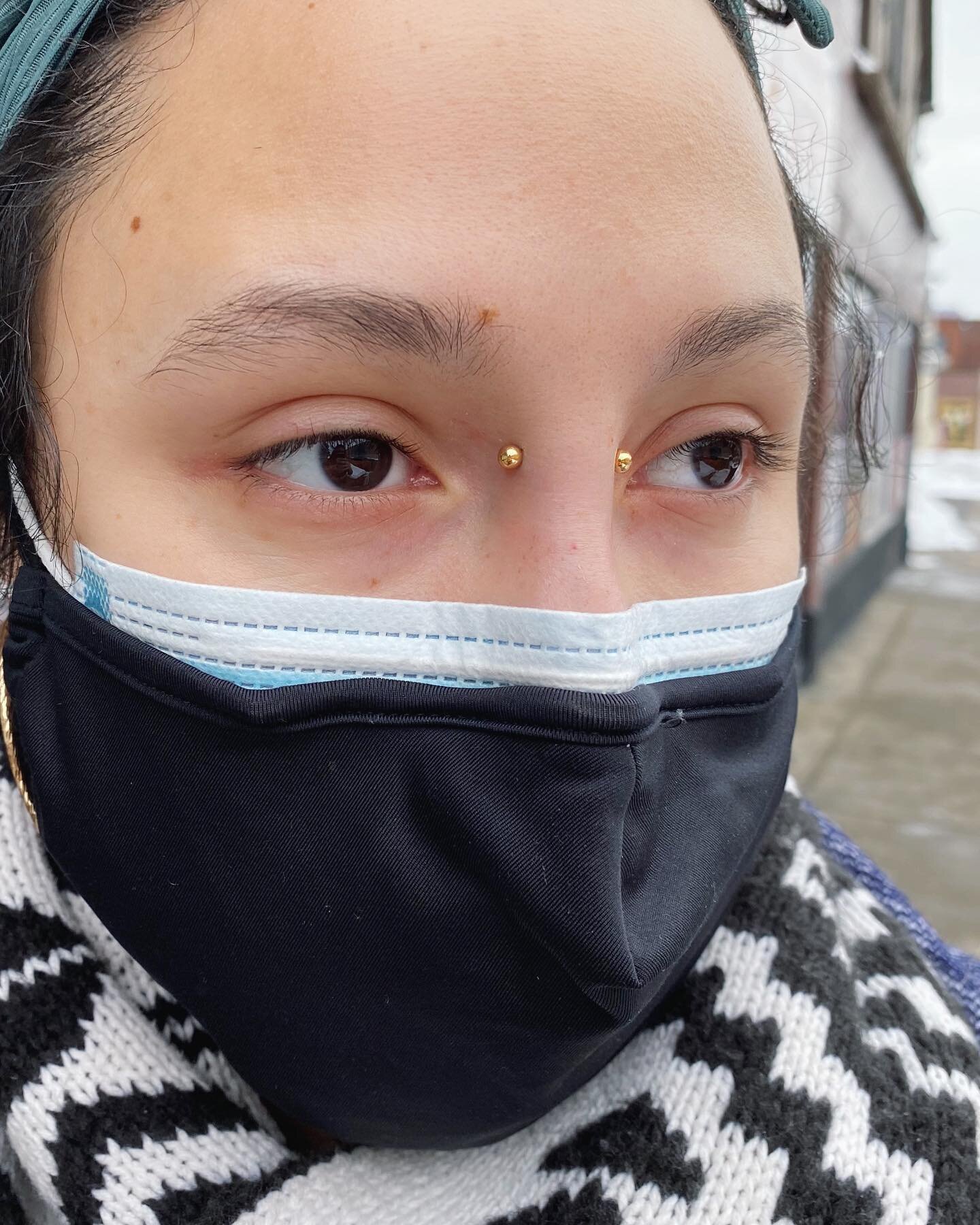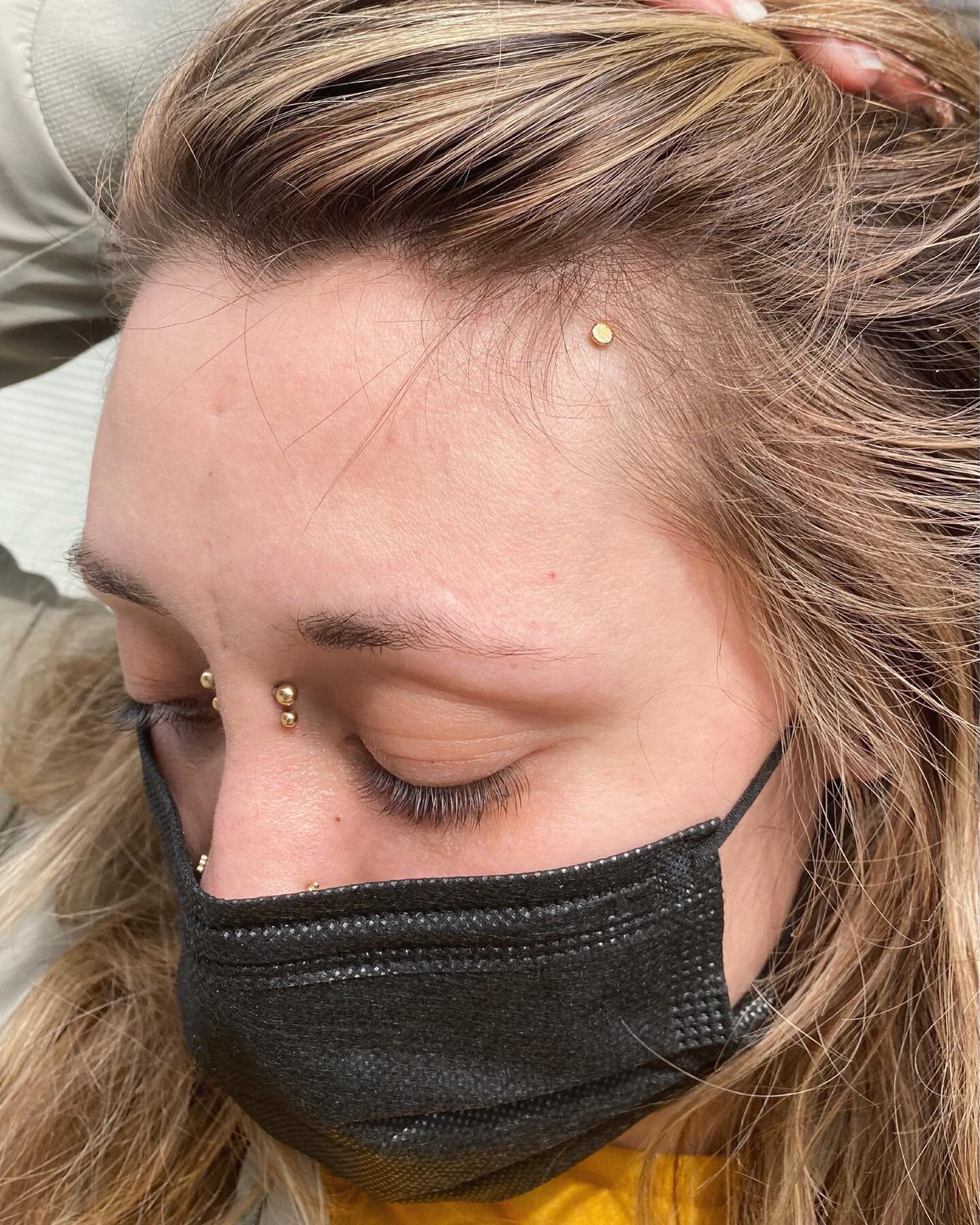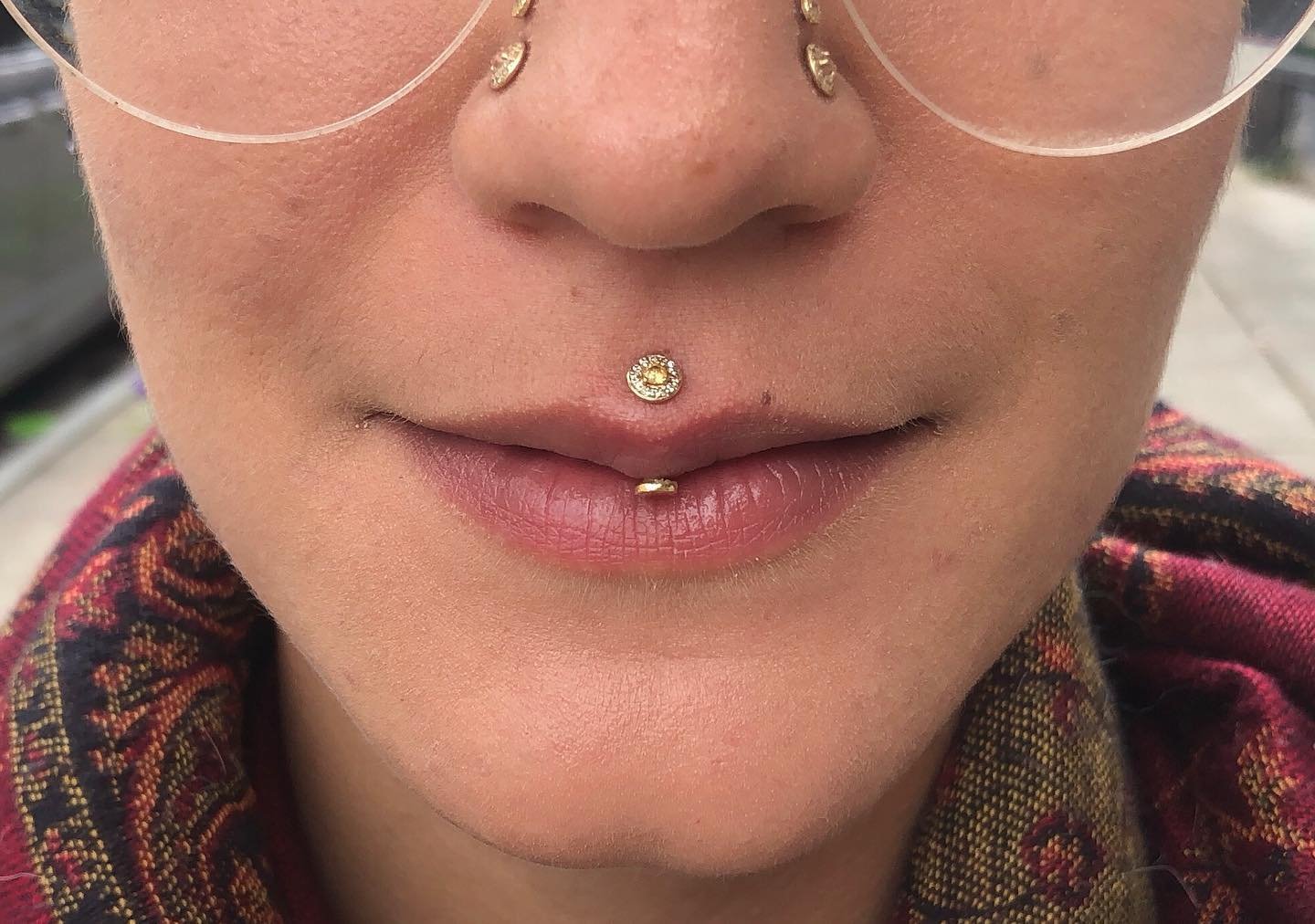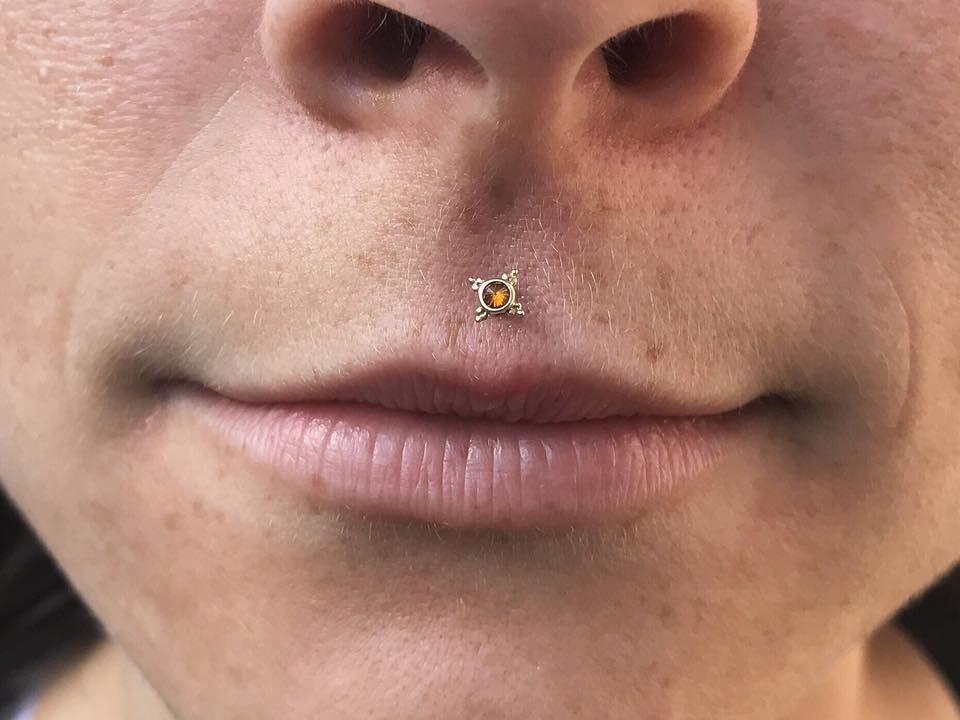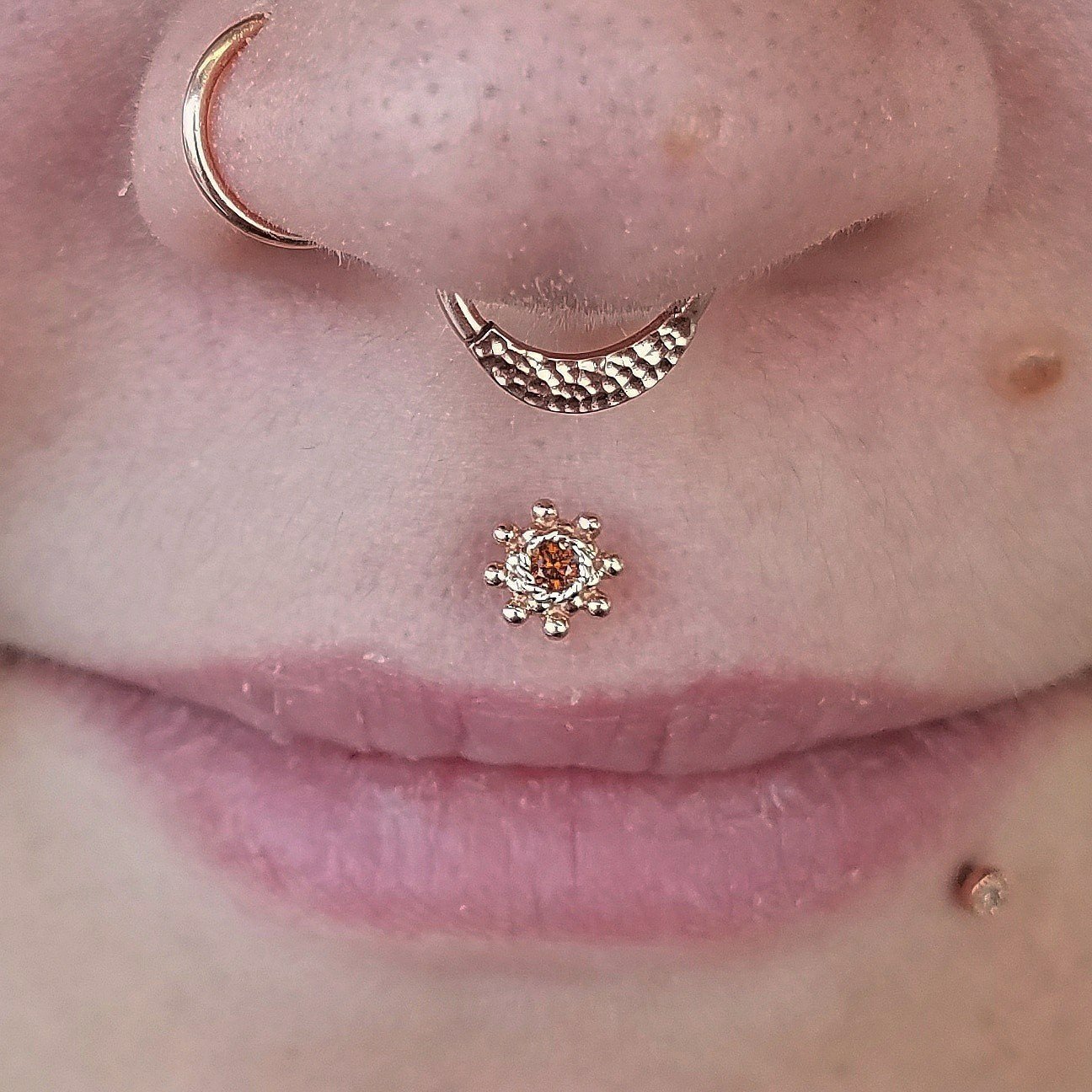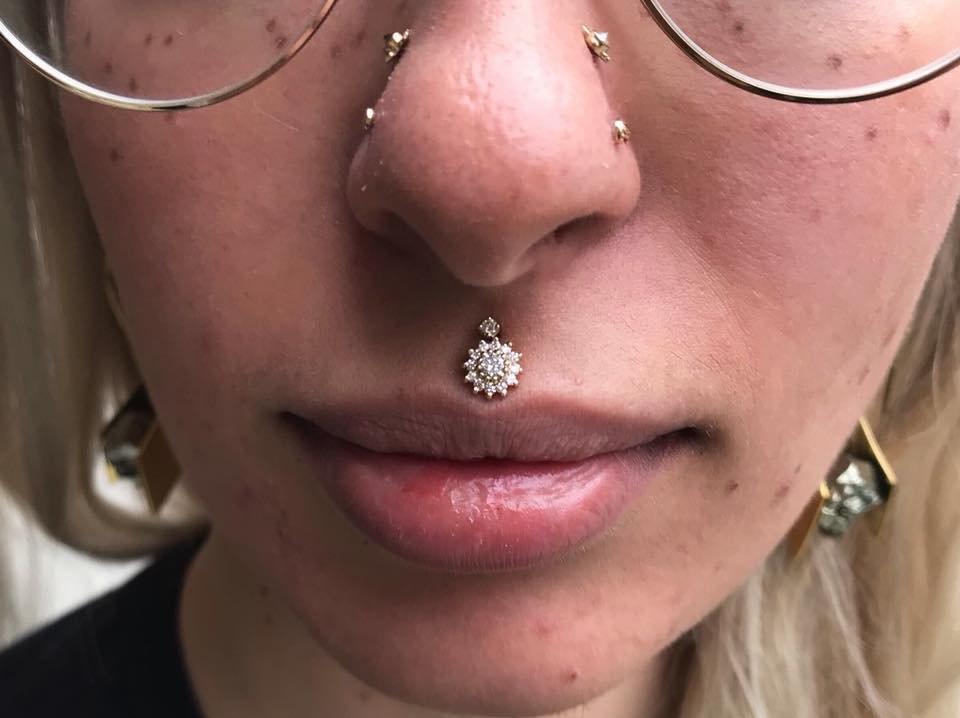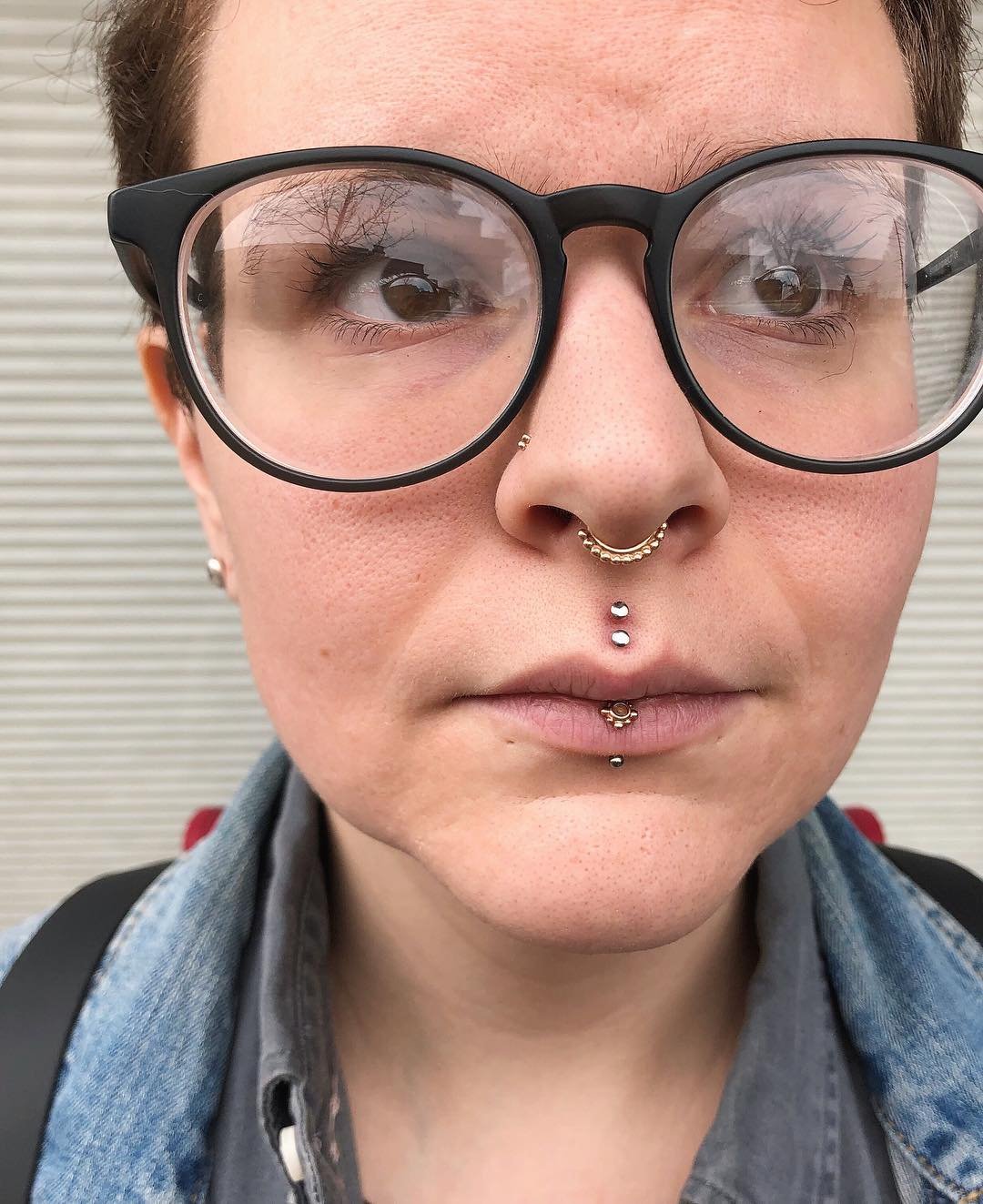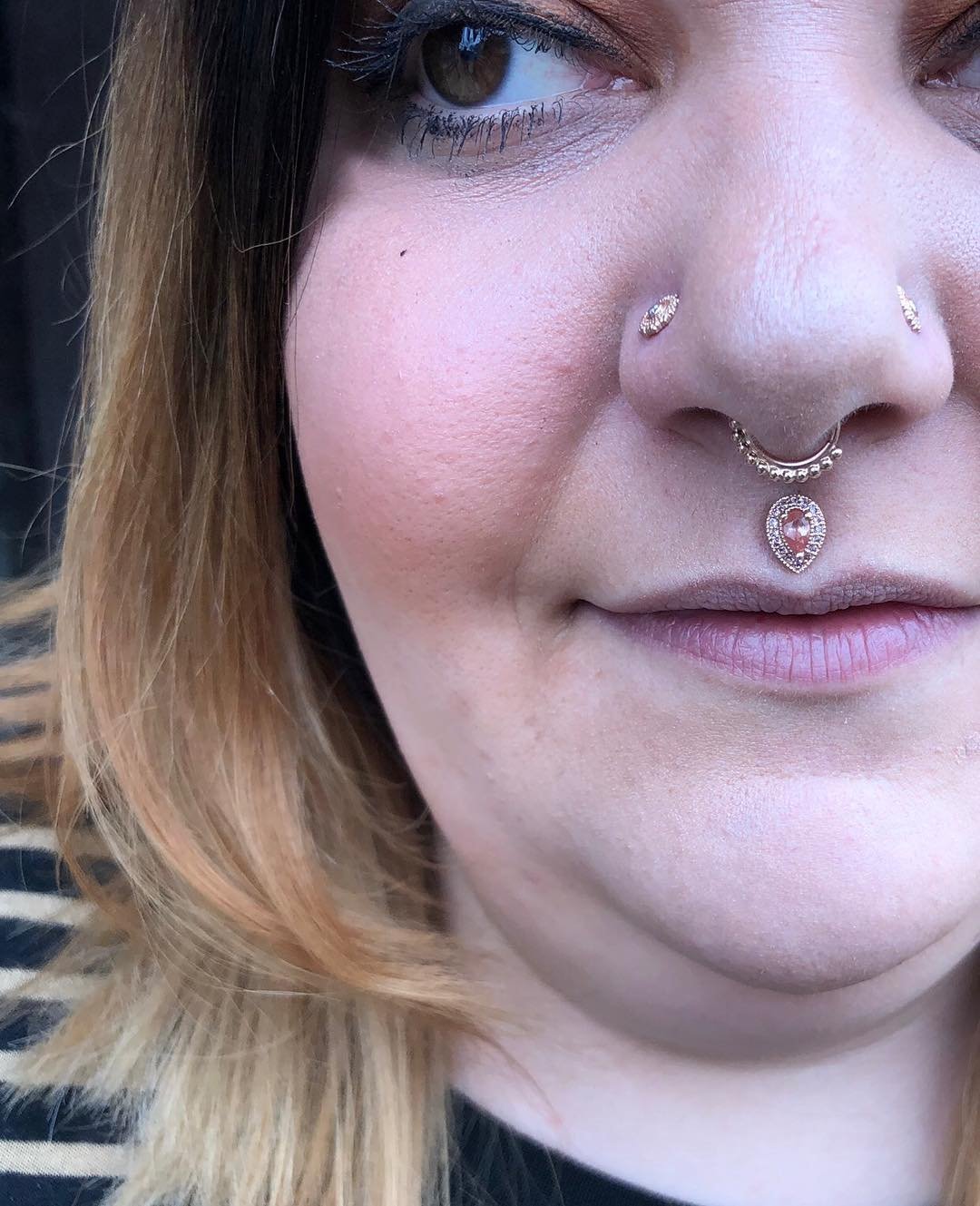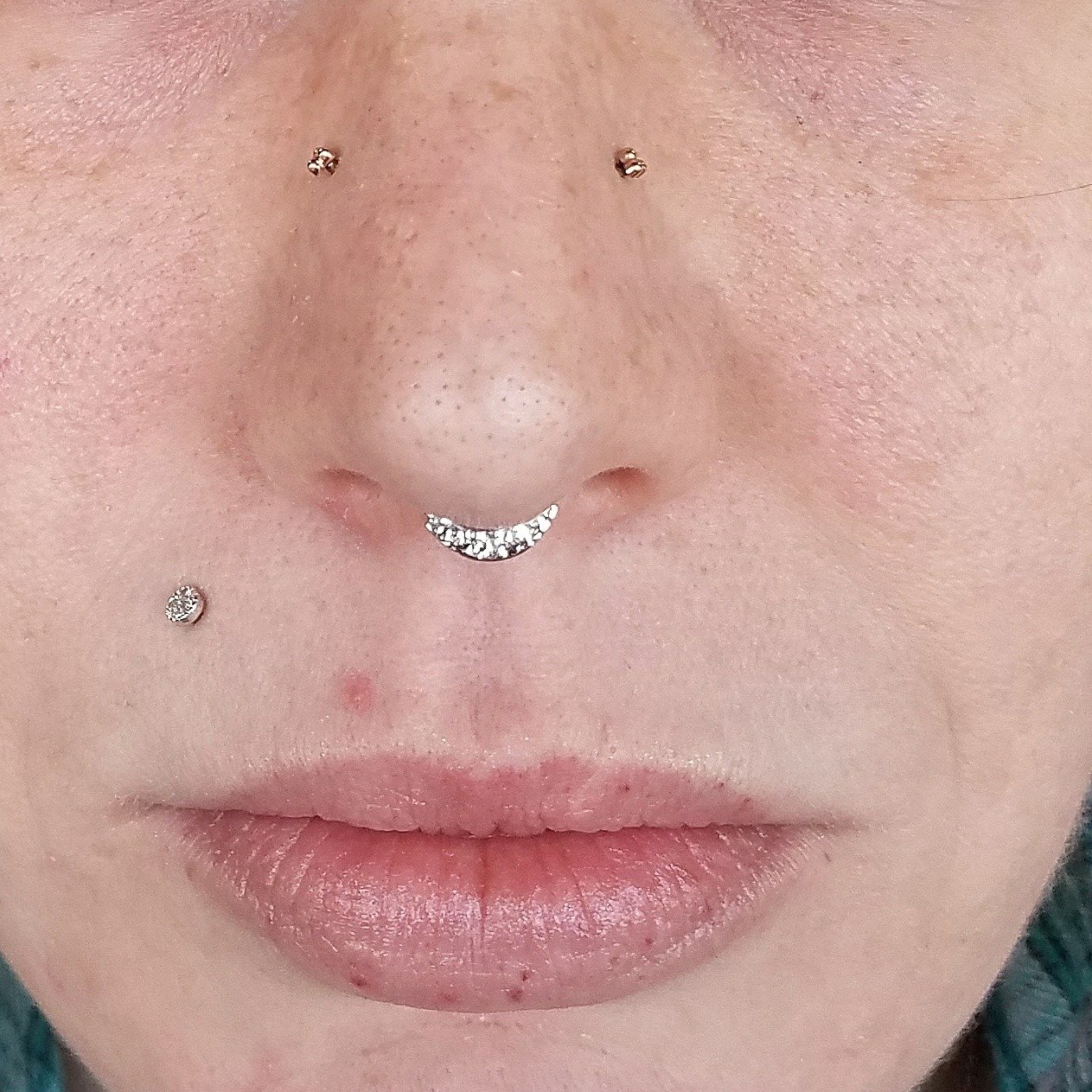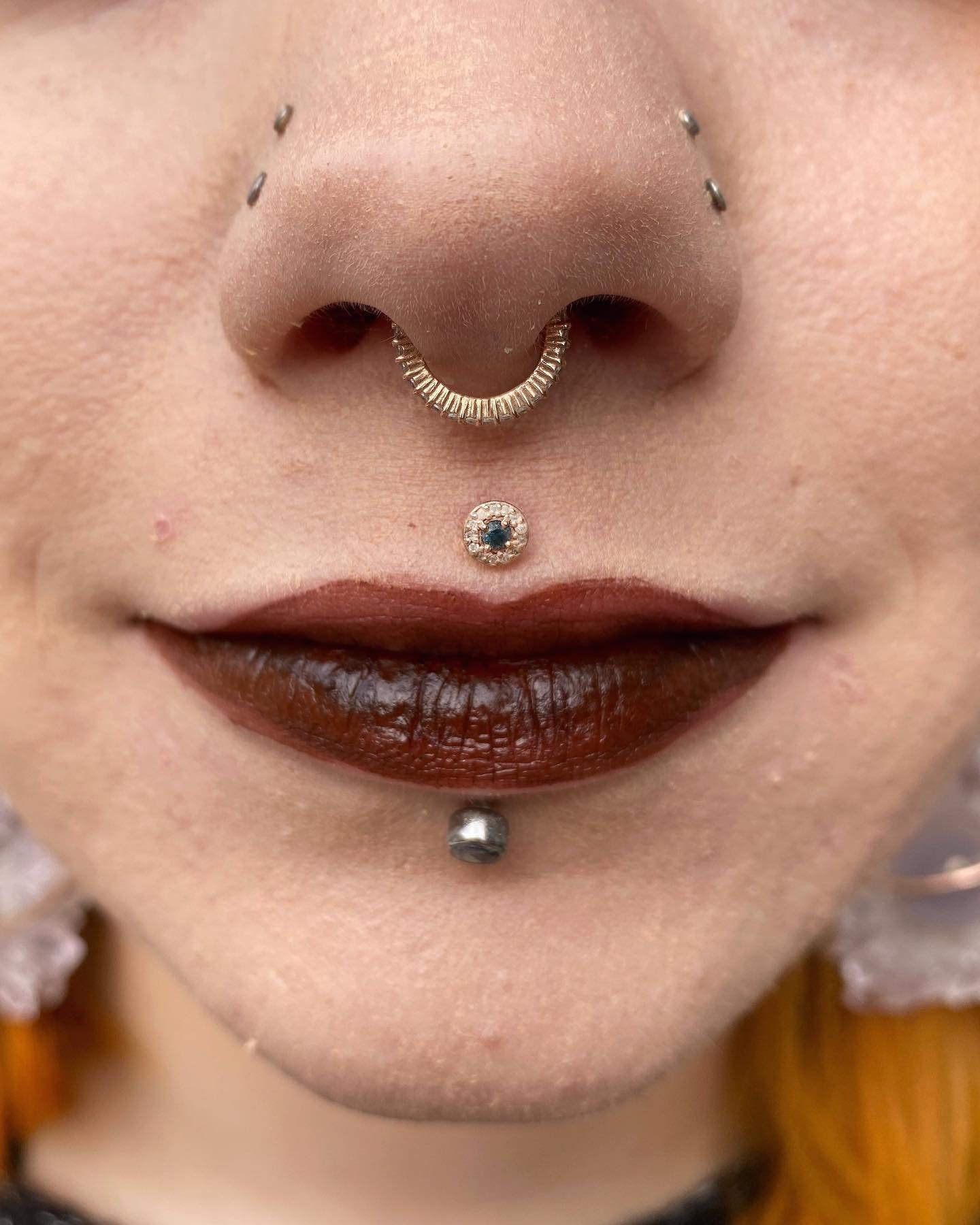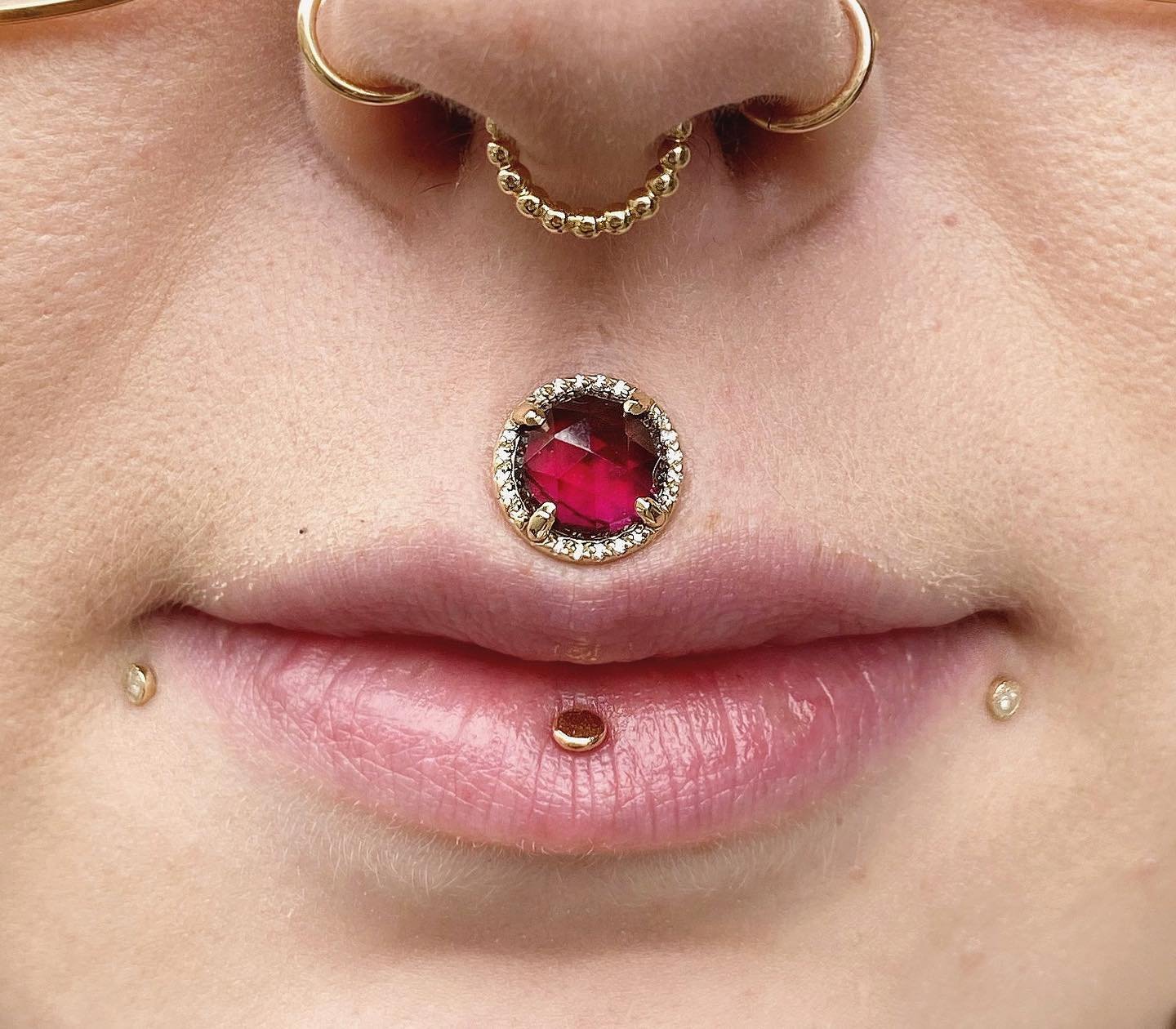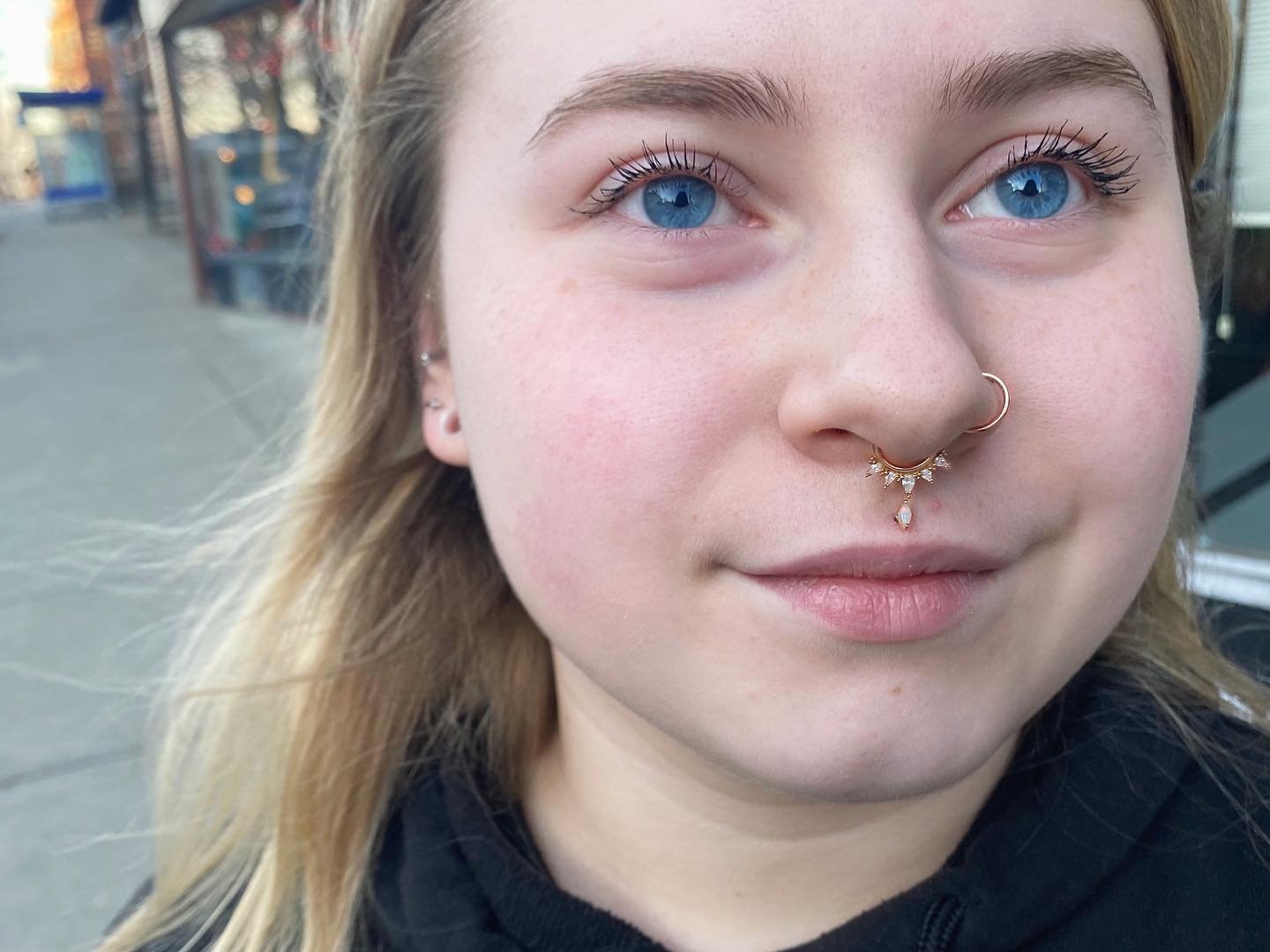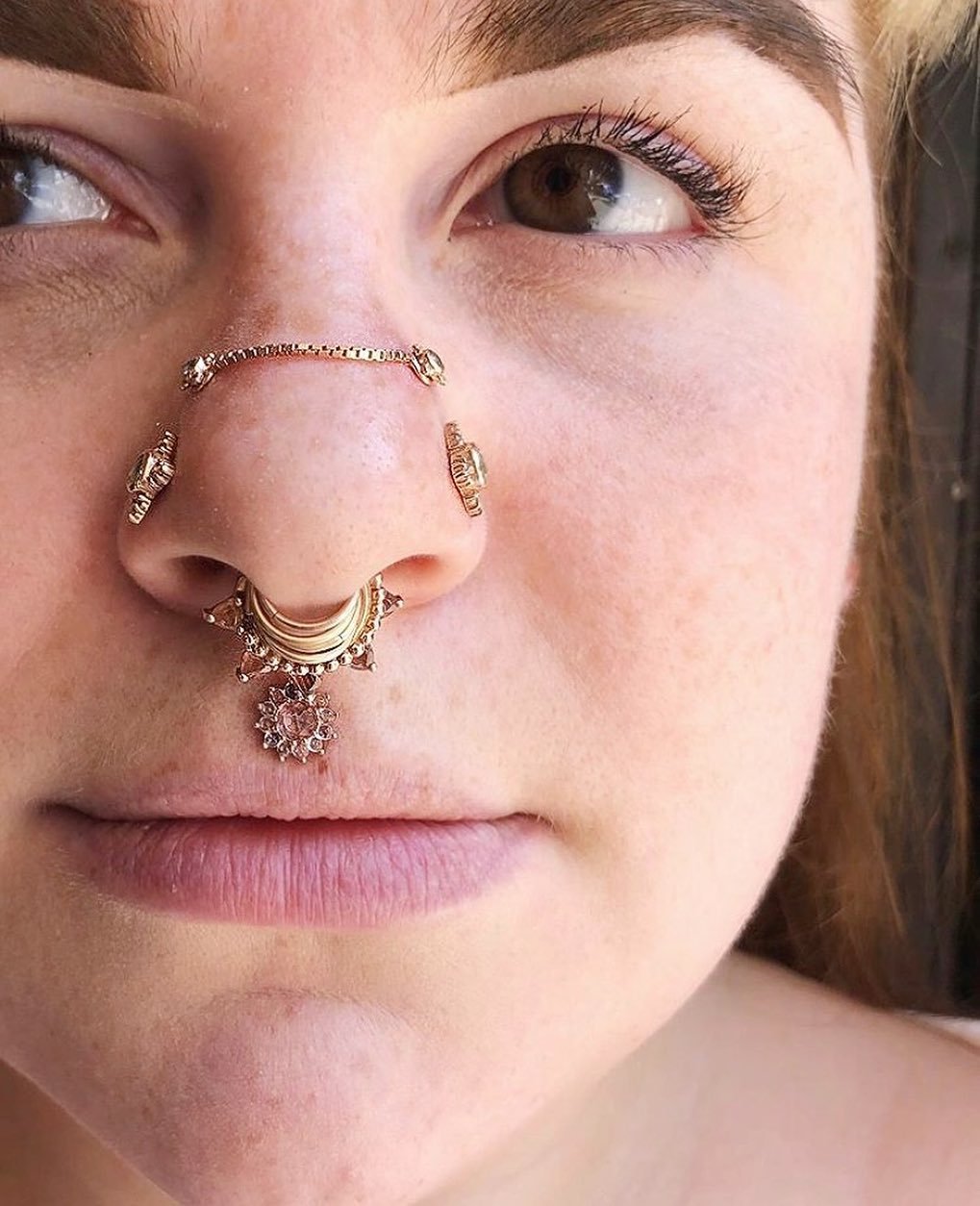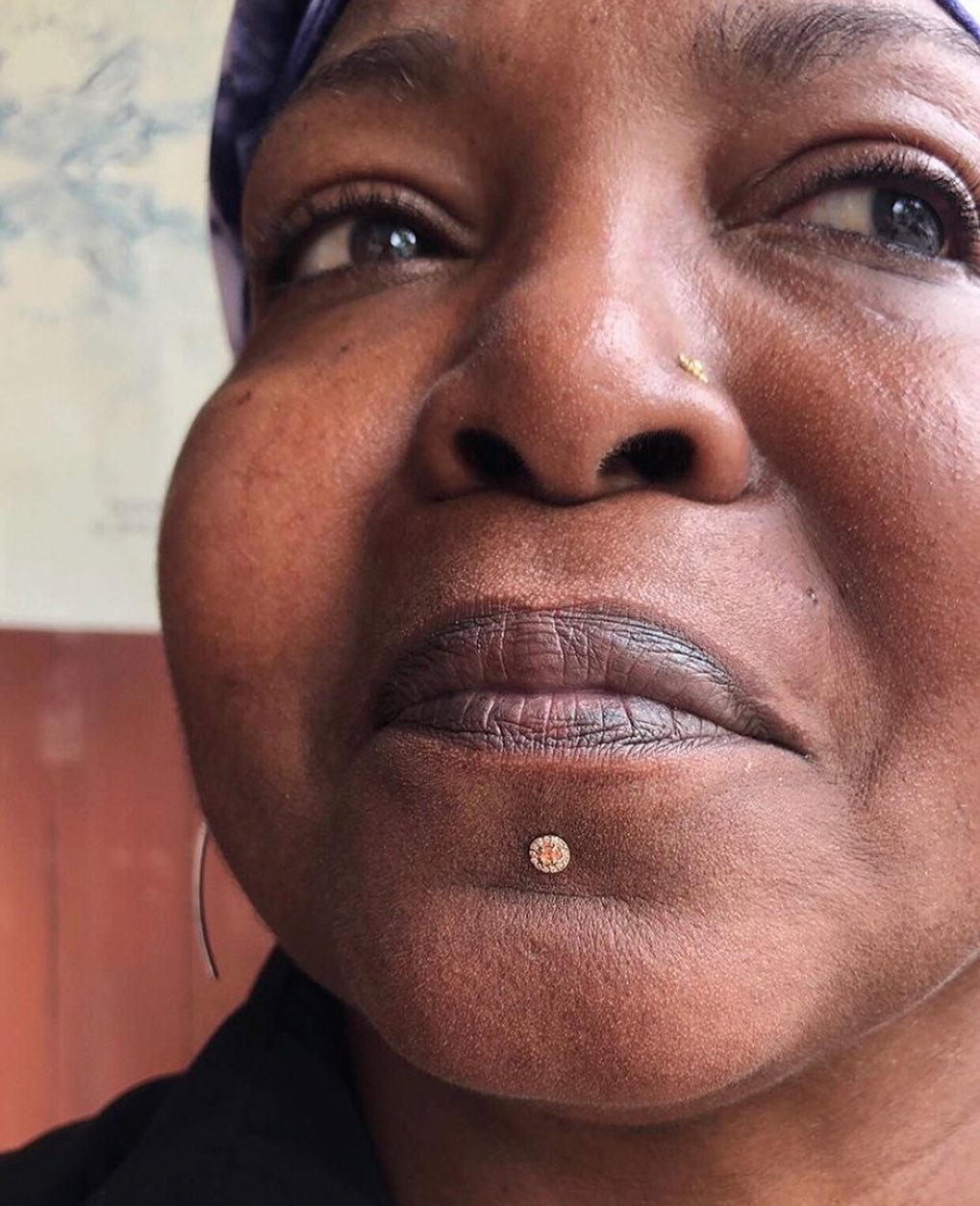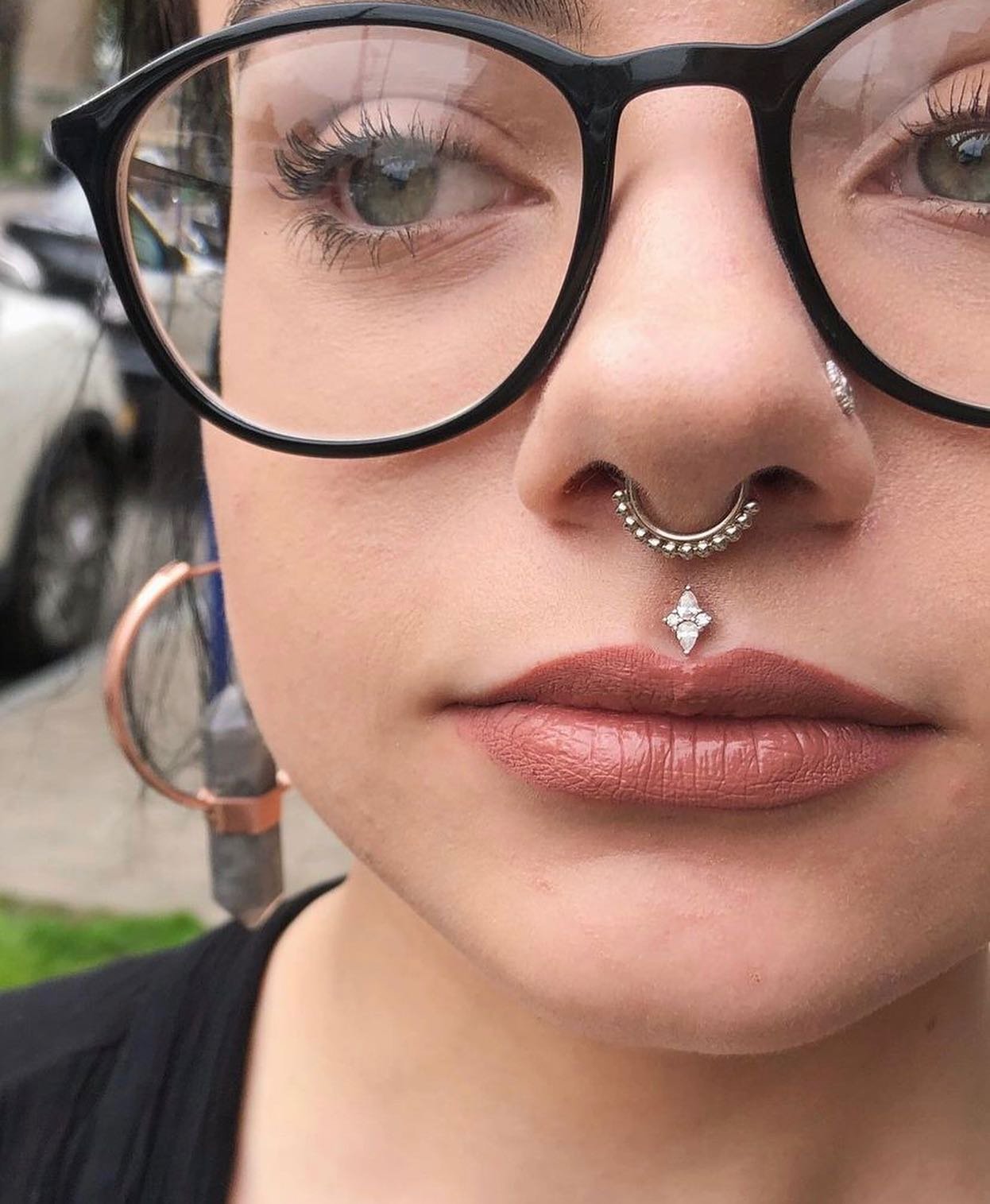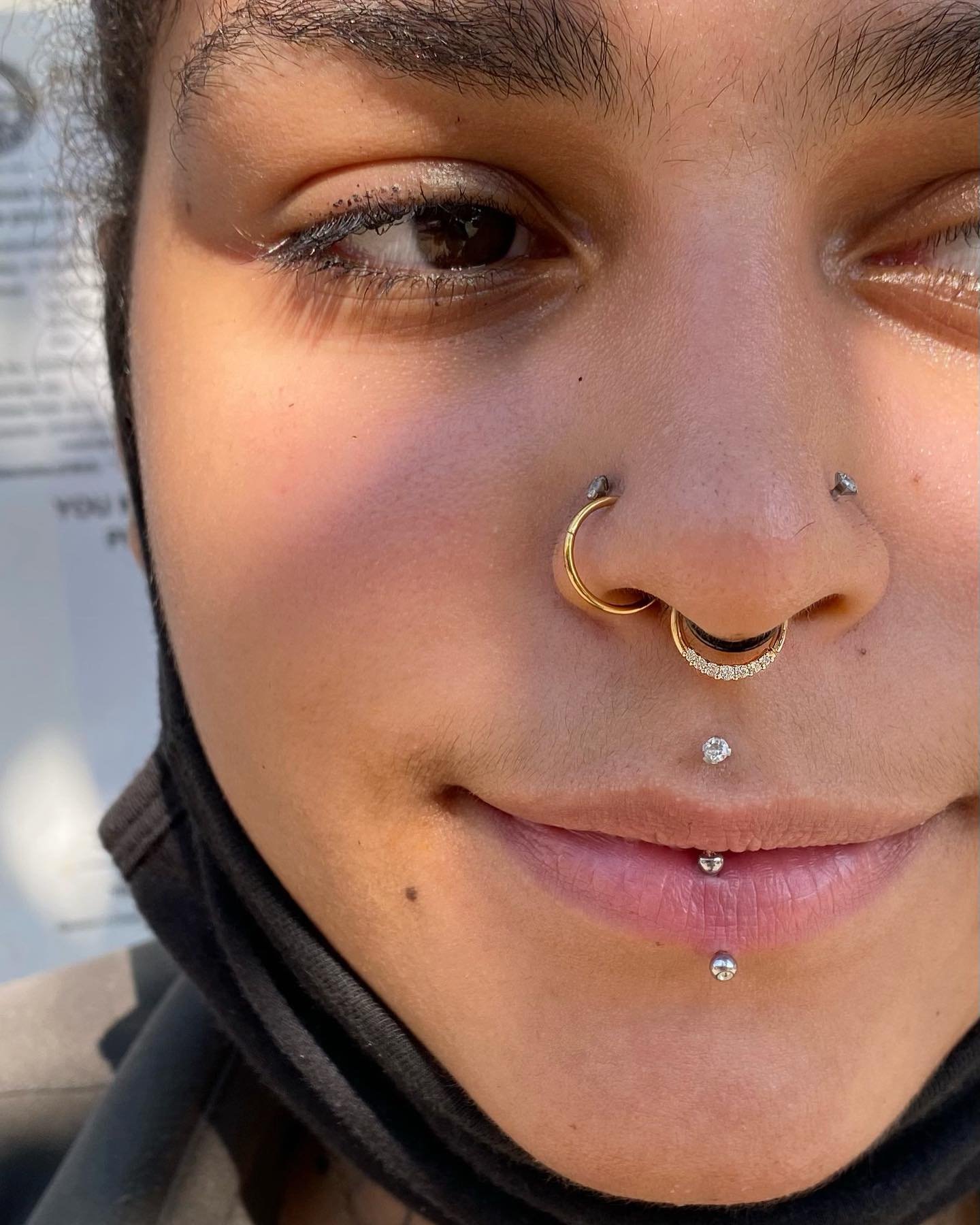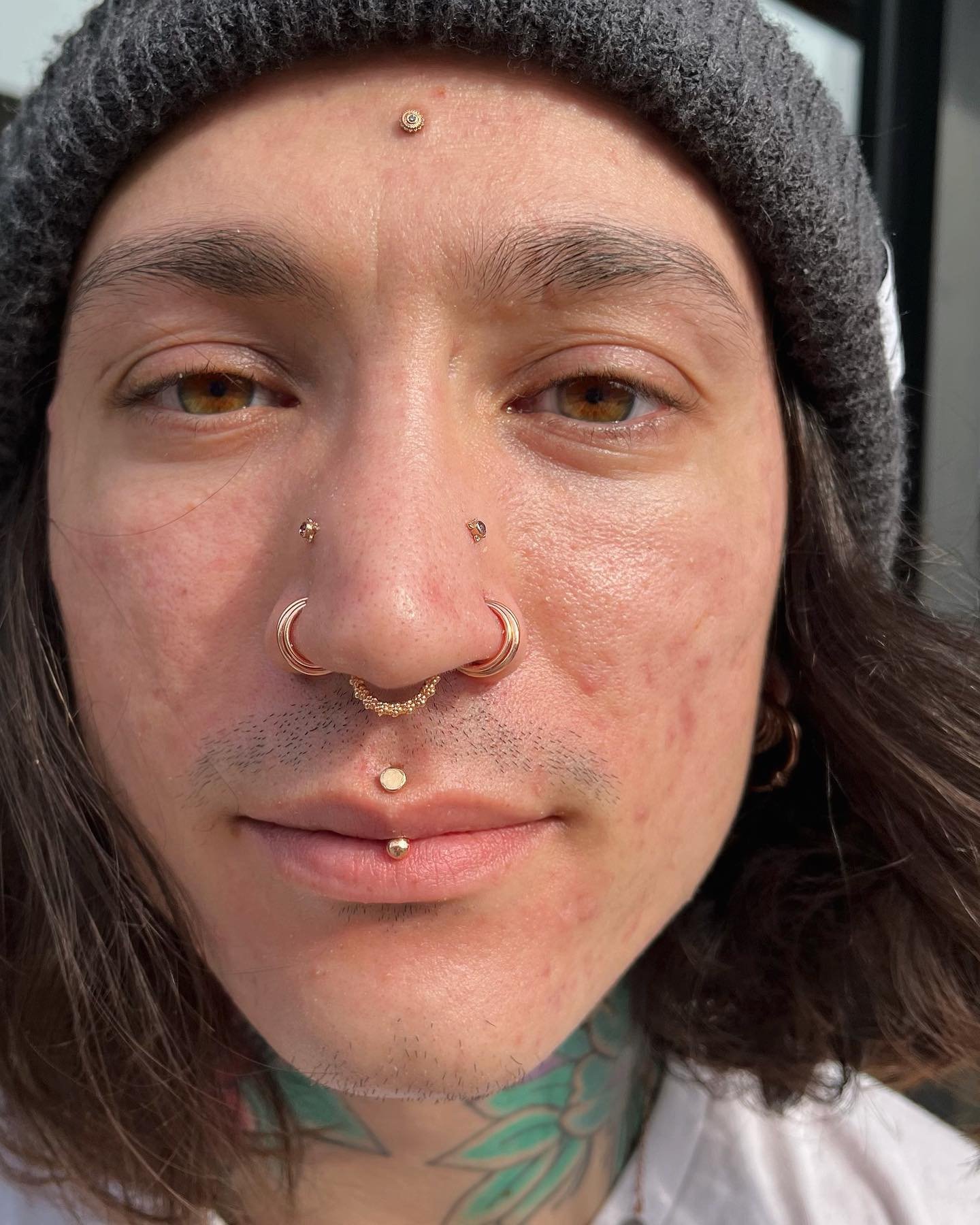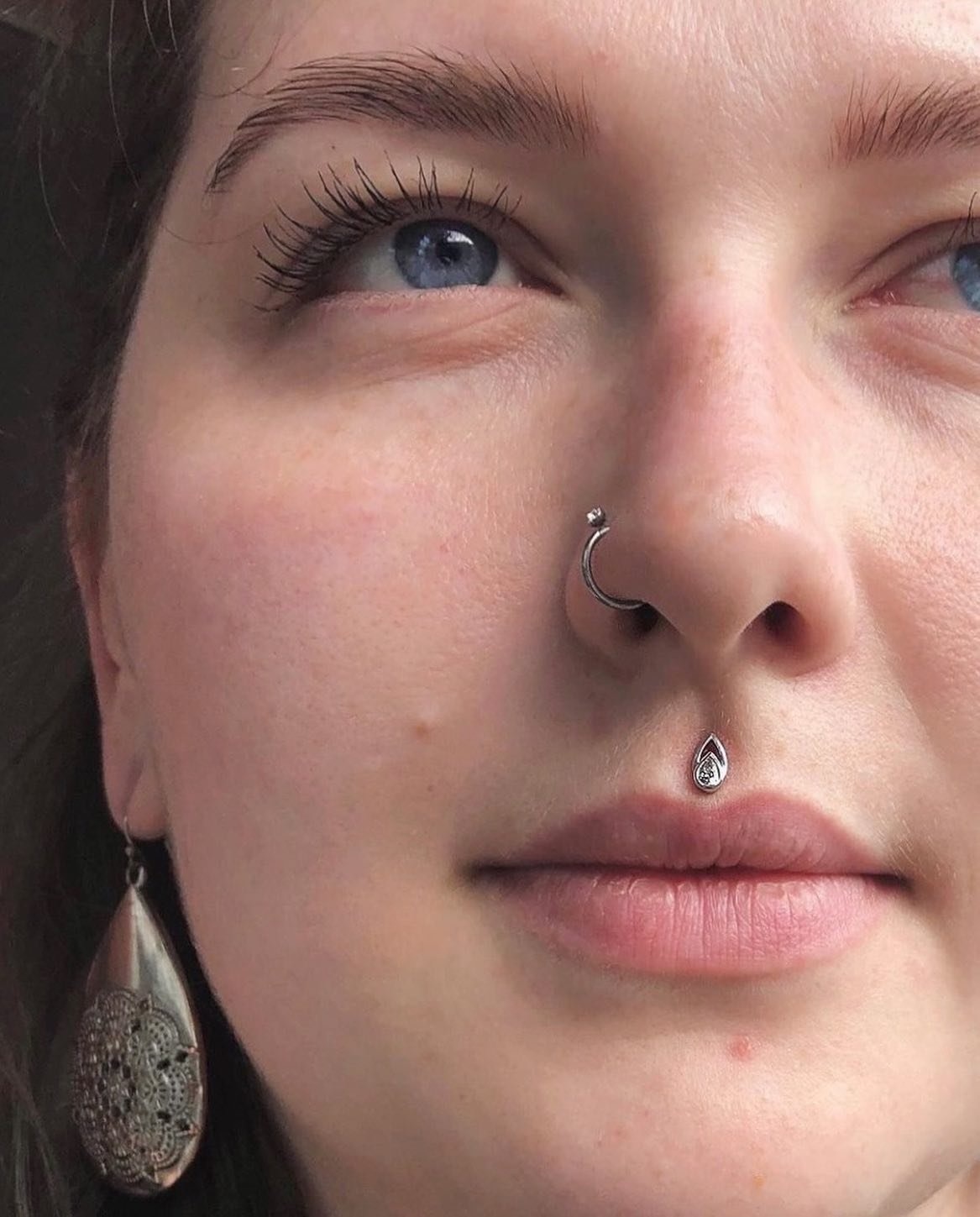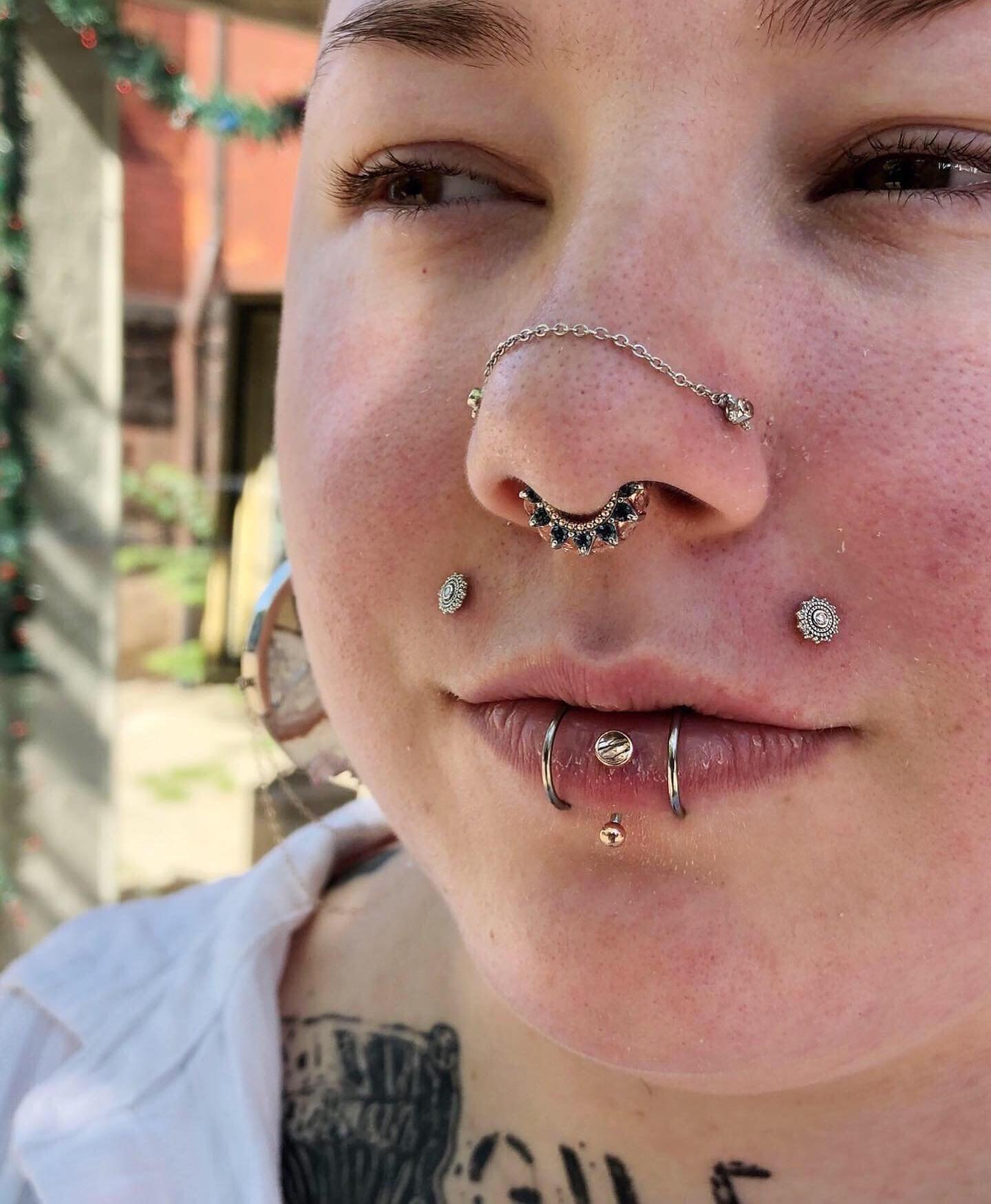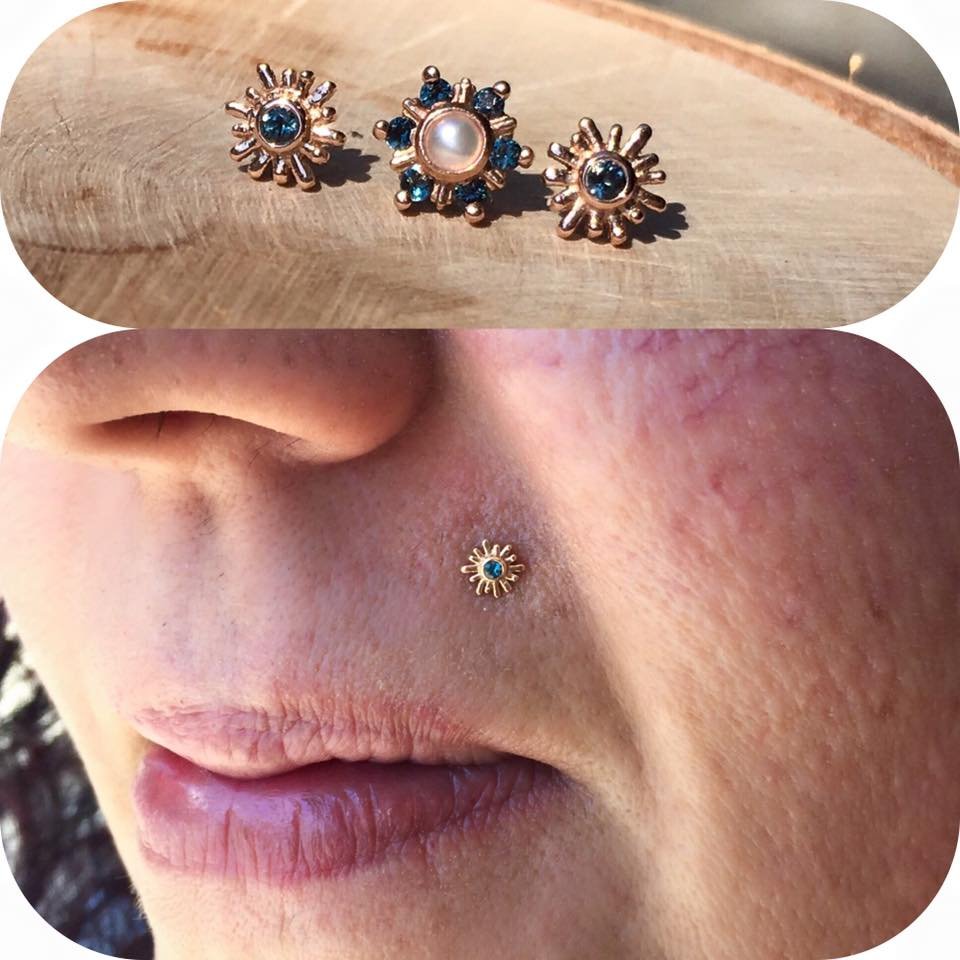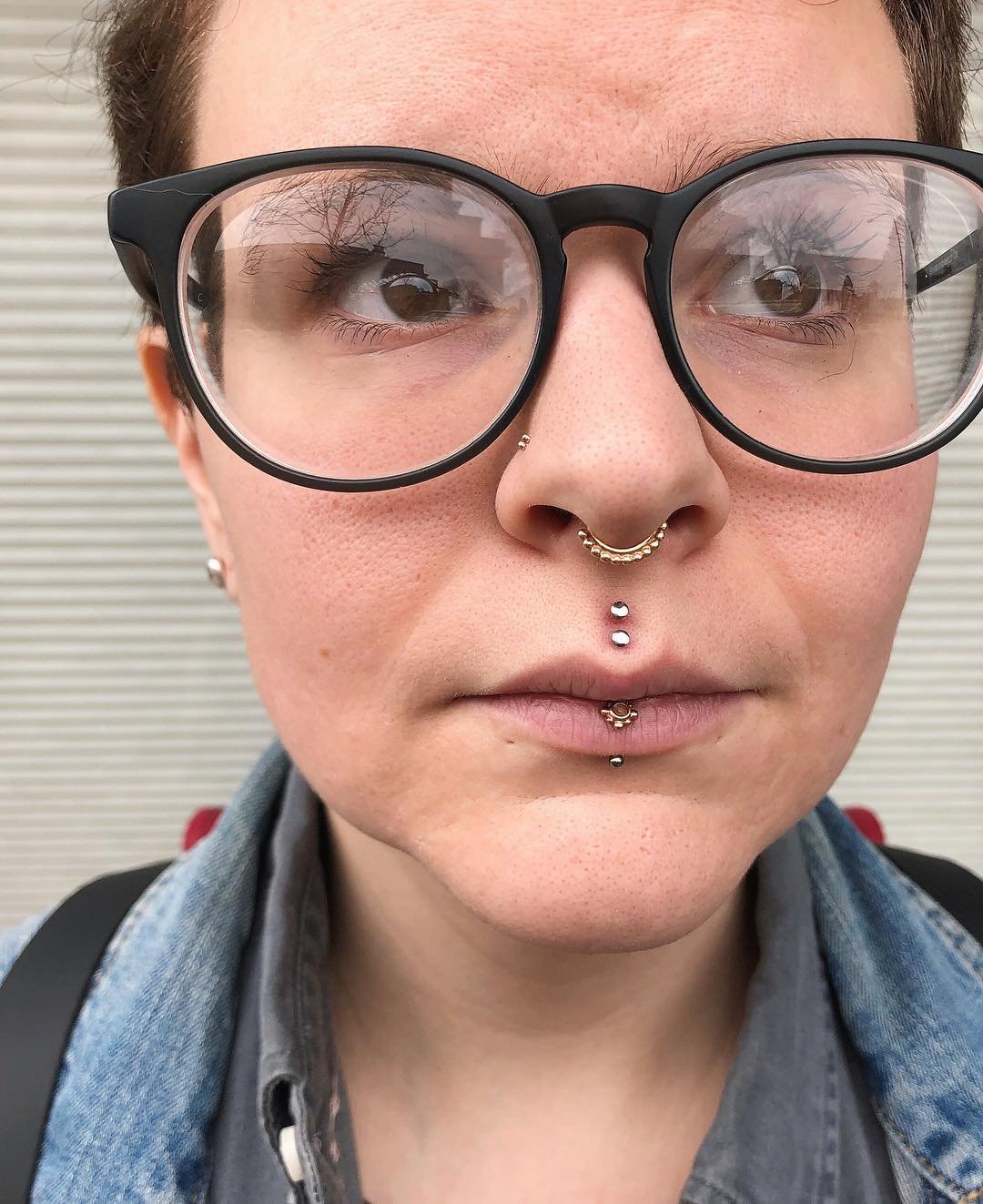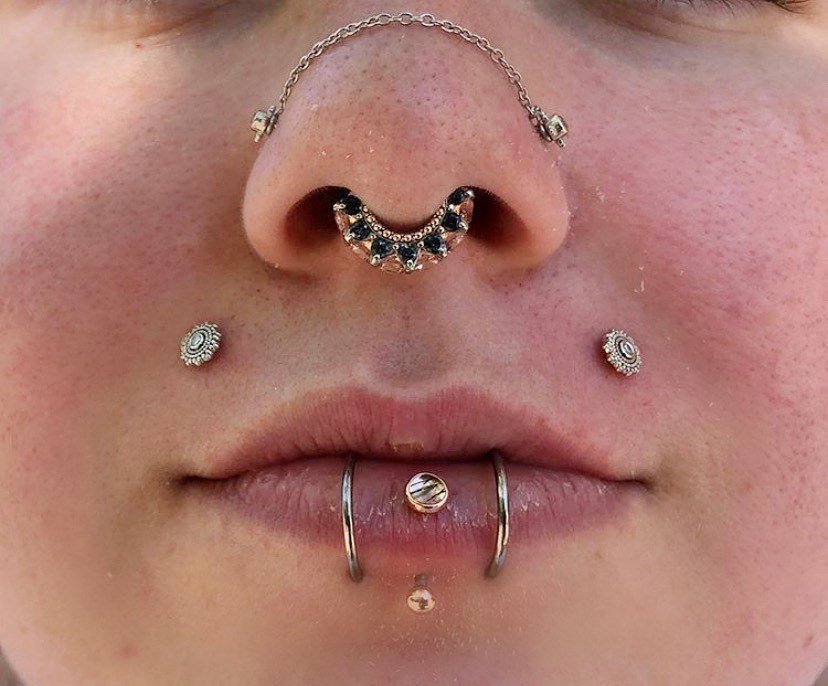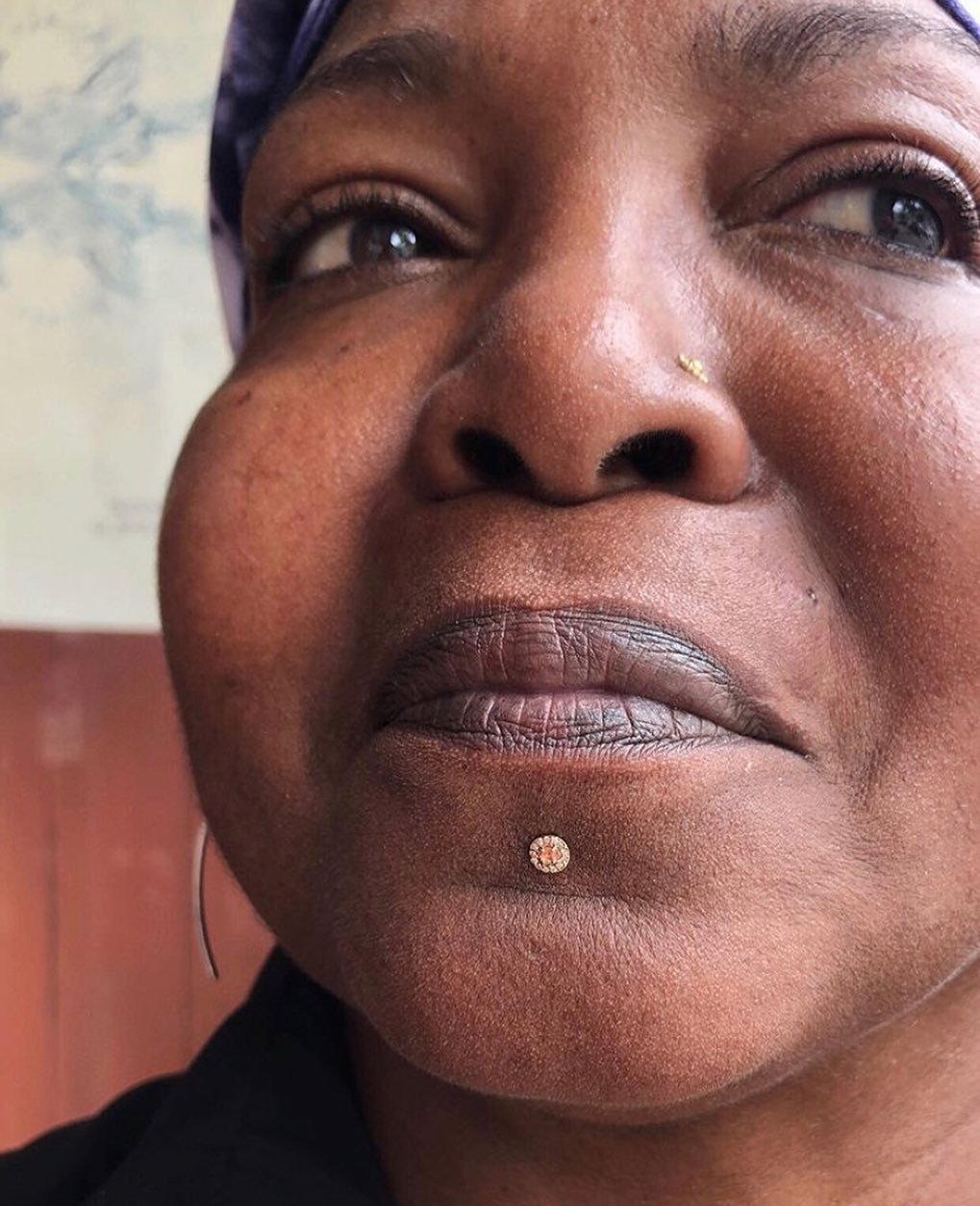Piercings We Offer
Have you ever wanted a new piercing, but felt overwhelmed by your options and unsure of what to get? We’re here to help! On this page we’ll be breaking down your options for you along with tons of photos for inspiration and some important information we think you should know about them before booking your appointment. Click on any of the buttons below to be taken right to what you’re interested in, or scroll through all of your options!
Ear Piercings
Body & Facial piercings
Oral Piercings
Genital Piercings
Our nipple and genital portfolio is on a separate, password protected page located below. Please read the disclaimer on the landing page for the password.
Helix
Helix piercings are one of the most common ear piercings, second only to lobes, and actually covers quite a variety of different placements! We consider the helix the entire outer “C” shape of the ear, including what we call the flat; a larger, flatter area above the conch that’s great for big statement pieces.
Ideal placement will vary from person to person depending on your anatomy; some people have a more predominant curl on the outside that would hide a stud and are more suited for flat piercings or rings on the outer helix, and some people don’t have much of a flat spot and would do better putting that statement piece on the outer helix instead.
Both studs and rings are commonly worn on the outer helix, however keep in mind that we strongly recommend starting with a stud for initial healing and then transitioning to a ring after about a year for easiest healing.
These are a great fit for most people, just be careful not to snag them on your mask or hair!
Forward Helix
The forward helix is the ridge of the ear closest to your face, right above the cute little tragus. These are commonly done in pairs and triplets, but the number your ear can support safely depends on your anatomy! The little shelf behind your forward helix (where we would place a rook) doesn’t allow for a ton of room in the back, meaning we generally have to try to avoid piercing directly in front of that area in order to ensure a successful healing period. You’ll notice most forward helix piercings are placed either slightly above or slightly below that ridge, and if you don’t have a ton of room there to begin with, three piercings will probably look a little too cramped. Not to worry though, your jewelry options for forward helix piercings are nearly limitless, and you can always fill the space with a longer or arched piece in a single piercing for a similar look.
Glasses wearers can sometimes have a little bit more trouble healing these guys due to the placement, so if you wear glasses make sure you bring them to your appointment so your piercer can see how they sit on your ear and see if this may be an issue for you.
Conch
Conch piercings are one of our personal favorites because of how versatile the jewelry options are for them! There is typically a ton of space and they’re not as easy to get caught on things, allowing for both large and dainty pieces to fit comfortably on most ears. Both studs and rings will be an option once fully healed, but again, we recommend starting with a stud and transitioning to a ring once healed to increase your chances of a successful healing process.
Due to close proximity, we usually don’t recommend trying to fit a conch and a daith on one ear, at least for the initial healing process, but otherwise these are an excellent fit for almost everyone!
Fun fact: No type of jewelry makes a conch into an orbital. Conch piercings with rings are commonly mislabeled as such online, but orbitals are actually a completely different piercing that are much more rare! We’ll get into that more later.
Daith
Daith piercings are excellent centrally placed piercings that beautifully fill up the bowl of the ear, and they’re one of the only piercings that are best pierced with a ring.
The most common misconception about daith piercings is that they can cure migraines. Unfortunately there is no scientific evidence to back this up, most acupuncturists agree that piercing a potential pressure point would be unlikely to cause permanent relief, and the American Migraine Foundation does not recommend it as a treatment strategy, believing the reported positive results to be temporary and caused by the placebo effect.
In short, no, we don’t have the miracle cure, as much as we wish we did, but we do have the ability to give you a gorgeous piercing with some stunning jewelry in it.
Daith piercings are not ideal for people who regularly need to wear stethoscopes, hearing aids, ear plugs, or other in-ear devices.
Tragus
Tragus piercings are placed close to the face on the little “nub” right below the forward helix. This part of the ear comes in all shapes and sizes, so while it’s common to see a single piercing with tiny jewelry, sometimes it’s possible to fit two or even three piercings on one tragus! You can wear either studs or tiny rings once fully healed.
These are also not ideal for people who need to wear stethoscopes, hearing aids, ear plugs, or other in-ear devices regularly.
Lobe
Earlobe piercings are the classic piercing, and the most common piercing that we offer here. We offer earlobe piercings for anyone six years old and up as a safe alternative to being pierced with a gun.
When earlobe piercings are done with guns or in very early childhood, it frequently results in teens and adults with sensitive, uneven, or torn earlobe piercings coming to us for help. While we can’t change the original placement of the piercings or fix the sensitivity caused by years of wearing low quality jewelry, we absolutely love helping you transform them with unique, implant grade jewelry and stacking piercings above or around them to completely change the look and relieve the itchy, uncomfortable feeling you may experience wearing lower quality jewelry.
Because of the soft tissue, earlobe piercings heal more quickly than other ear piercings, just be sure to keep the backs dry as excess moisture from not drying thoroughly or letting damp hair sit on them can give you some troubles during healing.
Rook & Faux Rook
Rook piercings are located on the ridge behind the forward helix and can either be pierced vertically, which is what you see most commonly with a curved barbell in it where the top and bottom of the jewelry are both visible from the front, or alternatively they can be done as a “faux rook”, which is when the piercing goes straight out the back of the ear like you would see with a regular helix piercing. This is nice for large jewelry that may be uncomfortable or sit at an odd angle with the traditional method, if you already have a daith piercing that may get in the way, or even if you just don’t really care for the look of seeing the post at the bottom. Both options take the same amount of time to heal and are placed in the same spot, it’s just personal preference!
These are great for most people and you’ll also have the option of wearing rings once fully healed.
Industrial
Industrials are always epic. They can be cool, they can be elegant, they can be edgy, and everything in between, but unfortunately we have to turn down a fair number of ears for them. There are a lot of anatomy-related factors that come into consideration when piercing industrials, and they are only suited to very specific anatomy. Primarily what we’re looking for is a well-defined curl on both the outer helix and the forward helix with plenty of tissue to support both sides, and we also make sure the flat of the ear doesn’t stick out further than the barbell would sit once pierced. If any part of that equation doesn’t describe your ear, unfortunately your chances of successfully healing an industrial are incredibly low, because some part of your new piercing will be putting a large amount of pressure on your ear.
The best way for you to know for sure if you’re a candidate is to set up an appointment for one and one of our piercers will let you know what your options are! We’ll never advise you to move forward with a piercing that your anatomy isn’t going to support. Consider coming to your appointment with a backup plan in case that doesn’t pan out but you still want to get something done. Glasses wearers, be sure to wear your glasses to your appointment as well so we can make sure those aren’t going to be in the way.
Orbital
In our conch section we talked a little bit about how conch piercings with rings are commonly mislabeled as orbitals, but the real deal is actually pretty rare! Orbitals describe two separate piercing channels with one single ring connecting them. These are commonly done in earlobe piercings, however can be done in a number of locations all over the ear depending on anatomy.
Sometimes the spacing and angles of two existing piercings will work out to support a ring comfortably even if they weren’t intended to be an orbital piercing when pierced, but those angles and spacing are crucial, so if this is the look you want, it’s always best to have the pair pierced specifically for an orbital.
Snug & Faux Snug
Snug piercings are the only piercing that we offer that we always try to talk people out of getting. They’re a viable piercing long term and not in any way dangerous, so they aren’t completely out of the question (they are very anatomy specific), but they are notoriously one of the most difficult piercings to heal out there. It can take years to fully heal even on the most suitable anatomy, and it tends to be extremely painful during that entire healing process. If it sounds like a nightmare, that’s because it honestly kind of is.
All of the photos you see here feature faux snugs, which are actually a conch and a helix piercing positioned to give the illusion of a snug piercing. These are much easier to heal and have fewer anatomy requirements, making them the perfect alternative to a traditional snug.
Navel
Much like industrial piercings, navel piercings are an anatomy specific piercing that we have to turn down pretty regularly. This decision has absolutely nothing to do with size or weight and has everything to do with the anatomy you were born with and always will have, whether you lost or gained weight. Most important is whether or not your navel has a well defined “shelf” or a ridge with enough tissue to comfortably support the piercing long term without needing to pinch the tissue out, as well as whether or not you have a crease/fold directly through your navel when you slouch or bend over. A standard navel piercing isn’t a great option if you don’t have a defined shelf or if you do bend through the middle, but a floating navel (pictured on the left, with a flat disk on the bottom instead of a decorative gem or ball) or surface anchors may still be an option for you! It always breaks our hearts to tell you that the piercing you want won’t work for you, but the last thing we want is to take your money and leave you with an unhappy piercing and unsightly scars when it eventually rejects.
Navel piercings are a summertime staple, but keep in mind that any fresh piercing should not be submerged in any open bodies of water for 8 weeks, so this can limit your beach, pool, and hot tubbing fun if that’s your jam during the warm months. Fall and winter are great times to get pierced so you’re ready for your pool party by the time Buffalo heats up.
Surface Anchors
Surface anchors are unique because they don’t have a visible exit point, they seem to simply disappear under the skin. They’re performed just like any other piercing, though, by creating a small hole in the skin with a needle and inserting jewelry, which in this case is a tiny, foot shaped anchor base. It has a long end and a short end (the heel), and is inserted the same way you would slip your foot into a shoe!
Anchors are considered semi-permanent piercings, meaning that unlike most piercings, eventually we fully expect them to reject. This could take anywhere between a few months to a few years, and happens the same way your body pushes splinters out. The less it gets snagged or irritated, the longer it’ll last! You’ll also want to avoid high contact and high movement areas like wrists, hands, and feet, or any area that frequently comes into contact with tight clothing.
You may have heard these referred to as “dermals”, which is a slang term derived from the term “microdermal" piercing, generally considered an outdated name. The term dermal alone means anything related to the skin and out of context just doesn’t make a lot of sense.
Surface Bar
Surface bars are similar to surface anchors in that they’re considered to be semi-permanent piercings, though depending on placement they do have a chance of lasting a bit longer. Scarring also tends to be more severe than surface anchors, especially if not removed professionally early on when showing signs of rejection. You should only get surface bars in extremely low movement areas, nowhere that ever bends or wrinkles.
These always have two ends (where your decorative jewelry of choice goes) above the skin, anchored by one long, staple-shaped surface bar beneath the skin.
Nostril
After a year and a half hiatus, nostril piercings are finally making a comeback! However, with masks still being part of daily life, please keep in mind that the more often you have to wear a mask, the harder it’s going to be for you to heal a nostril piercing. Be sure to wear a new, clean mask every day and be extra cautious not to snag your fresh piercing when removing and adjusting your mask to increase your chances of success.
For fresh nostril piercings we always recommend starting with a stud, as rings need to be a little on the comically large side to accommodate for initial swelling. The additional movement that rings allow can also really put some stress on a healing piercing channel, making it more susceptible to irritation and unsightly irritation bumps. After giving it a few months to heal, you unlock the full array of beautiful, well fitting options!
Septum
Septum piercings are a wonderful option for a first time facial piercing because the piercing itself is super easy to sit through, heals like a dream, and can even be easily hidden for jobs that don’t allow facial piercings! They also leave no visible scarring if you decide to remove them, so they’re one of the most low risk piercing options out there for commitment-phobes.
The most common misconception about septum piercings is that they’re pierced through cartilage, but a properly placed septum piercing is actually pierced through a mucus membrane, paper thin vascular tissue, which is what makes it so painless and easy to heal when done correctly!
If you’re wanting to be able to hide your septum piercing right off the bat, you’ll want to get pierced with a circular barbell (AKA horseshoe style), not a fully enclosed ring. For smoothest sailing healing, we recommend moving it as little as possible, so if you’re going to have to hide it often, you may want to leave it flipped up for the majority of the first few weeks.
Eyebrow
The eyebrow piercing has been making a modern comeback, and we are LIVING for it. Your fun jewelry options are limitless, especially once fully healed, and they tend to be pretty easy to heal as well.
Eyebrows do tend to swell quite a bit when pierced initially, so your jewelry will be on the longer side at first until you swing by to downsize in a few weeks. After that it’s smooth sailing and looking stylish 24/7.
Bridge
Bridge piercings saw a huge boom in popularity when masks became part of our daily lives and these are another that we can’t get enough of. There are a lot of misconceptions that your bridge jewelry can’t be dainty or fancy, but you have more options than ever, anywhere from edgy to regal.
These do have some anatomy limitations, as some people don’t have enough tissue in their bridge area to safely support a piercing long term and they’re not a great option for glasses wearers. Set up an appointment with an open mind and your piercer will let you know what your options are!
Upper Lip
There are many different types of placements for lip piercings, all with a variety of (sometimes strange) nicknames, but at the end of the day, they’re all lip piercings! We’re breaking down the most common placements into upper and lower sections, and we always recommend chatting with your piercer about all your options to decide which one is best for you and your lifestyle. One thing that all lip piercings have in common is that they swell a lot, so anticipate your initial jewelry to be long and be sure to come back and see us for a downsize in roughly three to four weeks, though for some swelling can last closer to five or six weeks. All oral piercings also come with an inherent risk of tooth and gum damage. Certain placements (ie vertical philtrums and vertical labrets as opposed to their standard counterparts) as well as well fitting, high quality jewelry can greatly minimize these risks, but there is no way to completely eliminate that risk.
Philtrum & Vertical Philtrum - Also commonly referred to as “Medusa” piercings, philtrum piercings are located in the center of the upper lip.
Monroe - Named after the iconic beauty mark, “Monroe” is the most common nickname for lip piercings to the sides.
Lower Lip
There are many different types of placements for lip piercings, all with a variety of (sometimes strange) nicknames, but at the end of the day, they’re all lip piercings! We’re breaking down the most common placements into upper and lower sections, and we always recommend chatting with your piercer about all your options to decide which one is best for you and your lifestyle. One thing that all lip piercings have in common is that they swell a lot, so anticipate your initial jewelry to be long and be sure to come back and see us for a downsize in roughly three to four weeks, though for some swelling can last closer to five or six weeks. All oral piercings also come with an inherent risk of tooth and gum damage. Certain placements (ie vertical philtrums and vertical labrets as opposed to their standard counterparts) as well as well fitting, high quality jewelry can greatly minimize these risks, but there is no way to completely eliminate that risk.
Labret/Vertical Labret - Collectively the most popular type of lip piercing, the labret piercing is a long time classic! These are located in the center of the lower lip. Standard labret piercings can sport either rings or studs once healed, however keep in mind that vertical labrets will be limited to curved barbells and no rings.
Side-set Lower Lip - There have been many, many nicknames for various side set lower lip placements, mostly some variety of animal bite, and none of them have ever really made a ton of sense or stuck. For clarity’s sake, the easiest way to tell us what you want is to say you want side set lower lip piercings, and we can go over your options from there!
Tongue
We only offer traditional tongue piercings placed vertically through the center of the tongue to ensure the best chance of healing and the lowest risk of oral damage. It is super important to keep appropriately fitted jewelry in your tongue piercing to avoid tooth and gum damage, so make sure you get your barbell downsized when initial swelling subsides approximately 3-4 weeks after being pierced and be mindful not to play with your jewelry.


